13x why you should go to Honduras

Honduras doesn’t have the best reputation, but I knew it was a gorgeous country so I decided to go. After traveling through Honduras for two weeks, I really recommend going here. Why you should go? I’ll give you my best reasons in this article!

1. The nature is so beautiful
When I crossed the border of Honduras, after visiting Nicaragua , the landscape immediately changed. Rugged mountains and deep valleys draw the decor of the country. Honduras is so green and so mountainous, it’s stunning. Rivers divides national parks, the jungle is remote, a lot of wildlife is living here and the country is surrounded by sea. What do you want more? Only the nature itself has impressed me a lot.
2. Honduras has some amazing beaches
Besides the mountains and the green landscapes, Honduras has some paradise beaches as well. White sand, a lot of palm trees, enclosed bays and a crystal clear sea: it’s everything you want. Drinking fresh coconut milk from a coconut you just took from a palm tree, snorkeling between all the coral in the warm water of the Caribbean Sea, playing in the white sand and drinking a cocktail when the sun goes down. Believe me: this is exactly where everyone dreams of.
3. It has Maya ruins
Guatemala, Belize and Mexico are known for their Maya ruins, but did you know that Honduras has some ruins as well? In Copan to be exact, close to the border of Guatemala. Have you always wanted to see those shrines in real life? Take your chance in Honduras!
4. The people are really friendly
Honduras has not the best reputation, but the locals are actually really kind and they all want to help you wherever you are. And they all say hi to you, even if you just pass by.
5. It’s not very touristy at all
The country is not touristy at all and I really like that. There are some places where more tourists go for sure, but it’s not like ”normal” travel destinations. And because of that, you have all the beautiful spots to yourself. That makes the experience even better!
6. It’s pretty cheap
It depends on the places you go, but Honduras is pretty cheap in general. You could compare it with Nicaragua, also one of te cheapest countries of Central America. And that makes Honduras a great destination for backpackers.
7. The beers taste good
Honduras has several local beers and they all are tasteful. You can get a beer everywhere you go so that’s definitely a good reason to go. At this moment I’m drinking a Salva Vida, one of my favorite beers.
8. It’s always warm and sunny
Do you like destinations where the sun shines all year round and do you like to get a tan? Well, Honduras is the right destination for you!
9. Traveling through Honduras is easy
The bus rides in Honduras take a long time because of the mountains, but the connections are pretty good. The public bus is going daily and you can also go by small shuttles. I’ve chosen to travel by shuttles so we didn’t have to transfer in the big cities and that was totally fine. The islands are accessible as well, even the less touristy ones.
10. There’s always someone that speaks English
During my time in Honduras, there was always someone that spoke English pretty well. The guides, the hostel or hotel owners and even people on the streets! For me it’s not a problem if they speak Spanish, but it was relaxed to speak English sometimes.
11. It’s not that unsafe at all
A lot of people decide not to go to Honduras because it’s unsafe. But in the jungle, on the top of a mountain or on an island there’s nothing to be afraid of. Only the big cities are a bit unsafe but all the other places are laidback. During my whole trip through Honduras I didn’t feel unsafe, not even ones!
12. You can easily combine Honduras with another country
Do you want to explore more than just Honduras? No problem, because you can easily combine it with some other countries, like Nicaragua and Guatemala. But also El Salvador and Belize are some good options!
13. It’s a great spot to dive and to get your PADI
Have you always wanted to learn how to dive? Or are you a big fan of diving? Honduras is the right place for you! The Honduran island Utila is one of the cheapest places in the world to get your PADI. And the dive spots seem to be amazing (I didn’t do it but I always hear great stories about it).
Conclusion: I really love Honduras and all its beauty. Gorgeous, an awesome vibe, nice people and still remote!
Dit vind je misschien ook interessant
Villas pico bonito in honduras: an amazing location, travel guide salvador, brazil, travel guide pantanal, brazil, travel guide morro de sao paulo, brazil.
Honduras is the best country to travel. Its totally trending , is cheap and safe. If you have a chance, just go.
I agree, love Honduras!
Hi Maaike! I loved your articles on Honduras! I’ll go there soon! What route did you make in your 2 weeks there? I’m a bit unsure as to where to go and where not to..
Awesome, how exciting! I went to Pico Bonito National Park, Roatan, Cayos Cochinos, Lake Yoyoja and Copan. Loved it!
Leave a Comment Cancel Reply
Save my name, email, and website in this browser for the next time I comment.
U heeft JavaScript momenteel uitgeschakeld. Om een reactie te kunnen plaatsen dient u JavaScript in te schakelen en Cookies toe te staan, vernieuw vervolgens deze pagina. Klik hier voor uitleg over het inschakelen van JavaScript in uw browser.

Honduras Travel Guide
Last Updated: September 1, 2023
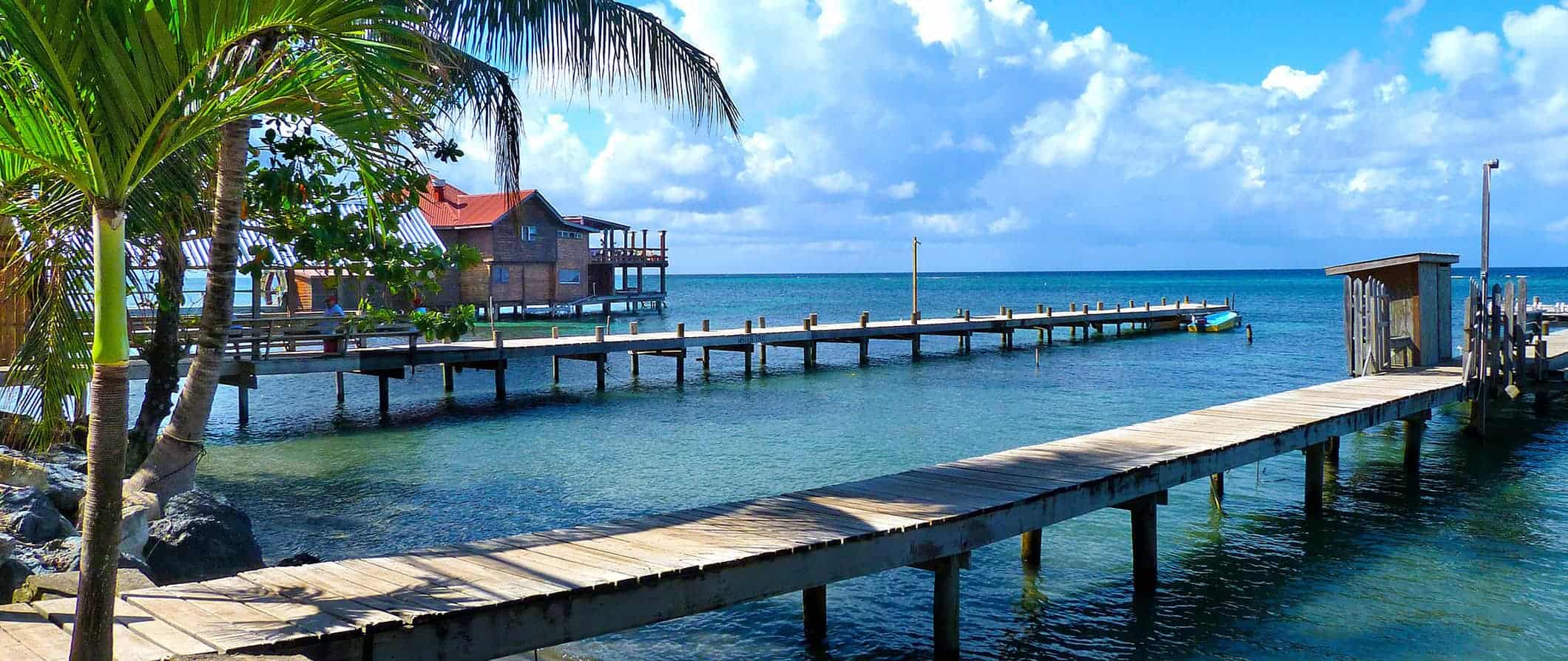
Unfortunately, owing to its violent past, it often gets glossed over for more polished Central American hotspots.
However, Honduras today is a much safer country and is popular with intrepid backpackers and expats looking to get off the beaten path. With world-class diving, a cheap cost of living, and incredible weather, Honduras offers some of the best value in the region.
That said, you’ll still need to take precautions and keep your wits about you — especially on the mainland — as crime and gang activity are still common.
This travel guide to Honduras can help you see the country, stay safe, and make the most of your visit to this beautiful and affordable country!
Table of Contents
- Things to See and Do
- Typical Costs
- Suggested Budget
- Money-Saving Tips
- Where to Stay
- How to Get Around
- How to Stay Safe
- Best Places to Book Your Trip
- Related Blogs on the Honduras
Top 5 Things to See and Do in the Honduras
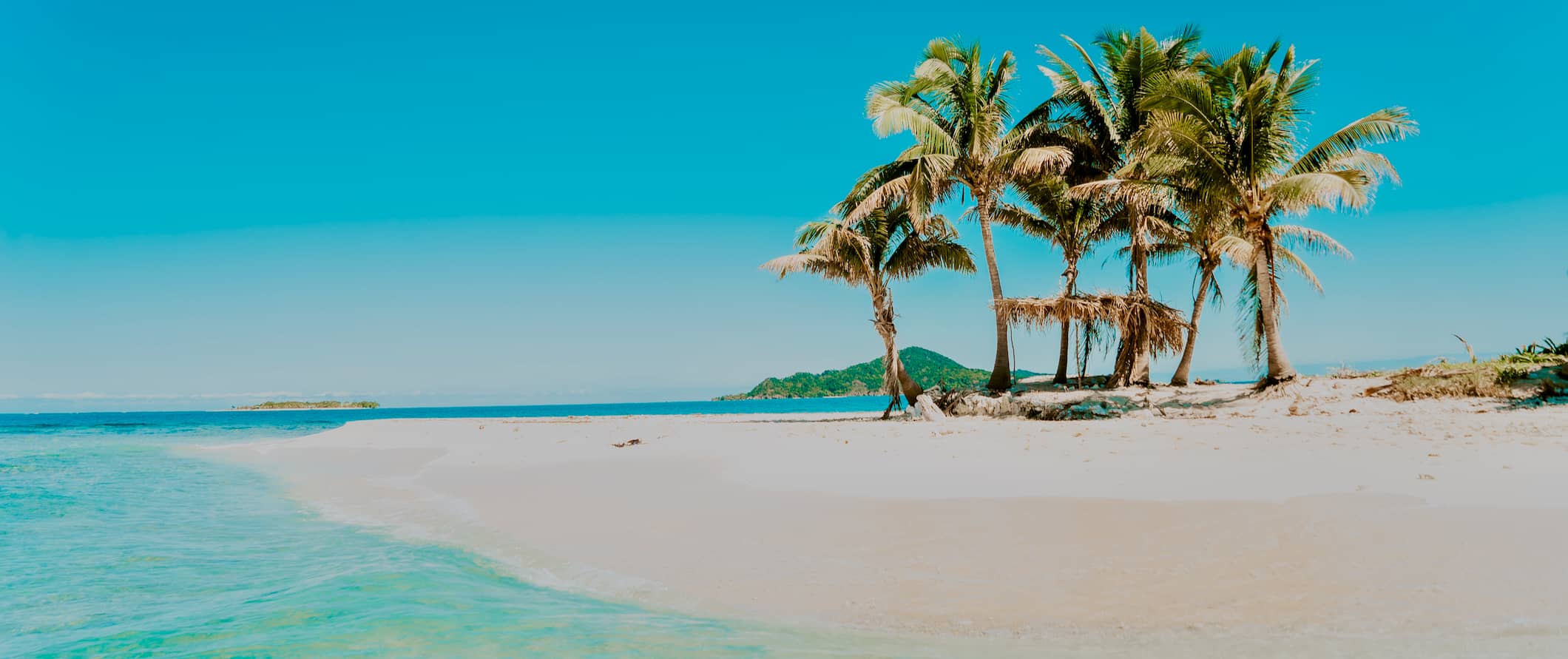
1. Explore the Copán Ruins
These incredible Mayan ruins are located near the border with Guatemala and are one of Honduras’ most popular tourist attractions. Nestled in a lush jungle valley, Copán Ruinas are a UNESCO World Heritage Site dating back to the height of the 5th century when Copán was a powerful capital of the Southern Maya kingdom. But in 738 CE, the king was captured and executed by his rival and archeologists believe that the city was abandoned by 800 CE. Today, the ruins attract tourists for their intricate stelae, tunnels, a hieroglyphic stairway, as well as the geography of the area itself which is filled with diverse wildlife including monkeys, sloths, parrots, and macaws. It takes a couple of days to see the entire site so try not to squeeze your visit into a day trip. There are two main sites: Copán, the main site originally used for nobility, and Las Sepulturas. To get there, head to the town of Copan Ruinas near the border with Guatemala; the ruins are nearby. Bring lots of sunscreen and water. Admission is 370 HNL.
2. Dive the Bay Islands
The Bay Islands, known as “Islas de la Bahía,” are one of the best diving spots in the Caribbean. They are located in the Gulf of Honduras and near the Belize Barrier Reef, which is part of the Mesoamerican Barrier Reef System. The Roatan, Utila, and Guanaja archipelagos all offer stunning dive sites with crystal-clear waters and incredible marine life. Roatan is the largest island while Utila is the cheapest, attracting budget divers as the island as it also offers a stunning array of wildlife, including nurse sharks, sea turtles, stingrays, and more. Get up close to colorful coral formations or deep dive 2,000 feet into the abyss for bluntnose sixgill shark sightings. Prices start at 870 HNL for one dive or a package of ten dives for 7,405 HNL.
3. Relax at Lake Yojoa
The country’s largest lake is rich in biodiversity with almost 400 bird species and over 100 plant species. This incredible site is a popular fishing spot for locals, a great place to visit a coffee plantation tour, and a fun place to zipline. Or if you’re looking for an adrenaline-filled experience, hike behind the stunning Pulhapanzak waterfall and explore the inside caves with the sound of water pounding around you. For something a bit more peaceful, rent a kayak and spend a few hours paddling around the lake. Or, if you don’t mind small spaces, head into the Caves of Taulabé where you can either explore on your own or hire a spelunking guide if you want to go deep underground. For a nice wander through the lush jungle wetlands, check out Los Naranjos Ecological and Archaeological Park. And if you’re up for a real challenge, hire a guide to climb to the top of Santa Barbara (2,744 meters/9,000 feet).
4. Adventure at Pico Bonito National Park
This sprawling bio-diverse national park is home to lush tropical jungles and moody cloud forests. It’s a haven for hiking, wildlife watching, and ziplining. The Cangrejal River is a fantastic place for white water rafting, with Class I-IV rapids. Or you can go swimming in the river and even jump off the rocks into the water if you feel like it. There are many different hiking trails here too, like the La Roca loop and the El Mapache trail to Bejuco Falls. If you’re a fan of the outdoors, don’t miss it. You can reach the park from La Ceiba or do it as a day trip from nearby regions.
5. Escape to Cayos Cochinos
The archipelago of Cayos Cochinos, made up of Cayo Menor and Cayo Grande, are two coral-abundant islands that offer some of the most postcard-perfect sandy white shorelines in Central America. They offer plentiful diving and snorkeling and the nearby cays are home to the world’s second-largest coral reef system. The only way to reach the Cochino Cays Marine Sanctuary is by boat; you can take a chartered day tour from Roatan and Utila or from La Ceiba. It’s a great place to disconnect and relax.
Other Things to See and Do in the Honduras
1. visit mercado guamilito.
Located in San Pedro Sula, this traditional market is an excellent place to buy Lenca ceramics, high-quality (and reasonably priced) leather, cigars, and silver. There’s also a no-frills food market that locals claim offers the best baleada , a national dish made with flour tortillas, cheese, cream, and fried beans. The market is open daily from 7am-4 pm.
2. Chill out on Utila
Most backpackers make a beeline for the island of Roatan, but if you’re looking for something beyond diving, Utila is a better option. It has a buzzing nightlife, cheap accommodation, beautiful white sand beaches, and even the chance to spot whale sharks. The 45-minute ferry ride from La Ceiba to Utila costs 750 HNL.
3. Visit Parque Nacional Jeannette Kawas
This national park is named after Jeannette Kawas, an environmental activist who fought to protect the area from commercial development and was brutally murdered in 1995. Now, her legacy lives on with this protected area, filled with abundant wildlife including howler monkeys, boa constrictors, and toucans. You’ll also find pristine beaches and untouched coral reefs here. The secluded park is also known as Punta Sal National Park and is just a 30-minute boat ride from Tela, a Caribbean coastal town. Admission is 120 HNL. Day trip prices start around 690 HNL.
4. Go zip lining
If you’re craving an adrenaline rush, Honduras has a dozen zip-lining experiences to choose from all around the country (including several on Roatan). Prices vary but expect to pay at least 950-1,085 HNL for a half-day tour. Lunch is usually included.
5. Explore the Río Plátano Biosphere Reserve
This heavily-forested area is a UNESCO World Heritage Site and one of the last remaining tropical rainforests in Central America. Established in 1982, it spans over 5,250 square kilometers (2,027 square miles) and is home to Mayan ruins, ancient petroglyphs, pumas, jaguars, giant ant-eaters, sloths, and over 2,000 indigenous locals. Getting here requires some effort (it’s a 6-hour bus from La Ceiba followed by a short boat ride) but you’ll be rewarded by sweeping vistas and a rare look at indigenous life in the rainforest. You can hire a day guide on arrival (for around 400 HNL) or embark on a multi-day tour up the river for 3,000 HNL. Kayaking day trips start around 940 HNL and crocodile night watching starts around 1200 HNL. Admission to the reserve itself is by donation.
6. Visit Valle de Angeles
This colonial town makes for a good day trip from Tegucigalpa, the capital of Honduras. It’s located 35 minutes away by car and, aside from the beautiful colonial buildings, there’s a lot of affordable handicraft shopping. While you’re here, spend some time relaxing in Parque Central, where you’ll see the historic colonial church or head into La Tigra, the nearby cloud forests that are full of hiking trails (admission is 247 HNL). Don’t forget insect repellent if you do visit the forest!
7. Attend Carnaval de La Ceiba
This is the biggest carnival in Central America. Held every May in La Ceiba, it attracts half a million revelers every year. The celebration is in honor of Saint Isidore the Laborer, the patron saint of the city. For two weeks, throngs of people flock to La Ceiba’s barrios (neighborhoods), who compete to throw the best carnavalito (little carnival) in town. It’s all in anticipation for the main event, the rainbow-filled parade “La Feria de San Isidro”, which takes place along Avenida San Isidro on the 3rd or 4th Saturday of May.
8. Go hiking in Parque Nacional Cusuco
This ethereal cloud forest is nestled into the Merendon mountain range near the border with Guatemala, making it somewhat difficult to access (during the rainy season you’ll need a 4×4). It’s a 2-3-hour drive from San Pedro. There are five stunning hiking trails that cross the cloud and dwarf forests. Expect to see plenty of parrots, toucans, and quetzals here. Unless you have a 4WD vehicle, you’ll need to go with a tour company. Admission is around 250 HNL.
9. See the Roatan Butterfly Garden
Located in Roatan, this indoor garden is home to over 30 species of moths and butterflies, as well as a large collection of boa constrictors, parrots, scarlet macaws, and tropical orchids. It is best to visit during the early morning when the butterflies are most active. Admission is around 358 HNL.
10. Visit the Lancetilla Botanical Garden
Located on the coast in Tela, Honduras’s only botanical garden happens to also be the largest in Latin America. Spanning over 4,100 acres, it boasts thousands of varieties of national and exotic flora and fauna (including a bamboo collection and an orchid collection). There are over 1,500 trees in its arboretum and the garden also has 3,000 acres of virgin rainforest. It’s open 365 days a year and admission is 198 HNL.
Honduras Travel Costs

Hostels – Shared dorms with 4-8 beds cost 370 HNL per night, with private rooms costing anything from 400 to 1,400 HNL. Free Wi-Fi and free breakfast are generally included. Most hostels also have A/C and hot water.
Wild camping isn’t recommended here due to petty theft, rainstorms, and the sweltering humidity. There are a few campgrounds around the country, though they aren’t any cheaper than staying in a hostel.
Budget hotels – Budget hotels can be found for around 1,000 HNL for a double room. Most of the cheaper hotels include Wi-Fi, however, for a hotel with a kitchen, A/C, and a pool you’ll pay at least 2,000 HNL per night.
Airbnb is available in Honduras but really only found in Tegucigalpa and the tourist spots on the coast. Prices start at 500 HNL for a shared room, 1,000 HNL for a private room, and 2,900 for a villa.
Food – Honduran cuisine leans heavily on fish, soups, beans, rice, and coconut. Popular dishes include guisado (a spicy chicken stew), carne asada (grilled sliced beef), and baleda (cheese and bean tortilla). Generally, you can expect a mix of Spanish, Lenca, and Caribbean influences.
Local meals consisting of rice, beans, and a drink costs around 120 HNL. Set lunch menus at comedores (small local eateries) offer large portions for cheap so stick to them when eating out.
Street food is popular here, with popular favorites being grilled corn, baleadas (a tortilla filled with fried beans, cream, and cheese), pastelitos (a Cuban pastry similar to empanadas), and fruit smoothies (a common breakfast here). These are usually under 50 HNL.
A three-course meal at a restaurant serving local cuisine costs 600 HNL, including a drink. These establishments usually add a 10% service charge to your bill too. Expect a blend of traditional Mayan cuisine (rice, beans, corn, seafood) with touches of Western and Caribbean flair.
A bottle of water is 17 HNL and a latte or cappuccino will set you back 43 HNL. Domestic beer is around 70 HNL.
Backpacking Honduras Suggested Budgets
On a backpacker budget of 875 HNL per day, you can stay in a dorm, eat street food for all your meals, take buses to get around, and do some hikes or other free activities like lounging on the beach. If you plan to drink, you’ll need to add around 150 HNL more per day.
On a mid-range budget of 2,400 HNL per day, you can stay in a budget hotel, eat out at local restaurants, have a few drinks, take the occasional taxi, and do some paid activities like visiting national parks or diving.
On a “luxury” budget of 5,200 HNL, you can stay in a private villa or nicer hotel, take taxis everywhere, eat out anywhere you want, drink more, and do more tours and activities. This is just the ground floor for luxury though. The sky is the limit!
You can use the chart below to get some idea of how much you need to budget daily, depending on your travel style. Keep in mind these are daily averages — some days you’ll spend more, some days you’ll spend less (you might spend less every day). We just want to give you a general idea of how to make your budget. Prices are in HNL.
Honduras Travel Guide: Money-Saving Tips
Honduras is very affordable. You’d be hard-pressed to spend a lot of money here unless you are actually trying to. That said, a true budget traveler always looks for ways to save. Here are some money-saving tips to help you:
- Refill your water – The tap water in Honduras is not safe to drink so make sure you have a reusable bottle with a built-in filter. To stay safe, bring a water filter like LifeStraw to ensure your water is clean and free from bacteria. You’ll save money on buying bottled water and save the environment too!
- Know what to pay – When you need to barter for something, talk to your hostel/hotel staff first. Find out what a fair price is so that you can avoid getting overcharged.
- Avoid paying with a credit card – Honduras is a cash-driven society. In places where you can pay with a credit card, expect fees of 5-10%. Pay with cash as often as possible.
- Learn some Spanish – To avoid getting overcharged, learn some Spanish. Even just a few words and phrases can help you avoid being charged tourist prices.
- Travel during the shoulder season – Prices are highest during the dry months (December-April). To avoid crowds and save money, travel during the rainy season or shoulder season. You might get rained on, however, accommodation and activities will be cheaper.
- Stay with a local – Honduras has a small Couchsurfing scene, but if you book early you can likely find a host who can share their insider knowledge and give you a free place to stay.
Where to Stay in Honduras
Honduras has plenty of fun, safe, and social hostels. Here are some of my suggested places to stay in Honduras:
- Roatan Backpackers Hostel (Roatan)
- Palmira Hostel (Tegucigalpa)
- Iguana Azul (Copan Ruinas)
- Jungle River Lodge (La Ceiba)
How to Get Around Honduras
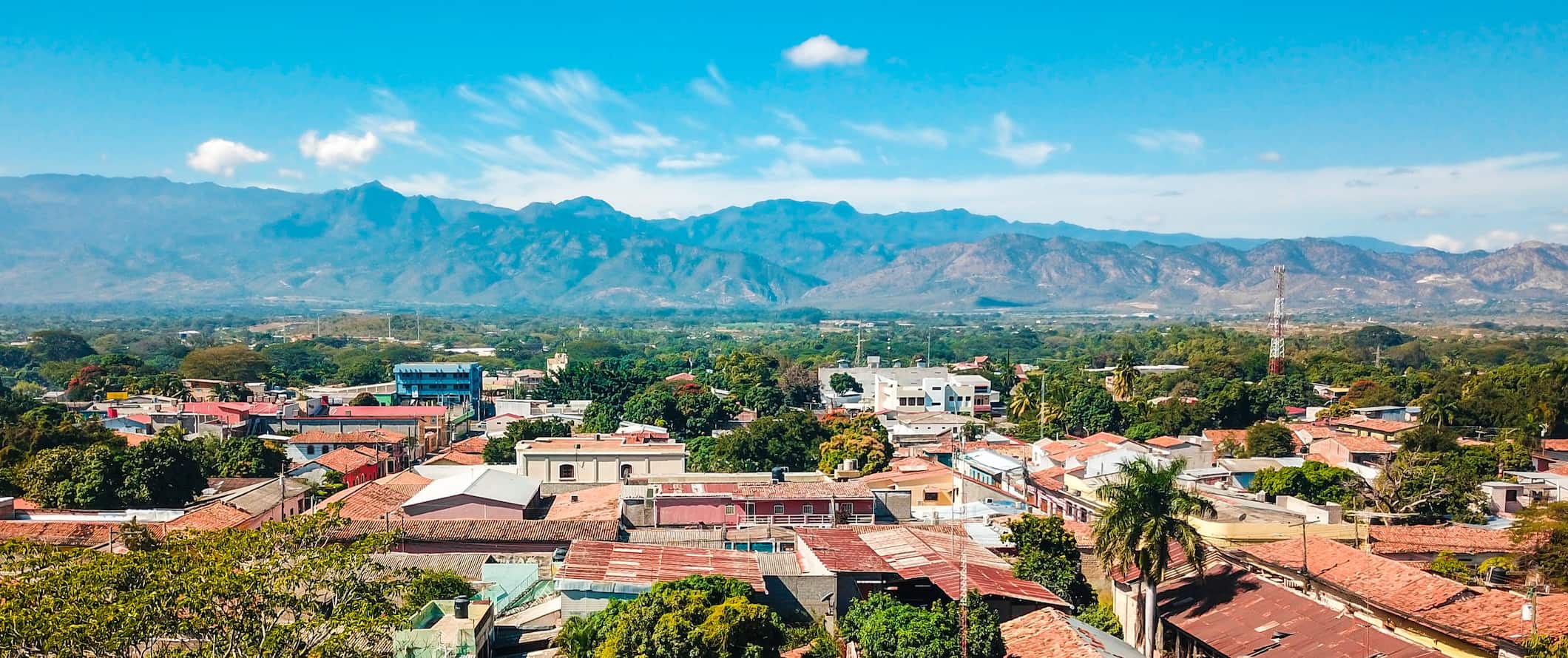
Bus – The cheapest way to get from A to B in Honduras is by bus. For local city journeys, taxis are recommended due to safety issues (petty theft is common on public transportation).
Direct buses for cross-country trips are more expensive but more comfortable and faster than the slower buses that make multiple stops. A direct bus from Tegucigalpa to La Ceiba takes around 6 hours and costs 860-950 HNL. A direct bus from Tegucigalpa to Copan Ruinas takes 9 hours and costs 1,293 HNL.
The multiple-stop buses ( parando ) are slower and can add a few extra hours to your trip. But, if you’re not in a rush, they can save you upwards of 50%.
Taxi – Taxis are plentiful and can be found pretty much everywhere. Fares start at 74 HNL and are charged at 65 HNL per kilometer.
Shared taxis ( colectivos ) are common for popular routes in the bigger cities too and will slash the private rates in half. Negotiate prices prior to getting in the car. Ask your hotel/hostel staff for rates before you arrive so you aren’t ripped off.
When on the islands, water taxis are your best option for getting around. They run from Roatan to West End, and from Coyolito to Isla del Tigre. Shared water taxis cost between 75-100 HNL depending on the route.
Flying – Domestic flights in Honduras are expensive. Connections between the major cities (La Ceiba, Tegucigalpa, San Pedro Sula) to Roatan, run frequently, however, one-way tickets to these key destinations usually cost between 3,000-4,250 HNL each way. If you’re on a budget, avoid flying.
Car rental – Driving in Honduras is not recommended as the roads aren’t that safe (landslides, flooding), there’s heavy traffic, and robberies are common. Avoid renting a car and stick to buses.
When to Go to Honduras
Honduras is, for the most part, a year-round destination. Temperatures hover around the 27-32°C (82-90°F) mark all year. However, the clammy humidity can feel like it’s higher than that during the rainy season (May-November).
Hurricanes are possible from April to October, however, if you’re willing to change your travel plans on a whim due to the weather, you can save a lot of money by visiting during this period. Be aware that booking during las lluvias (the rainy season), means rural areas (and hiking trails) can be harder to access due to storms.
The driest months, from December to April are considered peak season and are the best (albeit most expensive time) to visit. The coastal areas are particularly packed during this period, although ‘busy’ for Honduras is still pretty quiet compared to other popular Latin American destinations. If you’re serious about diving, you’re also going to get the best visibility during this time.
How to Stay Safe in Honduras
Honduras has found it difficult to shrug off its former status as the ‘murder capital of the world.’ Yet the country has improved leaps and bounds in terms of safety and the majority of travelers have no trouble navigating the country safely.
Homicides decreased by over 50% from 2012-2019 and kidnappings declined by 82% from 2013-2019. The majority of crimes happen in the major cities: Tegucigalpa, San Pedro Sula, and La Ceiba so I would be extra vigilant in those places, especially at night. (I wouldn’t walk around the capital at night alone.)
Outside of those areas, crime is much less common (especially in the Bay Islands). That being said, it’s important to keep an eye on your belongings on public transport, in busy urban areas, and near bus stops/stations.
Take cabs at night (ideally with other travelers) instead of walking alone and avoid walking down side streets that are not well lit.
Walking around during the daytime is usually trouble-free as long as you keep your valuables out of sight and don’t flash fancy jewelry, phones, or money.
Avoid taking the city bus, where pickpocketing is rife.
Since scams can occur here, read about common travel scams to avoid so you can be prepared.
Solo female travelers should generally feel safe here as long as they follow the advice above. Additionally, the standard precautions apply (never leave your drink unattended at the bar, never walk home alone intoxicated, etc.).
If you’re visiting during hurricane season (April-October), be sure to check the weather regularly.
If you experience an emergency, dial 911 for assistance.
The most important piece of advice I can offer is to purchase good travel insurance. Travel insurance will protect you against illness, injury, theft, and cancellations. It’s comprehensive protection in case anything goes wrong. I never go on a trip without it as I’ve had to use it many times in the past. You can use the widget below to find the policy right for you:
Honduras Travel Guide: The Best Booking Resources
These are my favorite companies to use when I travel. They consistently have the best deals, offer world-class customer service and great value, and overall, are better than their competitors. They are the companies I use the most and are always the starting point in my search for travel deals.
- Skyscanner – Skyscanner is my favorite flight search engine. They search small websites and budget airlines that larger search sites tend to miss. They are hands down the number one place to start.
- Hostelworld – This is the best hostel accommodation site out there with the largest inventory, best search interface, and widest availability.
- Booking.com – The best all around booking site that constantly provides the cheapest and lowest rates. They have the widest selection of budget accommodation. In all my tests, they’ve always had the cheapest rates out of all the booking websites.
- Get Your Guide – Get Your Guide is a huge online marketplace for tours and excursions. They have tons of tour options available in cities all around the world, including everything from cooking classes, walking tours, street art lessons, and more!
- SafetyWing – Safety Wing offers convenient and affordable plans tailored to digital nomads and long-term travelers. They have cheap monthly plans, great customer service, and an easy-to-use claims process that makes it perfect for those on the road.
- LifeStraw – My go-to company for reusable water bottles with built-in filters so you can ensure your drinking water is always clean and safe.
- Unbound Merino – They make lightweight, durable, easy-to-clean travel clothing.
- Top Travel Credit Cards – Points are the best way to cut down travel expenses. Here’s my favorite point earning credit cards so you can get free travel!
Honduras Travel Guide: Related Articles
Want more info? Check out all the articles I’ve written on Asia travel and continue planning your trip:

Do You Need Travel Insurance for Costa Rica?

The Best Tour Companies in Costa Rica
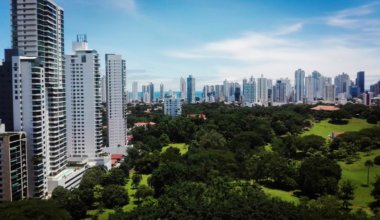
The 6 Best Hostels in Panama City, Panama
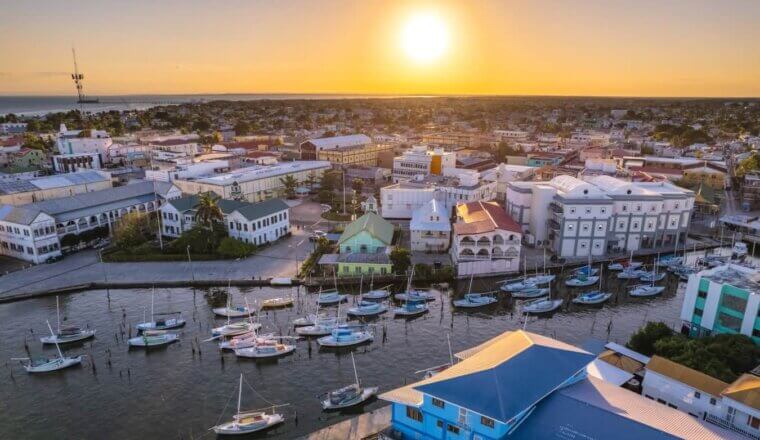
Is Belize Safe to Visit?

Is Central America Safe to Visit?
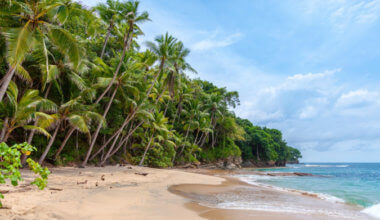
How to Get Around Central America on a Budget
Get your free travel starter kit.
Enter your email and get planning cheatsheets including a step by step checklist, packing list, tips cheat sheet, and more so you can plan like a pro!

- Where To Stay
- Transportation
- Booking Resources
- Related Blogs
Why travel to Honduras?
Honduras: A stunning country that evokes scenes of jungle-covered tropics, misty waterfalls, palm-fringed beaches, and exotic wildlife. Discover some of the most pristine national parks, incredible Mayan ruins, and offshore Caribbean islands right here.
The best bucket list experiences
When to visit honduras.
Honduras benefits from a stable tropical climate, with hot coasts and cooler highlands. Temperatures vary quite little throughout the year, hovering between 27 and 32°C . The more important thing is to avoid heavy downpours during the wet season.
- For the driest weather , you’ll want to head to Honduras between December and April , though you may still encounter an odd shower or two. Peak months to travel are December, January, and February — you can expect a livelier holiday vibe at the beaches and islands off the coast.
- You can also visit during the rainy season between August and October to avoid the crowds. Expect short, monsoon-style bursts of rain in the afternoons, but also remember that Honduras sits on the Caribbean hurricane belt , so be sure to keep up with weather updates.
- November is a great month to consider — this is when the wet weather starts to ease up just before the arrival of peak crowds. If you don’t mind a bit of rain, this is a good time to travel.
- Semana Santa (Easter Holy Week) falls in March/April and you can expect a colorful celebration across the country. Domestic tourism picks up during this time, particularly on the Bay Islands.
- The best time to see the whale sharks off the Caribbean coast is from May to September .
- Up in the highland regions , including Tegucigalpa, you can expect pleasantly cool weather all year round . Remember to bring extra layers if you’re traveling here.
Estimated flight prices from popular cities
Honduras is truly blessed with some of the best natural beauty that Central America has to offer. Join a TourHero to explore Honduras with other avid travelers!
About TourHero
TourHero is a social travel platform that enables you to travel with like-minded people and fall in love with the journey. We work closely with handpicked local operators to ensure every experience curated is unique and exclusive to your travel group. Join an epic adventure with like-minded travelers to create memories that last a lifetime.

Honduras Travel Guide
Looking for an in-depth Honduras travel guide ?
Then you’re in the right place!
Located in Central America, Honduras is a country of lush rainforests, beautiful beaches, and deep history.
There really is something for every kind of traveler in this country of just over 43,000 square miles.
And while the country may have a reputation for being dangerous, don’t let that deter you from checking out this travel gem.
Beach lovers will definitely want to check out the Bay Islands, located just off the east coast of Honduras. The region’s three main islands — Utila, Roatan , and Guanaja — offer a laid-back vibe, white sand beaches, and plenty of nightlife for those who like to party.
The islands are also home to breathtaking coral reefs and many different types of fish, making them a diver’s or snorkeler’s paradise. If you’re looking for a beach experience away from the pristine resorts of the easter islands, Honduras’s Caribbean Coast is the place to go.
Honduras was also once a major hub of Mayan civilization and there are plenty of historic ruins to explore throughout the country.
One of the most popular sites is the Copan Ruins , a UNESCO World Heritage Site located just a few miles from the Guatemala border.
Here, you can check out a Mayan citadel and learn more about this great civilization. Throw on some comfortable shoes, as this site has a lot to explore!
The country’s more rural areas are places of unspoiled natural wonder, with great sites for outdoor explorers — especially hikers wanting to explore some of the world’s best hikes . Do some rafting along the Cangrejal River, hike through the Moskitia Forest, and check out the serene Lago de Yojoa.
Any way you slice it, there’s so much to see in Honduras and no two trips will look exactly alike!
Keep reading to dive into resources that will help you with planning a trip to Honduras, a destination that should be mentioned in every Central America travel guide !
Note: This ultimate guide to Honduras travel contains affiliate links to trusted partners!

Honduras Map
Use this Honduras travel map to begin planning your trip to this incredible country!
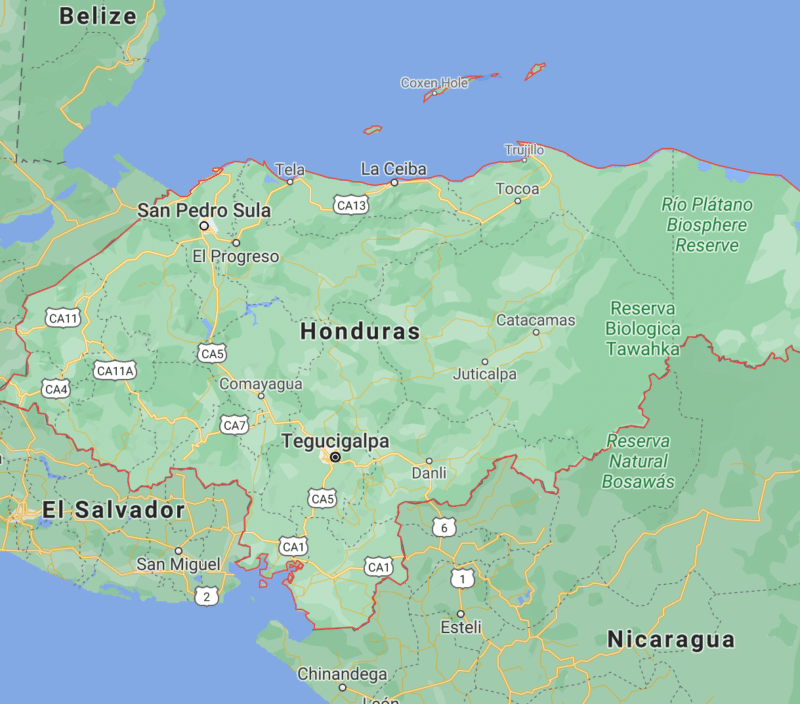
Click here for an interactive Google Map version of the above graphic.
Honduras Travel Advice
Plan the perfect trip to Honduras with these travel guides.

Exploring The Caribbean Side Of Honduras On Roatan Island

Copan, Honduras: An Amazing Day Exploring Mayan Ruins In The World’s Most Dangerous Country

From Solo To Sidekicks: Notes On My Central America Group Travel Experience
Top Honduras Tours
Explore the local culture with the help of a Honduras tour guide !
- Roatan Shore Excursion: Monkeys, Sloths, and Snorkel Adventure
- Roatan Ziplines Sloth Park and West Bay Beach Break
- Roatan Barrier Reef Snorkel & Monkeys/Sloth Sanctuary from French Cay
- Day Trip to La Tigra and El Picacho Park from Tegucigalpa
- Roatan Shore Excursion: Kayak Harbor Adventure and Reef Snorkel from French Harbour
- Day Trip to the Mayan Ruins of Copan from San Pedro Sula
Renting A Car In Honduras
Need a rental car for your Honduras trip?
Use Discover Cars to quickly compare your car rental options.
Honduras Hotels
Click here to browse hotels in Honduras !
Prefer self-contained stays?
Click here to check out unique local rentals!
You can also use this map to search for local stays:
Honduras Travel Insurance
It doesn’t matter if you’re traveling solo or with a group on a Honduras tour. When visiting Honduras — or any other country in the world — make sure to get travel insurance to protect your health and safety.
In my opinion, the best travel medical insurance for travelers is SafetyWing as they’ve got a large network and offer both short-term and long-term coverage — including coverage if you’re traveling for months as well as limited coverage in your home country).
Additionally, SafetyWing is budget-friendly and offers $250,000 worth of coverage with just one low overall deductible of $250.
With coverage, you’ll have peace of mind as you embark on your Honduras itinerary.
Click my referral link here to price out travel insurance for your trip in just a few clicks .
Honduras Travel Guide FAQ
Below, find answers to frequently asked questions about traveling Honduras .
Q: Is it safe to vacation in Honduras?
While crime is very much a reality in Honduras, the country is generally pretty safe to visit. There are certain areas to avoid due to higher crime rates, including municipalities along the north coast and in the central part of the country.
Most experts suggest avoiding Gracias a Dios department; its remote location and high level of drug trafficking make it particularly dangerous for travelers.
On the other hand, the Bay Islands, Copan Ruins, and other areas popular with tourists have a much lower crime rate and have a more robust law enforcement presence.
Keep alert and understand how to avoid pickpockets to protect yourself from petty crime in these areas, but know that more serious violent crime is not as common.
Q: Is Honduras expensive to visit?
Honduras is a very affordable place to visit. The average traveler should budget about $29 USD per day for meals, accommodation, transportation, and other expenses while in the country.
Accommodation rates are a bit more expensive around the coast, so keep that in mind.
Flights will likely be your biggest expense for this country. Round-trip flights from the U.S. generally cost around $400-$500 USD depending on the airline and departure destination, though you can find some great deals if you shop around.
Q: What do I need to know about traveling to Honduras?
One thing to know about Honduras is that the country’s poverty rate is very high. Many of the people you’ll encounter in the country are likely struggling to get by. Be a conscious visitor in Honduras and tip well, shop local, and don’t haggle too much with merchants.
Also, be sure to keep cash handy while in Honduras. Many businesses do not accept credit cards and working ATMs are scarce, so plan to get plenty of cash — ideally in the local currency — before you go.
Q: What are some travel tips for people visiting Honduras?
Leave plenty of time when traveling via ground transportation in Honduras. Local taxi and van services don’t always run on time, so be sure to work any possible delays into your itinerary.
While English is commonly spoken on the Bay Islands , Spanish is the national language of Honduras and most Hondurans only speak Spanish. Learn a few words and phrases before your trip to help you get by and show respect for the locals. Luckily, Spanish is often one of the easiest languages to learn for English speakers .
The country’s climate makes it a particularly welcoming environment for mosquitoes, many of whom carry diseases like malaria and dengue.
Malaria vaccinations, while not required by the Honduran government, are highly recommended. You can get vaccinated and acquire any medications you may need for your trip at your local doctor’s office.
And be sure to pack plenty of insect repellant and cover-up in particularly damp areas.
Q: What is the best place to visit in Honduras?
No visit to Honduras is complete without a trip to the Copan Ruins ! Designated a UNESCO World Heritage Site, this area was once the center of Mayan civilization in the Copan Valley.
Explore the Mayan citadel and stone portraits throughout the site to get a sense of what life was like in the area thousands of years ago.
While there, you can visit the Museum of Mayan Sculpture for even more insight into the artifacts found among the ruins.
Q: Do I need a visa to visit Honduras?
Citizens of the United States, Canada, United Kingdom, Australia, and the European Union do not need a visa to visit Honduras for less than 90 days. Visitors from these countries will need to show a valid passport and proof of a return flight upon entry into the country.
It’s recommended to view your country’s Honduras International Travel Information page for the most up-to-date information on entry and exit requirements. You can also contact the Honduras Embassy.
Q: Are credit cards accepted in Honduras?
While credit cards are sometimes accepted — especially Visa and Mastercard — many establishments only take cash, so make sure to have that on hand.
Moreover, it’s smart to bring two ATM cards in case you run into an issue.
Q: What is the best time to visit Honduras?
While Honduras is a year-round destination, the dry season is between December and April.
Q: What months are summer in Honduras?
Summer in Honduras runs from November to April.
Q: Can you drink tap water in Honduras?
It is best to avoid drinking the tap water in Honduras.
Q: What is the hottest month in Honduras?
The warmest months in Honduras are typically April and May.
Q: What is the local currency in Honduras?
The local currency in Honduras is the Honduran lempira.
What would you add to this Honduras travel guide?

Pin for later: Honduras Travel Guide
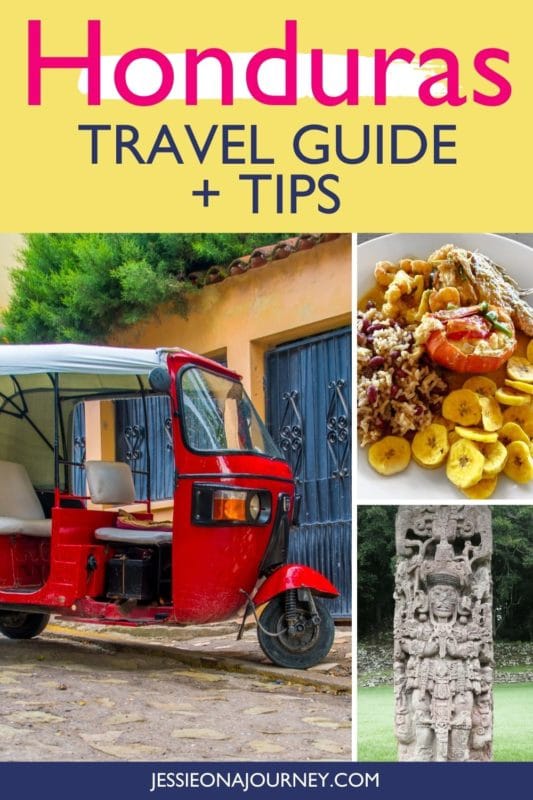

- South Africa
- South Korea
- The Maldives
- The Philippines
- United Arab Emirates
- Czech Republic
- Switzerland
- The Netherlands
- Galapagos Islands
- Dominican Republic
- Puerto Rico
- The Bahamas
- New Zealand
- Solo Travel
- Travel on a budget
- Female Travel
- Luxury Travel
- Couple Travel
- Best Travel Credit Cards
- How to find cheap flights
- International Food
- Accessories
- Photography Gear
- Travel Gifts
- Request a blog post
- Work with me
- Become a guest writer
- Travel Destinations
- Central America Travel Guide
Central America
Travel guide.
Located in Central America , Honduras is a hidden gem in Central America that offers travelers an unforgettable experience. One of the main reasons to visit this country is its natural beauty, as it boasts an array of stunning landscapes from dense jungles to towering mountains, making it a paradise for nature lovers. Furthermore, Honduras has a rich cultural history, with ancient Mayan ruins scattered throughout the country.
Why Visit Honduras
Honduras has more than 12 national parks, offering many ecosystems and a diverse wildlife. Mangroves, cloud forests, rainforest, a coastline with idyllic beaches, the country is home to more than 700 bird species, Crocodiles, snakes, lizards, deer, peccaries, tapir, pumas, jaguars, and ocelots, turtles and more.
MAYAN RUINS
Located in western Honduras, Copan, the country’s most famous historical site, has some of the best preserved Mayan Ruins in the entire continent. Located in the middle of the rainforest, Copan is a mayan city declared by UNESCO as Archaeological World Heritage Site in 1980.
Honduras is known for its stunning beaches, which offer visitors a chance to unwind and enjoy the sun, sand, and surf. The Caribbean coast is especially popular, with pristine beaches, crystal-clear waters, and plenty of opportunities for water sports.
Honduras is an affordable destination that offers plenty of value for money. From budget-friendly accommodation to cheap and delicious street food, travelers on a tight budget can explore this country without breaking the bank.
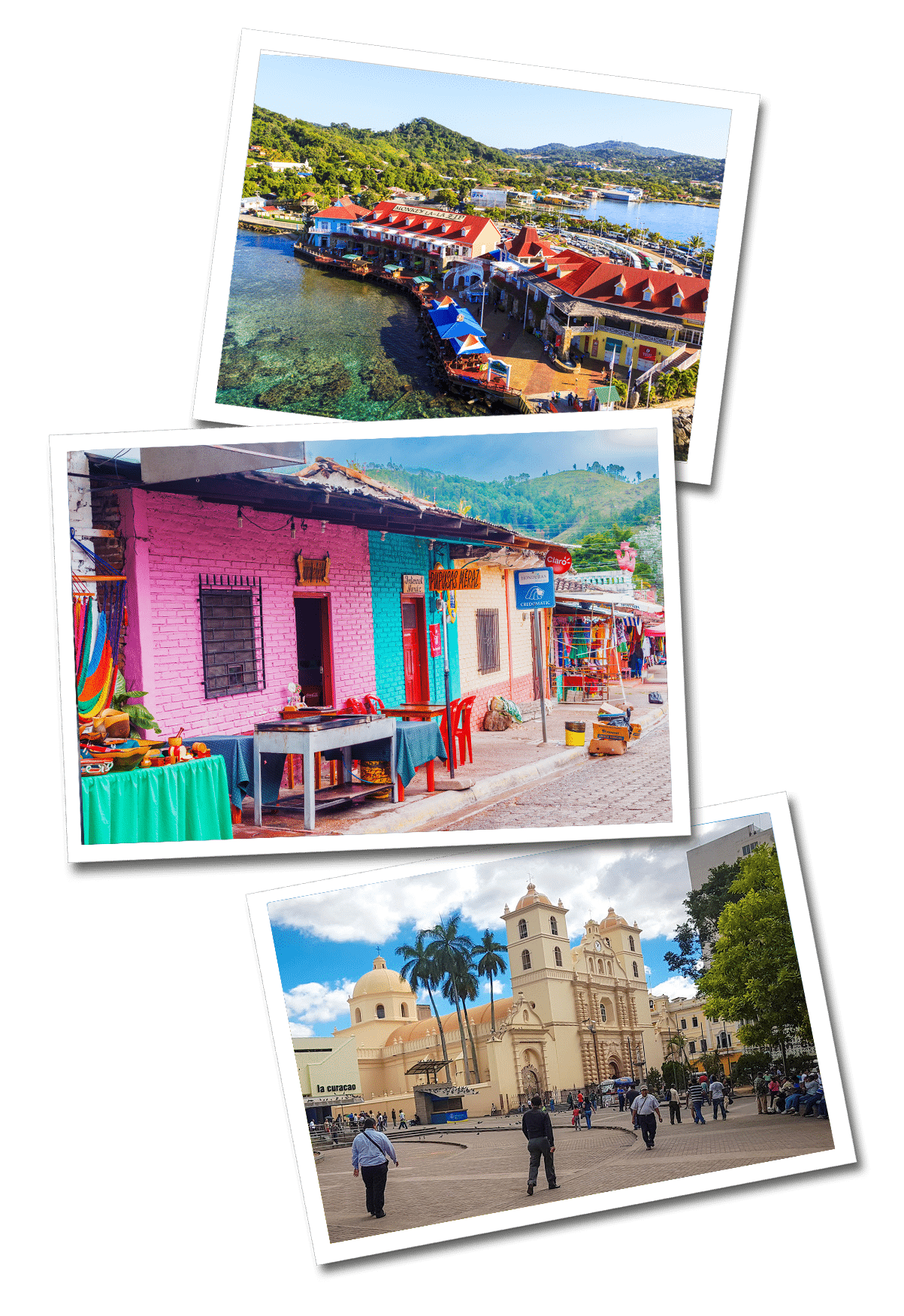
- Name: Republic of Honduras
- Capital: Tegucigalpa
- Official Languages: Spanish
- Currency: Lempira
- Time Zone: UTC −6
Bucket List
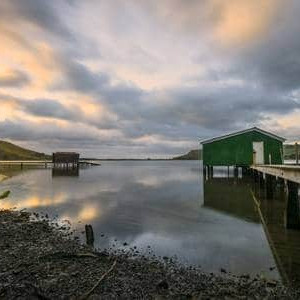
Visit the Lago de Yojoa
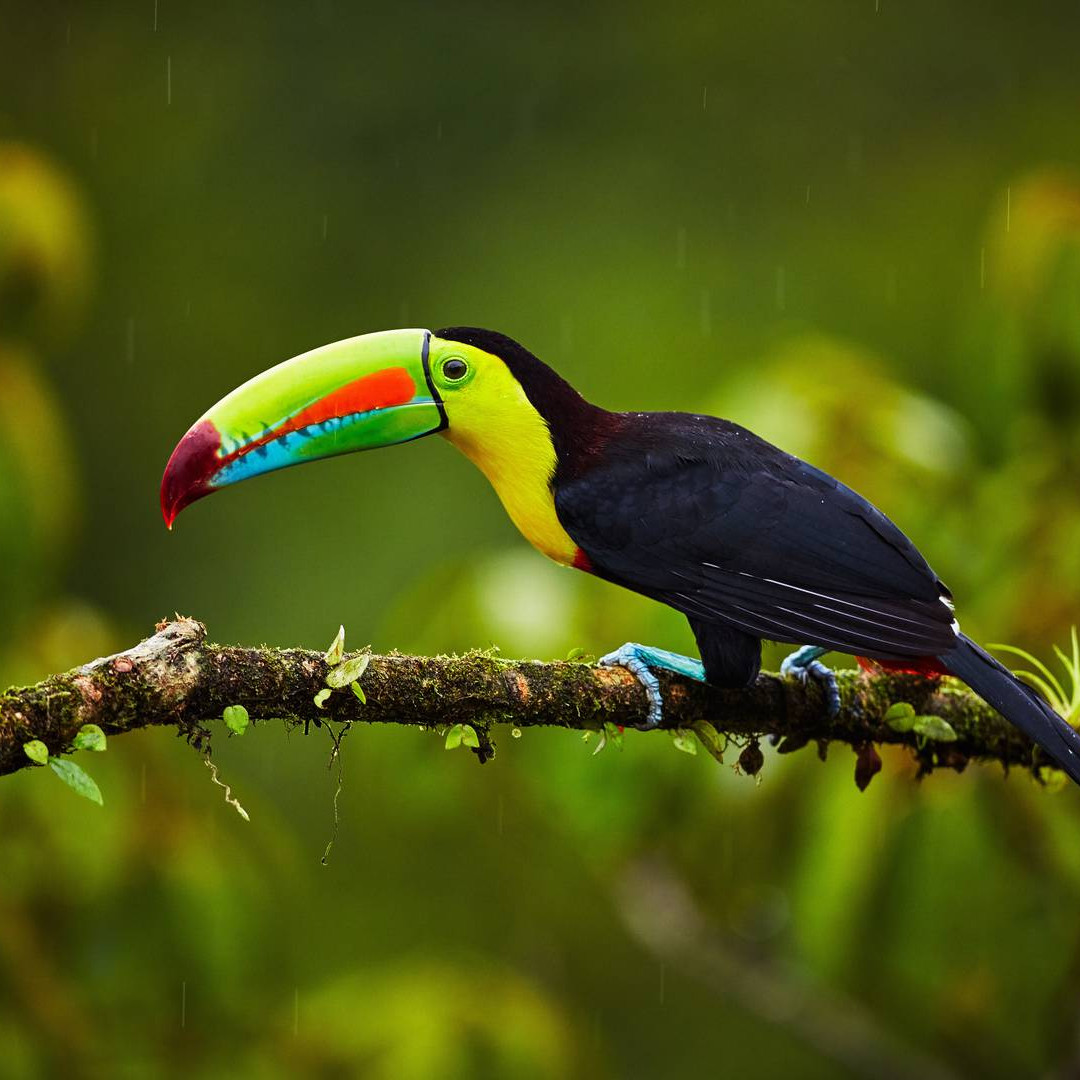
Explore the the Río Plátano Biosphere Reserve
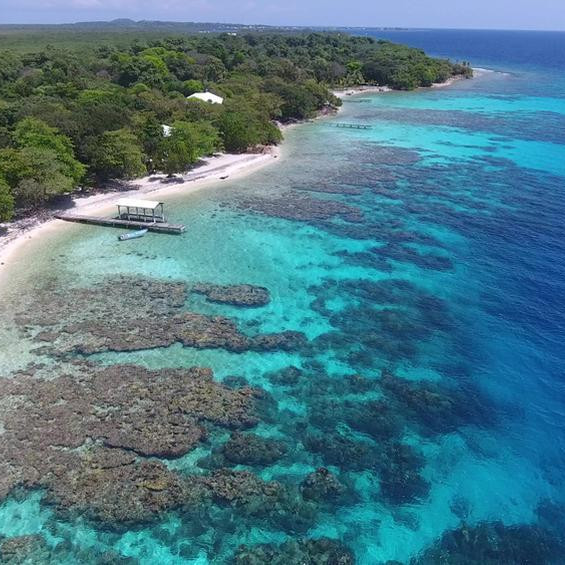
Dive at Utila
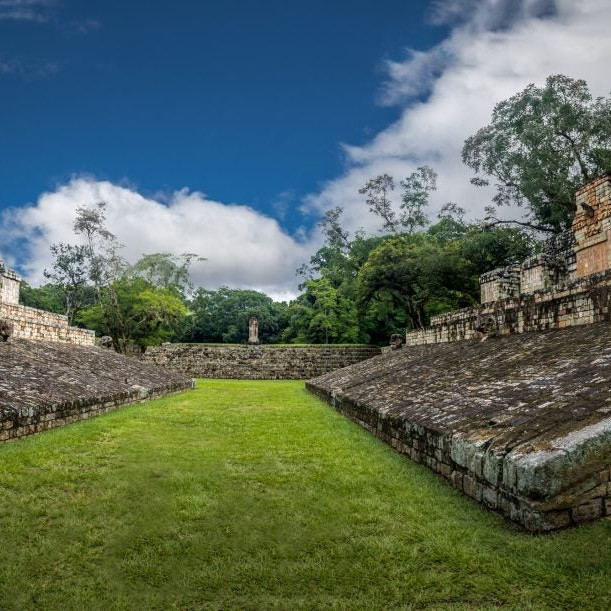
Visit the Copan Ruins
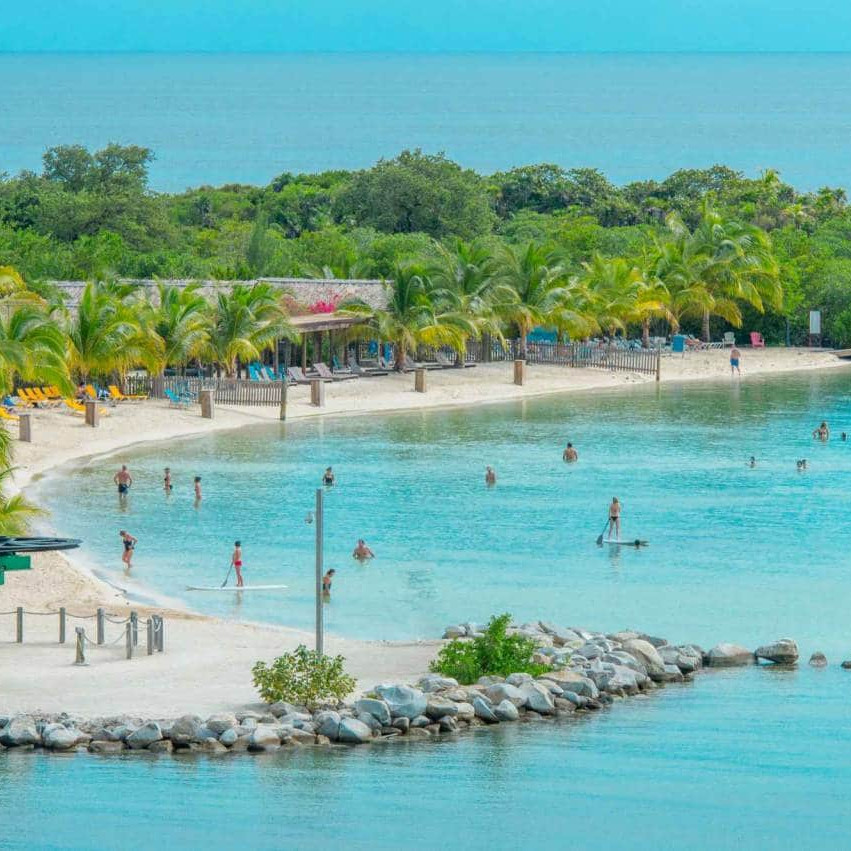
Hit the sun in Roatan
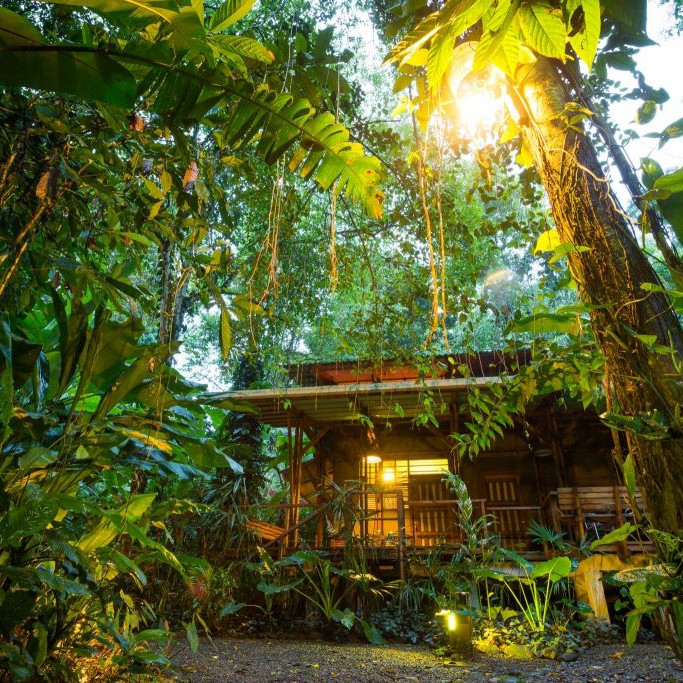
Stay in an Eco Lodge
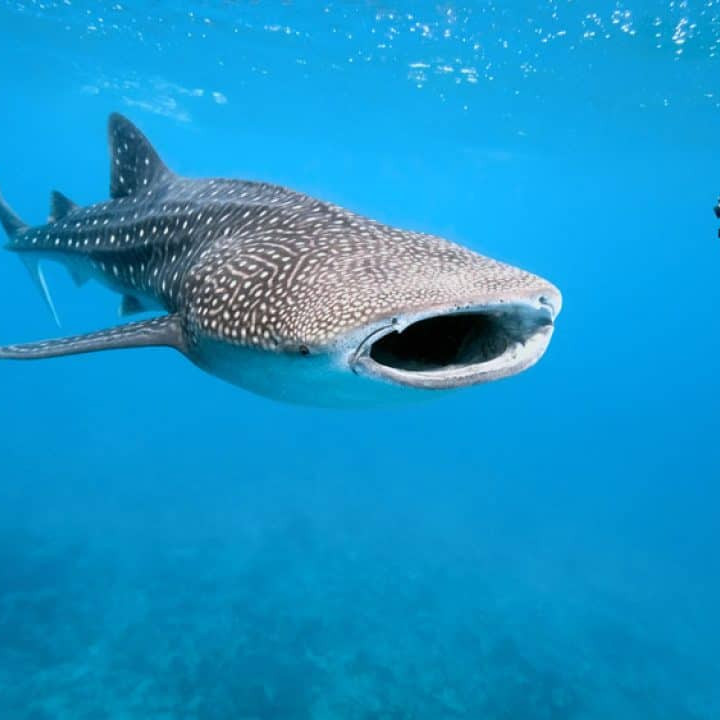
Swim with a Whale Shark
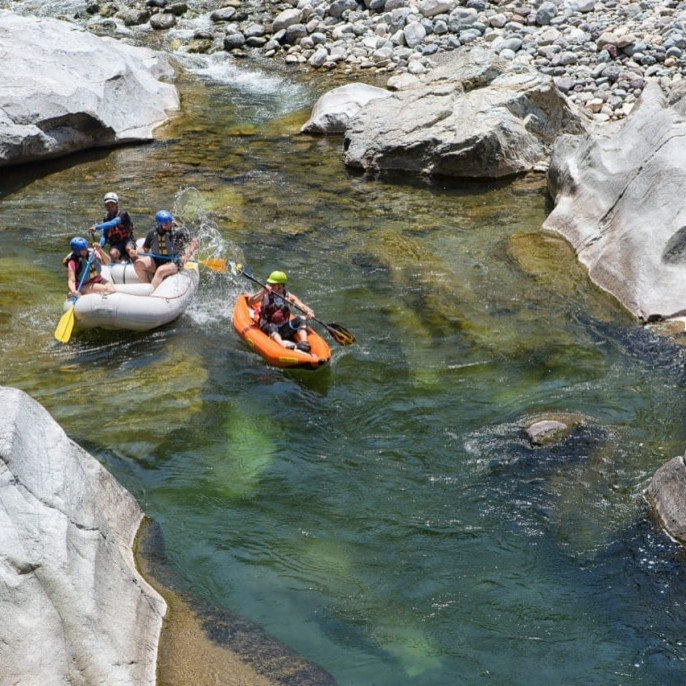
Do some rafting in Rio Cangrejal
What to expect
The official language of Honduras is Spanish. English is also widely spoken in tourist areas.
ELECTRICITY
In Honduras the standard voltage is 110 V and the frequency is 60 Hz. That’s the standard voltage in the american continent; If you are traveling from the EU you will need an adaptor.
The Honduran Lempira is the currency of Honduras. Dollars are accepted at most places, and Euros only at tourist destinations. Credit cards are widely accepted, but cash is preferred. It is encouraged to exchange it in a bank or withdraw it directly from the ATM. 1 USD equals 25 lempiras as of 2023.
Honduras has a tropical climate with temperatures that can vary depending on the region and time of year. Coastal areas tend to be hot and humid, while the mountainous regions are cooler. The average temperature in Tegucigalpa, the capital city, is around 25°C (77°F).
Honduras is not precisely safe. The islands and cayes tend to be safer than mainland. Violent crime, mostly gang related, is somewhat common. Relying on your common sense is vital and exercising caution is encouraged. Tegucigalpa , San Pedro Sula and La Ceiba are the most dangerous places in the country.
How to get around
Honduras has a variety of transportation options to help travelers navigate the country. Here are some ways to get around Honduras:
- Bus: The most common and economical way to travel around Honduras is by bus. There are both local and long-distance buses that run regularly between cities and towns.
- Taxis: Taxis are widely available in the major cities and towns. It’s important to agree on a price before getting into a taxi and to make sure that the driver is using the meter.
- Rental Cars: There are several international rental car agencies available in Honduras for those who want to drive themselves around. It is recommended to book in advance.
- Private Drivers: Another option for travelers is to hire a private driver or a car with a driver. This option is more expensive but it allows for more flexibility and personalized service.
- Domestic Flights: There are a few domestic airlines that offer flights between major cities in Honduras. This option is faster but more expensive than other transportation options.
Visa Policy
Honduras has a visa policy that varies depending on the nationality of the traveler. Citizens of many countries, including the United States, Canada, the United Kingdom, Australia, and most European Union countries, are not required to obtain a visa to enter Honduras for stays of up to 90 days for tourism or business purposes. Other countries, such as China, Russia, India, and some African nations, are required to obtain a visa prior to arrival in Honduras. It is recommended that travelers check the visa requirements with the nearest Honduran embassy or consulate prior to their travel. Additionally, all visitors to Honduras must have a passport valid for at least six months from the date of entry and a return or onward ticket. Upon arrival, visitors must complete an immigration form and may be asked to provide proof of sufficient funds for their stay.
Are you a globetrotter? Join our platform and get exclusive travel tips, getaways and more!
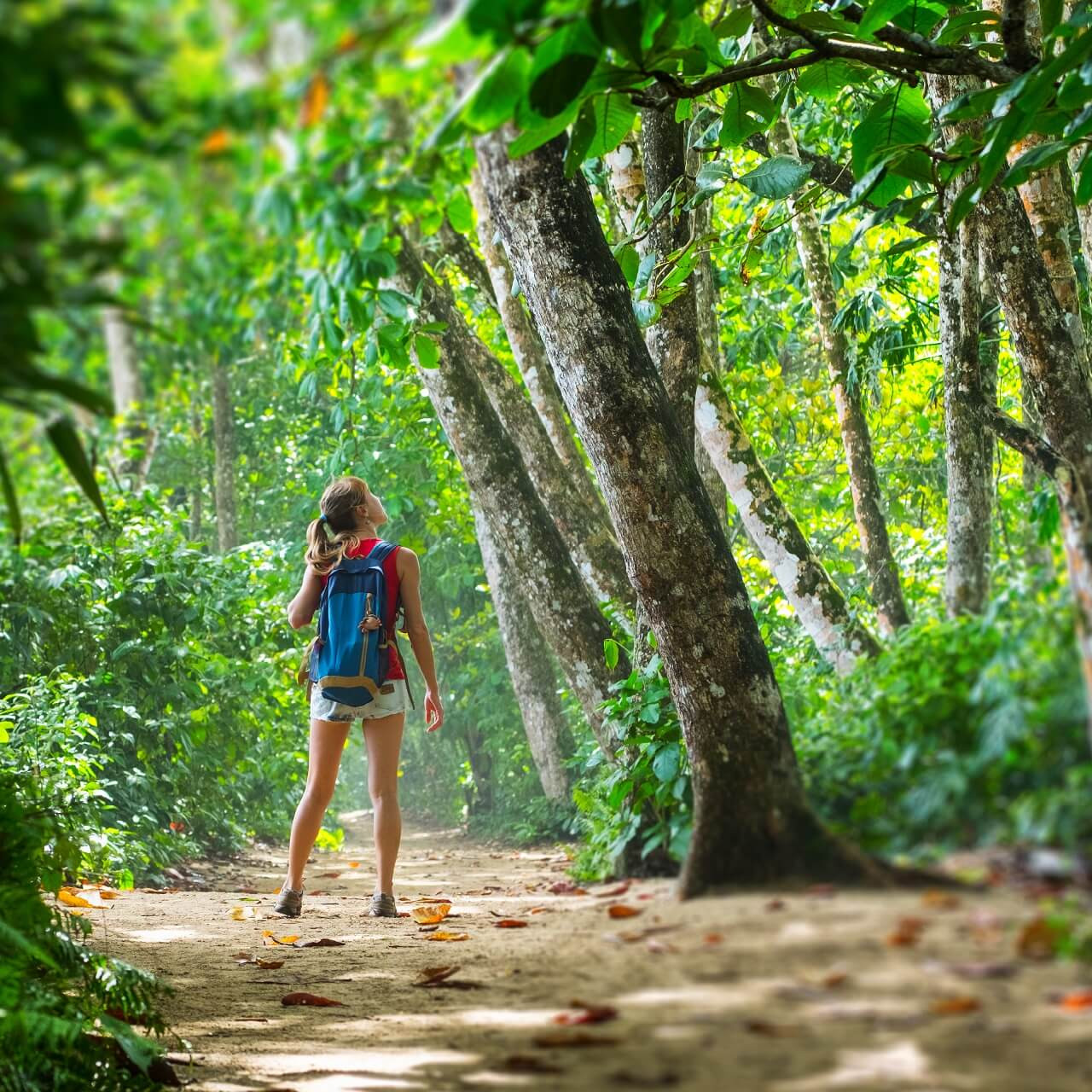
Travel Costa Rica, a natural wonder itself. The country is well known for its incredible natural landscapes, filled with rainforest, beaches..
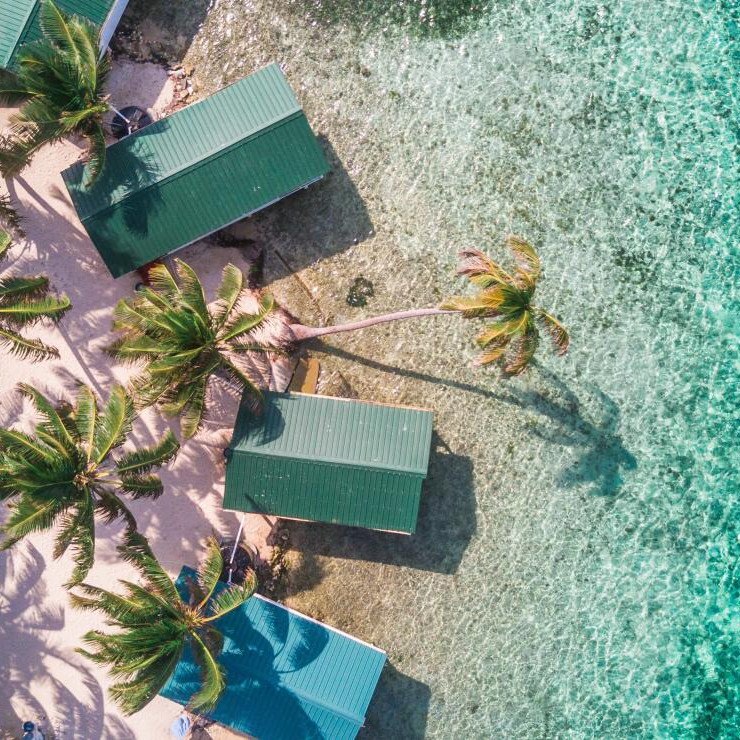
Travel Belize, a tropical paradise boasting incredible nature, pristine beaches, incredible mayan cities and ruins and the longest barrier...
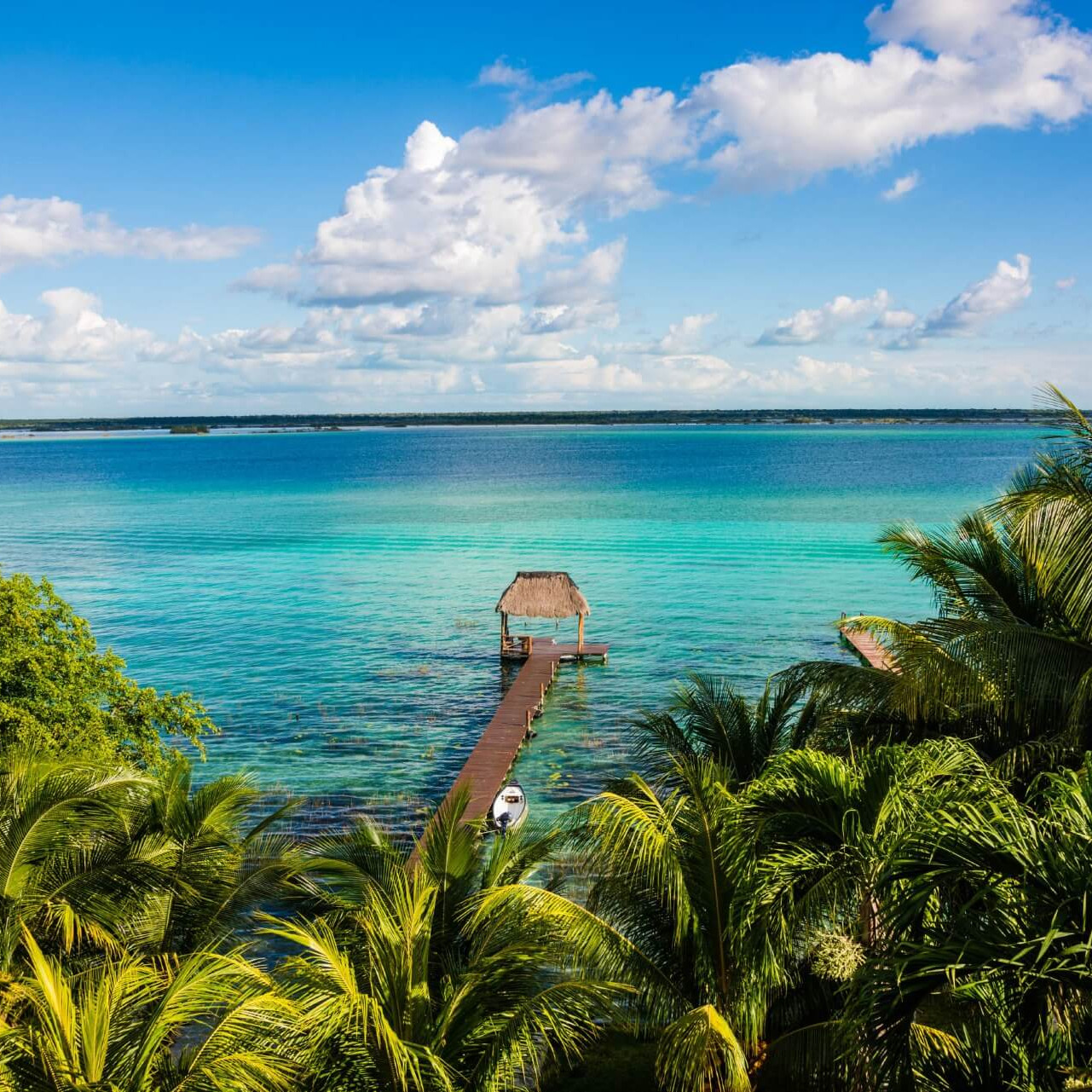
Travel and explore Mexico, a destination that has it all. The country boasts and incredible history and culture, diverse landscapes, mouth..

Travel the USA, a country with amazing and diverse natural wonders, vibrant cities, unique mix of cultures, incredible nightlife and more..
Travel Costa Rica, a natural wonder itself. The country is well known for its incredible natural…
Travel Belize, a tropical paradise boasting incredible nature, pristine beaches, incredible mayan…
Travel and explore Mexico, a destination that has it all. The country boasts and incredible history…
Privacy Preference Center
Privacy preferences.
10 Reasons Why You Should Visit Honduras
- Cayos Cochinos Marine Park
- Celaque National Park
- Cerro Azul Meambar National Park
- Cusuco National Park
- Jeannette Kawas National Park
- La Muralla National Park
- Montaña de Yoro National Park
- Pico Bonito National Park
- Río Plátano Biosphere Reserve
- Cabanas
- Choloma
- Choluteca
- Cofradia
- Comayagua
- Danli
- El Progreso
- Juticalpa
- La Ceiba
- La Lima
- La Paz
- Olancho
- Potrerillos
- Puerto Cortes
- San Pedro Sula
- Santa Barbara
- Santa Rosa de Copan
- Tegucigalpa
- Tocoa
- Trujillo
1. Explore the Ancient Mayan Ruins
2. enjoy the stunning beaches, 3. experience the unique culture, 4. go diving and snorkeling, 5. explore the rainforest, 6. visit the national parks, 7. enjoy the delicious cuisine, 8. learn about the history and culture, 9. go shopping, 10. relax and unwind.
- Belize
- Canada
- Costa Rica
- El Salvador
- Guatemala
- Honduras
- Mexico
- Nicaragua
- Panama
- United States
21 things to know before going to Honduras – Safe travel tips for Honduras

Sharing is caring!
Just like with every international trip, there are things that you end up realizing while you’re traveling. At that point, you kick yourself and wish you had known better to avoid the trouble and heartache that come with traveling to unknown places. That’s why we put together the list of the top 21 things to know before going to Honduras . This article will highlight the top travel advice for Honduras.
We hope these tips will help make your trip more enjoyable. Because truth be told, this is a beautiful country, and more people should be enjoying the amazing things to do in Honduras . So get ready because we’re sure you have a ton of questions, and we have some of the answers.
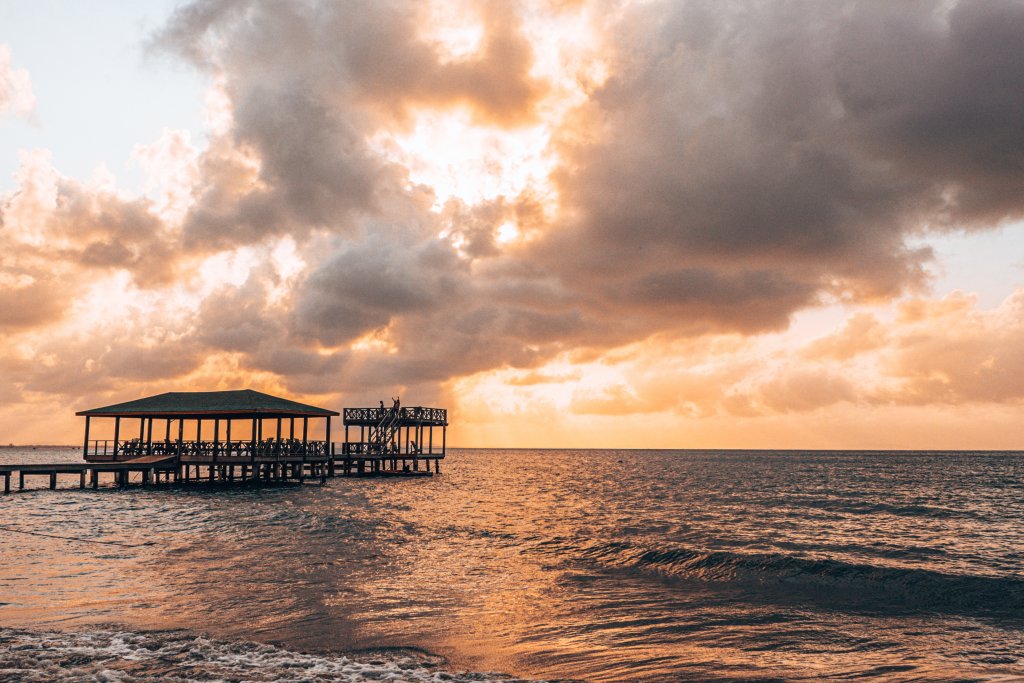
This article may contain affiliate/compensated links. For more information, please see our disclaimer here. We take all the efforts necessary to ensure the information included in this post is accurate, correct and current, sometimes, things just change! Travel information like opening hours, business operations and prices may change. If you find anything in this post that is incorrect or outdated, please let me know in the comments so I can update it for other readers. Cheers!
We love helping you plan amazing trips. If you need any of these services, consider booking them through our affiliate links. Without costing you anything extra, you will be helping support us so we can continue to write these blogs for you.
We thank you again for your continued support.
🏠 Find the perfect place to stay with Booking.com
✈️ Get the cheapest flights with Skyscanner
🚣 Book your favorite activities with Viator
💻 Make sure you have everything you need for your epic trip by checking our store on Amazon
Table of Contents
Health and safety tips in Honduras
1. is honduras safe country .
“Is Honduras a safe country to visit?” is the question you’ll hear the most when you tell people that’s your next destination. If you Google it, you’ll get tons of articles telling you it’s the murder capital of the world, that it’s not safe, and that it should be avoided. This is only one part of the truth.
It’s true that larger cities tend to be more dangerous, in certain areas, especially if you’re out looking for trouble (i.e. drugs). But for the most part, Honduras is really safe. In our three weeks there, we didn’t once feel scared, or like we were in danger. If you’re smart about your trip, and a careful traveler, you should be fine.
But to be extra safe, don’t wear expensive jewelry or electronics. Don’t flash your money around, and you won’t have any problems. The locals we met were all super kind and generous with us. Often, they gave us amazing tips to make our trip even better. Because nothing beats recommendations from locals!
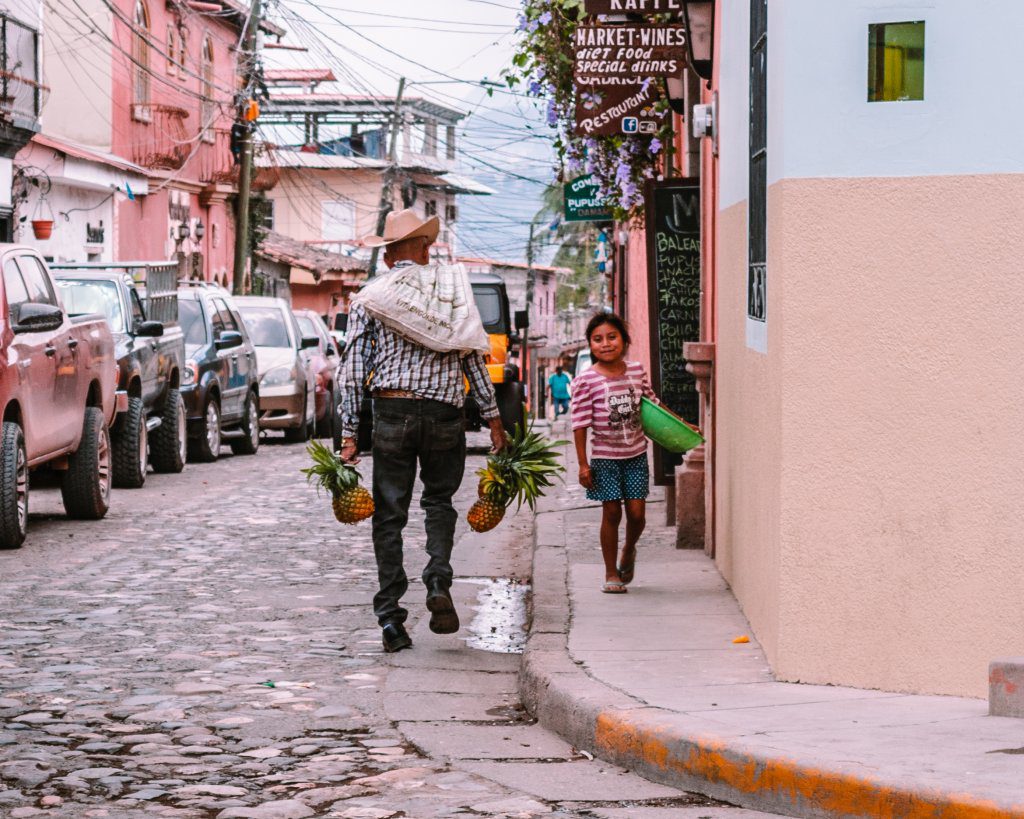
2. Can you drink the water in Honduras?
Unless you’re going around with a water purification system (like the Lifestraw Go or the Grayl GeoPress we have), don’t drink the water. The locals don’t do it either. If you want to avoid getting sick, avoid the lettuce too, unless you know it’s a good restaurant.
In restaurants, the water they serve is filtered and safe to drink. The ice is also safe for consumption so don’t worry about it.
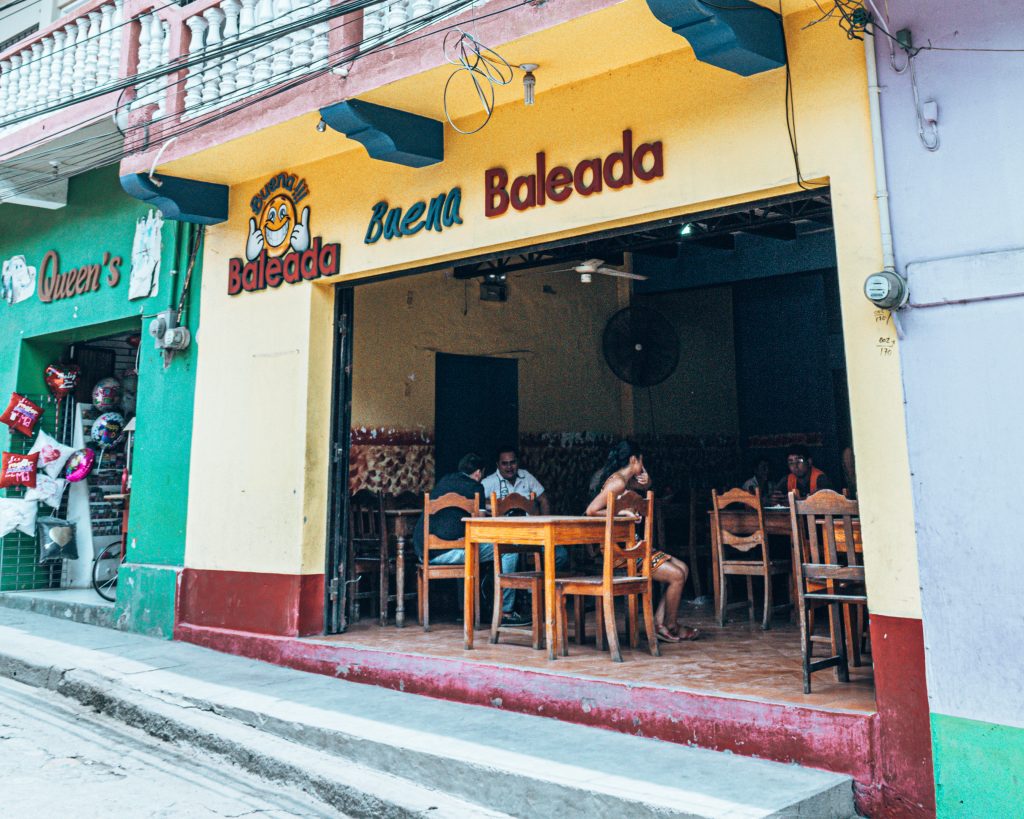
General travel advice for Honduras
3. is it easy to get around in honduras.
To get from one city to the next, we took the express buses . Some are closer to the chicken buses you see in Central America, that have been patched and repatched, the seats are tight and wonky, but the buses are efficient, cheap and don’t stop as often as the public buses.
Most bus companies will have direct routes to make it from one city to the next, although if you are going from one end of the country to the other side, you may have to switch in San Pedro Sula or Tegucigalpa. For example, when we went from Copan to Tela, we had to stop off in San Pedro.
Some of the better companies you should check out are these three.
- Hedman Alas
Although they have websites, their schedules aren’t always up-to-date. Your best bet is to call them to get their latest info. If not, their Facebook pages are usually better maintained than their website.
4. Are the routes developed in Honduras?
Although bus travel is fairly easy, the routes aren’t in such great shape. In fact, in many parts of the country, the routes have recently been developed or paved, so getting around to certain cities may be a challenge. Ask the locals how long and far it will be to get there and it’ll give you a good idea of what’s possible.
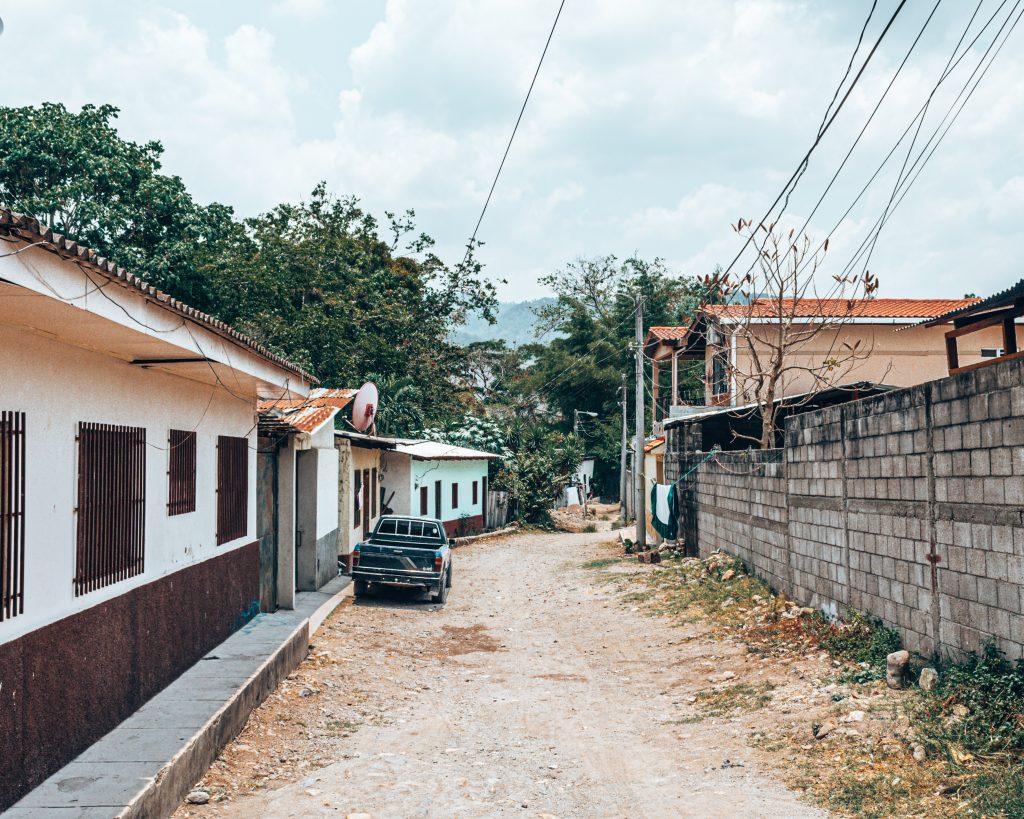
5. Do they only speak Spanish in Honduras?
We’ve always known that speaking many languages is the biggest wealth in the world, and if you speak Spanish, you’ll be golden in Honduras. However, English is widely spoken. Most tuk-tuk or taxi drivers know enough to get you where you need to go. Hotels will have English-speaking staff, especially at reception. And on the islands of Roatan and Utila , almost everyone speaks English.
However, if you speak Spanish, you’ll be able to connect a little more with the locals and get recommendations you wouldn’t get otherwise. So if you can, try to pick up a few words to make getting around easier.
Here are a few sentences to help you out:
- Hola = Hello
- Buenas días = Good morning
- Buenas noches = Good evening
- Cómo estás? = How are you?
- Que bueno! = How wonderful!
- Cuanto cuesta esto? = How much does this cost?
- Dónde está … ? = Where is …?
- La cuenta, por favor = The bill, please
- Quiero ir a … = I want to go to …
- Por favor = Please
- Muchas gracias = Thank you very much
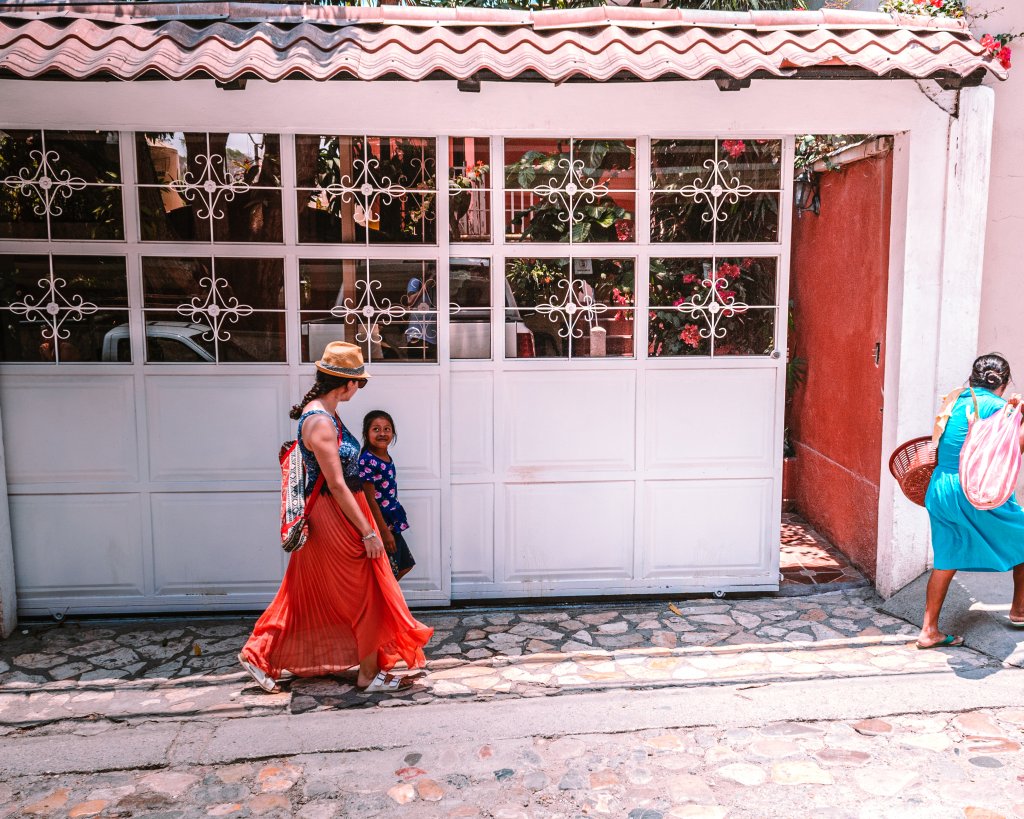
6. Is the local food good in Honduras?
You should not miss out on these delicious meals, especially if you’re vegetarian or vegan . Baleadas are cheap, delicious and nutritious. Thick corn tortillas, filled with refried beans, crema , cheese, and your choice of eggs, meat or plantains. They are a staple of every city we went to. They’re perfect for breakfast, lunch, and dinner. And chances are, you won’t just have one, but at least two!
Then there are pupusas, which are like baleadas, but more like a calzone, as in a closed pocket. They are usually filled with meat, however, so not as vegetarian-friendly.
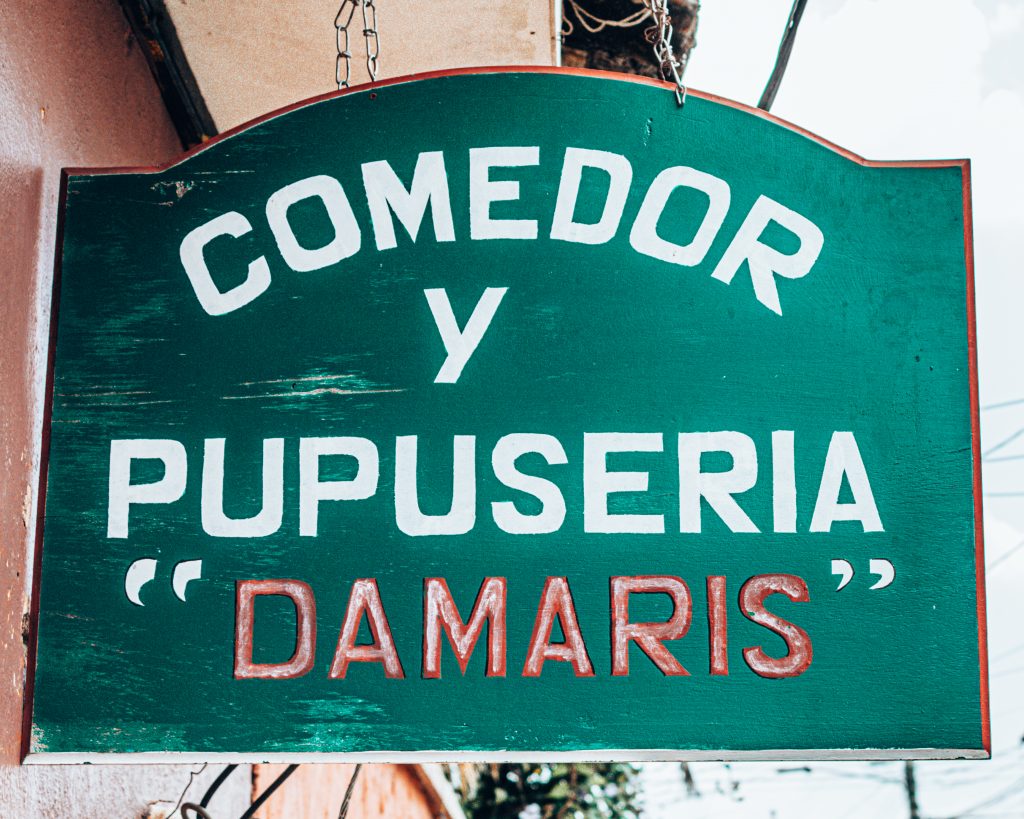
Things to know what to do in Honduras – your guide for the activities
7. is it cheap to scuba dive in honduras.
Utila is probably the cheapest place in the world to learn to scuba dive. Every other business in Utila is a dive shop (we’re exaggerating, but only slightly) and the island is just off the second largest reef in the world. So it’s no surprise that it’s one of the cheapest places to learn how to scuba dive.
You can get your Open water PADI certification for around $300 USD. Many dive shops even include your accommodations in the price of your certification. So if scuba diving is on your list, make sure you learn here. You might even get lucky and spot a whale shark like we did when we learned to dive in Thailand .
8. Is scuba diving better in Utila or Roatan?
The scuba diving is awesome in both Utila and Roatan. The reefs are protected by the eco-marine park , so they are quite healthy. They are also part of the second-largest coral reef in the world, so if you love to scuba dive, this is the place to do it.
And if you can’t scuba dive (and don’t want to learn how to) snorkeling these reefs is an excellent option too! Make sure you have your own mask and snorkel, as certain places charge upwards of $25 USD to rent the material for the day. If you go twice, you’ll have paid off the cost of buying the gear.
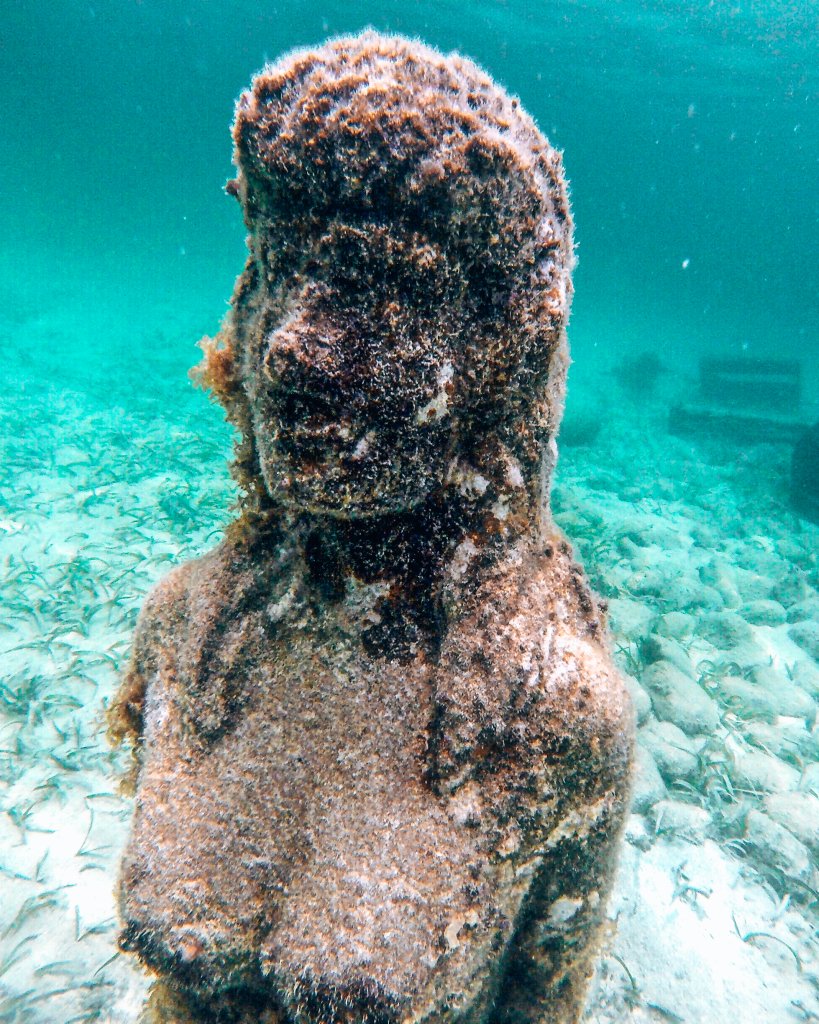
9. Are the Copan Ruins worth visiting?
The Copan Ruins are one of the most spectacular Mayan ruins and are still being excavated. However, because of the lack of tourism in Honduras, they are barely visited.
In fact, many asked us what the best time to go was to avoid the crowds, and our answer was simply ‘anytime!’ because, during our four hours there, we barely saw anyone. And don’t even get us started on the Sepulturas (the area where the nobility used to live), the other site included in the cost of the ticket. NO ONE ever goes there.
So if you’re looking to explore some Mayan ruins without the intense crowds, this is the place to do it. Just make sure you go early, simply because the sun gets hot very quickly!
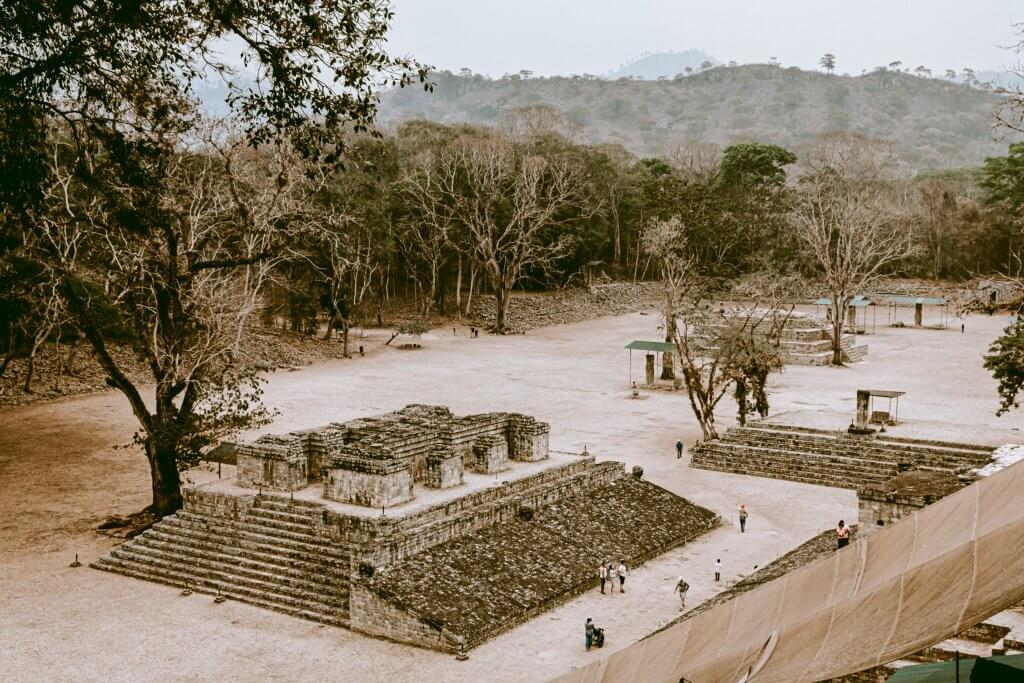
10. Are there any good national parksin Honduras?
From Pico Bonito to Punta Sal and everything in between. The national parks in Honduras are jewels to be uncovered. Hiking, water rafting, waterfall chasing, canoeing, whatever you want to do, you will find a national park that will satisfy your need for adventure. So if it’s an outdoor adventure you’re looking for, look no further than the national parks in Honduras.
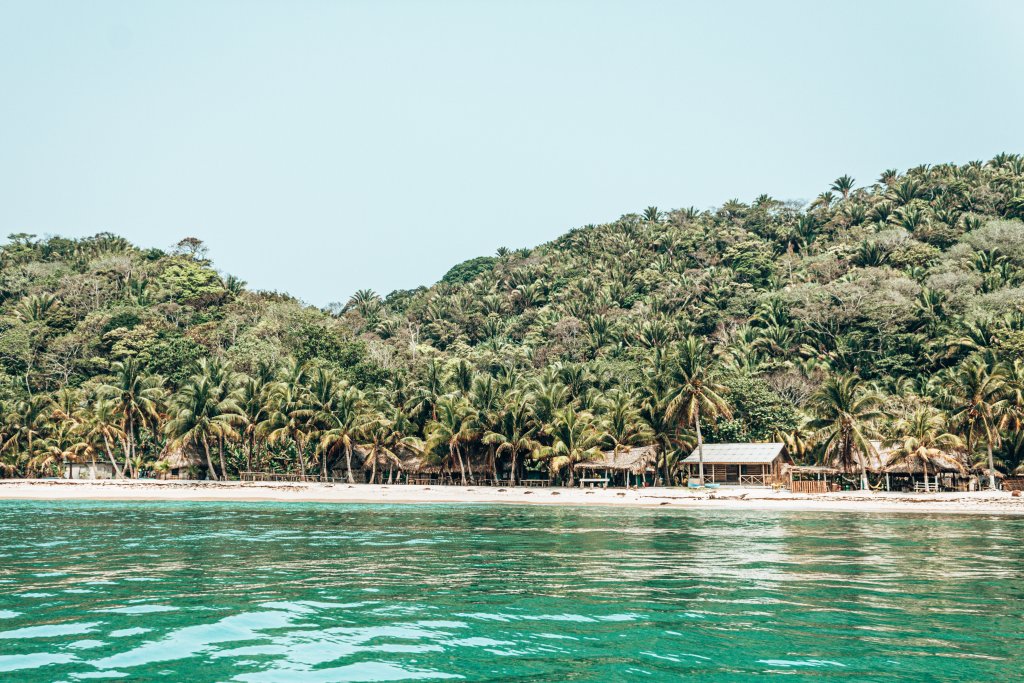
How to travel sustainably in Honduras – Eco-friendly travel advice for Honduras
11. do they recycle in most cities in honduras.
As in most developing countries, recycling is non-existent and trash is burnt. It’s no different in Honduras, except for certain islands (like Roatan), where they do try and recycle. In countries like Honduras, traveling in an eco-friendly way becomes even more important than ever.
Here are a few easy tips for things you can do to travel sustainably in Honduras:
- Avoid plastic bottles by bringing your own water purifying system . Even a reusable water bottle can do the trick as most hotels and restaurants will offer you water refill stations.
- Avoid buying packaged snacks, opting instead for local homemade goods and produce.
- Pick up trash when you see it, especially on beaches.
- If you finish some of your products in plastic bottles (like shampoo or sunscreen), bring them back home with you so you can recycle them there.
- Check out our articles to learn all about how we travel in a more eco-friendly way , or how to reduce the use of single-use plastic .
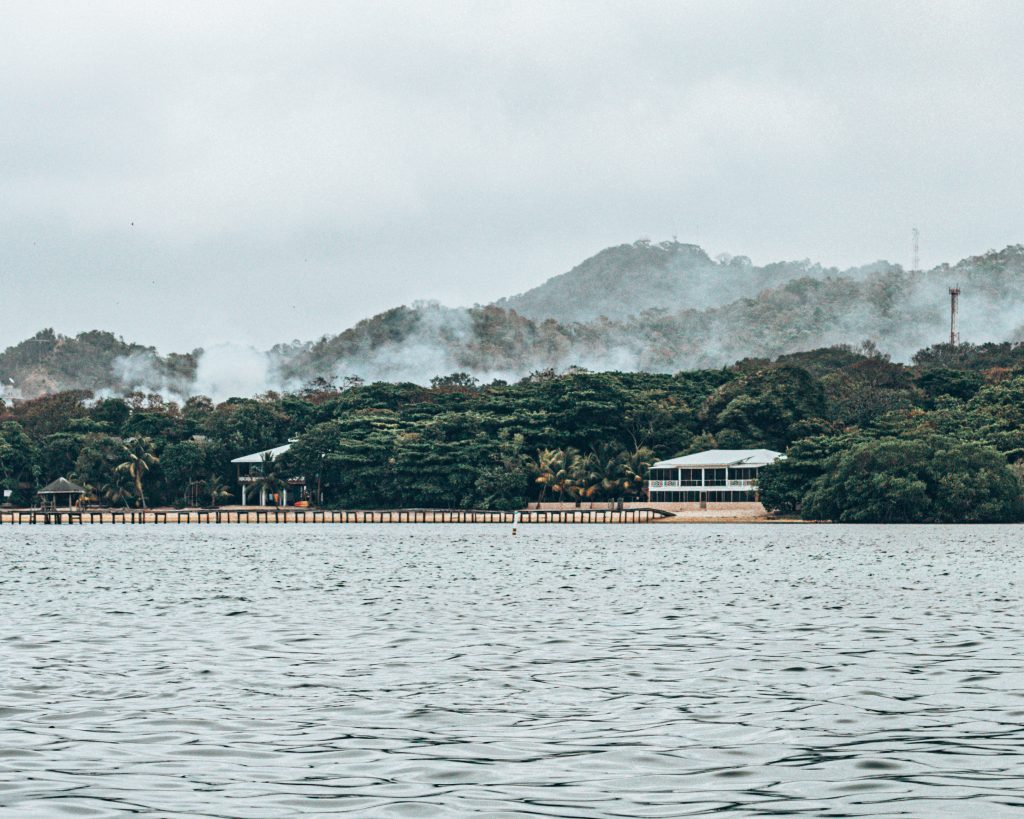
12. Is there a lot of poverty in Honduras? Can we help?
Around 60% of the Honduran population lives below the poverty line. We were told that on average, local Hondurans make $360 USD per month. Although more often than not, they don’t get paid properly and that amount is closer to $100. Imagine trying to feed a family on that salary. It’s heart-breaking!
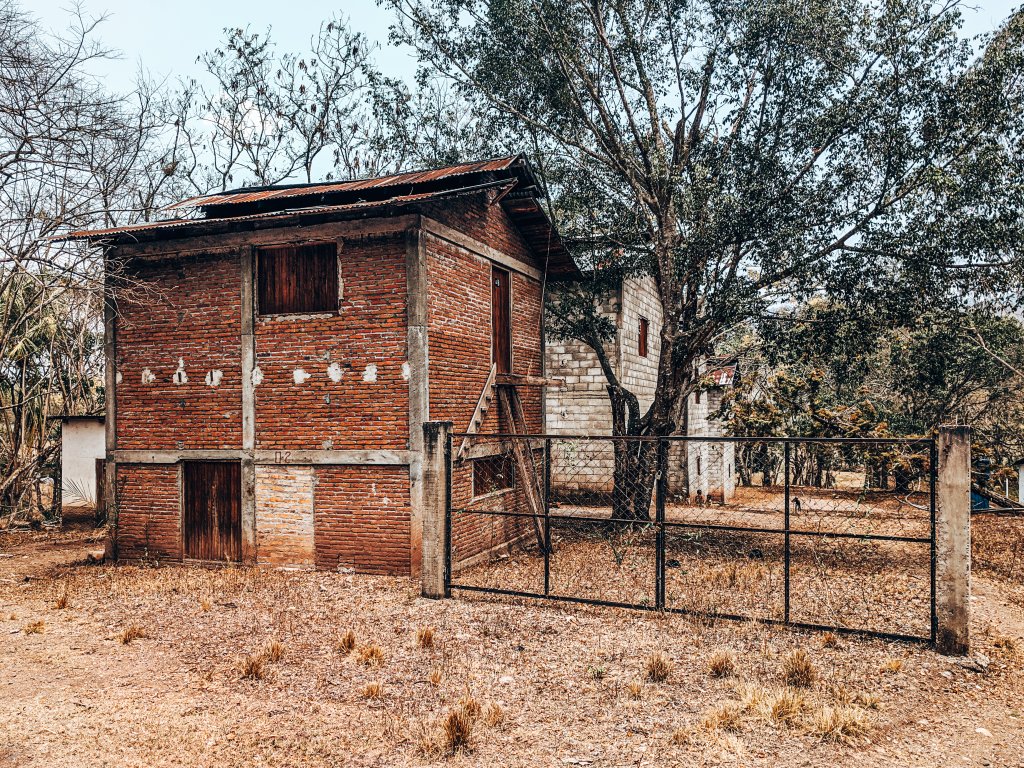
An easy way to help the local economy is to support local businesses, buy local products and produce. Instead of staying in large chains and resorts, opt for mom-and-pop-run hotels, B&B ‘s or guesthouses .
Instead of eating at a food chain, go to a local restaurant. Buy your produce from the lady selling it on the street corner or sustainable local companies.
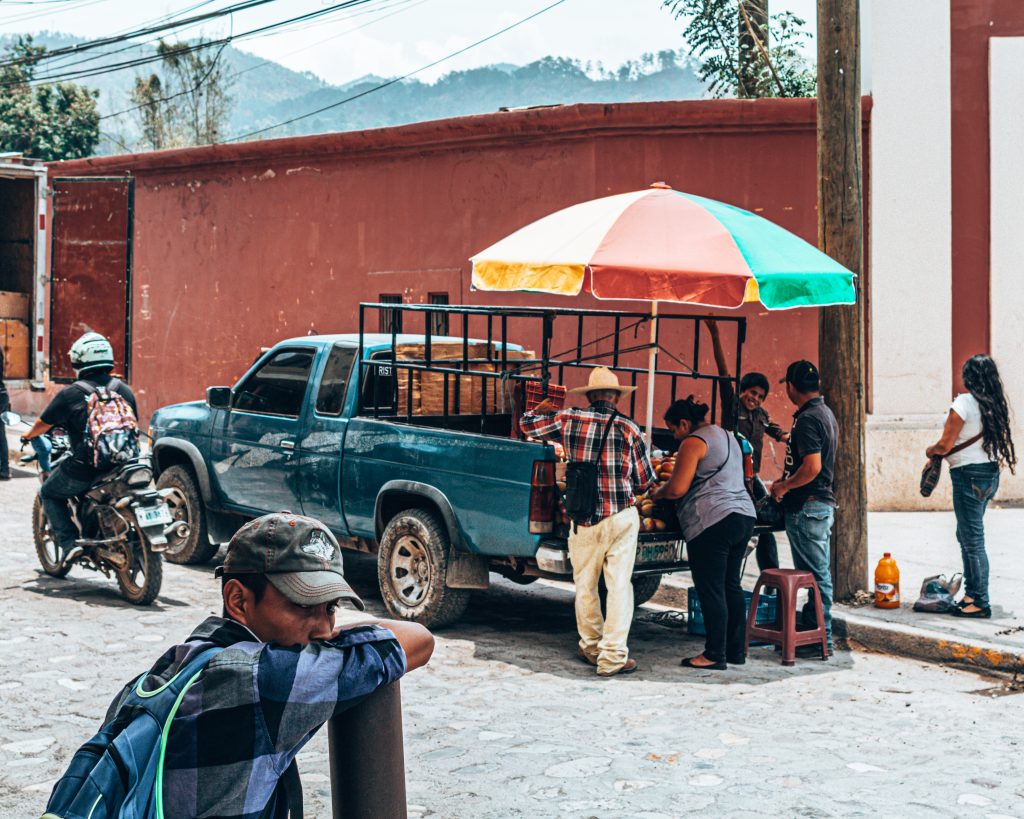
Every little bit helps them more than you can imagine. And when you haggle for the price of something that’s already a good deal, be fair! It may be an extra dollar or two for you, but for them, it’s the difference between eating or not.
However, if you’re looking to volunteer to help out, make sure you don’t do it with orphans or children. Research has shown time and time again that this is a bad solution. Instead, contact the organizations you look into and see if you can help in another way. For example, in Utila , there are a ton of nature and wildlife organizations that could use your help!
13. How can I support small local businesses in Honduras?
From the Roatan Chocolate factory to the Tea and Chocolate Place and the ViaVia hotel and restaurant in Copan , there are a ton of businesses out there trying to change the way things are done in Honduras . They’re more eco-friendly and sustainably run. They’re creating jobs for locals who can then start building a life for themselves and their families. They’re creating a business that will give now and for generations to come.
So when you find businesses like this, support them. Buy their products and tell your friends and family to help if they can. Write a review about them on Tripadvisor to get others to visit as well. It encourages these small businesses to make more important changes and to continue making this world a better place!
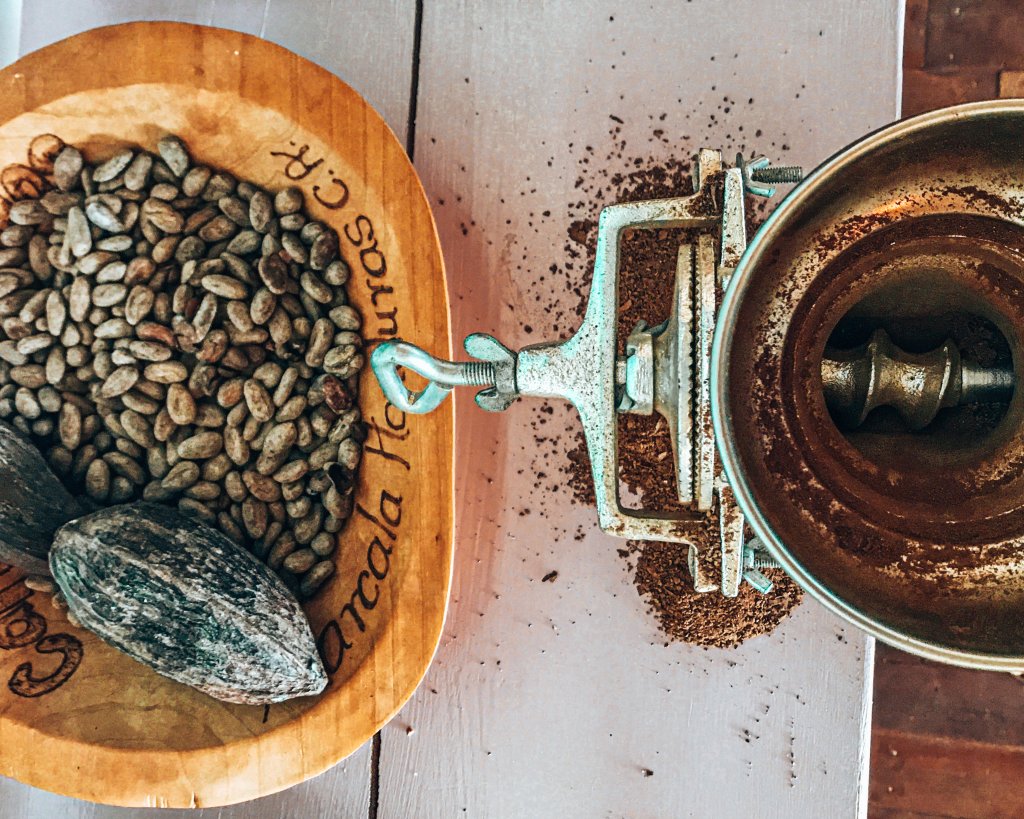
14. Can I swim with dolphins in Honduras? Or see other wild animals up close?
Short answer, yes. You can swim with dolphins and see some impressive wild animals. Should you? The answer is NO !
When you’re in Utila , there are a ton of conservation organizations that you can volunteer with, from whale sharks to iguanas. Unfortunately, the other animal tourism you will find, mainly in Roatan, is to be fully avoided. They have kidnapped dolphins and keep them captive so people can swim with them.
They have caged jaguars and pigs so people can take pictures with them. They have monkeys in chains for the perfect selfie… with a tortured and captive animal.
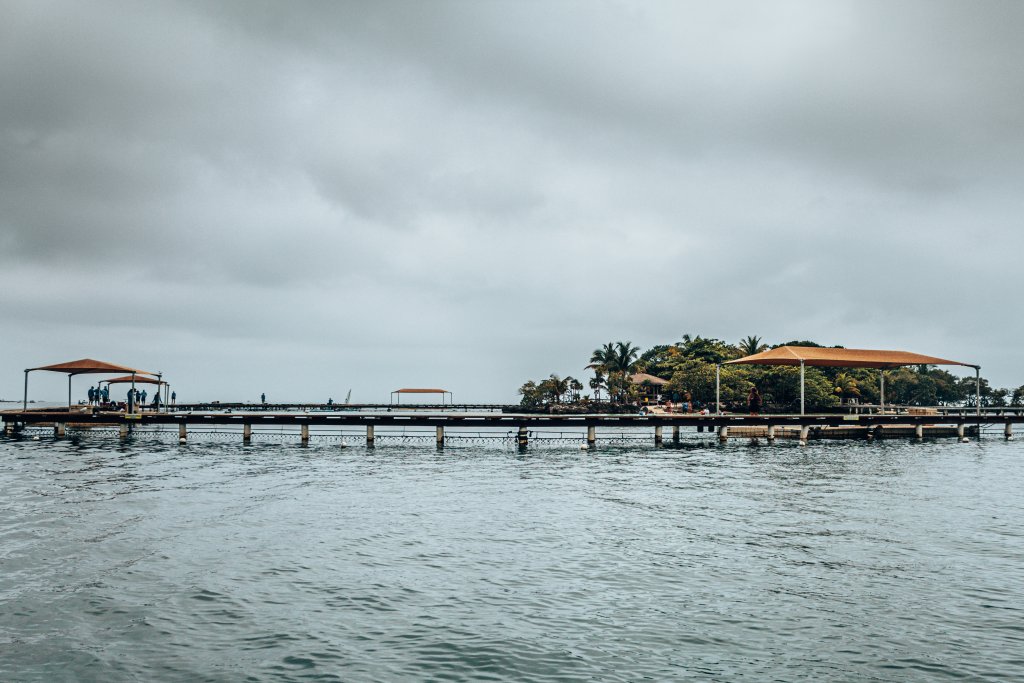
Please avoid this type of animal tourism in Honduras. By not giving these companies your money, you will make them reconsider their ways.
15. Do they have power outages in Honduras?
Let’s not forget that Honduras is a developing country, so they are still trying to figure certain things out. One of those things is how to get power to as many people as possible. In certain places, we had no trouble whatsoever with power outages. However, in a few places, mainly Roatan and Rio Cangrejal, the power went out almost daily.
This shouldn’t discourage you as you won’t be indoors during those times anyway. However, it’s important that you not leave things plugged in while you’re away from your room, or overnight, otherwise a power surge could destroy your valuable electronics.
Also, make sure you check out the power authorities’ Facebook page (like the one in Roatan ) as they’re very good at keeping everyone updated on scheduled outages.
16. Do they also have water shortages in Honduras?
With more and more people on this earth, it’s an understatement to say that certain people in developing countries don’t have access to water. The truth is that there are quite a few families in Honduras that live without water or power. Because this developing country depends heavily on rainwater, the dry season is somewhat brutal.
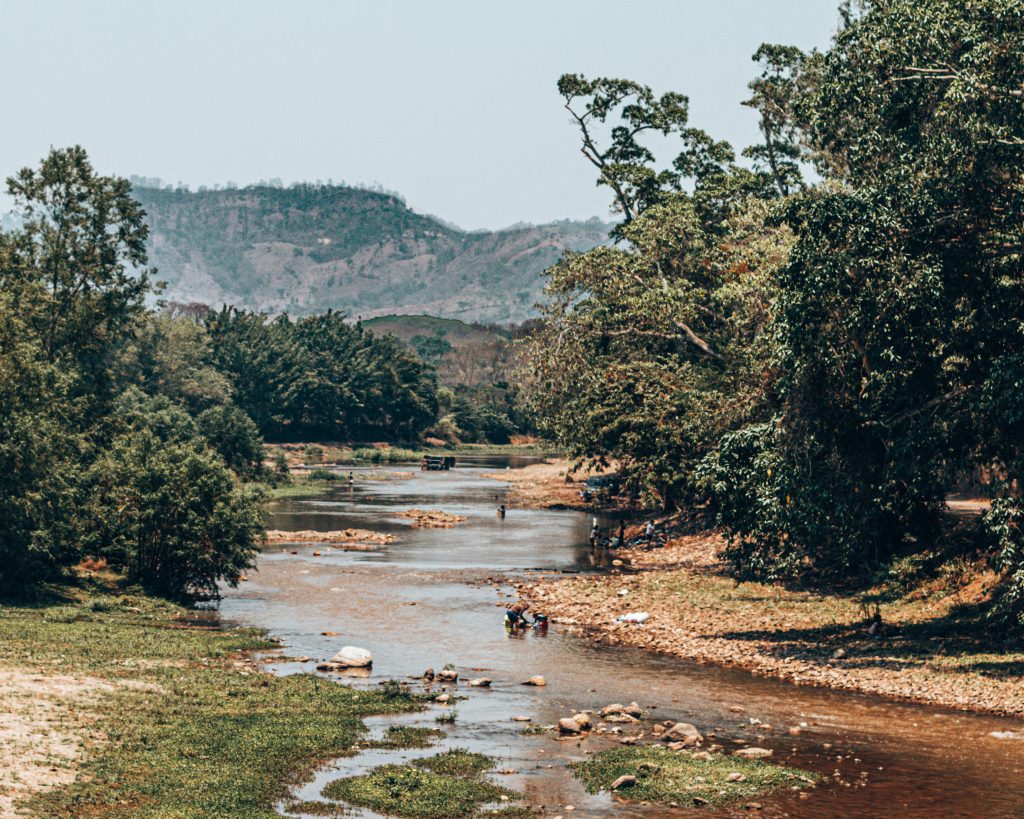
While we were in Copan , we did go through a few hours where there was no water available. It was nothing that was jarring, However, it’s so important that we help out as much as we can. Here are some tips on how you can help the Honduran community by using less water:
- Take shorter showers. Easy enough!
- Take it a step further and turn the water off while you are lathering or shampooing.
- Bring a reusable water bottle as most hotels and restaurants provide water refill stations
- Eat more vegetarian or vegan meals. Meat uses up so much water and resources before it becomes your meal.
- Skip on changing towels and sheets every day. That way, they don’t have to wash them so often.
We have a ton of articles available on how to be more sustainable, like: – How to be a more eco-friendly traveler – The most sustainable travel products for your next trips – How to go plastic-free (or reduce the amount of plastic in your life) – How to be more sustinable in your everyday life
Things to know about money in Honduras
17. what currency does honduras use.
In most of the country, especially mainland Honduras, Lempiras are used by all businesses. However, they do often accept US dollars.
The case is quite different in Roatan. On the island, they mainly use USD. They still use Lempiras , but it seemed like most restaurants and stores had their prices in USD.
18. Do they accept credit cards in Honduras?
You know the rule: ‘Cash is king!’. Most businesses, especially smaller shops and restaurants only accept cash. Certain hotels will accept credit cards, but they are few and far between.
Ideally, make sure you have cash with you, either in lempiras or USD, as this is how the great majority of businesses operate.
If they do accept a credit card, make sure you find out if they charge an additional fee, as some sneaky restaurants or hotels do. This is an extra fee on top of the conversion rate the credit card company charges. Just know that charging a fee to use a credit card is illegal. Refuse to pay with your card if ever the business does charge.
19. Should I leave a tip in Honduras?
The first thing you should do is to check your bill. Usually, they’ll note ‘ Servicio ’ if they do charge a service charge. In which case, you don’t need to leave a tip, unless your waiter was exceptional. If they were, you should leave an extra tip, but make sure you hand it directly to them. If not, whatever extra tip you leave will be split with the rest of the staff, just like the Servicio charge.
If there is no Servicio being charged, and you were pleased with your service, feel free to leave a tip. Anything above 10% for your waiter is a good amount. Remember that most of the population in Honduras live below the poverty line, so anything you can offer as a tip will go a long way for the staff.
20. Should I have small denominations of money?
If you’ve traveled to countries that have large denominations, you know how hard it is to come by the small change you actually need to conduct daily transactions. Honduras is no different. Most ATMs will give you money in 500 lempiras (roughly $20 USD). The unfortunate thing is that 500 lempira is a lot of money for most small purchases you make.
Ideally, try and break the large bills in larger restaurants, hotels, and shops. Avoid using big bills (100 or 500 Lempiras) at small shops if you can. You might be asking the shop owner to have more than his daily/weekly income on hand to offer a change. This is especially true for small fruit and veggie stands, or little convenience store.
Also, it’ll help you avoid getting scammed as most taxi drivers (either on water or land) will pretend not to have smaller denominations to avoid giving you any change back.
21. Can I exchange lempiras outside of Honduras?
If there’s one thing we never seem to learn is that you should absolutely exchange the local currency to $USD BEFORE you leave a country! This is no exception for Honduras.
We forgot to do it when we left the country and barely found an exchange bureau that accepted to buy our lempiras. And when we found a place that did accept them, they bought it at such a ridiculous price!
Travel advice in Honduras to make your trip more enjoyable
There you have it! These are the travel tips for Honduras we wished we knew before we got there. We didn’t have any safety issues or other types of problems while we were there. As we mentioned, we always felt safe and we really enjoyed our time in Honduras. We highly recommend you visit as well.
We hope that this helps answer a few of the questions you have about traveling safely to Honduras. If you have any other questions, let us know in the comments and it’ll be our pleasure to answer them!
We put a lot of time and effort into the content we create. Please like, comment and share, every action on your part helps us out tremendously and is very much appreciated.
You can also help us by pinning it for others to find.
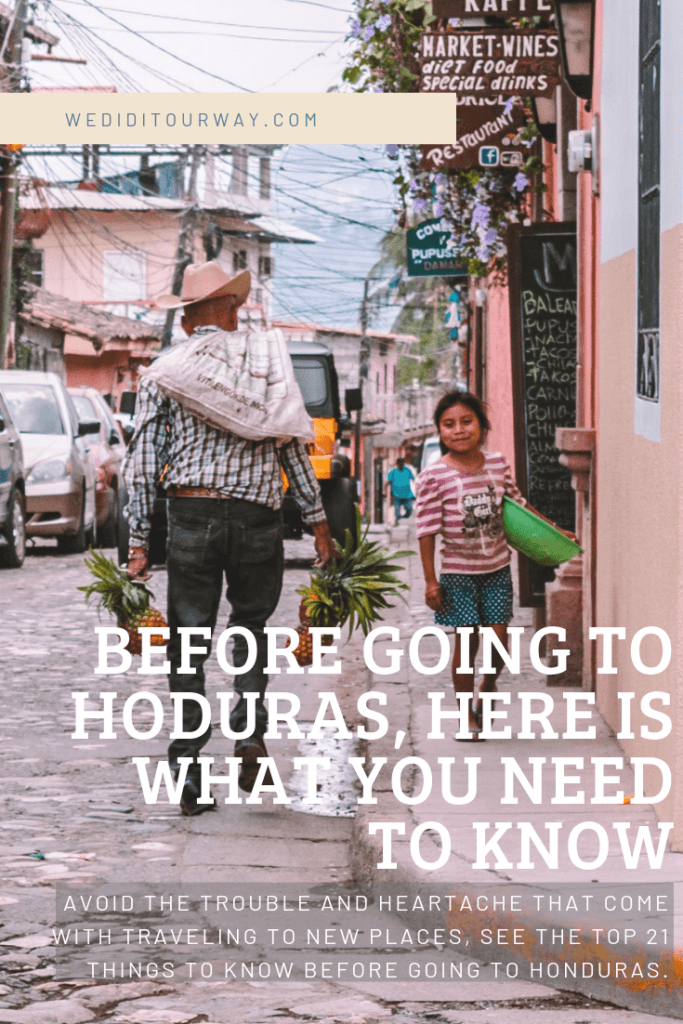
You Might Also Like:
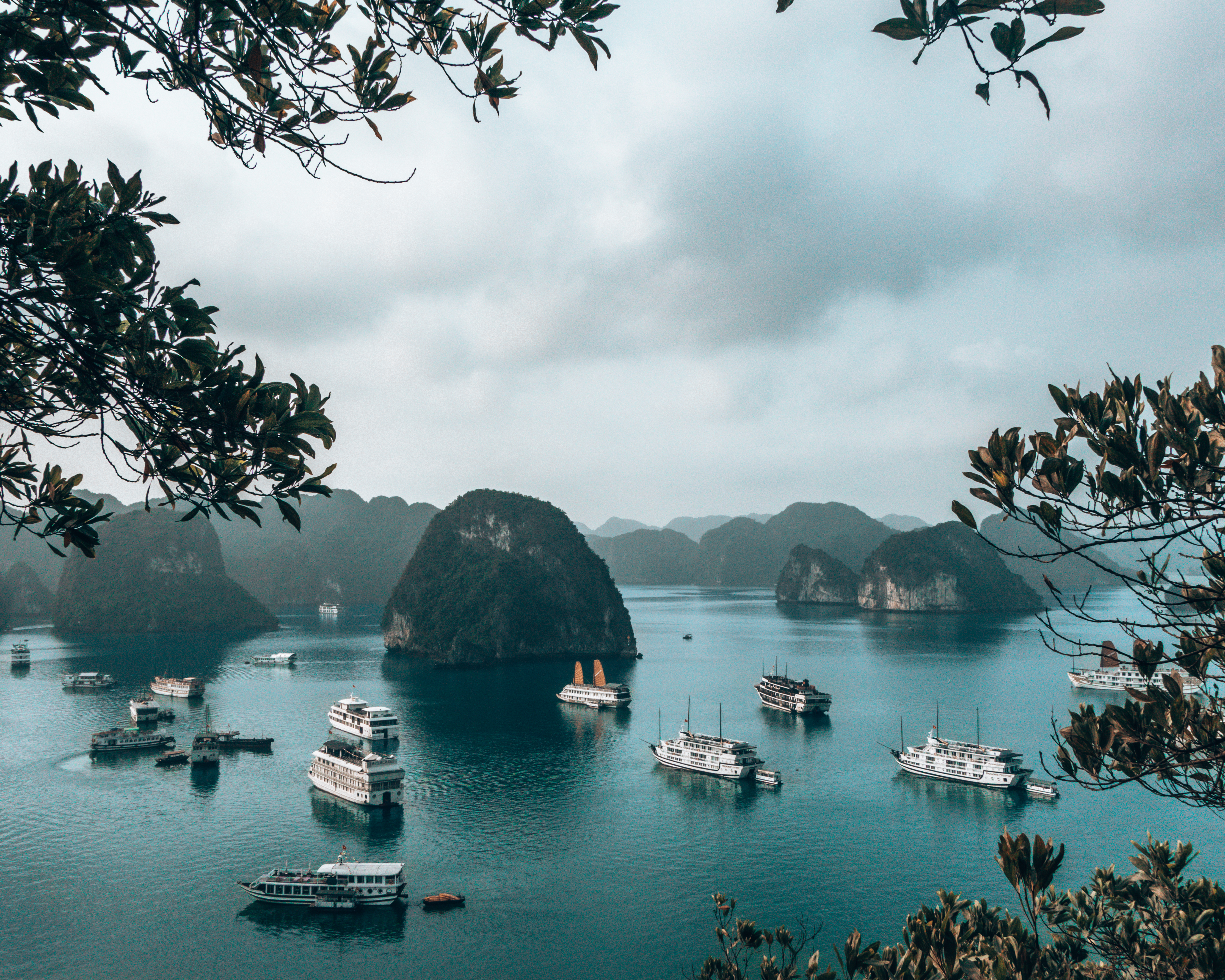
5 reasons you should avoid Halong Bay
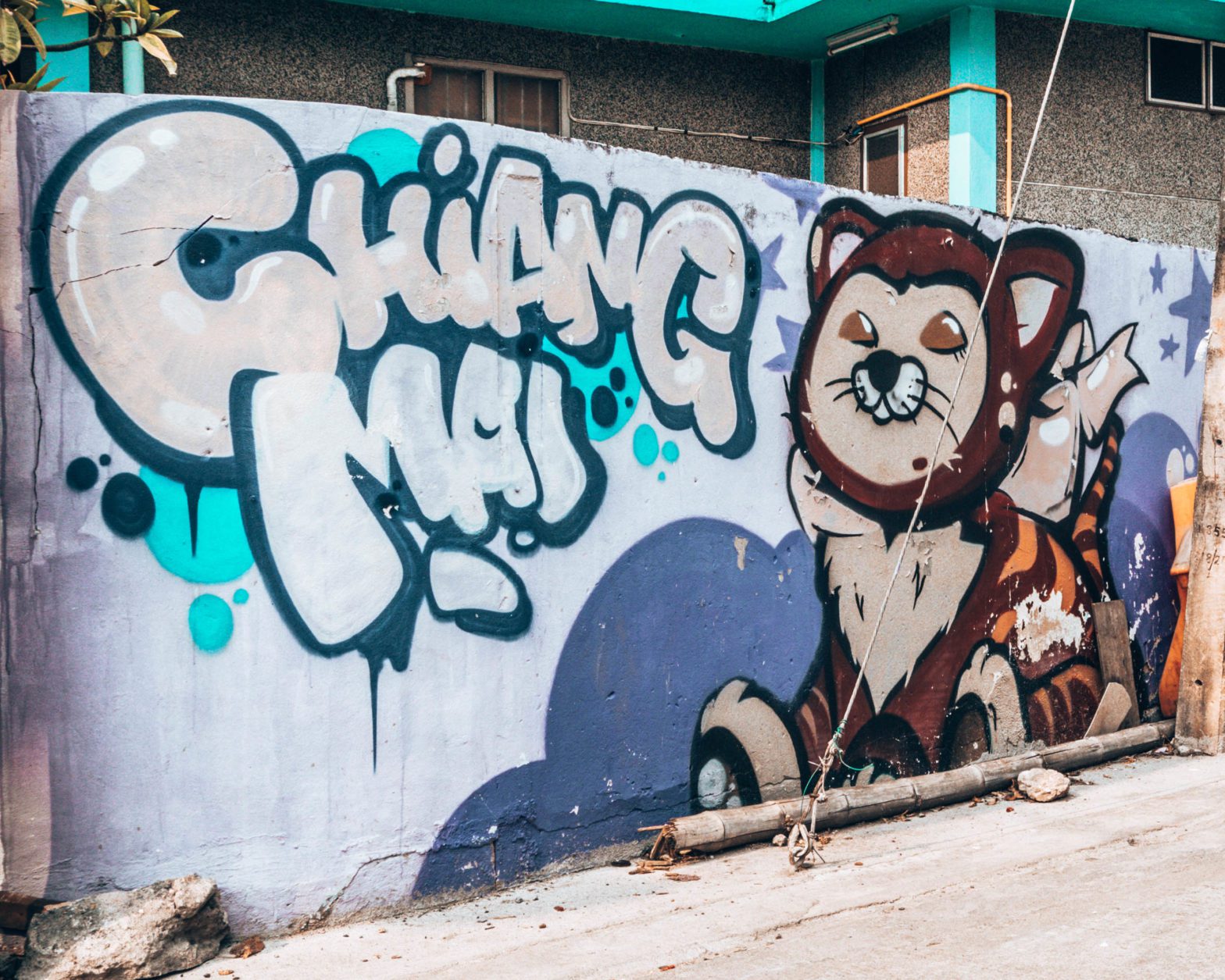
Street art in Chiang Mai

The 13 best things to do in Utila, Honduras
Submit a comment cancel reply.
You must be logged in to post a comment.
We’re Carine and Derek, two Canadians in love with each other, the environment and this world. We left our old routines behind to discover all the wonders our planet has to offer. We want to inspire everyone to chase their dreams and leave a positive impact on Earth.
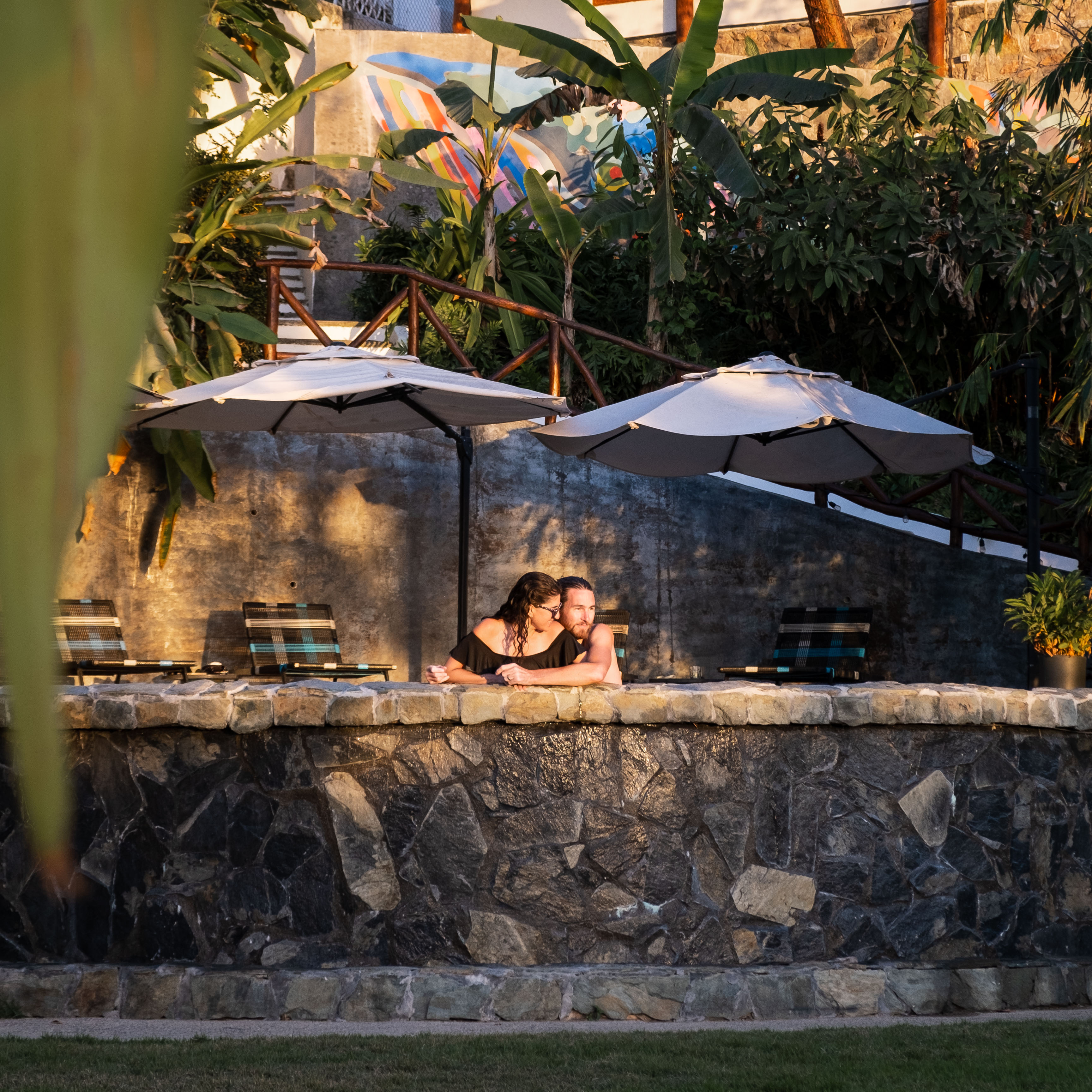
Let’s keep in touch!
Sign up for our newsletter to get our free e-book as well as our latest updates, travel recommendations, eco-friendly advice, inspiration, good vibes and so much more.
Thanks, see you in your inbox!

How to build a micro-influencer media kit – Step-by-step instructions for new content creators
Big or small, every influencer or content creator needs a media kit. They’re a part of the essential tools you need if you want to collaborate with brands. All too often, they're poorly made and lack the important information brands need to know that they HAVE TO work...

31 easy ways to go plastic-free
For July, we joined hundreds of million people around the world to go plastic-free. Our goal was to avoid all plastic for #plasticfreejuly. During the whole month, we shared our tips with our Instagram community to help them ditch plastic too. These are our 31 easy...
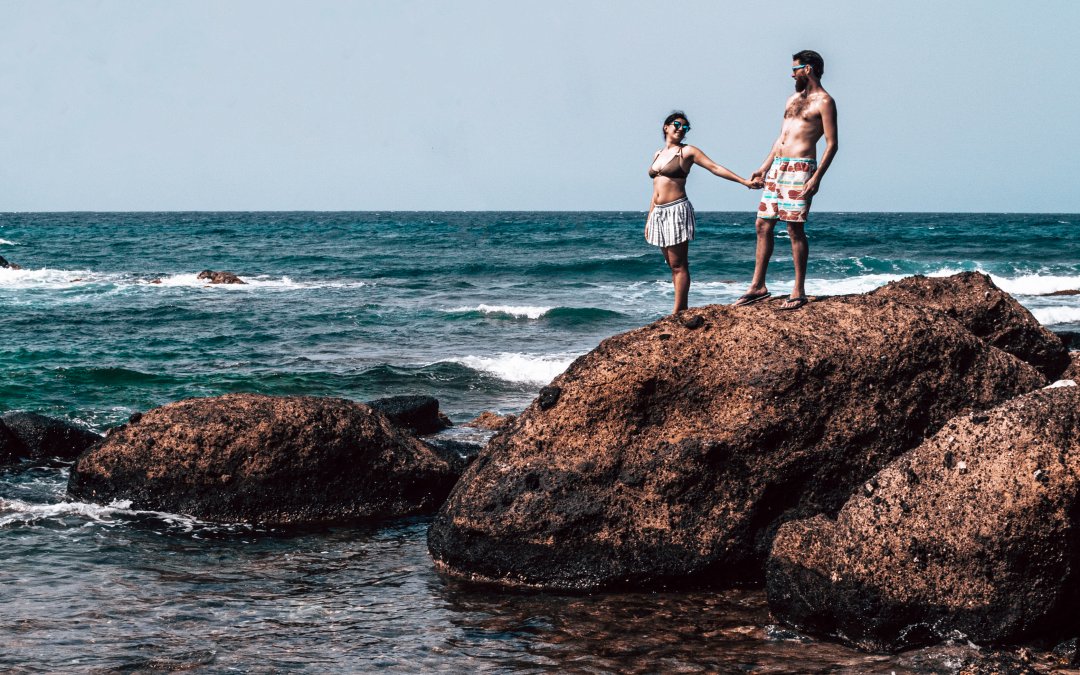
Your ultimate 2-week Honduras itinerary – The best things to do on vacation in Honduras
Welcome to the most underrated and under-visited country in Central America, Honduras. If you’re here, you’re probably thinking about visiting this beautiful country, and we’re here to tell you that you’re in for a real treat! Most people avoid Honduras, thinking it’s...
Follow us on Social Media

16 Top-Rated Tourist Attractions in Honduras
Written by Karen Hastings Updated Sep 26, 2022 We may earn a commission from affiliate links ( )
A diamond in the rough, Honduras, Central America's second-largest country, dazzles visitors with its natural beauty and diverse wildlife. Nature lovers can explore idyllic Caribbean beaches, bird-rich lakes and jungles, and the undeveloped tropical rainforest of the Mosquito Coast, among many other attractions.
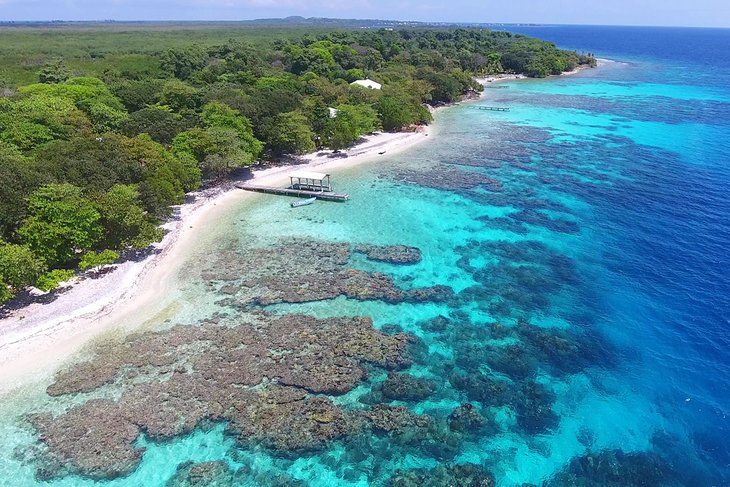
But the country's prized jewels are the beautiful Bay Islands. Ringed by thriving coral reefs – part of the world's second biggest barrier reef , which stretches north to Mexico – these laid-back islands lure many divers, snorkelers, and travelers seeking a relaxed tropical vibe.
Rich in culture, Honduras is also home to the archeological treasures of Copán , one of the finest Maya sites in the world. Other adventures include dolphin encounters, birding tours, rafting trips, and the chance to swim with gentle whale sharks.
Discover a world of wonder in this diverse country, with our list of the top attractions and places to visit in Honduras.
1. Roatán, Bay Islands
2. copán ruins archeological site, 3. utila, bay islands, 4. dolphin encounter, roatán institute for marine sciences, 5. museum of mayan sculpture, copán, 6. la tigra national park, 7. lake yojoa (lago de yojoa), 8. parque nacional jeanette kawas, 9. cayos cochinos, 10. lancetilla botanical gardens, 11. río plátano biosphere reserve, mosquito coast, 12. museum of national identity, tegucigalpa, 13. cusuco national park, 14. carambola botanical gardens & trails, roatán, 15. little french key, bay islands, 16. pico bonito national park.
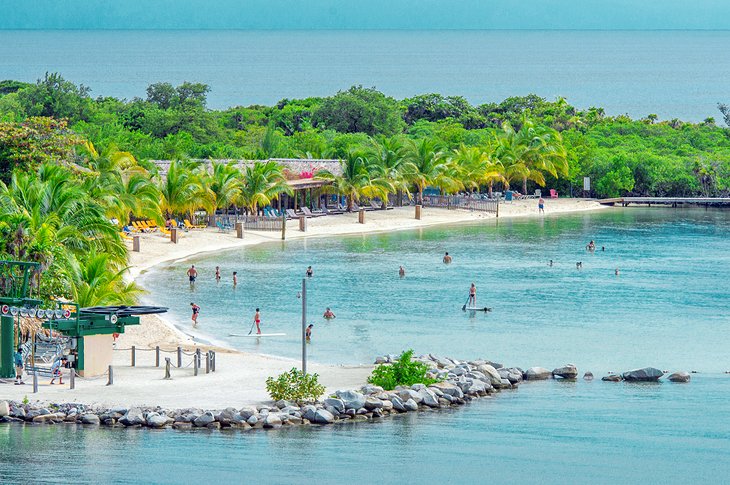
Roatán is the largest and most developed of the Bay Islands. Once a well-kept secret, it is now a cruise ship port and a popular vacation destination – especially for avid divers and snorkelers.
A mountainous backbone undulates through the island's center, and flourishing coral reefs fringe its shores, offering superb opportunities for diving and deep-sea fishing .
Even with the influx of travelers, Roatán's beaches are beautiful. One of the best strands is West Bay Beach. Although packed on cruise ship days, it ticks all the boxes, with clear waters, snorkeling, swaying palms, and plenty of shops and restaurants nearby.
The small community of Sandy Bay is the cultural center of Roatán. Top tourist attractions here include the Roatán Institute of Marine Sciences with its popular dolphin encounters; Roatán Museum ; the Carambola Gardens, a favorite with nature lovers; and the Roatán Marine Park , with excellent snorkeling.
Craving a cute animal encounter? Head to Manawakie Park , where you can cuddle sloths and get up close to capuchin monkeys, as well as soak up a dose of Honduran culture. Gumbalimba Park is another haven for wildlife lovers with sloths and monkeys. You can also pose for a photo with colorful macaws and soar through the jungle on an exhilarating zipline.
Other top things to do in Roatan include visiting the environmentally friendly Blue Harbor Tropical Arboretum and the Butterfly Gardens. Tucked in tropical fruit trees, the garden spotlights butterfly species native to Honduras and the Bay Islands.
French Harbour is Roatán's biggest fishing port and the economic engine of the island. A popular attraction here is Arch's Iguana and Marine Park .
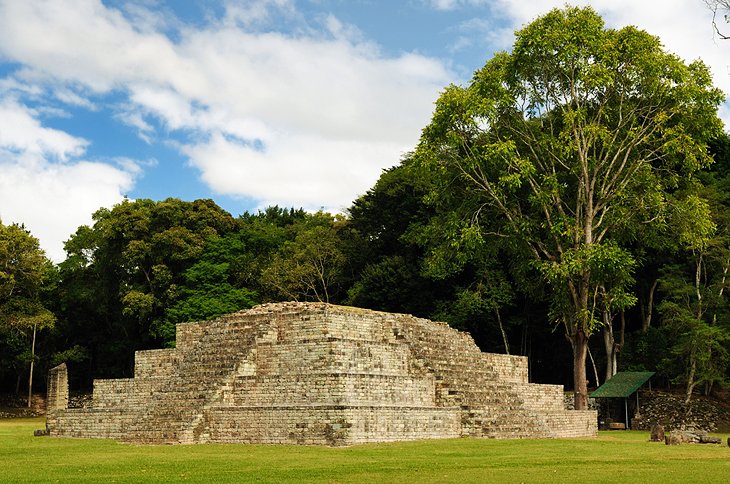
Copán Ruins Archeological Site (Copán Ruinas Sitio Arqueológico) is the most studied Maya city in the world and a UNESCO World Heritage Site . Dating back nearly 2,000 years, the society that lived here was highly stratified, deeply symbolic, and focused on tradition.
You will find plenty to appreciate here. The site is famous for the stelae and altars that are scattered around the immense plaza, most of which were erected during the years 711 and 736. Other highlights include the ball court; the Hieroglyphic Stairway, a unique temple, which holds the longest known Mayan text; and the Acropolis featuring superb carved reliefs of the 16 kings of Copán.
About 1.6 kilometers from the central acropolis, Las Sepulturas archaeological site forms part of the "PAC" (Proyecto Arqueológico Copán) and provides valuable insight into how the Mayan elite lived during the days before the collapse of Copán. While you're exploring the site, keep an eye out for the spectacular scarlet macaws flying among the ruins.
After touring the ruins, don't miss the Museum of Mayan Sculpture , which displays impressive artifacts recovered from the site. Many visitors also like to stroll along the well-signed nature trails , where birds and butterflies dart among the thick foliage.
Not far from Copán, El Puente is a smaller Mayan archaeological site on the Chinamito River with several pyramids that have been partially restored.
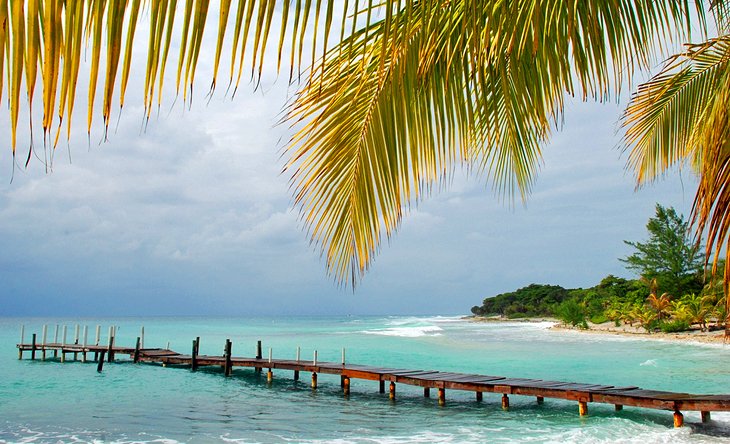
About 32 kilometers from the west coast of Roatán , Utila is the most budget-friendly of the Bay Islands. Backpackers flock to this small, 13-kilometer-long-island, and many visitors come here on affordable dive vacations.
Presiding over an arching bay, Utila Town is the main settlement, where locals compete fiercely over domino games and tourist shops and dive centers dot the streets. Save time to enjoy some fresh seafood and traditional Honduras cuisine at one of the funky waterfront restaurants here.
Besides diving, most visitors bide their time basking on the two slivers of beach, snorkeling in the lagoon, zipping out to a sprinkling of cays off the island's southwest coast, and soaking up the rustic tropical vibe. You can also get up close to some of the island's wildlife at the Iguana Research & Breeding Station .
Dive operators also offer the chance to dive or swim with whale sharks . These gentle giants are frequently spotted in the waters around the island - especially during March to April and August to September.
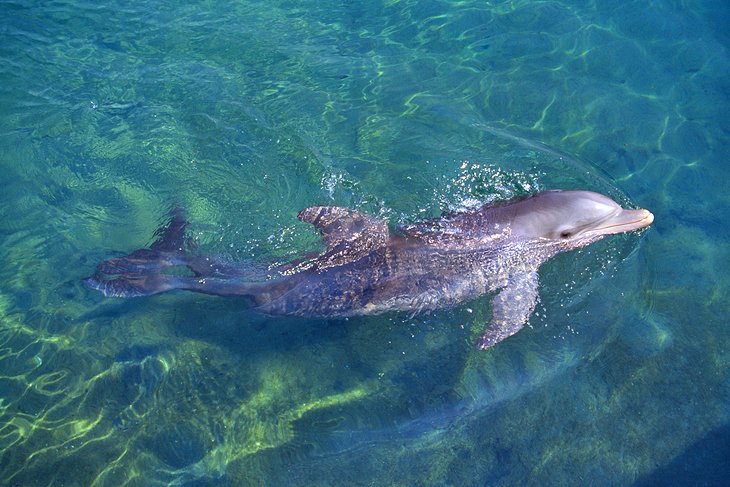
On the northwest coast of Roatán at Anthony's Key Resort , the Roatán Institute of Marine Sciences offers an unforgettable dolphin experience. Best of all, it takes place in a natural lagoon, where the dolphins are free to swim around in a large area like they do in the wild. The center also educates locals and visitors about marine ecology.
Besotted animal lovers can swim and snorkel with the dolphins, play simple games with them, participate in a dolphin specialty course, or enjoy a dolphin dive experience. Budding marine biologists can also sign up for the "Dolphin Trainer for a Day" program and perform their own dolphin show for their proud parents at the end.
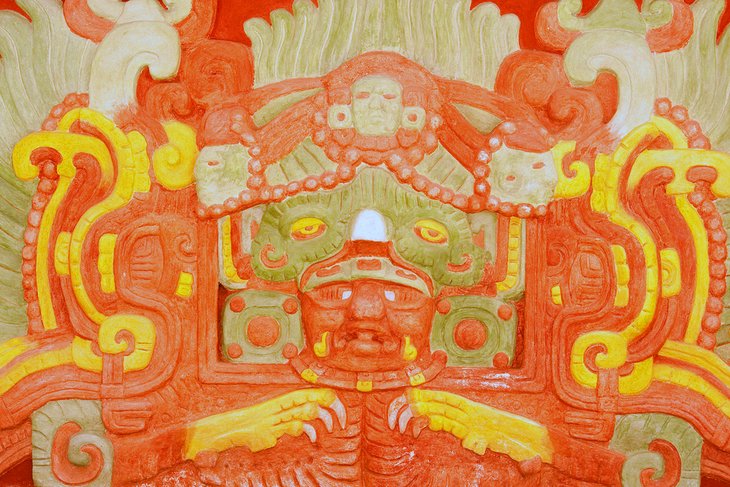
At the Copán Ruins Archeological Site, the superb Museum of Mayan Sculpture is an essential stop on any visit to the ruins. It displays a series of original pieces of sculpture, stelae, and altars recovered from the site.
The museum, which tunnels through a hillside before opening out into a vast sunlit open space, is best visited after touring the ruins to understand where the pieces on display originally belonged.
The collection has a total of over 3,000 pieces of original Maya sculpture and carvings depicting spiritual entities, people, and sacred animals like macaws and bats. There are also several buildings on-site that were rebuilt from the pieces found in the nearby dig site.
Undoubtedly, the masterpiece here is the full-sized replica of the ornate Rosalila Temple , discovered intact under structure 16 in the acropolis.
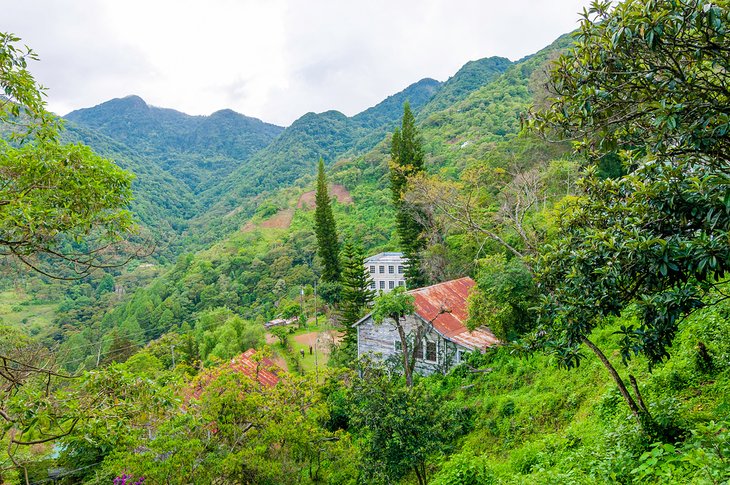
About 20 kilometers from Tegucigalpa, La Tigra National Park (Parque Nacional La Tigra) is one of the most beautiful places to visit in Honduras. Perched at an altitude of 2,270 meters, this unspoiled park preserves a lush cloud forest that is home to ocelots , pumas , and monkeys , although it's rare to see these larger mammals.
This is one of the most visited parks in Honduras and offers a vision of how the area looked long before logging claimed much of the surrounding forests.
The park is also a haven for birds - more than 200 species flit within its borders, including toucans, trogons, and the elusive quetzal. Well-marked hiking trails wind through the thick forest, where bromeliads and orchids flourish.
Stop by the visitor's center at each entrance for maps and park information and to pay the admission fee. Guides can also be arranged here.
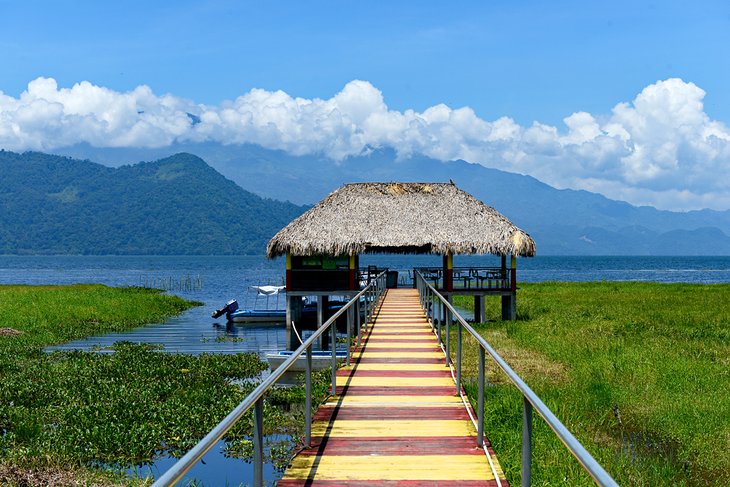
Along the main road between Tegucigalpa and San Pedro Sula, Lago de Yojoa is the largest natural lake in Honduras and a haven for birders . More than 480 species have been spotted here, including whistling ducks, northern jacanas, and crakes.
You can explore this shallow lake from shore, or glide through the reeds in a canoe or kayak. Two mountainous national parks border the lake: Santa Bárbara National Park on the northern shore and Cerro Azul Meambar National Park to the south.
Other popular things to do in the area include hikes to waterfalls, exploring an underground cave system, and tours of coffee plantations and archeological sites.
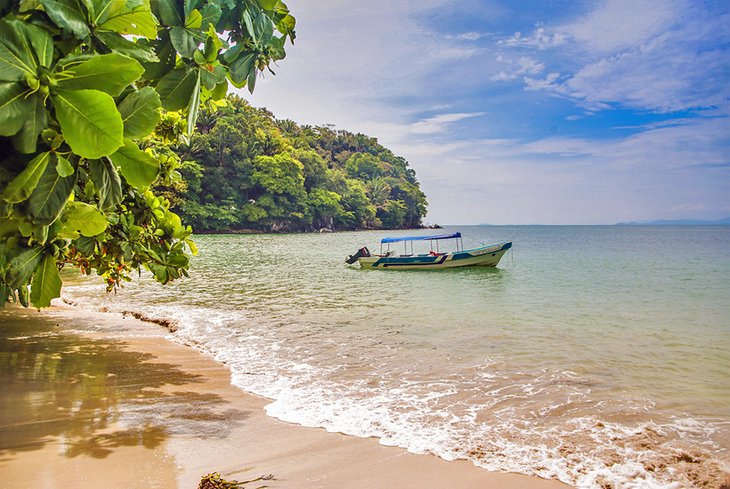
Formerly known as the Punta Sal National Park , this beautiful wilderness area is now named after the environmental activist, Jeanette Kawas, who fought passionately during her life to preserve its rich ecosystems.
The park stretches along a peninsula at the western end of the Bay of Tela and supports diverse habitats, from tropical jungle, mangroves, and wetlands to sparkling beaches and coral reefs.
Wildlife is abundant and includes many rare species. Visitors may encounter dolphins; howler monkeys; and a large variety of tropical birds, including toucans, quetzals, and motmots. The Micos Lagoon has the highest population of birds in the area, with up to 350 different species.
Tour operators run day trips to the park from Tela, which typically include a hike across the peninsula to a pretty beach, swimming, snorkeling, or diving and an optional visit to the traditional Garifuna village of Miami on a picturesque beach and lagoon.
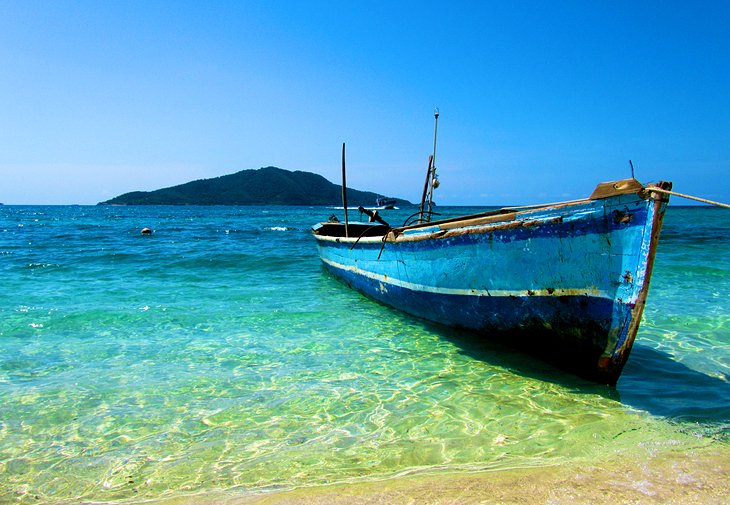
Also known as the Hog Islands, the archipelago of Cayos Cochinos is an undeveloped, quintessential tropical paradise. This group of small, privately-owned islands and cays lies 17 kilometers off the coast near the old banana port of La Ceiba .
The islands and the black coral reefs that surround them are a Marine Biological Reserve and remain pristine due to their remote location and difficult access. A true back-to-nature experience, Cayos Cochinos offer excellent snorkeling, diving, hiking, and bird-watching.
Accommodation options include rustic eco resorts, as well as hammocks or huts at local Garifuna villages . The islands are accessible only by boat from La Ceiba, Roatán, or Utila.
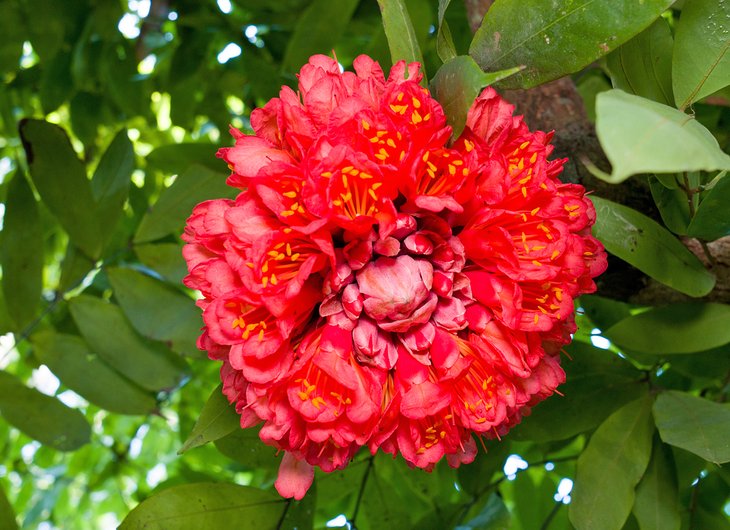
About five kilometers from the city of Tela , Lancetilla Botanical Gardens are the second largest tropical botanical gardens in the world .
In 1926, the United Fruit Company established the gardens as an experimental site to test the economic viability of various fruit and hardwood trees. Today, the magnificent groves of trees from Central America and other tropical regions comprise part of a protected wildlife corridor along the country's north coast.
More than 200 species of tropical birds have also made the garden home due to the abundance of fruit trees. Birders will be rewarded with many sightings as they wander along the well-marked trails through profuse plantings of palms, orchids, and mango trees, among others.
One particularly beautiful path leads through a tunnel of bamboo trees to a swimming hole in the Lancetilla River, a refreshing place for a cool dip after a long, hot walk.
This is a place where it's definitely worth organizing a guided tour, so you can learn interesting facts about all the different trees and plants in the gardens.
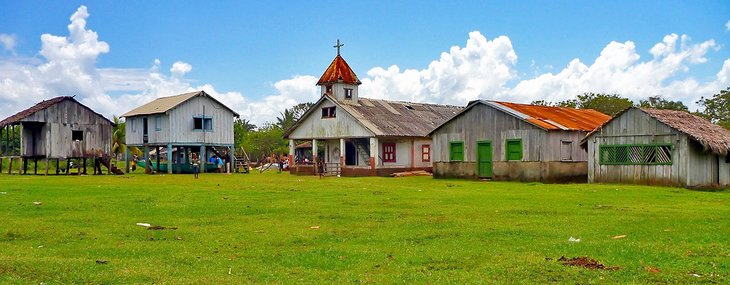
In 2011, UNESCO placed this massive swath of jungle along the remote Mosquito Coast on the World Heritage in Danger list . It is one of the few remaining tropical rainforests in Central America.
The reserve lies in the watershed of the Río Plátano and forms a mosaic of lowland tropical rainforest, coastal lagoons, undisturbed beaches, mangroves, grasslands, and patches of pine savannah.
Steeped in tropical humidity, this important wilderness area harbors a rich diversity of wildlife, including howler monkeys, scarlet macaws, giant leatherback turtles, toucans, and tapirs. Sadly, reports of logging and hunting continue to threaten the reserve's fragile habitats.
Sloping down to the Caribbean Sea, the mountainous landscape is also home to more than 2,000 indigenous people of the Miskito and Pech tribes, as well as the Garífuna, who continue to live their traditional lifestyle. Archaeological sites also lie within its borders.
The best way to explore the Río Plátano Biosphere Reserve is on an organized tour. Experienced guides can take you to the safe places to visit in this remote area of Honduras, away from drug smugglers and illegal loggers who often venture deep into the reserve. Ecotourism companies offer wilderness adventures and rafting trips down the Río Plátano.
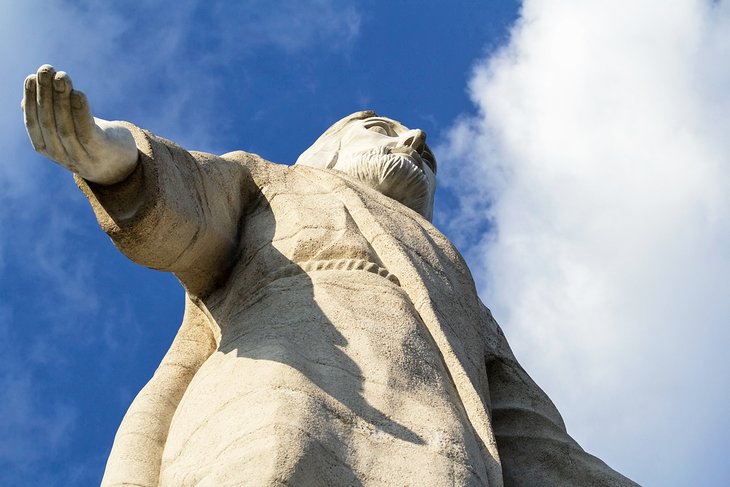
For a dose of Honduras culture and a journey through the country's history, visitors should stop by the excellent Museum of National Identity (Museo para la Identidad Nacional). This is one of the top things to do in Tegucigalpa, the country's capital.
Occupying a beautiful National Heritage building known as Palacio de los Ministerios , the museum also displays an impressive collection of Honduran and international art. Historic exhibits unveil the country's fascinating past, from pre-Hispanic times to the present day.
A highlight here is the virtual tour of the Mayan Acropolis of Copan, which provides a great primer for those who haven't yet visited the attraction and a welcome recap for those who have. Parking is scarce in this central city location, but taxis will take visitors directly to the door.
Another top place to visit in Tegucigalpa is the Parque Naciones Unidas El Picacho . Drive or catch a taxi to the park, which lies about six kilometers outside the city, and hike the trails to one of the city's iconic landmarks: the 20-meter-high statue of El Christo del Picacho , which towers over the capital. Best of all, you can enjoy panoramic views over the city to the mountains beyond.
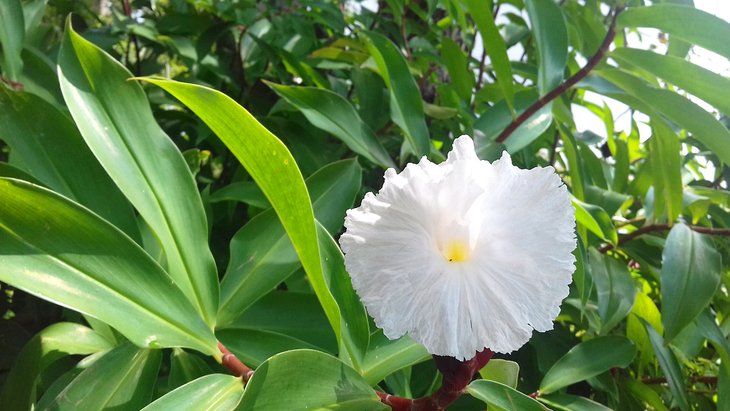
Located in Corinto, just west of San Pedro Sula in the Merendon Mountain Range, Cusuco National Park (Parque Nacional El Cusuco ) is famous for its enigmatic quetzal, one of the loveliest of all tropical birds. Sadly, habitat loss and unsustainable hunting for its beautiful long tail feather have pushed it to the brink of extinction.
The park's exceptional biodiversity also includes threatened species of frogs and salamander, jewel scarab beetles, Baird's tapir, and more than 260 species of birds. The reserve is also home to several species of wild cats, including the ocelot, margay, and jaguar.
The park's frogs are among its most important residents, playing a vital role in controlling the insect population. They also perform other important functions within the ecosystem which, in turn, influences the health of the residents of San Pedro Sula.
Hikers can enjoy some challenging trails here – the park's highest point rises to 2,200 meters above sea level. Local guides can provide access details and share information about the rich flora and fauna.
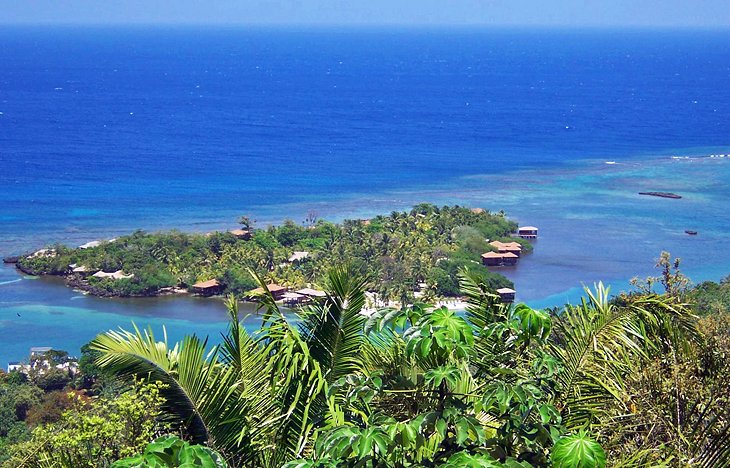
Beautiful Carambola Botanical Gardens & Trails offers a tranquil island nature experience. Trails wind through forests of fruit trees, palms, ferns, orchids, spices, and mahogany.
For breathtaking views, follow the mountain path to the top of the ridge, where a lookout peers out over the azure Caribbean, the adjacent barrier reef, and for those who time it well, dolphins leaping from the water at Anthony's Key Resort.
Along the way, keep an eye out for some of the tropical wildlife. Colorful birds dart throughout the foliage, and you might also spot Roatan Anoli lizards and entertaining parades of leafcutter ants.
Also in the gardens, Iguana Wall is a sheer section of cliff that offers a breeding area for iguanas and parrots.
Official site: http://www.carambolagardens.com/
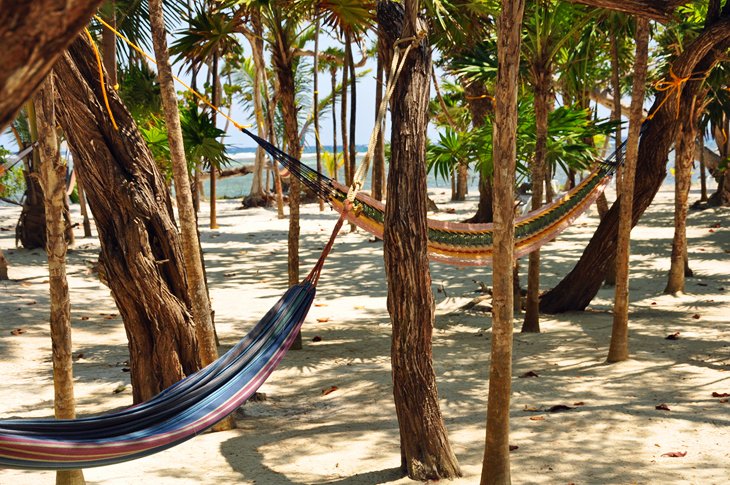
A popular day trip from Roatán , Little French Key is an eco-friendly tropical paradise off the island's south shore. Anyone seeking a tranquil tropical experience in manicured surrounds will enjoy it here. Imagine hammocks slung between coconut palms, sparkling clear waters with fantastic snorkeling, and a pretty white-sand beach with kayaks and chaises loungues.
After a few hours of beach fun, you can dine on fresh seafood at the restaurant or head to the wildlife sanctuary for close-up animal encounters. Sanctuary residents include rescue animals such as monkeys, deer, and toucans.
Feel like some more pampering to go with your beach basking? Sign up for a massage, manicure, or pedicure while you're here.
Official site: http://www.littlefrenchkey.com/
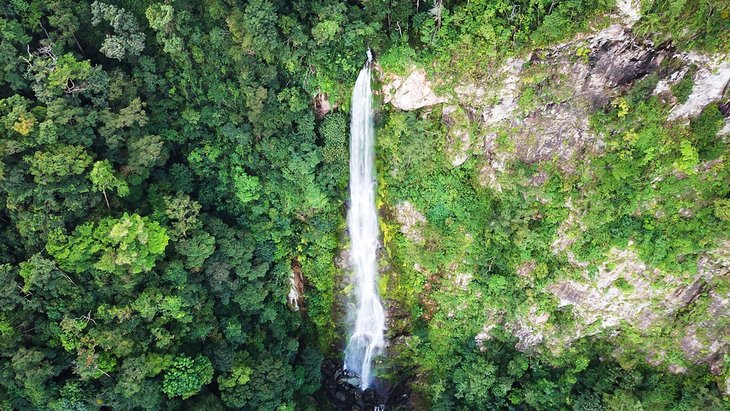
Pico Bonito National Park is a nature lover's paradise and one of the most popular hiking areas in Honduras . Located near the northern coastal city of La Ceiba, the 2,480-meter summit of Pico Bonito is a landmark visible from the Bay Islands.
In addition to the park's lush green rainforests and diverse wildlife, the park is full of dramatic waterfalls , some of which can be viewed from the road.
The park offers a variety of hiking trails, including the moderate one-hour La Roca loop that offers thrilling views from a swing bridge that crosses the Cangrejal River . There are also longer, more challenging trails that visit waterfalls and swimming holes, as well as scenic vistas.
Most of the trailheads are located at the park's visitor center, located only a few kilometers from La Ceiba.

More on Honduras
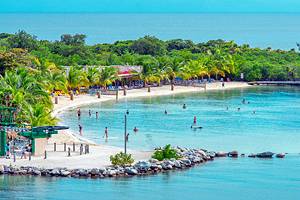
You are using an outdated browser. Upgrade your browser today or install Google Chrome Frame to better experience this site.
Honduras Traveler View
Travel health notices, vaccines and medicines, non-vaccine-preventable diseases, stay healthy and safe.
- Packing List
After Your Trip
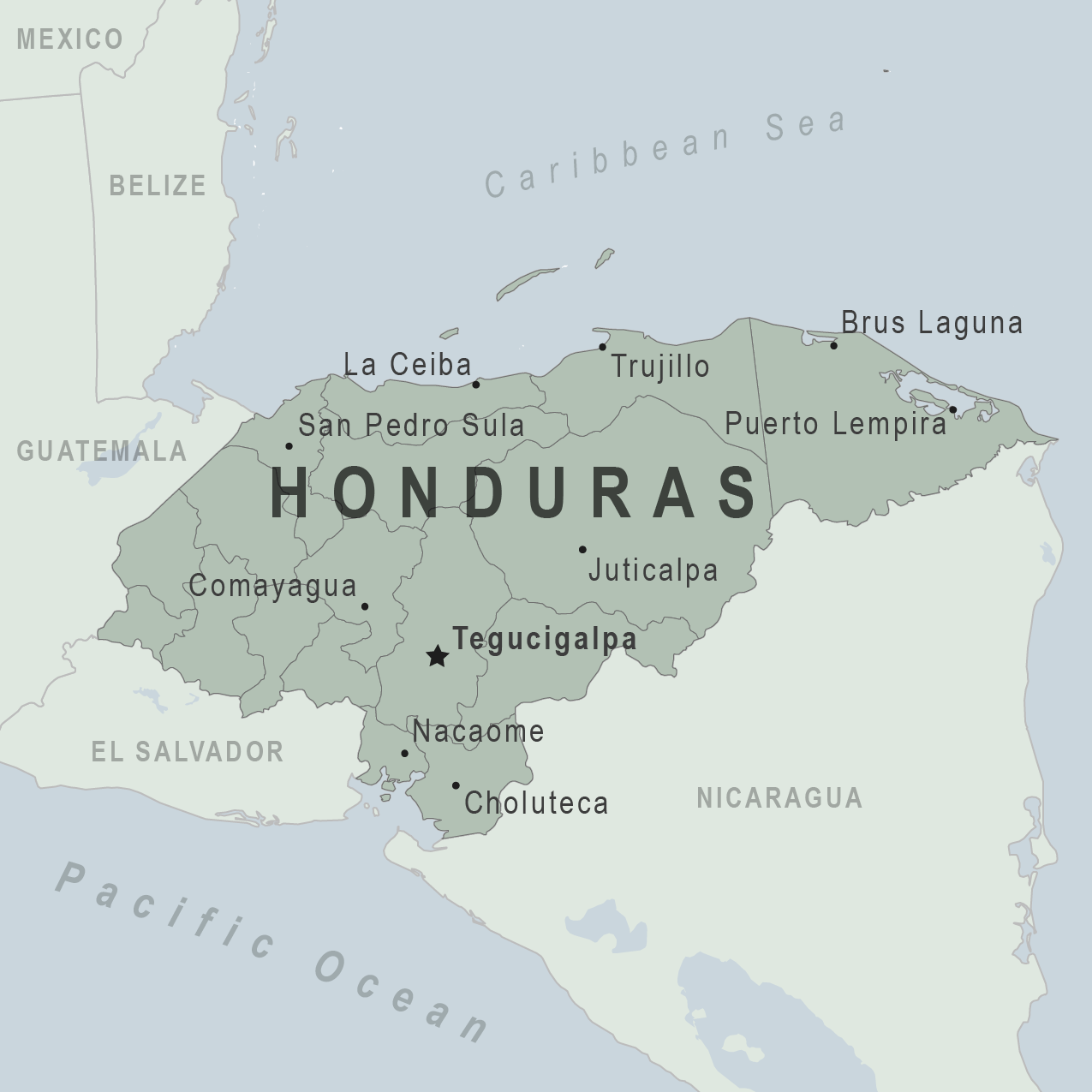
Be aware of current health issues in Honduras. Learn how to protect yourself.
Level 1 Practice Usual Precautions
- Dengue in the Americas May 16, 2024 Dengue is a risk in many parts of Central and South America, Mexico, and the Caribbean. Some countries are reporting increased numbers of cases of the disease. Travelers to the Americas can protect themselves by preventing mosquito bites. Destination List: Argentina, Brazil, Colombia, Costa Rica, Curaçao, Ecuador, including the Galápagos Islands, French Guiana (France), Guadeloupe, Guatemala, Guyana, Honduras, Martinique (France), Mexico, Nicaragua, Panama, Paraguay, Peru, Uruguay
⇧ Top
Check the vaccines and medicines list and visit your doctor at least a month before your trip to get vaccines or medicines you may need. If you or your doctor need help finding a location that provides certain vaccines or medicines, visit the Find a Clinic page.
Routine vaccines
Recommendations.
Make sure you are up-to-date on all routine vaccines before every trip. Some of these vaccines include
- Chickenpox (Varicella)
- Diphtheria-Tetanus-Pertussis
- Flu (influenza)
- Measles-Mumps-Rubella (MMR)
Immunization schedules
All eligible travelers should be up to date with their COVID-19 vaccines. Please see Your COVID-19 Vaccination for more information.
COVID-19 vaccine
Hepatitis A
Recommended for unvaccinated travelers one year old or older going to Honduras.
Infants 6 to 11 months old should also be vaccinated against Hepatitis A. The dose does not count toward the routine 2-dose series.
Travelers allergic to a vaccine component or who are younger than 6 months should receive a single dose of immune globulin, which provides effective protection for up to 2 months depending on dosage given.
Unvaccinated travelers who are over 40 years old, immunocompromised, or have chronic medical conditions planning to depart to a risk area in less than 2 weeks should get the initial dose of vaccine and at the same appointment receive immune globulin.
Hepatitis A - CDC Yellow Book
Dosing info - Hep A
Hepatitis B
Recommended for unvaccinated travelers younger than 60 years old traveling to Honduras. Unvaccinated travelers 60 years and older may get vaccinated before traveling to Honduras.
Hepatitis B - CDC Yellow Book
Dosing info - Hep B
CDC recommends that travelers going to certain areas of Honduras take prescription medicine to prevent malaria. Depending on the medicine you take, you will need to start taking this medicine multiple days before your trip, as well as during and after your trip. Talk to your doctor about which malaria medication you should take.
Find country-specific information about malaria.
Malaria - CDC Yellow Book
Considerations when choosing a drug for malaria prophylaxis (CDC Yellow Book)
Malaria information for Honduras.
Cases of measles are on the rise worldwide. Travelers are at risk of measles if they have not been fully vaccinated at least two weeks prior to departure, or have not had measles in the past, and travel internationally to areas where measles is spreading.
All international travelers should be fully vaccinated against measles with the measles-mumps-rubella (MMR) vaccine, including an early dose for infants 6–11 months, according to CDC’s measles vaccination recommendations for international travel .
Measles (Rubeola) - CDC Yellow Book
Dogs infected with rabies are sometimes found in Honduras.
Rabies is also present in bats.
If rabies exposures occur while in Honduras, rabies vaccines may only be available in larger suburban/urban medical facilities.
Rabies pre-exposure vaccination considerations include whether travelers 1) will be performing occupational or recreational activities that increase risk for exposure to potentially rabid animals and 2) might have difficulty getting prompt access to safe post-exposure prophylaxis.
Please consult with a healthcare provider to determine whether you should receive pre-exposure vaccination before travel.
For more information, see country rabies status assessments .
Rabies - CDC Yellow Book
Recommended for most travelers, especially those staying with friends or relatives or visiting smaller cities or rural areas.
Typhoid - CDC Yellow Book
Dosing info - Typhoid
Yellow Fever
Required for travelers 1-60 years old arriving from countries with risk for YF virus transmission; this includes >12-hour airport transits or layovers in countries with risk for YF virus transmission. 1
Yellow Fever - CDC Yellow Book
Avoid contaminated water
Leptospirosis
How most people get sick (most common modes of transmission)
- Touching urine or other body fluids from an animal infected with leptospirosis
- Swimming or wading in urine-contaminated fresh water, or contact with urine-contaminated mud
- Drinking water or eating food contaminated with animal urine
- Avoid contaminated water and soil
Clinical Guidance
Avoid bug bites, chagas disease (american trypanosomiasis).
- Accidentally rub feces (poop) of the triatomine bug into the bug bite, other breaks in the skin, your eyes, or mouth
- From pregnant woman to her baby, contaminated blood products (transfusions), or contaminated food or drink.
- Avoid Bug Bites
Chagas disease
- Mosquito bite
Leishmaniasis
- Sand fly bite
- An infected pregnant woman can spread it to her unborn baby
Airborne & droplet
- Breathing in air or accidentally eating food contaminated with the urine, droppings, or saliva of infected rodents
- Bite from an infected rodent
- Less commonly, being around someone sick with hantavirus (only occurs with Andes virus)
- Avoid rodents and areas where they live
- Avoid sick people
Tuberculosis (TB)
- Breathe in TB bacteria that is in the air from an infected and contagious person coughing, speaking, or singing.
Learn actions you can take to stay healthy and safe on your trip. Vaccines cannot protect you from many diseases in Honduras, so your behaviors are important.
Eat and drink safely
Food and water standards around the world vary based on the destination. Standards may also differ within a country and risk may change depending on activity type (e.g., hiking versus business trip). You can learn more about safe food and drink choices when traveling by accessing the resources below.
- Choose Safe Food and Drinks When Traveling
- Water Treatment Options When Hiking, Camping or Traveling
- Global Water, Sanitation and Hygiene | Healthy Water
- Avoid Contaminated Water During Travel
You can also visit the Department of State Country Information Pages for additional information about food and water safety.
Prevent bug bites
Bugs (like mosquitoes, ticks, and fleas) can spread a number of diseases in Honduras. Many of these diseases cannot be prevented with a vaccine or medicine. You can reduce your risk by taking steps to prevent bug bites.
What can I do to prevent bug bites?
- Cover exposed skin by wearing long-sleeved shirts, long pants, and hats.
- Use an appropriate insect repellent (see below).
- Use permethrin-treated clothing and gear (such as boots, pants, socks, and tents). Do not use permethrin directly on skin.
- Stay and sleep in air-conditioned or screened rooms.
- Use a bed net if the area where you are sleeping is exposed to the outdoors.
What type of insect repellent should I use?
- FOR PROTECTION AGAINST TICKS AND MOSQUITOES: Use a repellent that contains 20% or more DEET for protection that lasts up to several hours.
- Picaridin (also known as KBR 3023, Bayrepel, and icaridin)
- Oil of lemon eucalyptus (OLE) or para-menthane-diol (PMD)
- 2-undecanone
- Always use insect repellent as directed.
What should I do if I am bitten by bugs?
- Avoid scratching bug bites, and apply hydrocortisone cream or calamine lotion to reduce the itching.
- Check your entire body for ticks after outdoor activity. Be sure to remove ticks properly.
What can I do to avoid bed bugs?
Although bed bugs do not carry disease, they are an annoyance. See our information page about avoiding bug bites for some easy tips to avoid them. For more information on bed bugs, see Bed Bugs .
For more detailed information on avoiding bug bites, see Avoid Bug Bites .
Stay safe outdoors
If your travel plans in Honduras include outdoor activities, take these steps to stay safe and healthy during your trip.
- Stay alert to changing weather conditions and adjust your plans if conditions become unsafe.
- Prepare for activities by wearing the right clothes and packing protective items, such as bug spray, sunscreen, and a basic first aid kit.
- Consider learning basic first aid and CPR before travel. Bring a travel health kit with items appropriate for your activities.
- If you are outside for many hours in heat, eat salty snacks and drink water to stay hydrated and replace salt lost through sweating.
- Protect yourself from UV radiation : use sunscreen with an SPF of at least 15, wear protective clothing, and seek shade during the hottest time of day (10 a.m.–4 p.m.).
- Be especially careful during summer months and at high elevation. Because sunlight reflects off snow, sand, and water, sun exposure may be increased during activities like skiing, swimming, and sailing.
- Very cold temperatures can be dangerous. Dress in layers and cover heads, hands, and feet properly if you are visiting a cold location.
Stay safe around water
- Swim only in designated swimming areas. Obey lifeguards and warning flags on beaches.
- Practice safe boating—follow all boating safety laws, do not drink alcohol if driving a boat, and always wear a life jacket.
- Do not dive into shallow water.
- Do not swim in freshwater in developing areas or where sanitation is poor.
- Avoid swallowing water when swimming. Untreated water can carry germs that make you sick.
- To prevent infections, wear shoes on beaches where there may be animal waste.
Leptospirosis, a bacterial infection that can be spread in fresh water, is found in Honduras. Avoid swimming in fresh, unchlorinated water, such as lakes, ponds, or rivers.
Keep away from animals
Most animals avoid people, but they may attack if they feel threatened, are protecting their young or territory, or if they are injured or ill. Animal bites and scratches can lead to serious diseases such as rabies.
Follow these tips to protect yourself:
- Do not touch or feed any animals you do not know.
- Do not allow animals to lick open wounds, and do not get animal saliva in your eyes or mouth.
- Avoid rodents and their urine and feces.
- Traveling pets should be supervised closely and not allowed to come in contact with local animals.
- If you wake in a room with a bat, seek medical care immediately. Bat bites may be hard to see.
All animals can pose a threat, but be extra careful around dogs, bats, monkeys, sea animals such as jellyfish, and snakes. If you are bitten or scratched by an animal, immediately:
- Wash the wound with soap and clean water.
- Go to a doctor right away.
- Tell your doctor about your injury when you get back to the United States.
Consider buying medical evacuation insurance. Rabies is a deadly disease that must be treated quickly, and treatment may not be available in some countries.
Reduce your exposure to germs
Follow these tips to avoid getting sick or spreading illness to others while traveling:
- Wash your hands often, especially before eating.
- If soap and water aren’t available, clean hands with hand sanitizer (containing at least 60% alcohol).
- Don’t touch your eyes, nose, or mouth. If you need to touch your face, make sure your hands are clean.
- Cover your mouth and nose with a tissue or your sleeve (not your hands) when coughing or sneezing.
- Try to avoid contact with people who are sick.
- If you are sick, stay home or in your hotel room, unless you need medical care.
Avoid sharing body fluids
Diseases can be spread through body fluids, such as saliva, blood, vomit, and semen.
Protect yourself:
- Use latex condoms correctly.
- Do not inject drugs.
- Limit alcohol consumption. People take more risks when intoxicated.
- Do not share needles or any devices that can break the skin. That includes needles for tattoos, piercings, and acupuncture.
- If you receive medical or dental care, make sure the equipment is disinfected or sanitized.
Know how to get medical care while traveling
Plan for how you will get health care during your trip, should the need arise:
- Carry a list of local doctors and hospitals at your destination.
- Review your health insurance plan to determine what medical services it would cover during your trip. Consider purchasing travel health and medical evacuation insurance.
- Carry a card that identifies, in the local language, your blood type, chronic conditions or serious allergies, and the generic names of any medications you take.
- Some prescription drugs may be illegal in other countries. Call Honduras’s embassy to verify that all of your prescription(s) are legal to bring with you.
- Bring all the medicines (including over-the-counter medicines) you think you might need during your trip, including extra in case of travel delays. Ask your doctor to help you get prescriptions filled early if you need to.
Many foreign hospitals and clinics are accredited by the Joint Commission International. A list of accredited facilities is available at their website ( www.jointcommissioninternational.org ).
In some countries, medicine (prescription and over-the-counter) may be substandard or counterfeit. Bring the medicines you will need from the United States to avoid having to buy them at your destination.
Malaria is a risk in Honduras. Fill your malaria prescription before you leave and take enough with you for the entire length of your trip. Follow your doctor’s instructions for taking the pills; some need to be started before you leave.
Select safe transportation
Motor vehicle crashes are the #1 killer of healthy US citizens in foreign countries.
In many places cars, buses, large trucks, rickshaws, bikes, people on foot, and even animals share the same lanes of traffic, increasing the risk for crashes.
Be smart when you are traveling on foot.
- Use sidewalks and marked crosswalks.
- Pay attention to the traffic around you, especially in crowded areas.
- Remember, people on foot do not always have the right of way in other countries.
Riding/Driving
Choose a safe vehicle.
- Choose official taxis or public transportation, such as trains and buses.
- Ride only in cars that have seatbelts.
- Avoid overcrowded, overloaded, top-heavy buses and minivans.
- Avoid riding on motorcycles or motorbikes, especially motorbike taxis. (Many crashes are caused by inexperienced motorbike drivers.)
- Choose newer vehicles—they may have more safety features, such as airbags, and be more reliable.
- Choose larger vehicles, which may provide more protection in crashes.
Think about the driver.
- Do not drive after drinking alcohol or ride with someone who has been drinking.
- Consider hiring a licensed, trained driver familiar with the area.
- Arrange payment before departing.
Follow basic safety tips.
- Wear a seatbelt at all times.
- Sit in the back seat of cars and taxis.
- When on motorbikes or bicycles, always wear a helmet. (Bring a helmet from home, if needed.)
- Avoid driving at night; street lighting in certain parts of Honduras may be poor.
- Do not use a cell phone or text while driving (illegal in many countries).
- Travel during daylight hours only, especially in rural areas.
- If you choose to drive a vehicle in Honduras, learn the local traffic laws and have the proper paperwork.
- Get any driving permits and insurance you may need. Get an International Driving Permit (IDP). Carry the IDP and a US-issued driver's license at all times.
- Check with your auto insurance policy's international coverage, and get more coverage if needed. Make sure you have liability insurance.
- Avoid using local, unscheduled aircraft.
- If possible, fly on larger planes (more than 30 seats); larger airplanes are more likely to have regular safety inspections.
- Try to schedule flights during daylight hours and in good weather.
Medical Evacuation Insurance
If you are seriously injured, emergency care may not be available or may not meet US standards. Trauma care centers are uncommon outside urban areas. Having medical evacuation insurance can be helpful for these reasons.
Helpful Resources
Road Safety Overseas (Information from the US Department of State): Includes tips on driving in other countries, International Driving Permits, auto insurance, and other resources.
The Association for International Road Travel has country-specific Road Travel Reports available for most countries for a minimal fee.
For information traffic safety and road conditions in Honduras, see Travel and Transportation on US Department of State's country-specific information for Honduras .
Maintain personal security
Use the same common sense traveling overseas that you would at home, and always stay alert and aware of your surroundings.
Before you leave
- Research your destination(s), including local laws, customs, and culture.
- Monitor travel advisories and alerts and read travel tips from the US Department of State.
- Enroll in the Smart Traveler Enrollment Program (STEP) .
- Leave a copy of your itinerary, contact information, credit cards, and passport with someone at home.
- Pack as light as possible, and leave at home any item you could not replace.
While at your destination(s)
- Carry contact information for the nearest US embassy or consulate .
- Carry a photocopy of your passport and entry stamp; leave the actual passport securely in your hotel.
- Follow all local laws and social customs.
- Do not wear expensive clothing or jewelry.
- Always keep hotel doors locked, and store valuables in secure areas.
- If possible, choose hotel rooms between the 2nd and 6th floors.
Healthy Travel Packing List
Use the Healthy Travel Packing List for Honduras for a list of health-related items to consider packing for your trip. Talk to your doctor about which items are most important for you.
Why does CDC recommend packing these health-related items?
It’s best to be prepared to prevent and treat common illnesses and injuries. Some supplies and medicines may be difficult to find at your destination, may have different names, or may have different ingredients than what you normally use.
If you are not feeling well after your trip, you may need to see a doctor. If you need help finding a travel medicine specialist, see Find a Clinic . Be sure to tell your doctor about your travel, including where you went and what you did on your trip. Also tell your doctor if you were bitten or scratched by an animal while traveling.
If your doctor prescribed antimalarial medicine for your trip, keep taking the rest of your pills after you return home. If you stop taking your medicine too soon, you could still get sick.
Malaria is always a serious disease and may be a deadly illness. If you become ill with a fever either while traveling in a malaria-risk area or after you return home (for up to 1 year), you should seek immediate medical attention and should tell the doctor about your travel history.
For more information on what to do if you are sick after your trip, see Getting Sick after Travel .
Map Disclaimer - The boundaries and names shown and the designations used on maps do not imply the expression of any opinion whatsoever on the part of the Centers for Disease Control and Prevention concerning the legal status of any country, territory, city or area or of its authorities, or concerning the delimitation of its frontiers or boundaries. Approximate border lines for which there may not yet be full agreement are generally marked.
Other Destinations
If you need help finding travel information:
Message & data rates may apply. CDC Privacy Policy
File Formats Help:
- Adobe PDF file
- Microsoft PowerPoint file
- Microsoft Word file
- Microsoft Excel file
- Audio/Video file
- Apple Quicktime file
- RealPlayer file
- Zip Archive file
Exit Notification / Disclaimer Policy
- The Centers for Disease Control and Prevention (CDC) cannot attest to the accuracy of a non-federal website.
- Linking to a non-federal website does not constitute an endorsement by CDC or any of its employees of the sponsors or the information and products presented on the website.
- You will be subject to the destination website's privacy policy when you follow the link.
- CDC is not responsible for Section 508 compliance (accessibility) on other federal or private website.
![4 T UMAX Power Look 2000 V2.0 [6] top ten places in Honduras](https://www.lavilladesoledad.com/wp-content/uploads/2015/01/Cayos-Chachahuates2-1-1024x804-1024x585.jpg)
10 Reasons To Visit Honduras
Best of Honduras , tourism in Honduras
There are many different reasons why you should visit Honduras. Here is a list of my top 10 reasons to visit Honduras.
1.- Honduras has a warm, temperate climate; it always does… You will never get snowed out or have subzero temperatures. As a matter of fact, it seldom gets below 60 degrees in all of the country!

2.- Honduras has over 100 protected natural areas. Almost 40% of its territory is legally protected. This is equivalent to more than 50% of the territory of Costa Rica. Honduras has the largest territorial surface of protected areas in all of Central America. The best preserved tropical rainforest of Central America lies in the Rio Platano Biosphere Reserve, on the Northeastern Caribbean coast of Honduras. It is one of the UNESCO World Heritage sites in Honduras .
3.- Honduras has four international airports that are regularly serviced by international airlines with non stop service from North America. It is easy to get to ( less than 5 hours flying time from the northeast of the USA and around 2 hours from the Gulf Coast of the United States) . You can fly non stop to Tegucigalpa, San Pedro Sula, Roatan and La Ceiba!
4.- Honduras offers the best of the Central America and the Caribbean in one easy trip. Honduras is the only Central American country whose development in on the Caribbean. In addition to this, it is the only one with infrastructure for tourism developed on the Caribbean, making it truly unique. Traveling between mainland Honduras and the Bay Islands is a piece of cake, and you even have the option to do so by sea using the local ferry or by air using the local airlines!

5.- Honduras is home to the unique Garifuna Culture, an unlikely ethnic group that was created with the mix of native Africans with native Carib Indians. The result is a culture so unique that it has been declared intangible World Heritage by UNESCO. Garifuna people are friendly people who live on the coast, and there are many different Garifuna Villages along the Caribbean Coast of Honduras. 95% of the Garifunas live in Honduras, so this is an experience that you cannot find elsewhere in Central America or the Caribbean!
6.- Despite the bad reputation that the international press have given Honduras as a dangerous destination, the fact is that tourist are not only welcome, but actually looked after by the local population. There are fewer crime related incidents with tourists in Honduras that there are in most of the other Central American countries. This bad reputation does have a silver lining for you as a tourist visiting Honduras: You will not find Honduras to be a tourist trap! Currently, all of the destinations in Honduras are actually with low occupancies, and you will find that almost wherever you go, you will have the chance to enjoy the sites and attractions without being overrun by tourists! Hurry and enjoy this before the rest of the World realizes how much they are missing out on!
7.- Hondurans are friendly to foreigners. They always have been. Furthermore, Honduras has traditionally been the most faithful Central American ally to the USA. Hondurans look up to the USA as a big brother to their country and are thankful for the international aid that they have received over the years.
8.- Honduras is incredibly diverse despite the fact that is a small country: The tropical Central American rainforests, the lovely Spanish Colonial cities, the magnificent archaeological site of Copan Ruinas, the best Caribbean Beaches in Central America and World class barrier reefs in the Bay Islands are all to be found in Honduras. Best of all, they are all within close reach of each other, easy to get from one to the other. The Mayan Archaeological site of Copan is the most studied and understood of all Mayan city states, and offers the possibility of touring the site with scientific information regarding this pre Colombian city, home to the most advanced native American civilization that we know of! Copan, by the way, is also a World Heritage Site declared by UNESCO!

9.- If you are looking for pristine Caribbean beaches, there is no other place in Central America that is better suited for you to visit than Honduras. The Bay Islands of Honduras offer an insight to both, pristine beaches and islands, as well as to World Class resorts. There are several islands with different atmospheres and degrees of development, and you will surely find the one that is perfectly suited for you!
10.- Honduras has the highest percentage of English speaking population in Central America. Yes, there is a higher percentage of English speaking Hondurans than there is of Costa Ricans. (And the population of Honduras is almost three times that of Costa Rica) This means that chances are that you will always find someone who speaks enough English to be able to communicate with and settle your needs.

Please note that I have written about the 10 reasons to visit Honduras, and not about the destinations that you should not miss when you come here. I invite you to read my post about the top ten places in Honduras and the top five tourist sites in Atlantida for ideas about where to visit while in Honduras.
Related Posts

COVID-19 , tourism in Honduras
Staff at La Villa de Soledad are Vaccinated Against COVID 19

blog , tourism in Honduras
Reasons to Visit the Cangrejal River in La Ceiba

Best of Honduras
Getting to The Hog Cays AKA Cayos Cochinos

Roatan Honduras Travel Guide : Top 5 Reasons to Visit
Found off the north coast of Honduras in the beautiful surroundings of the Caribbean Sea, Roatan is the tropical island of dreams.
Surrounded by one of the world’s most bio-diverse coral reefs, the island has long been a favorite amongst divers and snorkelers looking to explore the unbelievably large array of marine life that live off the coast.
Away from the stunning beaches and picturesque coastline, Roatan has a beautiful, green and mountainous interior that is becoming an eco-tourism hotspot, with adventurous opportunities awaiting those looking to explore.
From high-end hotels to basic, beachside accommodation, a trip to Roatan can be for everyone. Get ready to explore the water, the jungle and the intriguing, multicultural history of this Honduran Island. To help you plan your trip, here’s our ultimate guide to visiting Roatan Honduras.
5 Best Things to do in Roatan Honduras
Table of Contents
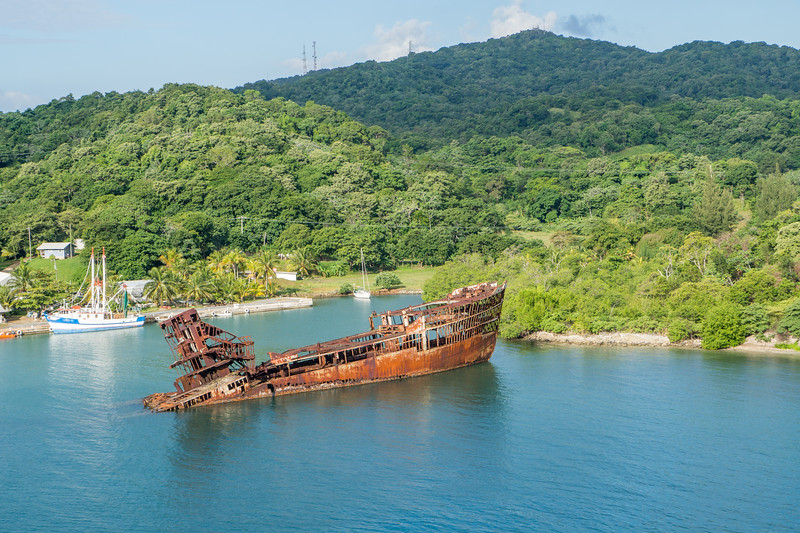
From beautiful reefs and endless diving and snorkeling opportunities to relaxed beach days, sunset cocktails or even an intense jungle, zip-lining experience. There’s a lot to do in Roatan Honduras, and here is the best of it all.

1. Snorkeling and Diving
The snorkeling and diving opportunities are perhaps the main reason to visit Roatan. Being surrounded by the second largest barrier reef in the world means that underwater life is some of the most diverse in the world.
There are several excellent companies that can arrange trips out to the reef and that offer diving courses too. Most are located on the west side of the island, to cater to the tourists that stay here.
There are hundreds of potential dives sites, because of the sheer size of the reef!
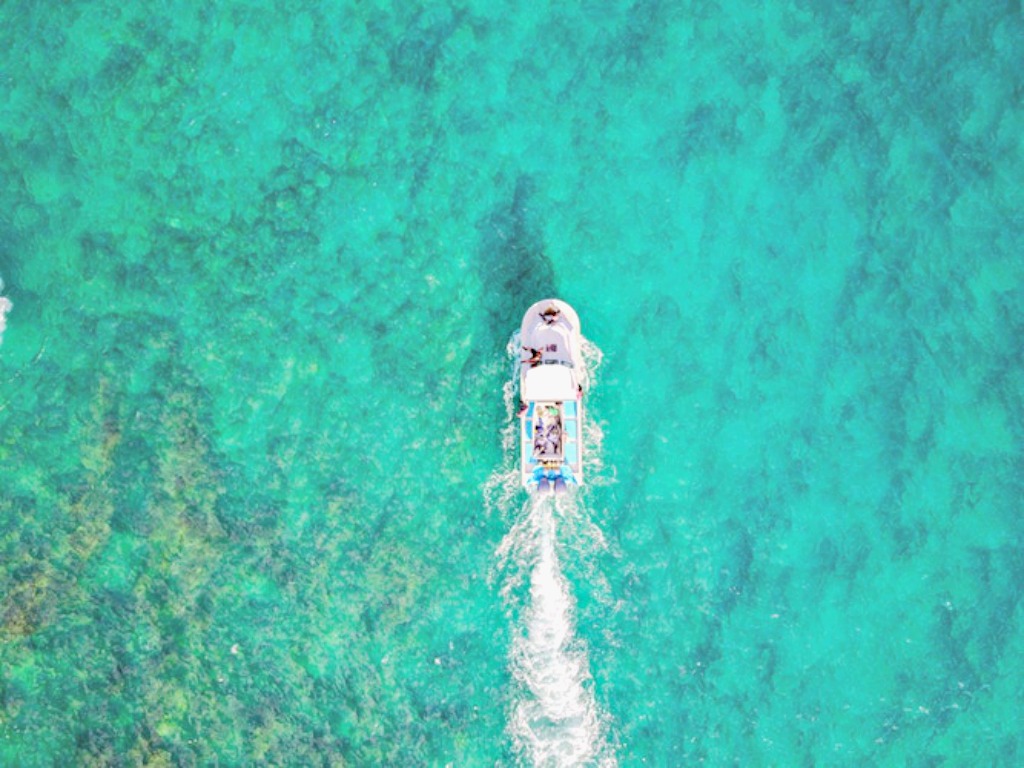
2. Glass Bottom Boat Tours
If diving or snorkeling isn’t for you, but you’d still love to experience the majesty of the reef, then the best option is to join a glass-bottom boat tour.
These travel out to the best spots in the surrounding area and allow you to really see the best marine life without having to ever get into the water.
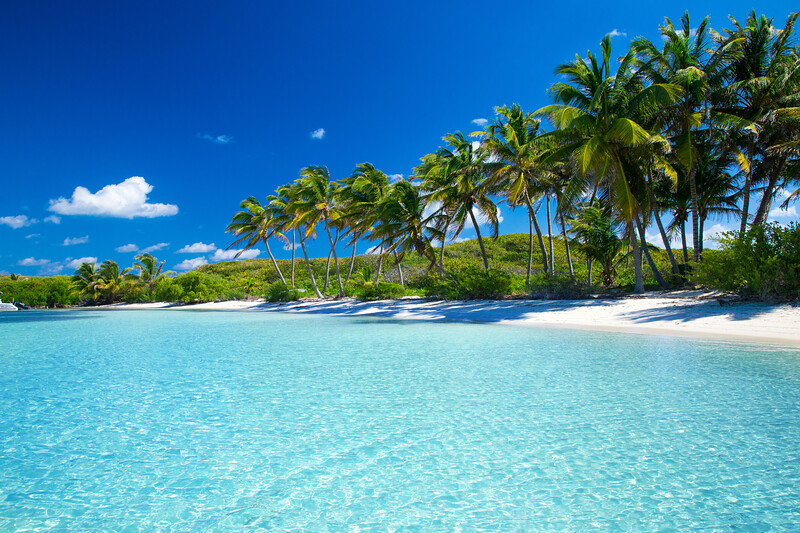
3. Hit Up the Beaches in Roatan
Roatan really is a tropical paradise and some of the Caribbean’s best beaches can be found around the island. The most popular ones are found in the west.
Visit West Bay Beach to enjoy the whitest sands and most tropical outlook on Roatan. If you are after a bit more seclusion though, travel to the east end, and visit Camp Bay Beach.
It’s much more isolated and remote, but the effort involved getting there will see that you might be the only person on the beach.
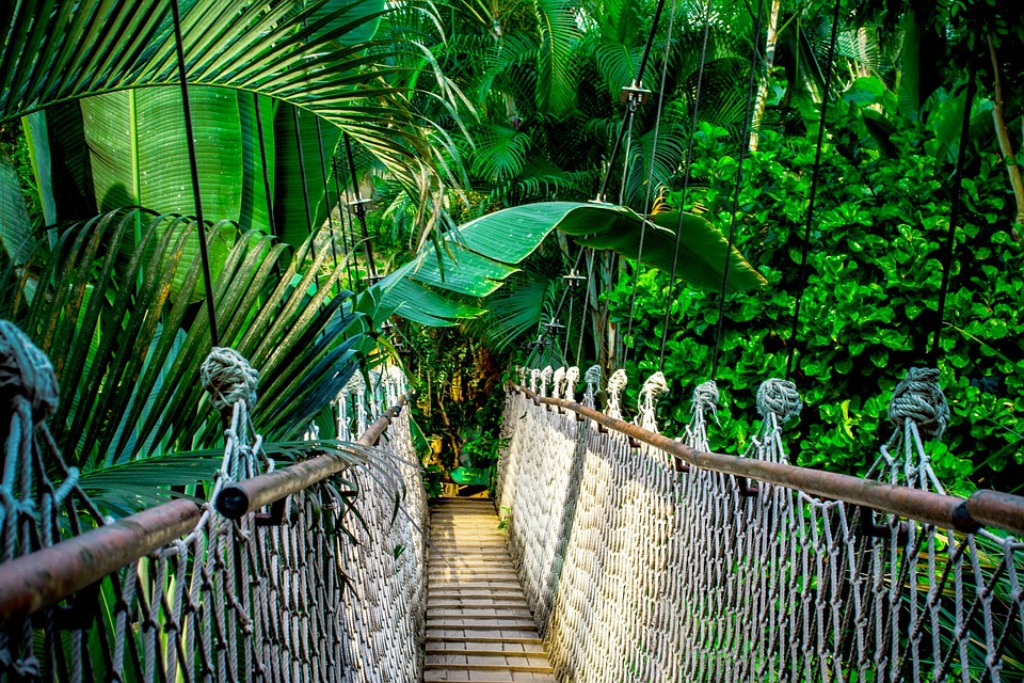

4. Try a Jungle Canopy Tour
Beaches aside, Roatan has a large area of dense jungle to be explored in the island’s interior. There are several eco-adventure tours that take visitors through the canopy of the jungle , exploring the wildlife and flora of the island while experiencing the thrill of zip-lining between trees.

5. Bars and Nightlife
Roatan has a legendary nightlife scene in Honduras. Because of the number of tourists visiting, in high season, the parties can go on long into the night.
There are many great beach bars, most of them to be found in the popular West End, as well as more relaxed restaurants on the beach fronts, where it’s easy to relax the day away and watch the sunset with a cocktail in hand.
Some great places to check out on your visit to Roatan, Honduras are: Booty Bar & Caribbean Restaurant, The Reef Rider, and Larry and Luey’s Fly High Bar
Roatan Honduras Travel Tips

Where is Roatan, Honduras?
Roatan Honduras is a just a small, narrow island, being just under 40 miles long and only 5 miles wide at its longest stretch.
It’s small, but it’s perfectly situated in the middle of the beautiful Meso-American Barrier Reef, the second-largest barrier reef in the world – after the Great Barrier Reef in Australia of course.
The island is found 40 miles off the northern coastline of Honduras, and it is the largest of the seven Bay Islands, and largest settlement in the region.

How to Travel to Roatan, Honduras
Being a popular diving and holiday destination, Roatan is well connected and relatively easy to travel to. Several major airlines offer direct flights from the US, from transport hubs such as Miami and New York, however, these tend to be only seasonal in keeping with demand.
Roatan is well connected to the large Honduran city, San Pedro Sula. There are daily flights from the city to the island, and San Pedro Sula is itself well connected internationally, especially to the US and surrounding central and southern American nations.
The more adventurous traveler can even take a ferry from the Honduran mainland to Roatan. The island is just a short ride away from the coastal city of La Ceiba and a fast, modern catamaran makes the journey twice a day, in the morning and again in the afternoon, connecting Roatan to Honduras in 70 minutes.
Many cruise ships also visit the island during the Caribbean cruising season, and this can be a great way to see the highlights of Roatan on a whistle-stop tour. It can get busy though when the ships are docked.
Getting around Roatan is easy, considering the island’s small size. The airport and ferry terminal are located in Coxen’s Hole, which serves as the main transport hub of the island, and the best spot to find amenities and shops.
From here, buses run the length of the island at regular intervals. There are many taxi drivers on the island looking for fares too, just ensure you barter before accepting a lift.
Scooters can be rented daily and are an efficient way to travel around Roatan, but can be potentially dangerous for those unused to riding them or unused to the roads.
Make sure to check out Fodor’s Caribbean Cruise Ports of Call if arriving by cruise ship.
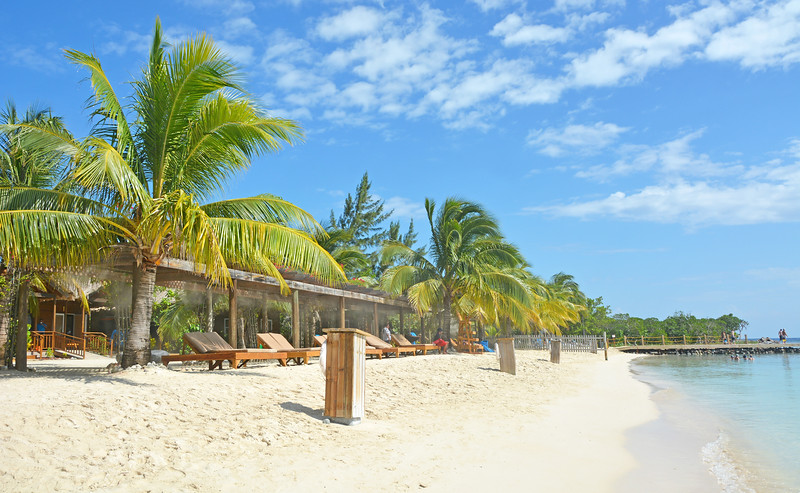
Best Time to Visit Roatan, Honduras
Roatan experiences very consistent temperatures throughout the year, with hot, warm weather all year around. The tropical weather though means that the island does experience distinct wet and dry seasons.
The dry season runs from July to January while the wet season runs from February to June. The area does, however, experience the odd shower even in the supposed dry season, so be prepared for this.
The best time to visit is, of course, the dry season, especially if you are visiting Roatan to snorkel or dive. The water is clearest at the end of the dry season when the runoff from the rainy season has dissipated, and the surrounding coral looks at its best.
The dry season, of course, is also when the cruise ships tend to visit and prices may be significantly higher than in the offseason.

Where to Stay in Roatan Honduras
The vast majority of the accommodation in Roatan can be found located in the west of the island. Coxen Hole may be the transport hub, however, most tourists will choose to stay elsewhere, along the more scenic stretches of coastline.
West Bay and West End are not far from Coxen Hole and are favorites for those on holiday. There’s quite a range of standards and prices available across the island, from high-end luxury hotels like Xbalanque Resort to more modest hotels for the budget traveler like Reef House Resort , you will be sure to find accommodation for all travel styles and budgets.
Read reviews and check prices with our Hotel Search Engine , that gives you the best hotel deals found on the web. Our search engine pulls results from all of the major booking places, including Expedia, Hotels, Booking and more. All the options, all the deals, all in one place and just for you.
Language and Currency in Roatan

Roatan is part of Honduras, which is a majority Spanish speaking nation, however, due to its complicated colonial history, the primary language – unlike the rest of the mainland – is in fact English.
This is reflected in the place names and the names of the locals and you will find that English is the number one language to use.
US Dollars are widely accepted on the island, however, you will find that paying in US Dollars will cost a premium, so it’s best to change up your money on arrival in Coxen Hole at the many currency exchanges, for the best rates on the island. The local currency is the Honduran Lempira.
Is Roatan, Honduras Safe?

Mainland Honduras has an infamous reputation for violent, gang-related crime and many of the cities are not that safe for tourists to visit. Don’t let that put you off traveling to Roatan however, because the island is a very separate entity to the rest of the country.
The violent crime of the mainland is rarely found on the island and with the local economy reliant on tourism, they go out of their way to ensure visitors feel safe. Petty theft may occur, as it does anywhere in the world, but Roatan is a safe destination for a vacation.
Don’t leave home without: Lonely Planet Honduras & the Bay Islands (Travel Guide)
More on Central America:
- 9 UNREAL Things to do in Caye Caulker, Belize
- Uncover Paradise on this Dreamy Panama Cruise
- The Only Costa Rica Cruise You Should Ever Take
Did you like this story? Share it!
Travel planning resources, about lina stock.
Lina is an award-winning photographer and writer that has been exploring the world since 2001. She has traveled to 100 countries on all 7 continents. Member: SATW, NATJA, ATTA, ITWA
2 thoughts on “Roatan Honduras Travel Guide : Top 5 Reasons to Visit”
Roatan is my favorite spot in the western Caribbean! I must have visited 12-13 times in the last 8 years. People are friendly, English and US currency is used widely, and you get a lot more than the eastern Caribbean for your money.
I appreciate you helping me learn more about Roatan. I like how you said that the main language is English. My husband and I are thinking of going somewhere foreign that has beaches but has English speakers as well. We should look at Roatan.
Leave a Comment Cancel reply

- Meet the Team
- Work with Us
- Czech Republic
- Netherlands
- Switzerland
- Scandinavia
- Philippines
- South Korea
- New Zealand
- South Africa
- Budget Travel
- Work & Travel
- The Broke Backpacker Manifesto
- Travel Resources
- How to Travel on $10/day
Home » Central America » Honduras » Backpacking Guide
Backpacking Honduras Travel Guide (2024)
Do you want to go on an epic backpacking adventure in one of Central America’s least-visited countries? If you answered yes, well, I’m going to guide you through everything you need to know about backpacking Honduras.
Honduras is certainly not the first country people think of when planning a trip to Central America, which makes it a prime candidate for backpackers who love off the beaten path travel experiences.
All too often backpackers traveling on the Central America gringo trail skip over Honduras entirely, but I’ll tell you right now: Don’t make that mistake!
I loved my time spent backpacking Honduras. This country is full of exciting things to discover. To start with, Honduras has truly spectacular Mayan ruins at Copan, some of the best/cheapest scuba diving in the Northern Hemisphere in the Bay Islands, and a fascinating mix of different cultures, food, and traditions.
All of that said, one quick Google search of Honduras will reveal a cascade of negative news stories about the country. The fact is, if we all listened to the travel warnings issued by our governments, we would be missing out on some of the world’s most exciting backpacker destinations.
Despite what you may read in the news, Honduras is a relatively safe country for backpackers who know their stuff. Whilst it is true that Honduras has one of the highest murder rates in the world, much of the violence is drug and gang-related, taking place in specific areas of the cities. Violence against backpackers is very rare.
Honduras truly has heaps of incredible experiences to offer travelers and travel guide on backpacking Honduras aims to show you the way.
I’ll provide everything you need to know about backpacking Honduras, including travel tips, the best places to visit, the top things to do in Honduras, where to stay, safety advice, Honduras backpacking itineraries, travel costs, scuba diving, and much more…
Vamos amigos!
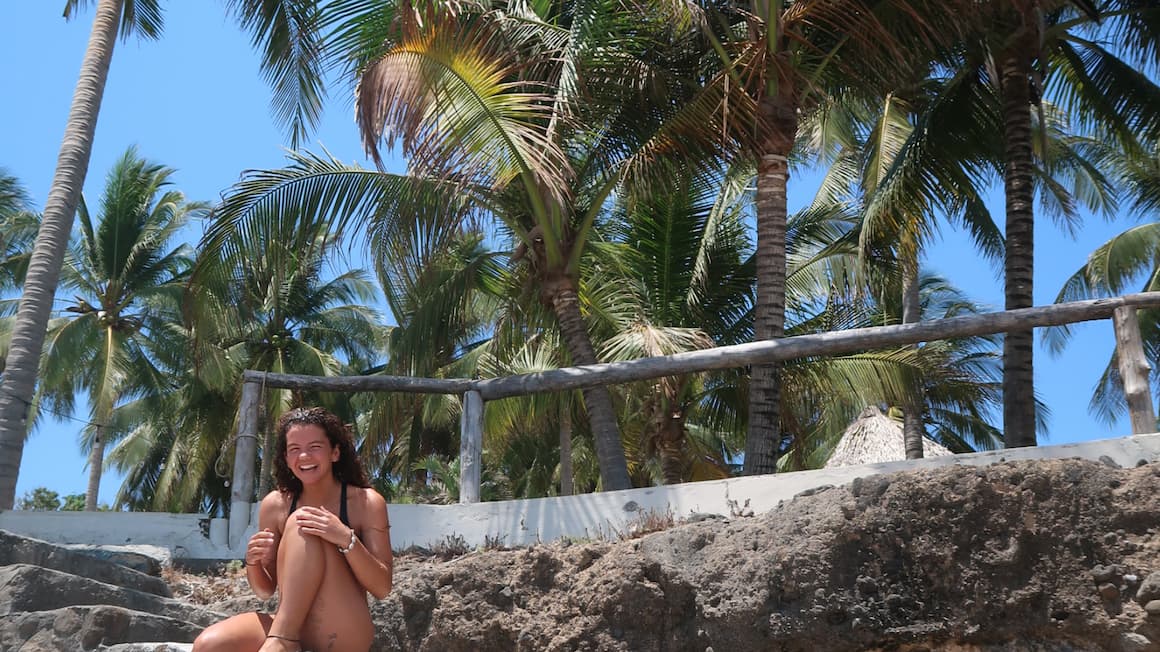
The Broke Backpacker is supported by you . Clicking through our links may earn us a small affiliate commission, and that's what allows us to keep producing free content 🙂 Learn more .
Why Go Backpacking in Honduras?
Where you choose to go backpacking in Honduras will depend on your interests. The country is diverse and if you are short on time, you will need to pick and choose the right places to visit that align with your interests.
Of the two major cities, San Pedro Sula and Tegucigalpa are not appetizing backpacker destinations. You might need to pass through one or both of these cities en route to somewhere else in Honduras, but as a destination, I would suggest spending your time in Honduras elsewhere.

A few days spent in Tegucigalpa might be appealing to backpackers, myself included, who want to appreciate the colonial architecture, markets, and urban chaos.
I spent the majority of my time in the Bay Islands . Utila is the main backpacker island, though the diving is arguably better off of the more expensive/touristy island of Roatan .
For hiking, outdoor pursuits, and mountain time, Honduras’ national parks have plenty to offer. Pico Bonito National Park is ground zero for all things outdoor adventure.
The most famous and significant Mayan ruins in Honduras are found at Copan near the Guatemala border.
In essence, Honduras has a lot going for it: gorgeous islands, raging rivers, and a cloud forest… It’s all here…
Best Travel Itineraries for Backpacking Honduras
Places to visit in honduras, top things to do in honduras, backpacker accommodation in honduras, honduras backpacking costs, best time to travel to honduras, what to pack for honduras, staying safe in honduras, how to get into honduras, how to get around honduras, working in honduras, what to eat in honduras, honduran culture, some unique experiences in honduras, final advice before visiting honduras.
So, let’s talk Honduras itineraries. Whether you have 2 weeks in Honduras or a few months to become a full-on scuba diving island bum, I have assembled several Honduras backpacking itineraries to help you make the most of your time in this cool Central American country.
These Honduras backpacking routes can be combined or tailored to suit your own interests and time frame.
7 Days in Honduras: Copan and Pico Bonito National Park
With seven days in Honduras, you can see many of mainland Honduras’ backpacker highlights. This itinerary assumes that you are traveling overland from Guatemala.
Since public transportation travel can be slow, I recommend under planning your Honduras schedule. A realistic itinerary will need to plan for slow transportation days.
This seven-day Honduras itinerary takes you through the famous Mayan ruins of Copan, San Pedro Sula, Lago de Yojoa, and Pico Bonito National Park.
Since Copan is the only major site of Mayan ruins in Honduras, there is a well-established tourist infrastructure in place to serve travelers visiting the site. As a whole, Honduras is NOT set up for budget travelers, which becomes obvious the minute you step foot in one of the big cities.
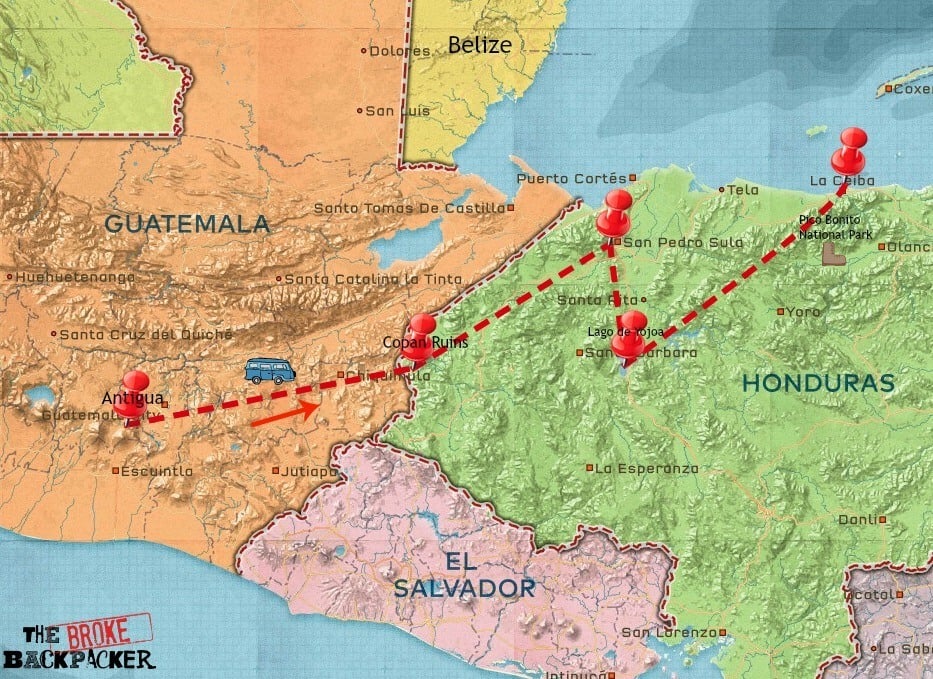
You can easily arrange for a shuttle or bus to transport you from the Guatemala side to Copan. For a cheaper option, you can use public transport to get close to Copan, though going with a direct shuttle saves you time and a boatload of hassle. More about getting to Copan later in the post.
Take the time to explore the Copan ruins thoroughly. Visit the villages and walking trails around Copan. After spending two days in the Copan area, you should be ready to move on.
Take a bus to San Pedro Sula en route to Lago de Yojoa , the biggest lake in Honduras. Be sure to start your journey to San Pedro Sula early as the chicken buses can take ages.
One can easily spend two days at Lago de Yojoa. The Pulhapanzak Falls are stunning! There are many things to do in and around the lake, though exploring the Santa Bárbara Mountain area was my favorite activity. Check out the boats for hire too if you want to get out onto the lake.
For the next several days, hit Pico Bonito National Park . The coastal town of La Ceiba is the best candidate in terms of picking a base close to the park.
2 Weeks in Honduras: National Parks and the Bay Islands
Two weeks in Honduras is a better timeframe for a more in-depth Honduras backpacking adventure. With an extra week, you can focus your time on getting some island time as well!
Where to start this backpacking route will depend on where you are entering Honduras.
If you are flying to San Pedro Sula , it makes sense in a sort of roundabout way for you to hit Copan and Pico Bonito National Park before heading off to the Bay Islands.
Likewise, if you plan on flying to the Bay Islands and back to San Pedro Sula, it doesn’t really matter when you plan to visit “mainland” sites.
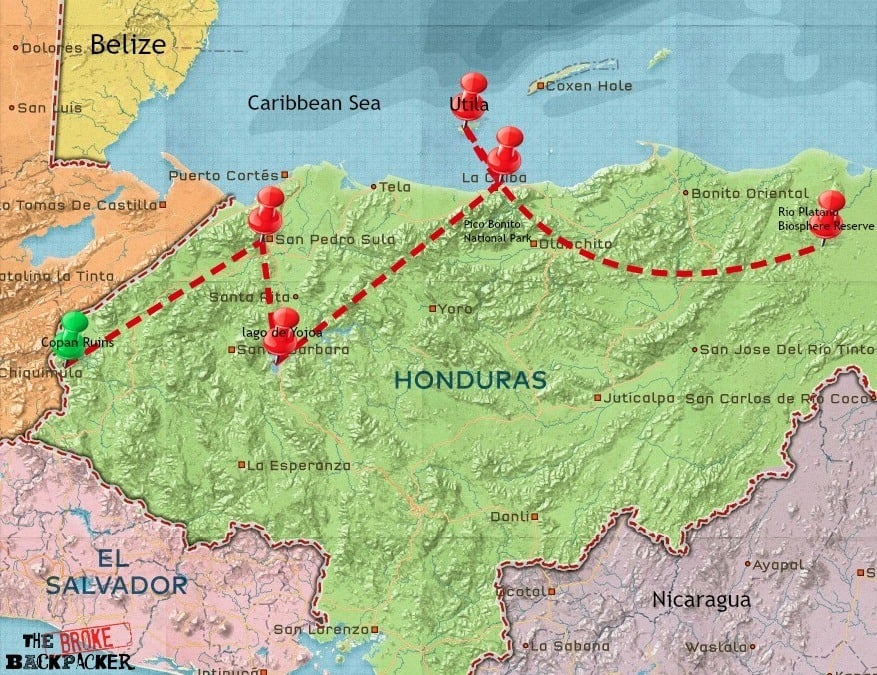
Let’s assume that you are traveling overland. I recommend following the same route as Itinerary #1 mentioned above to explore mainland Honduras.
After a week of exploring the country’s best mainland destinations, you will be well situated on the coast to catch a ferry to Utila . Before going to Utila though, be sure to explore the Rio Platano Biosphere Reserve .
The reserve is home to some small, though epic Mayan sites, and wildlife like pumas, jaguars, and even sloths!
Utila is the most backpacker-focused place in Honduras. You can easily spend a week or more here, hiking, swimming, and getting your PADI open water scuba diving certification… or just chilling the F out. Many people end up staying longer than planned.
If you have island fever, consider heading over to Roatan for a few days. The diving around Roatan is excellent and this island will have incredible beaches, something Utila lacks being situated on the reef. Like Utila, Roatan is very well set up for travelers in terms of infrastructure and budget options.
One Month in Honduras: The Bay Islands Scuba Bum Life
If you love the ocean and have a month or more to spend in Honduras just go directly to the Bay Islands and never look back.
There is a huge community of backpackers living on Utila doing just that. Many travelers travel to Utila to take a scuba diving course, and some backpackers simply stick around, getting more certifications and diving every day.
You can then hop between islands, visiting Roatan and Guanaja each for a short period before returning to Utila.
The advantage of having more time in Honduras is that you can take days to explore more of the national parks as well, once back on the mainland.
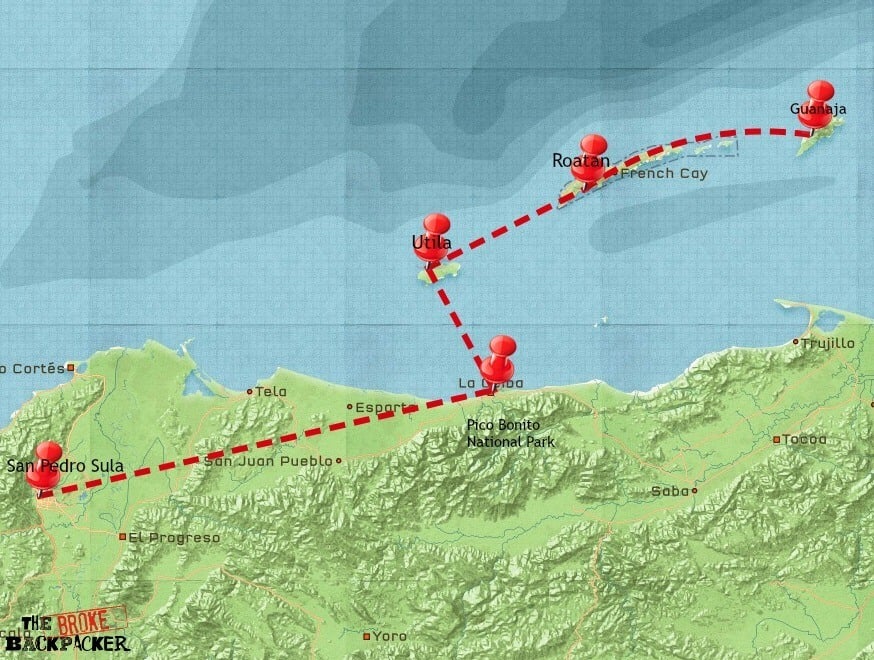
Of course with a month-long Honduras backpacking adventure, you could spend two weeks seeing the sites on the mainland before popping over to Utila, or just spend all of your time diving and chilling on the islands. It all depends on you.
My suggestion is that if you like diving (or want to learn how to dive) go to Utila and consider your options from there. This is one of the cheapest places in the world to dive or get certified, and the diving is incredible.
Link up with some other backpackers, rent a house, and spend a month partying, doing yoga, and scuba diving your ass off. That’s exactly what I did, and even now my Honduras/Bay Islands backpacking adventure remains was one of the most fun and rewarding periods of my backpacking career.
If eventually the island vibes prove to not be your thing or you need a break, you can always fall back on a mainland backpacking route.
Backpacking San Pedro Sula
I’ll be straight with you. San Pedro Sula is not a prime backpacker destination. With one of the highest murder rates of any place in the world (that is not a war zone), alarm bells should go off when talking about visiting San Pedro Sula.
However, there are several interesting things to do in San Pedro Sula. Start by exploring the Guamilito market . The market is one of San Pedro Sula’s largest and most popular markets.
Be sure to supercharge your haggle game. You will be at a severe disadvantage if you possess the unfortunate (for money matters in Honduras) combination of having a white face and zero Spanish speaking skills. Still give it a shot! The market is located between the 8a and 9a Avenida and 5a y 6a Calles N.O. Simply tell your taxi driver the name of the market; he will have heard of it.
The Museum of Anthropology and History of San Pedro Sula is another worthwhile spot to spend an afternoon or morning. The cost of admission is $3. The museum is free on the first Sunday of every month!
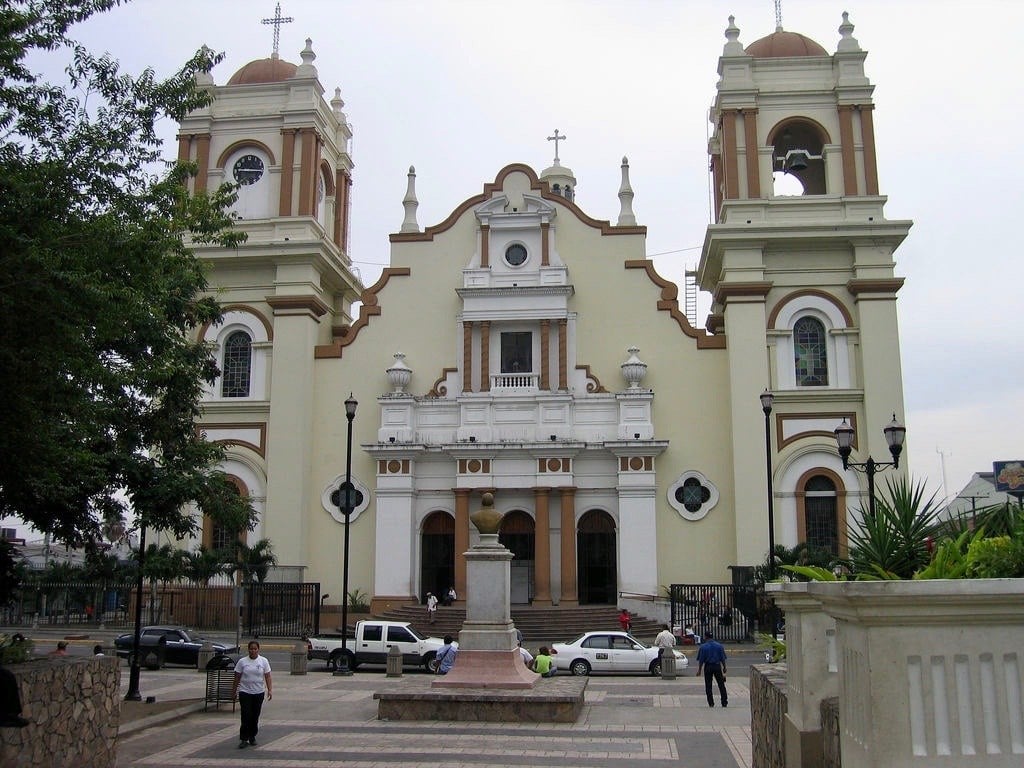
Bearing in mind the security situation, if you spend a few days in San Pedo Sula you will most likely be fine. They don’t just line up backpackers against a wall and pick them off one by one.
A little bit of common sense and a few extra precautions will go a long way to ensure you have the best time you can possibly have backpacking San Pedro Sula.
Don’t wear flashy jewelry. Avoid carrying more cash on you than you need. Take taxis. Don’t go out at night unless you absolutely have to.
When I was 16, I went on a volunteering trip to San Pedro Sula. Mostly, I helped paint and refurbish an ancient orphanage. At the time, what little innocence I had left at the age of 16 was shattered at this orphanage. Kids as young as six years old were coming in off the street totally addicted to sniffing glue and other drugs after being forced into being child sex slaves. Super heavy I know, but these are the realities of San Pedro Sula.
Having been back several times since as a backpacker, it is safe to say that I still have some great attachment to San Pedro Sula even if I can’t fully explain it.
Backpacking Tegucigalpa
In terms of safety, Tegucigalpa is much the same as San Pedro Sula. You’ll need to have your shit together whilst backpacking here. Though I must emphasize that major violent crime against backpackers is very rare, and if you set yourself up for success you should be just fine.
Tegucigalpa is the capital of Honduras as well as the country’s most populated city. The first thing I noticed as my bus rolled into town is how green the surrounding hills are. This sprawling mess of a city was literally built out of the mountainous jungle.
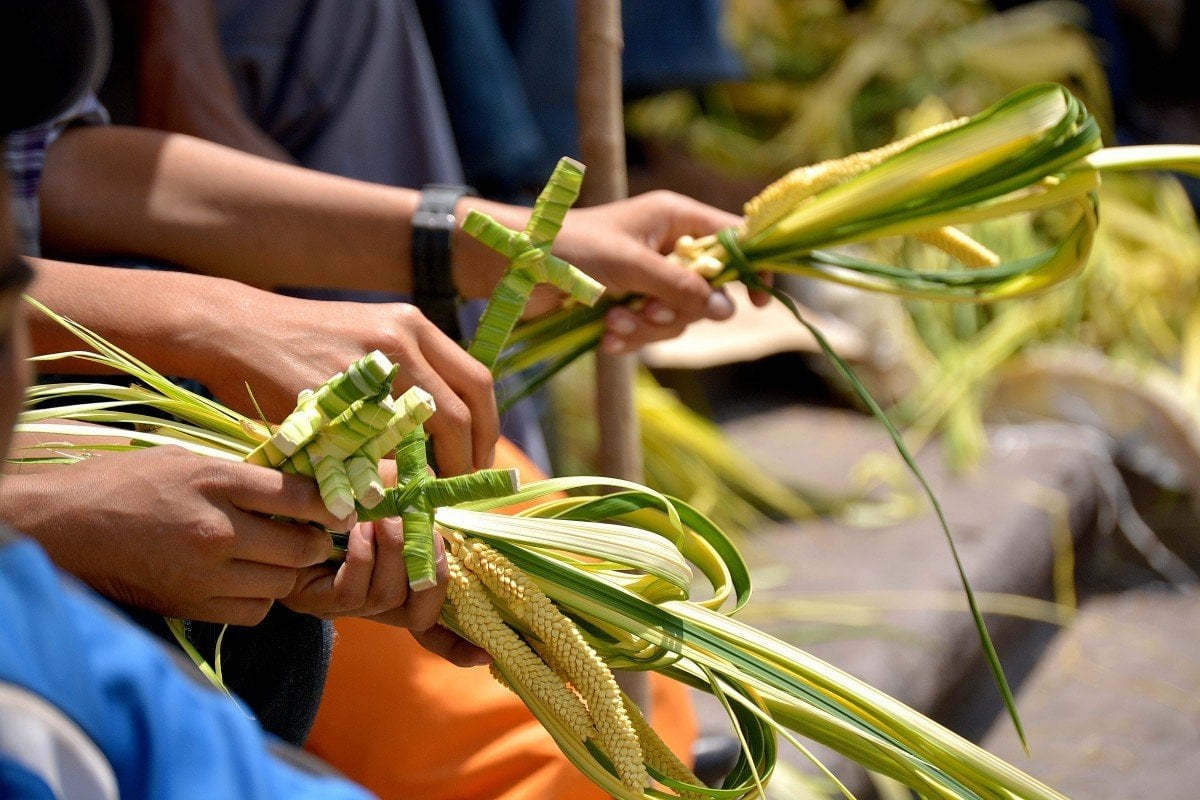
You can start your visit to the city center by checking out the Iglesia Los Dolores and the surrounding square. In a city full of urban sprawl, the colonial architecture and prominence of Iglesia Los Dolores are refreshing.
The St. Michael Cathedral adorning the Plaza Morazan is also worth a look.
Tegucigalpa is one of the few capital cities in the world with a complete lack of backpacker accommodation! Of the one or two hostels that do exist, Palmira Hostel is best.
Backpacking the Copan Ruins
Copan was a major capital city of the Mayan civilization from the 5th to 9th centuries AD. Copan as a city was occupied for two thousand years!
Throughout its storied history, Copan was the site of many different kings, conquests, and general changes of power. Now, the greater Copan archaeological site makes up the most important Mayan ruin complex in Honduras. It can take several days to properly take in all of the intricate carvings, monuments, temples, and dwellings.
The Copan Archaeological Park entrance fee is now the equivalent to $15.00 USD, but is well worth the money!
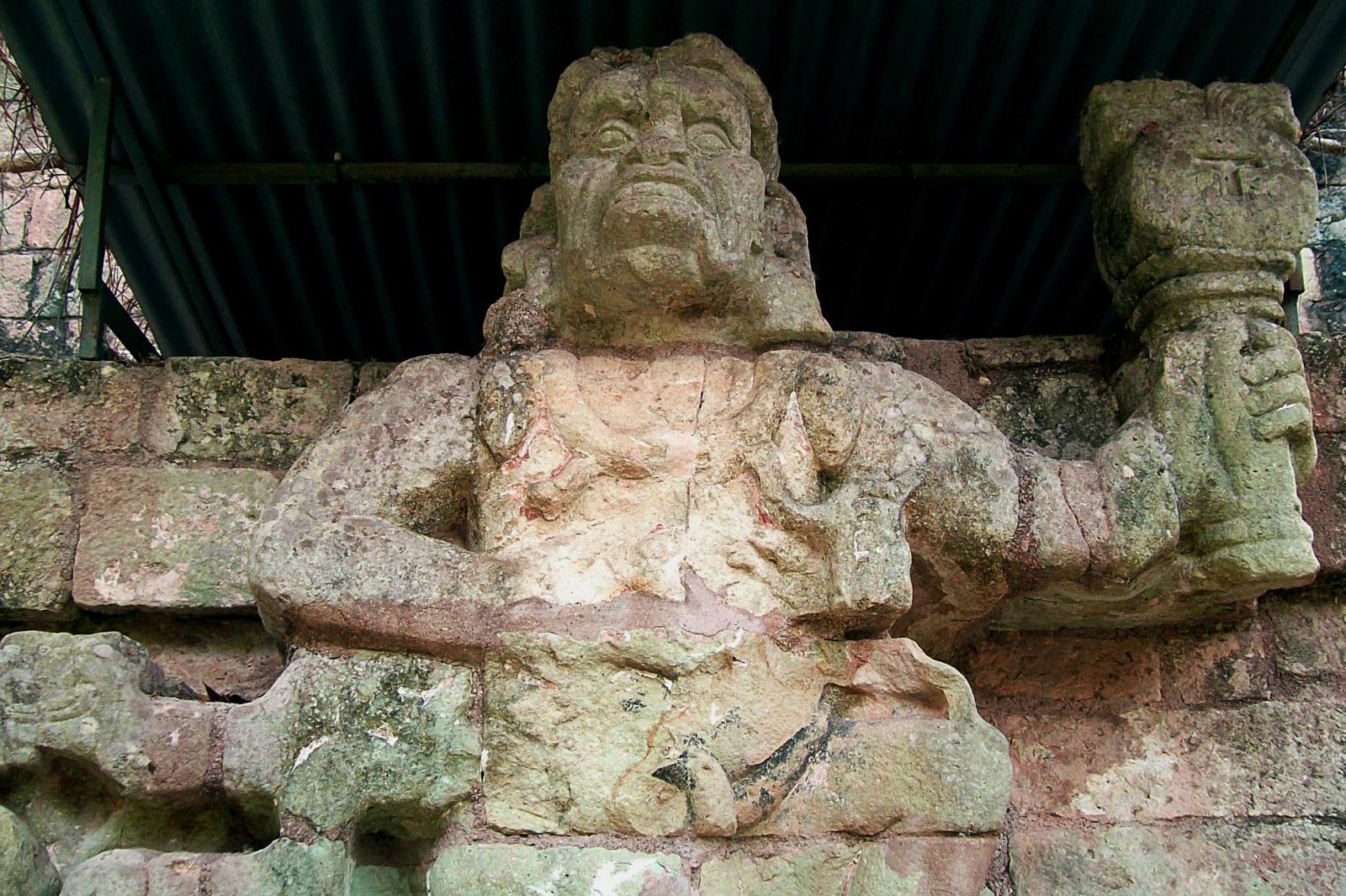
A popular way to get to Copan from Guatemala is via direct shuttle from Antigua, a city popular with backpackers about an hour outside of Guatemala City. The prices vary, but the average price is around $20/30 USD one way. The journey takes roughly 6-8 hours.
There are a few backpacker hostels around Copan that are clean and cheap.
You should start your day at Copan as early as possible in order to get the most out of your entrance ticket. Ideally, you should be able to see a majority of the ruins in one long day. Bring water and sun protection as Copan can be super humid and hot!
Backpacking Pico Bonito National Park
Pico Bonito is the best place in Honduras in terms of hiking and outdoor adventure pursuits. There are numerous short hiking trails that don’t require a guide.
The Cangrejal River Valley is one of the top places to hike in the park. To access the valley you cross this epic suspension bridge over the river. One of the best day hikes in the park is the El Mapache Trail, which leads to the stunning El Bejuco Waterfall .
If you have the time, money, and ambition, you can aim to tackle the Pico Bonito Mountain trek . This trek is no joke. I did not personally attempt this hike, but I intend to someday!
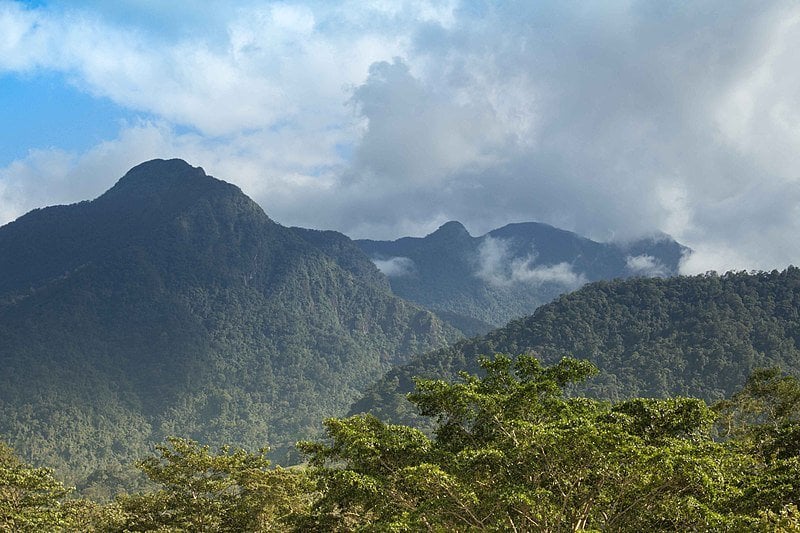
The complete out and back trek and summit the mountain will take between 8-10 days. There is no permanent trail to get there, so expect days of tough hiking and hacking through the dense jungle. It would be stupid to attempt this hike without a guide.
La Moskitia Eco-Aventuras has a reputable reputation when it comes to arranging the Pico Bonito Mountain Trek. Good on you if you go for it! Please let me know in a comment below how it all went!
La Ceiba is the place to base yourself for Pico Bonito National Park exploration.
Backpacking La Ceiba
For many backpackers, the coastal port town of La Ceiba is just the gateway to the Bay Islands and nothing more. I suggest taking at least 2-3 days to hang out here, especially if you are keen to visit Pico Bonito National Park before heading off to the Bay Islands.
La Ceiba is Honduras’ fourth largest city, though it did not feel nearly as sketchy as San Pedro Sula or Tegucigalpa. That said, I still would not go out to unknown parts of the city when the sun goes down.
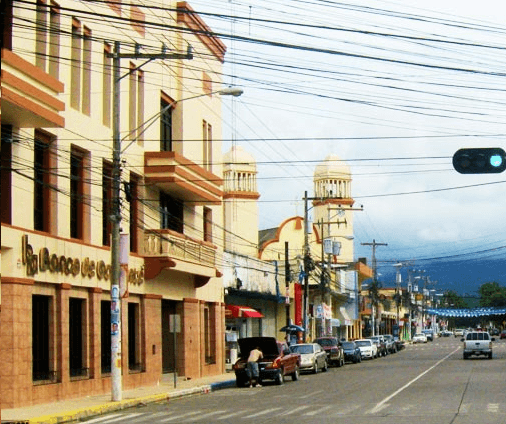
To get to the Bay Islands simply walk down to the main ferry terminal and book your ticket.
The best way to get to Utila from La Ceiba is aboard the ferry boat with a misleading name: The Dream . The Dream departs twice daily: once at 9:00 am and again at 4:40 pm. Ferry tickets cost the equivalent of $30 per person one way.
The La Ceiba ticket office is based at the “Muelle de Cabotaje”, the main cargo port of La Ceiba. The ticket counter, luggage drop off, cafe and air-conditioned waiting area are located in the orange building.
Backpacking the Rio Platano Biosphere Reserve
Located south of La Ceiba is the rugged and wild Rio Platano Biosphere Reserve. The Rio Plantano region is a true wilderness area, home to indigenous tribes including the Miskito, Pech, and Tawakha peoples as well as Garifuna people from African descent.
It is almost impossible to really explore the Rio Platano on your own unless you are equipped with supreme wilderness/navigation skills, a boat, and all of the necessary gear. I am guessing you do not have all of those things on hand, so consider hiring a guide.
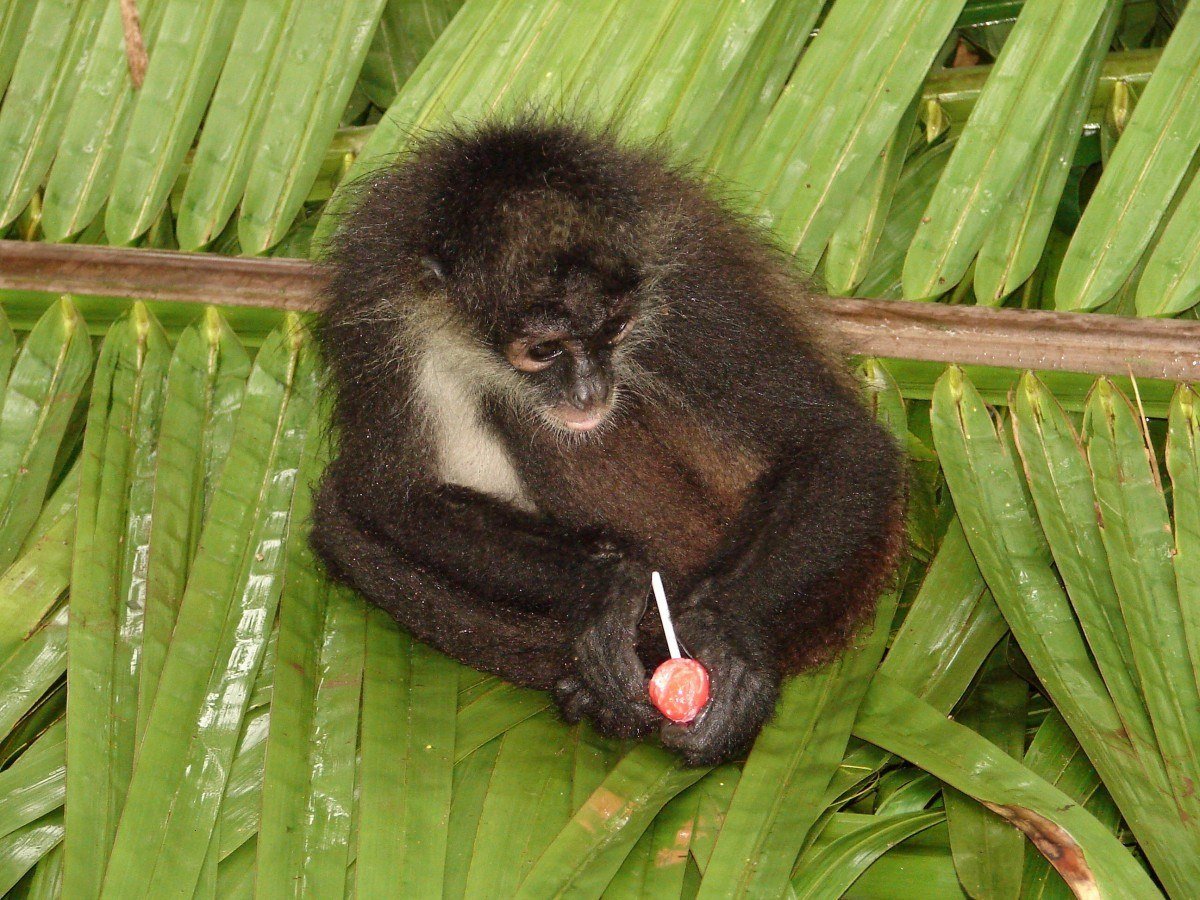
You can organize a 7-10 trip down the river that includes a mix of hiking, rafting, exploring, camping, and interacting with indigenous communities. If you are backpacking Honduras with no pressing time limit, I recommend you do a Rio Platano expedition with La Moskitia Eco-Aventuras!
If you can wrangle together a group of 7 or more, the price is $1,287 per person for a 10-day adventure.
Backpacking Utila Island
Once you get off the ferry in Utila you have officially entered an alternate reality. Utila is unlike the rest of mainland Honduras in just about every way. Suddenly you find yourself surrounded by backpackers, dive shops, hostels, burger shacks, smoothie stands, and pirate bars.
It is important to know that Utila is very much a developed backpacker hotspot. Don’t expect to discover an undeveloped private island. That said, the development that has taken place has not totally sucked the island dry of its charm. It may have improved it actually.
Utila has basically developed into a backpacker oasis where scuba diving by day and partying by night is most people’s daily routine. Losing track of time and the day of the week is to be expected. Utila is that kind of place.
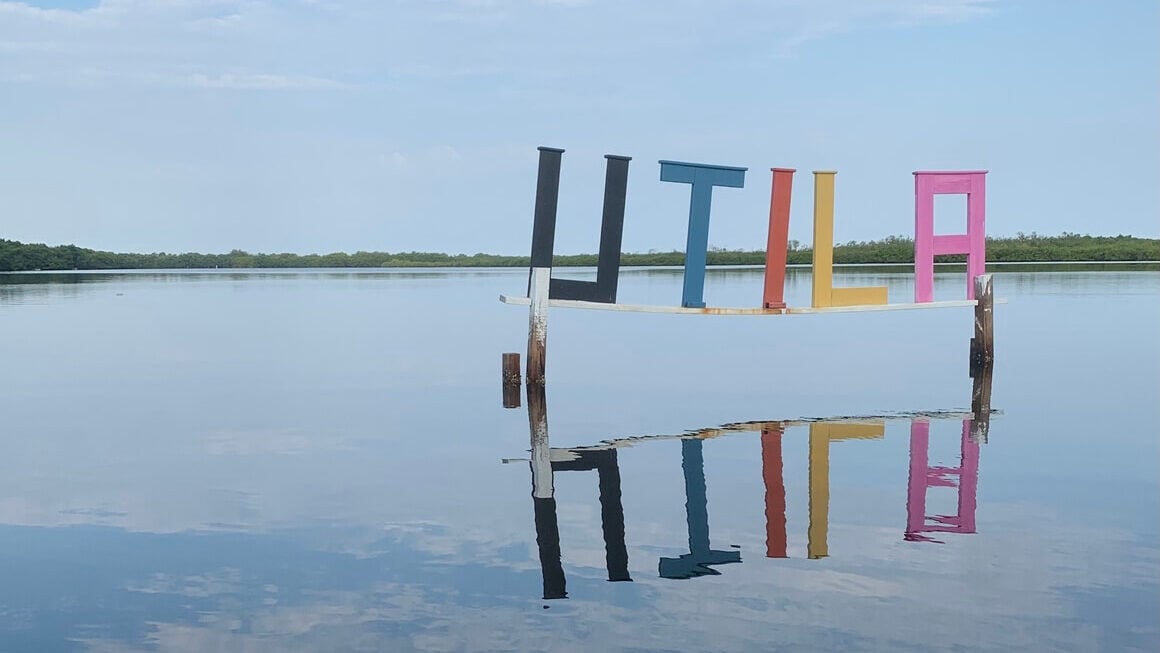
In fact, I fucking love Utila.
There are now dozens of scuba diving operators on the island. This means that you have your pick of what company you want to go diving with. Options are abundant and prices are competitive.
When you are not diving, you can explore the island on foot or by bike. There are beaches on the far end of the island where you won’t find any people at all. Sadly, when I visited Pumpkin Hill there was heaps of plastic shit lying on the beach.
Best Scuba Dive Shops in Utila
Welcome to (one of) the cheapest places in the world to get your PADI scuba diving certification!
I got my PADI open water diving certificate at Utila Dive Centre ; known locally as UDC. I was certified several years ago during my first visit to Utila.
At the time (2014) it costed roughly $200 and included three nights of accommodation at the Mango Inn. I was only supposed to get a bed in a crowded dorm, but for some reason, they gave me a private room for the same price.
UDC was nothing but professional. I highly recommend going with them if you decide to do any diving or dive training! Another great dive shop is Alton’s Dive Center.
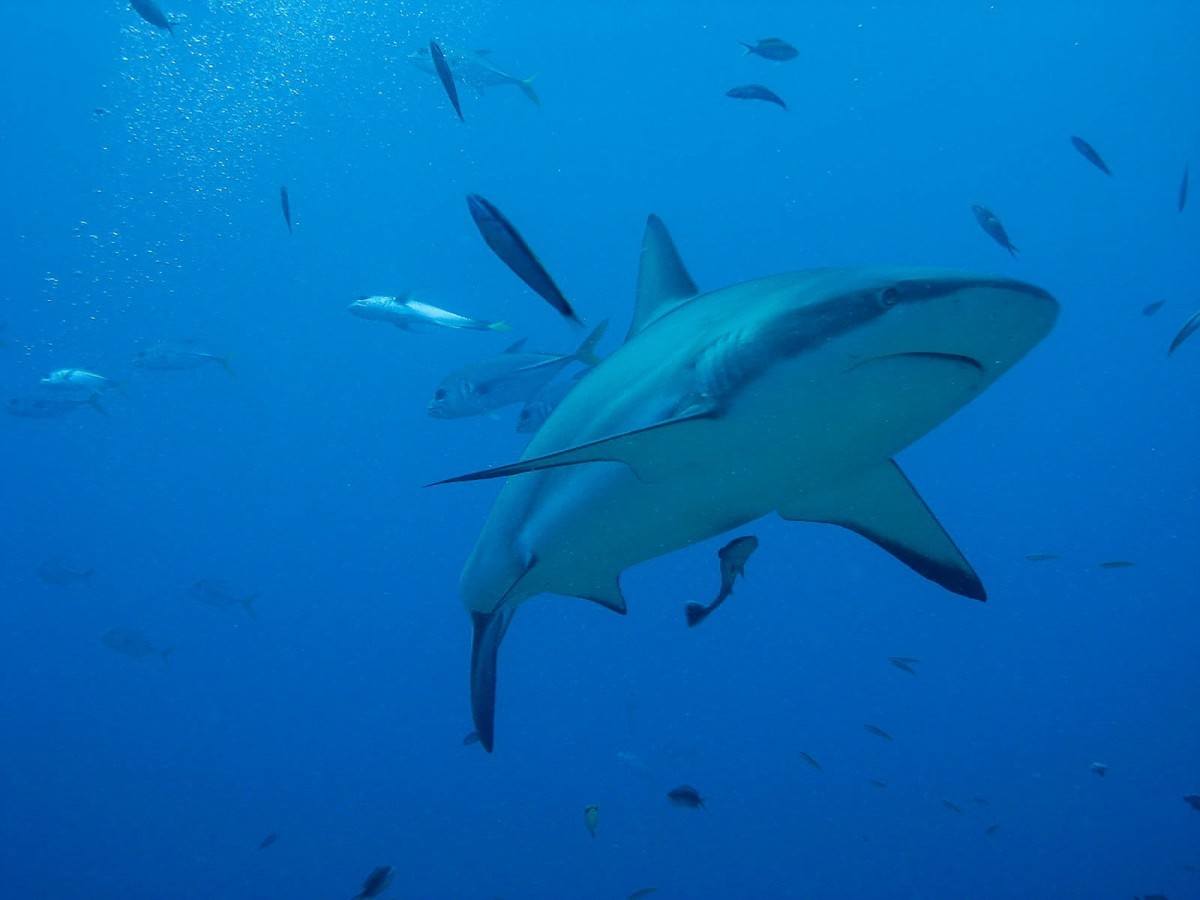
For 2021, I am not sure about the exact price for a 3-day open watercourse. I suggest you shop around the dive shops when you get there; don’t book ahead, as you will probably get a better deal in person. You can contact UDC here to get prices.
Moreover, some centers have better equipment, an instructor you’ll vibe with, a more party setting versus laidback. It just depends on what you want; ask to meet instructors, see the tanks, accommodation, etc.
There are two places that stick out in my mind as my favorite Utila eating/drinking spots. For breakfast, hit up Thompson’s Bakery for some god damn tasty Johnny Cakes (fluffy biscuits). Their cinnamon rolls are also top tier!
For the best place to drink in Utila, look no further than the Skidrow Bar . The true hedonism of Utila is on display here day in and day out.
Skidrow Bar is very much an island institution. You are always bound to meet some new friends at Skidrow; it’s kinda unavoidable. Go and find out what the Guifitti Challenge is all about. Shudder .
Also, Skidrow has some very good food at low prices as well. Try the Mexican food—it is all on point.
Backpacking Roatan Island
Roatan is the largest of the Honduras Bay Islands. Roatan is the more developed, more expensive, and family friendly big brother of Utila. The island attracts a very different crowd indeed. Ex-pat retirees, yachties, families with kids, and cruise ship tourists make up a large majority of the demographic found on Roatan at any given time.
One good thing I can say about Roatan is that the dive sites are excellent around the island. If you are a keen diver, Roatan is well worth a visit.
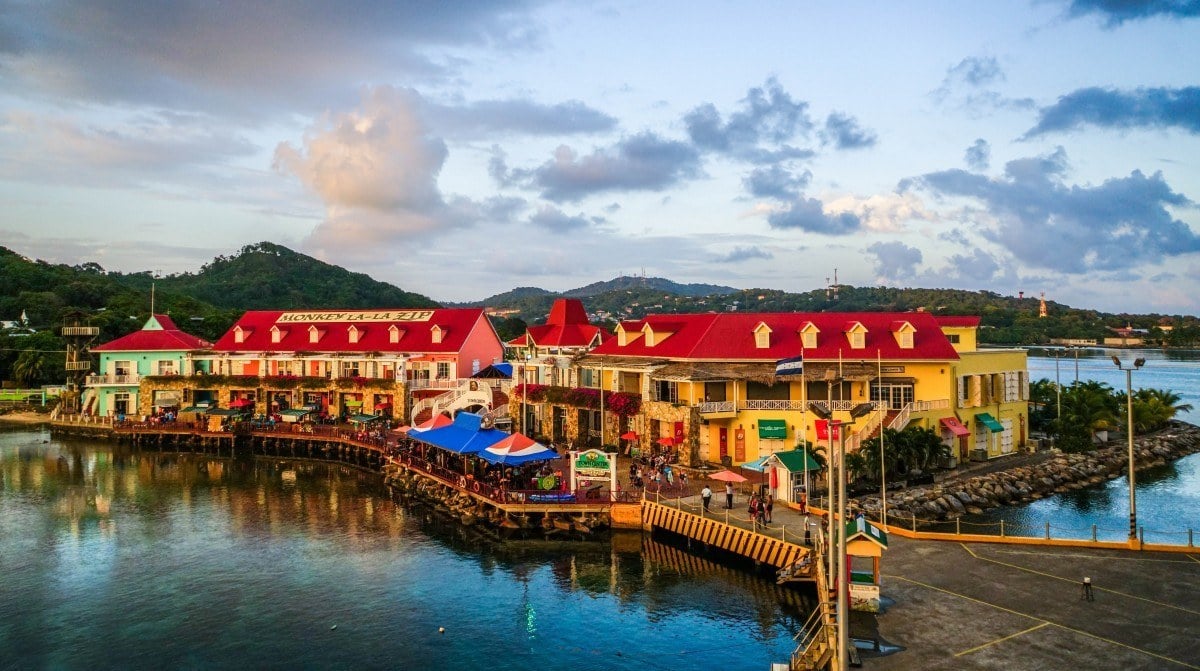
If you don’t get sick of the diving around Utila, there is really no need to go to Roatan. After Utila, frankly, parts of Roatan are disappointing, less charming, and obviously more expensive.
There is one boat leaving Utila every day for Roatan. The price at last check was $30 per person one way (though the prices may have increased some since the publication of this article).
Getting Off the Beaten Path in Honduras
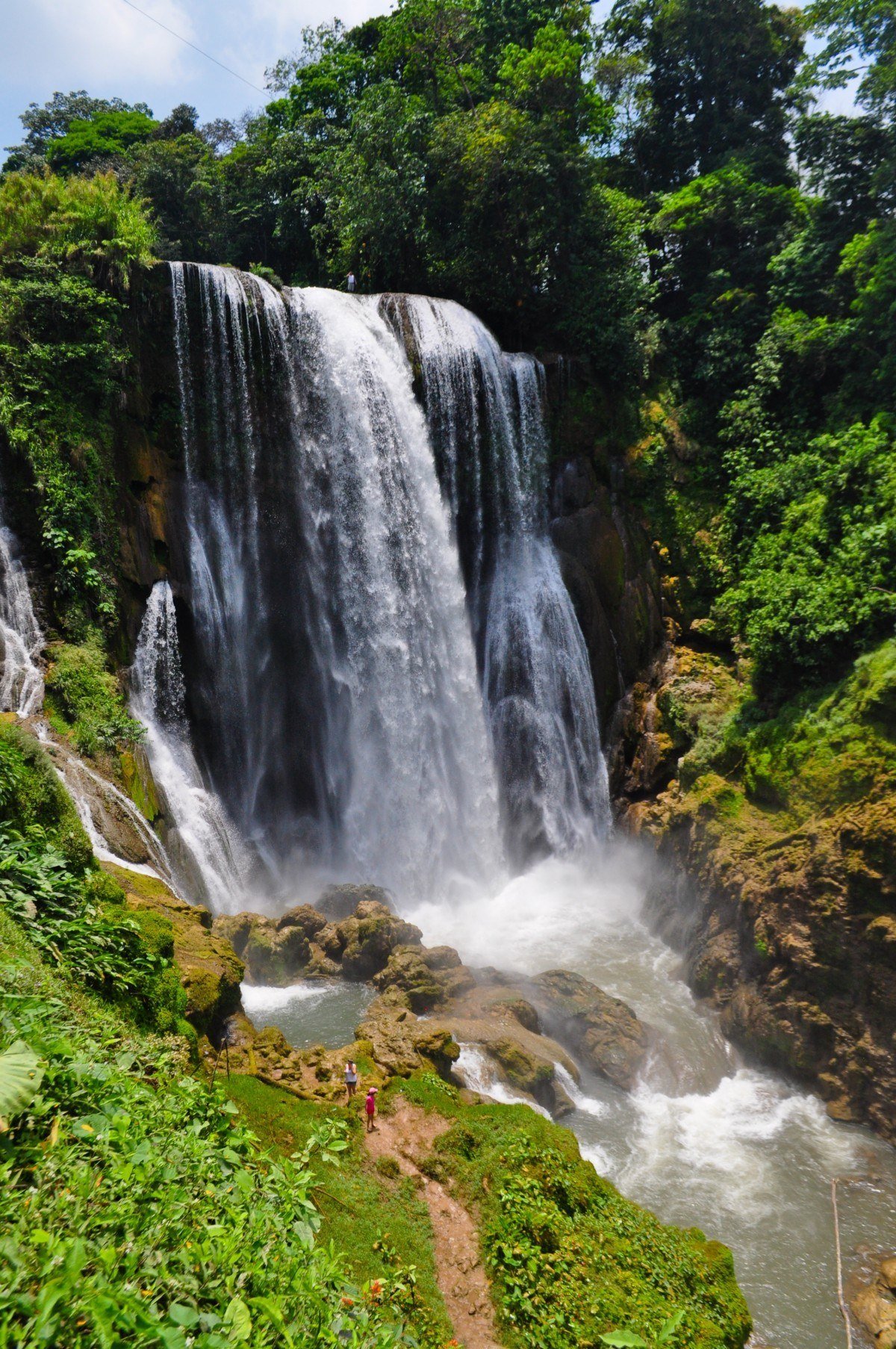
As a whole, Honduras is an off the beaten path country that just happens to be on the well-beaten Central America gringo trail.
Nicaragua, El Salvador, and Guatemala all receive far more backpackers than Honduras does annually. If you take away the Bay Islands, 99% of Honduras is essentially off the beaten track.
There is a whole universe of potential backpacking adventures to get into in Honduras. A vast majority of them are simply not known by the collective backpacker consciousness.
Getting off the beaten path in Honduras, however, requires treading a fine line. Go to Honduras and get off the beaten path but be smart about how and where you do it.
There are few guaranteed “safety nets” in Honduras (which is more of a metaphor than to be taken literally. I saw no physical safety nets in Honduras FYI).
What I mean is that you are very much reliant on your own street smarts, wits, and judgment once you leave the small backpacker trail that does exist in Honduras…but in essence, that is what a backpacking adventure is all about. Right?
Always remember that Honduras is a country with high levels of poverty and crime. Locals are simply not accustomed to seeing large amounts of travelers passing through. Many locals I met in less-trod places were nothing but hospitable, kind, and curious.
Use good judgment when exploring new places and you should be just fine.

We’ve tested countless backpacks over the years, but there’s one that has always been the best and remains the best buy for adventurers: the broke backpacker-approved Osprey Aether and Ariel series.
Want more deetz on why these packs are so damn perfect? Then read our comprehensive review for the inside scoop!
There is plenty of awesomeness to discover in this beautiful country. Below I have listed the 10 best things to do in Honduras:
1. Visit the Copan Ruins
The Copan ruins are among the top 3 most important Mayan sites in all of Central/North America. Visit Copan to get your mind blown by the stunning engineering/artistic/cultural accomplishments of the Maya.
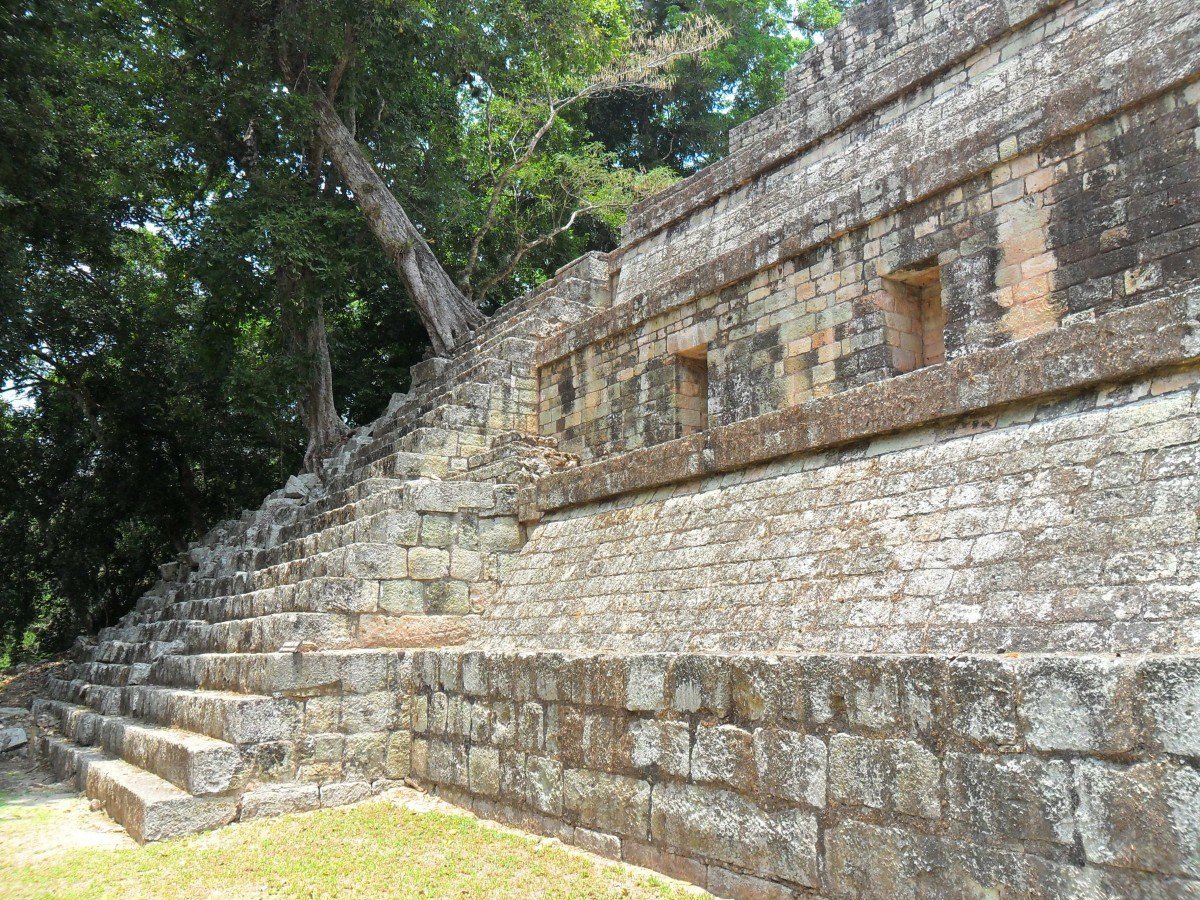
2. Explore the National Parks of Honduras
There are 18 national parks in Honduras and each one of them is worth checking out. Since you will likely not have the time to see them all, pick a few, lace up your hiking boots , and hit the trail.
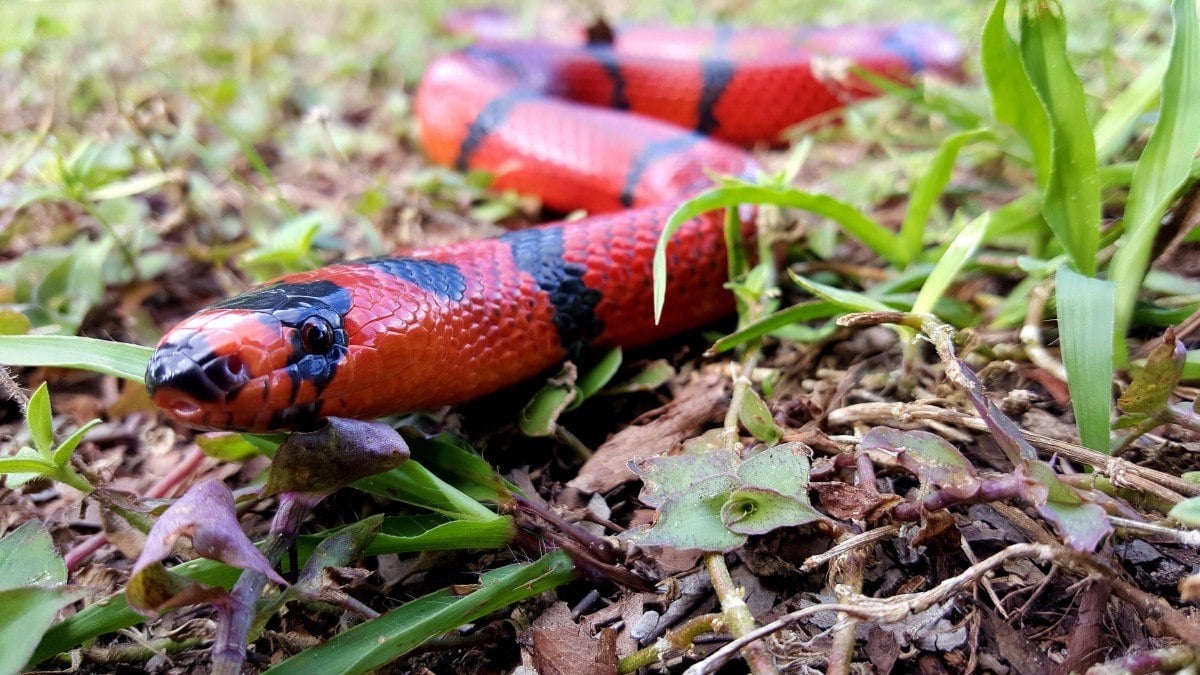
3. Take a boat onto Lago de Yojoa
Lago de Yojoa is Honduras’ largest lake. More than 480 species of birds have been recorded here! Enough said.
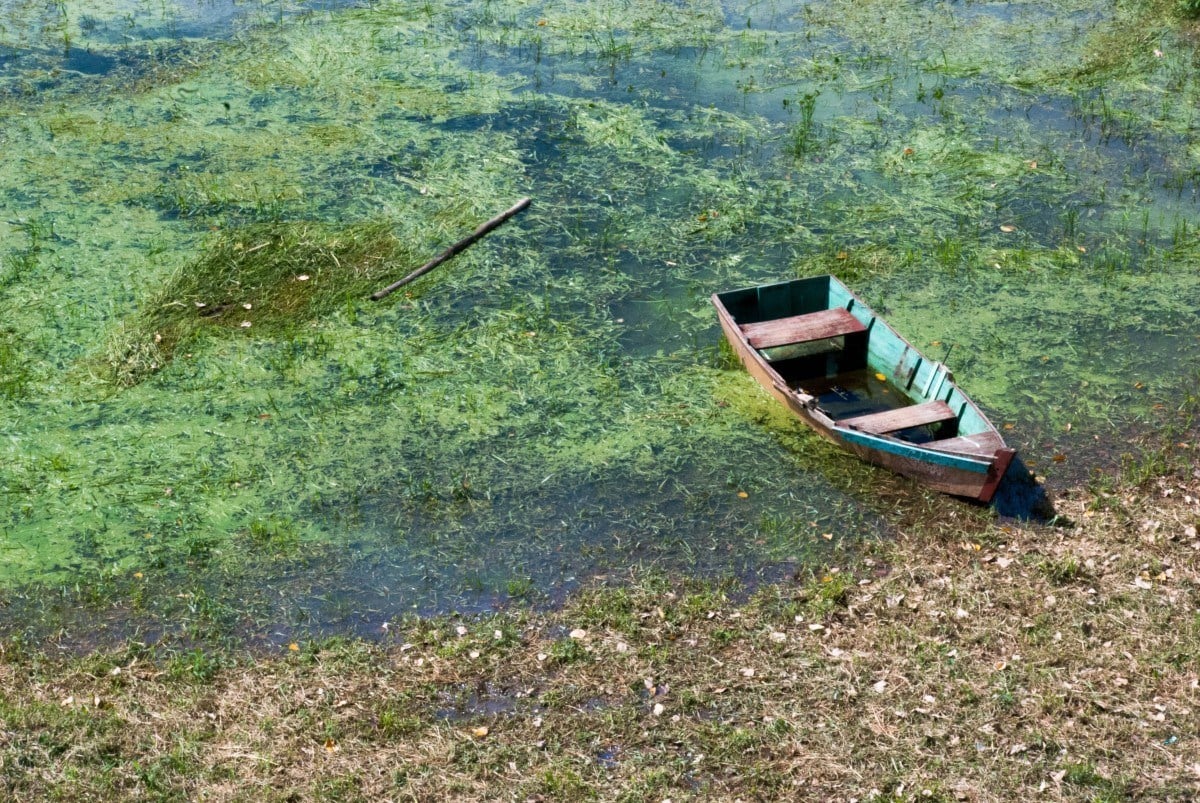
4. Get your PADI Open Water Certificate in the Bay Islands
Want to get your scuba certification for the cheapest price this side of Thailand? Come to the Bay Islands and enroll in a scuba diving course. Prepare to be introduced to a new life-long love: diving!
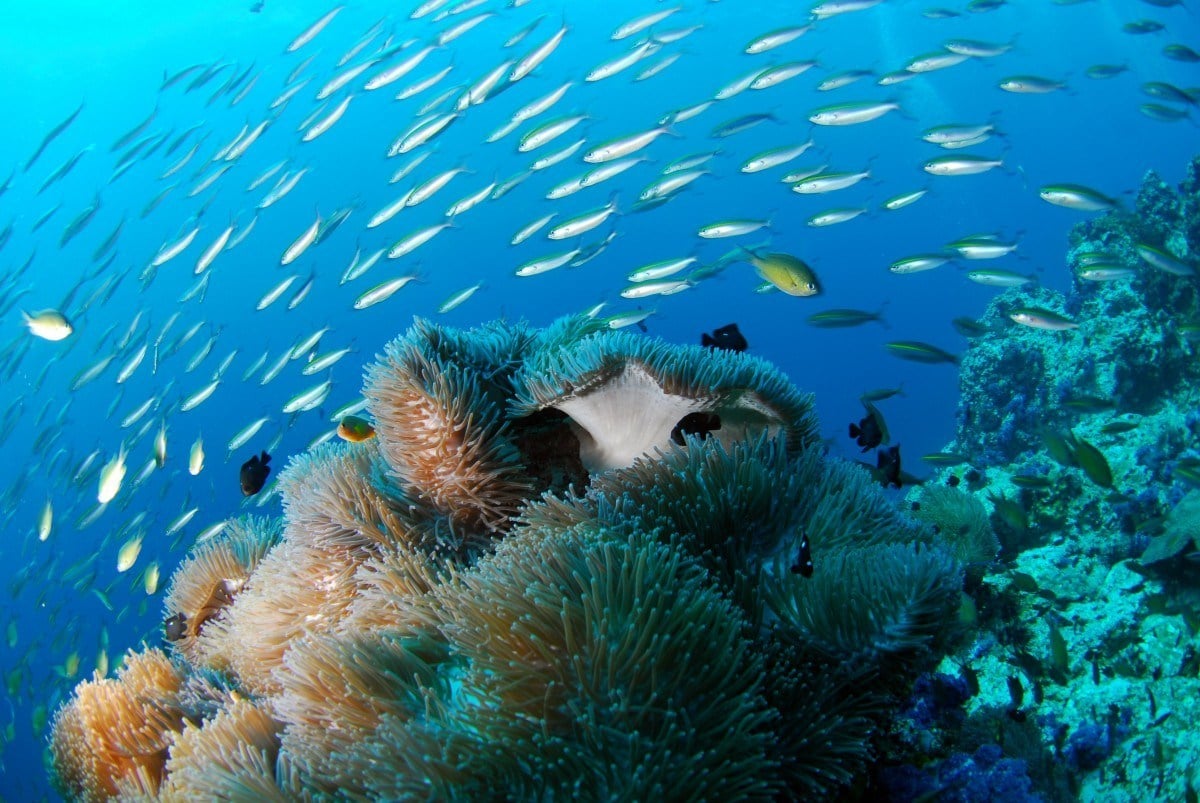
5. Arrive into Honduras by Boat
Quick Tangent: On one occasion, I entered Honduras on a private catamaran owned by a drunken middle-aged Canadian dude named Guy. We left from Rio Dulce in Guatemala (the morning after I was stabbed and robbed, that’s another story) and arrived at Utila in the Bay Islands.
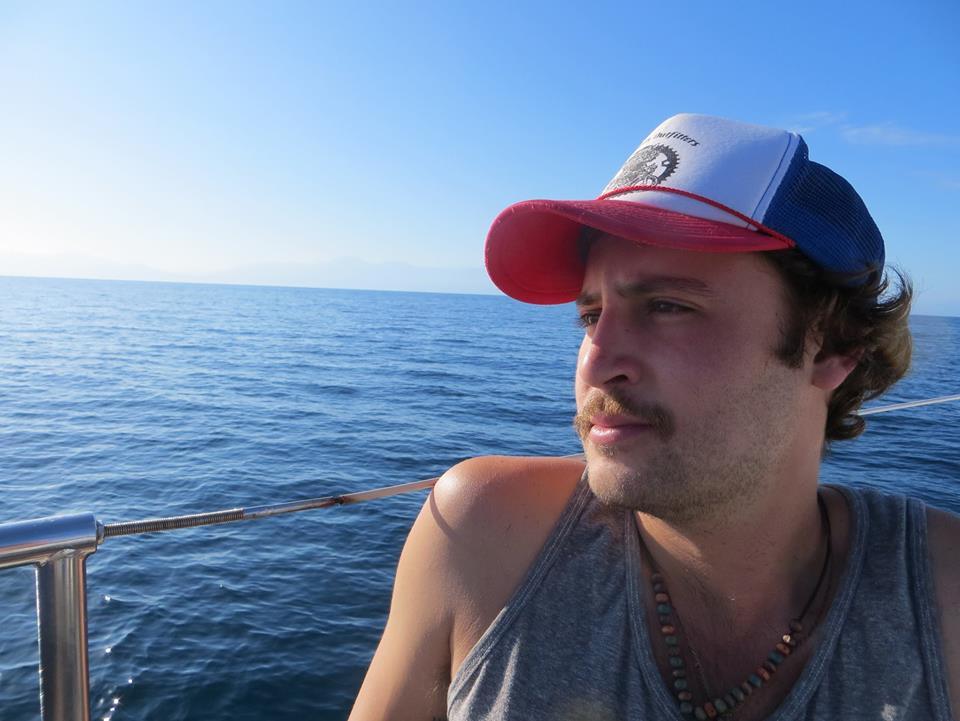
The trip took 2 days and was an experience I’ll never forget. The trip was an inebriated shit show that involved fishing, naked swimming, great food, and seawater soaking me in the middle of the night because I didn’t close the porthole window properly. I’ll leave it at that.
If you’re lucky you may be able to find Guy (if he is still alive) drinking rum at the Sun Dog Cafe in Rio Dulce or the Skidrow Bar in Utila. Good luck.
6. Go on an expedition deep into the Rio Platano Biosphere
It’s not the cheapest option, but sometimes an excellent, truly unique adventure requires a little investment. I guarantee that afterward, the last thing you will be thinking about is the money you spent.
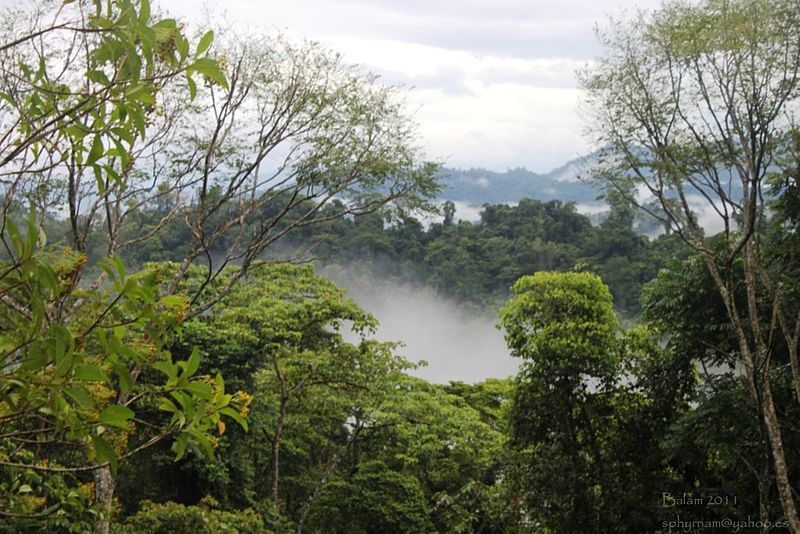
7. Explore some of the lesser known Bay Islands
Apart from Utila and Roatan, the Bay Islands are remote, wild, and fucking gorgeous. It certainly takes some effort and a little cash to get to some of these islands (like Cayos Conchinos), but it is well worth it indeed.
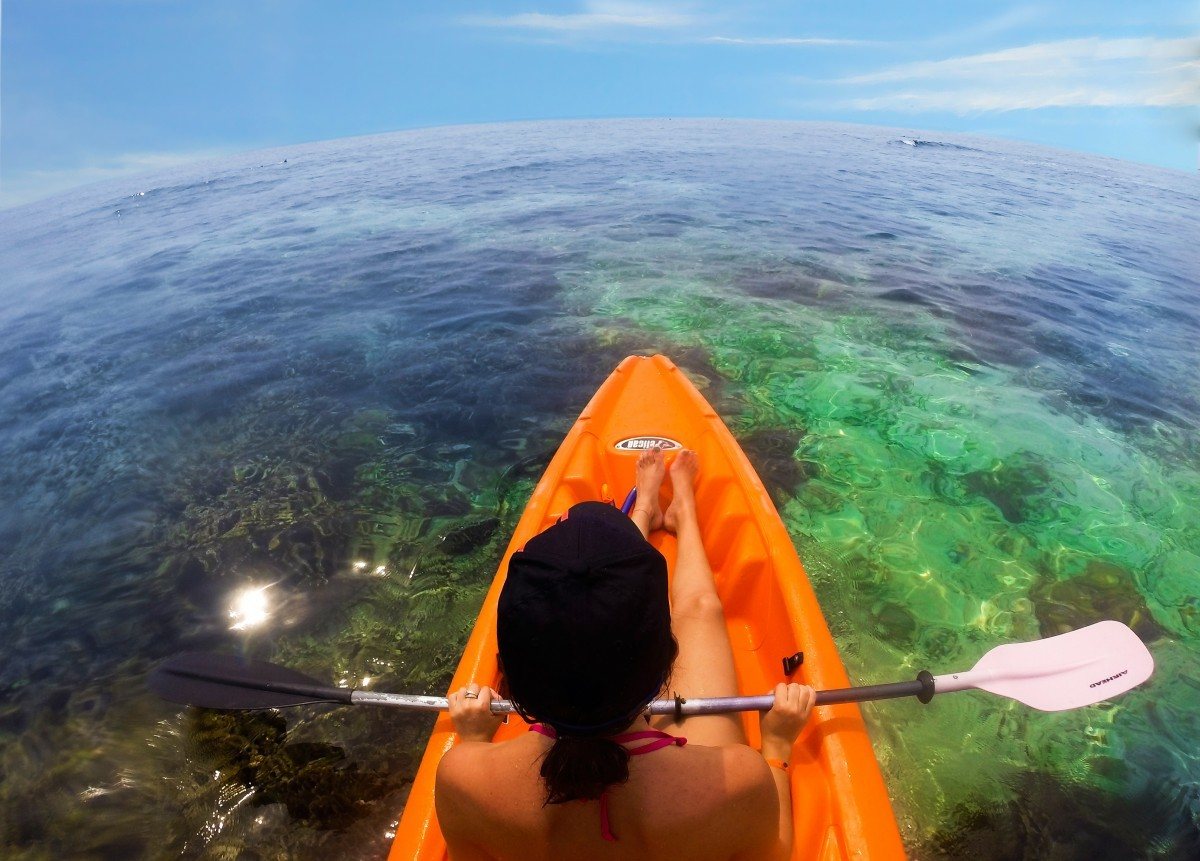
8. Visit the Cathedrals in Tegucigalpa
Tegucigalpa is not overflowing with beautiful buildings, but its colonial-era architecture is well worth the visit if you find yourself in the city for a day or two.
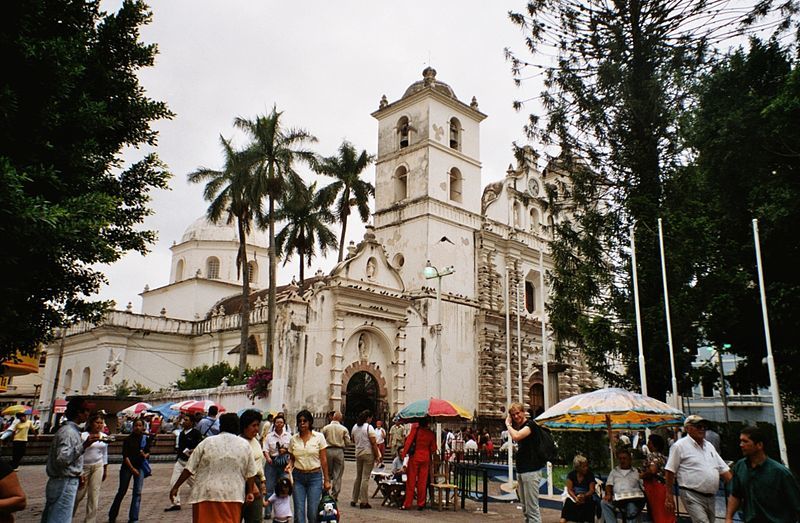
9. Eat Street Food
If you’ve backpacked around Central America (not including Mexico) then you are probably aware of how a majority of the food lacks that “wow” factor. In Honduras, you can find some very tasty street food at broke backpacker prices. I’m a huge fan of baleadas.
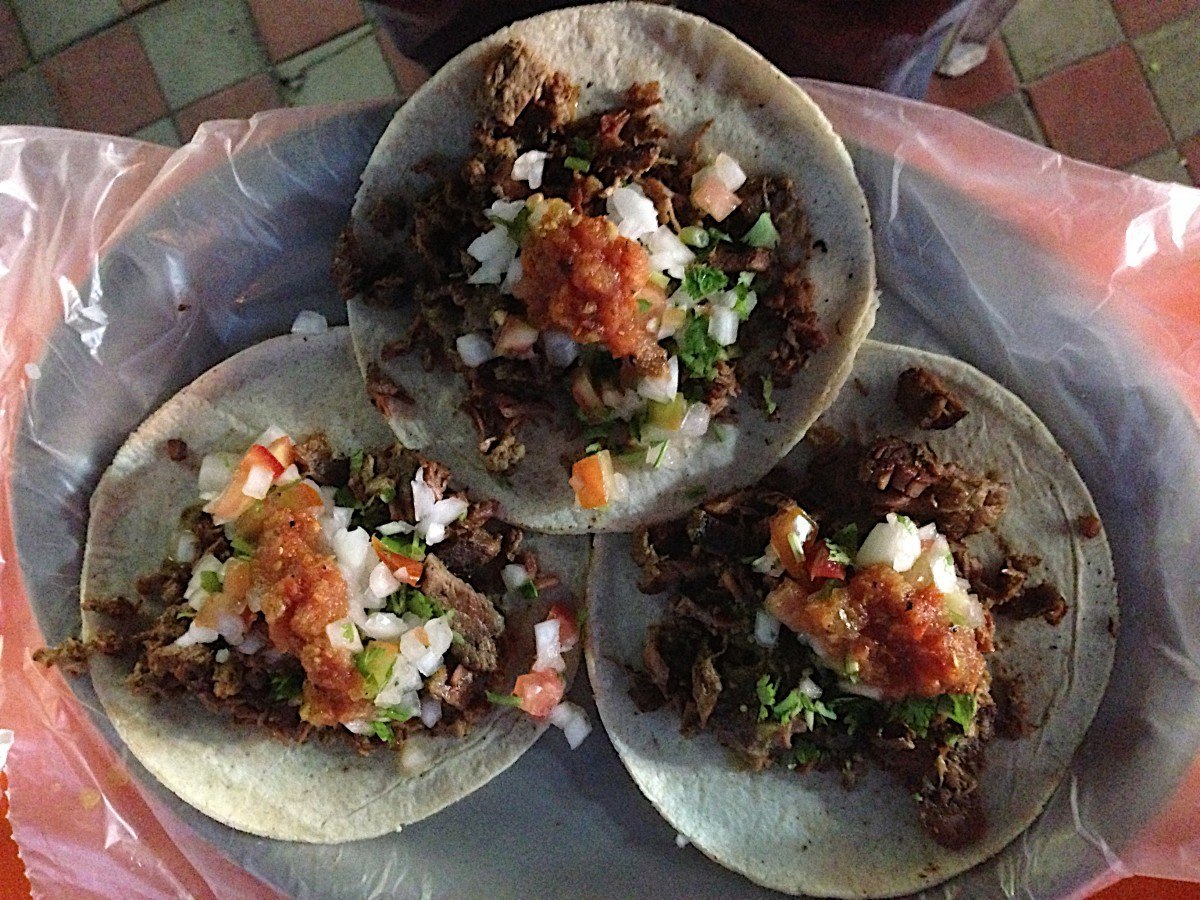
10. Volunteer in Honduras
There are a handful of cool projects, organizations, and hostels to get involved with within Honduras. What you get out of traveling takes on a new meaning when you start giving back to others in need. More on volunteering in Honduras later in the article.
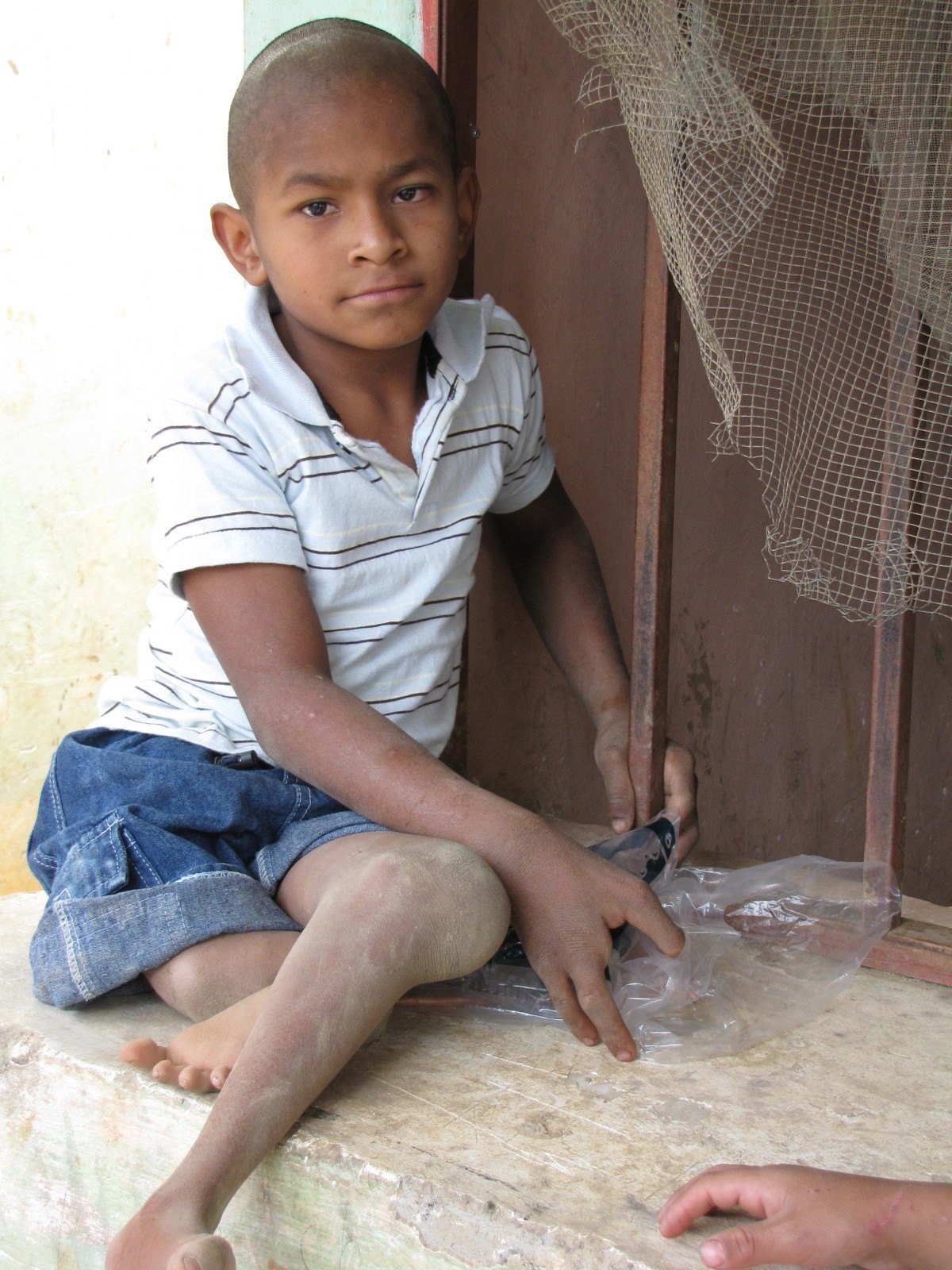
Wanna know how to pack like a pro? Well for a start you need the right gear….
These are packing cubes for the globetrotters and compression sacks for the real adventurers – these babies are a traveller’s best kept secret. They organise yo’ packing and minimise volume too so you can pack MORE.
Or, y’know… you can stick to just chucking it all in your backpack…
The majority of Honduras is seriously lacking in backpacker accommodation. Considering the standard cost of living in Honduras, I was shocked to learn how expensive some of the mid-range hotels found in cities can be.
The Bay Islands and Utila do have plenty of hostels and cheap accommodation options as does the area around the Copan ruins. Across the rest of Honduras, however, there is no backpacker “scene,” so obviously backpacker hostels are an unknown fucking concept. That said, there is usually a cheap (maybe not so clean) hotel or guesthouse to be found in most places.
In order to find the best price in a place lacking hostels, you will need to shop around and haggle your ass off.
Something worth noting is that all hotels/hostels etc tack on a 16% tax to the nightly rate on each person per night.
One of my favorite ways to meet locals and save some cash is to use Couchsurfing. Couchsurfing truly is one of the best tools available to help save you money traveling. Plus, you are always bound to meet interesting people! In times of COVID – CS is not really an ethical option anymore. Hopefully, someday soon the CS scene will see a revival.
Wild Camping in Honduras
Camping in Honduras is tough during the best of times. From a safety perspective camping in or around villages (certainly not around cities!) is not a good idea.
Leaving your stuff in a tent while you go for a short walk is basically like donating all of your stuff to the general public. The vast majority of Hondurans are not thieves, but the temptation of a tent loaded with cool stuff may just be too much for them to pass up on.
That said, there are some opportunities to wild camp in Pico Bonito National Park and the Rio Platano area .
Another serious factor when contemplating wild camping in Honduras is the weather, mosquitos, and the natural environment. Honduras is hot, humid, and it can rain like there is no tomorrow.
Plus, the beautiful places ideal for camping have plenty of deadly creatures you need to worry about…or at least ones you should know about.
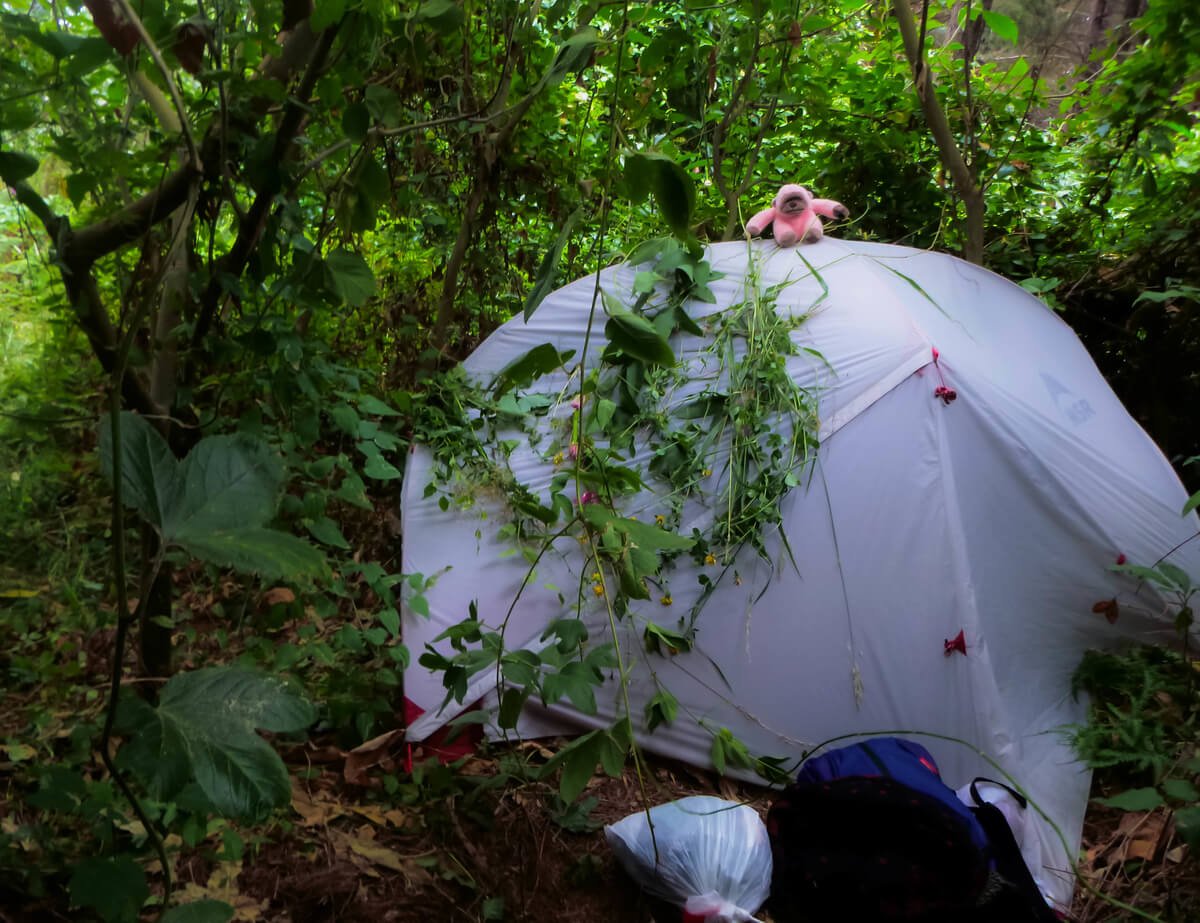
I don’t say that Honduras and camping shouldn’t mix. You just need to be realistic about the potential dangers, hazards, and general annoyances such an undertaking may present. Above all else, if you decide to make camping part of your Honduras backpacking experience, bring the right gear!
Get familiar with “leave no trace principles” and put them into practice.
If you are in the market for a solid, lightweight, and reliable tent, I highly recommend the MSR Hubba Hubba 2-person tent . This compact tent is up to the challenge of battling Honduras’ subtropical weather. To get to know this tent better, check out my in-depth MSR Hubba Hubba Review .
The prices I encountered in Honduras were often perplexing. Some things were outrageously cheap, like food and beer, but other equally important things like transportation and accommodation can get expensive if you don’t do your due diligence.
Booking adventure tours and doing LOTS of scuba diving is likely to eat a hole in your budget really quick. I suggest that you plan your trip based on your own interests.
Come up with a plan that will allow you to spend as much time as humanly possible diving, trekking, or whatever your fancy may be.
A reasonable backpacker budget for mainland Honduras is between $25-45/day . On the Bay Islands , your budget will be around $50-75/day (including a morning of scuba diving).
Hostel prices do vary, but when you are able to find a proper hostel normally it will be under $15 for a dorm bed.
Here is what you can expect to spend on a daily basis whilst backpacking Honduras:
A Daily Budget in Honduras
Money in honduras.
The national currency of Honduras is the Lempira. ATMs are available at or around backpacker destinations in Honduras, including the Bay Islands as well as in the big cities.
Whilst I was on Utila Island, the ATM machine ran out of money, twice. I’d say for the islands it is ok to have a stash of cash on you or in your hostel room (maybe lock it up). The last thing you want is for the machine to run out of money on you and prevent you from scuba diving (or eating!) so plan accordingly.
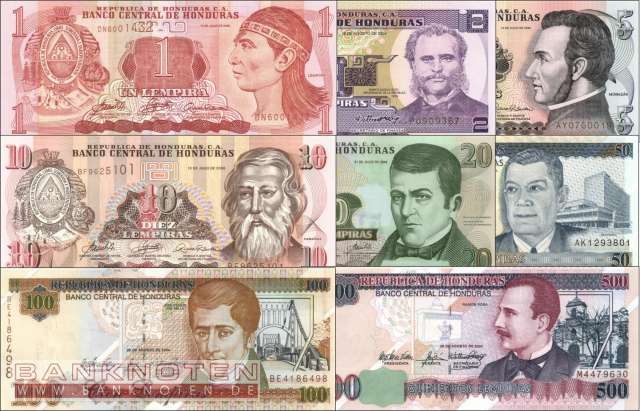
Some of the dive shops on Utila and Roatan accept USD as payment.
Travel Tips – Honduras on a Budget
Camp: There is no shortage of physical places to camp in Honduras. The practicality and safety of camping, however, needs to be judged on a case by case basis. The higher elevations in the national parks/cloud forests make for the most enjoyable camping spots, in my opinion. Realistically though, you will not be doing much camping in Honduras.
Cook your own food: Travel with a portable backpacking stove and cook your own food when possible/practical to save some serious cash whilst backpacking across Honduras. If you plan to do some overnight hiking trips or camping having a backpacking stove will be ESSENTIAL to your success. My two personal go-to stoves are the MSR Pocket Rocket 2 and my Jetboil . Hostel cooking (at least one meal per day) is also key to saving money long term.
Do activities in Groups: If you plan to go for a chartered snorkle boat ride or a long trek, the prices will always be cheaper as you have more people in the group to chip in.
Check out my in-depth review of the MSR Pocket Rocket 2 here .
Why You Should Travel to Honduras with a Water Bottle
Plastic washes up on even the most pristine beaches… so do your part and keep the Big Blue beautiful
You aren’t going to save the world overnight, but you might as well be part of the solution and not the problem. When you travel to some of the world’s most remote places, you come to realise the full extent of the plastic problem. And I hope you become more inspired to continue being a responsible traveller .
Plus, now you won’t be buying overpriced bottles of water from the supermarkets either! Travel with a filtered water bottle instead and never waste a cent nor a turtle’s life again.

Drink water from ANYWHERE. The Grayl Geopress is the worlds leading filtered water bottle protecting you from all manner of waterborne nasties.
Single-use plastic bottles are a MASSIVE threat to marine life. Be a part of the solution and travel with a filter water bottle. Save money and the environment!
We’ve tested the Geopress rigorously from the icy heights of Pakistan to the tropical jungles of Bali, and can confirm: it’s the best water bottle you’ll ever buy!
February and June are the driest months in Honduras and also when the diving in the Bay Islands is at its best. Hurricane season in much of the Caribbean is in September and October. It makes sense to avoid the Bay Islands during that time.
Apart from the dry season in the Bay Islands, Honduras really doesn’t experience the huge highs and lows of seasonal tourism felt in neighboring countries.
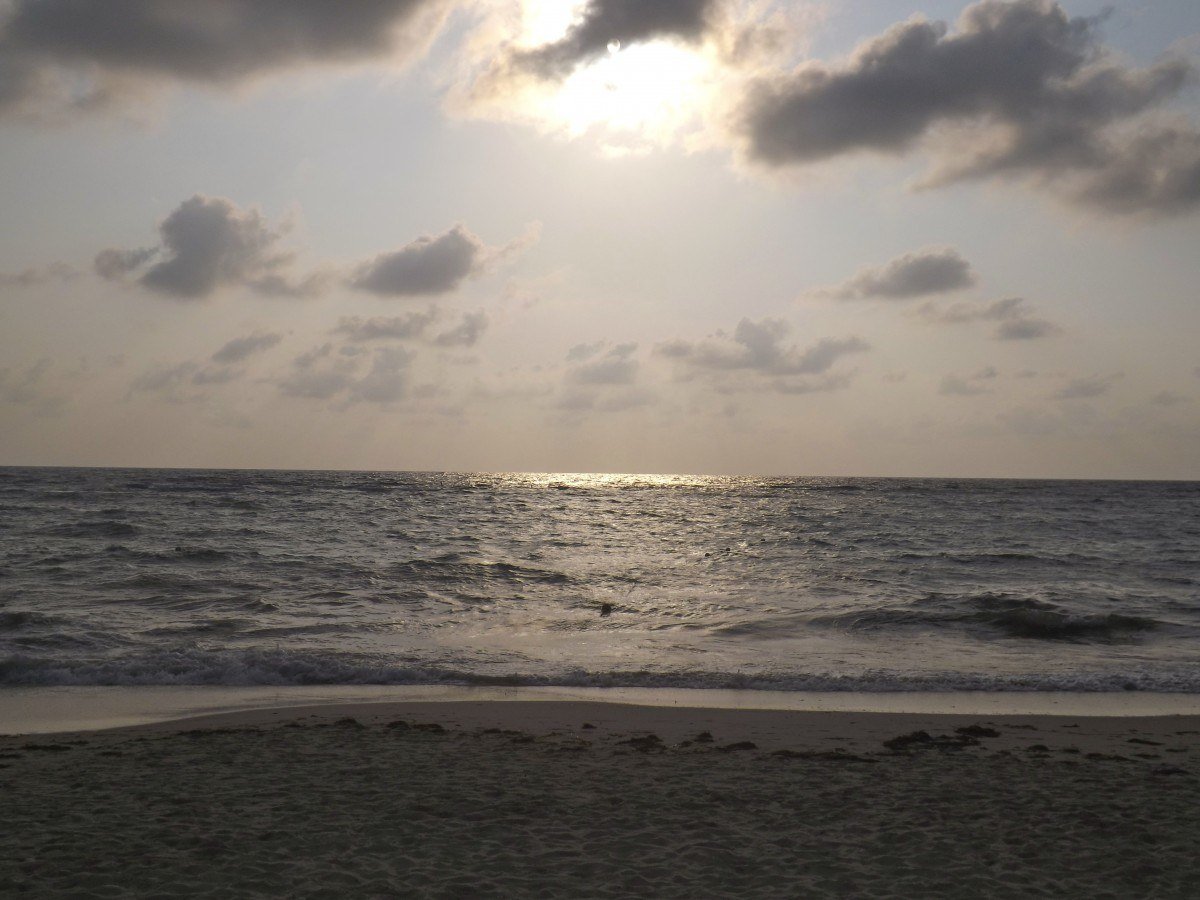
That said, spillover backpacker activity from neighboring countries does slow down during the rainy season as there are fewer backpackers traveling in Central America in general. (IE fewer backpackers visiting Copan from Guatemala, etc.)
The Caribbean coast is always going to be muggy, hot, and prone to sudden showers any time of year. Your best bet for dry weather falls between March and May.
Festivals in Honduras
There is always something fun to get into in Honduras. Depending on the time of year you find yourself backpacking in Honduras, there are many cool festivals to check out. Here are a few of the top festivals in Honduras:
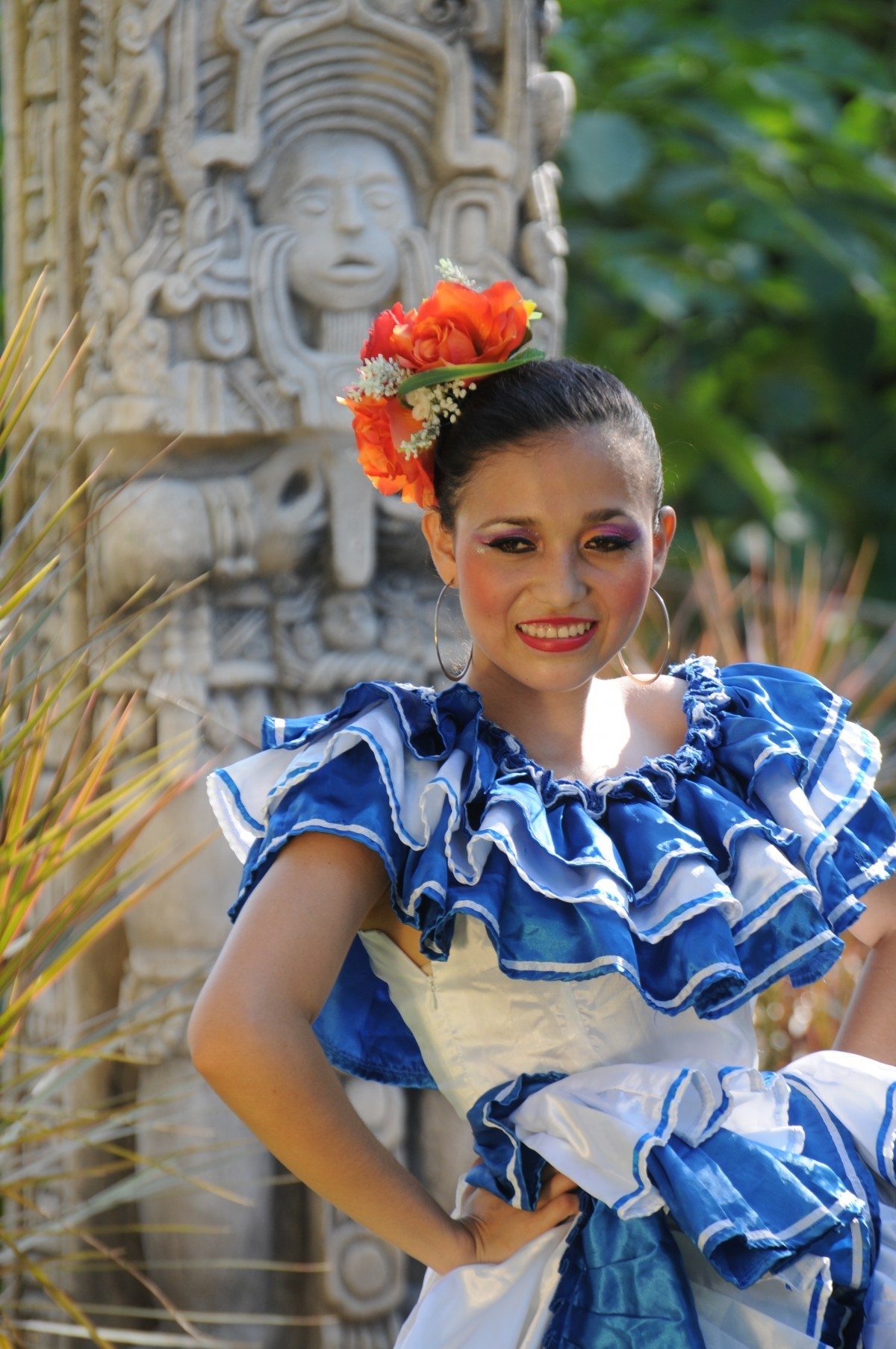
- Semana Santa: The Easter holiday is huge across all of Latin America. Honduras is no different; Semana Santa is a big deal. Oddly enough one of the best places to experience Semana Santa in Honduras is near the Copan Ruins (the Mayans were not Catholic).
- Lluvia de Peces: Listen up! This festival is a little—how shall I put this —halfway rooted in reality. After a massive rainstorm in the small mountain town of Yoro, it is said that fish rain down from the sky. You read that right. The residents claim it happens a few times a year. Fish literally flopping on the streets, alive. Only one way to find out.
- Punta Gorda Festival: This festival, held both by and for the Garifuna People of Honduras, takes place on April 12th of each year. The largest event takes places at Punta Gorda. Food. Dancing. Rum.
- Feria Juniana: If ever there was a time to party with the locals in San Pedro Sula it would be for the Feria Juniana. This festival takes place in June. Lots of live music and drinking. Don’t party down so hard that you let your guard down completely…this is San Pedro Sula we’re talking about!
What you decide to pack will depend on where you’re going, what activities you have planned, and what the weather will be like. If you’re just going to hang on the beach, you can just show up in your swimsuit and tank top and be ready to rock.
Be sure to pack some good shoes if you plan on exploring the cities and/or engaging in outdoor activities. It’s also a good idea to bring an extra day bag to carry with you to the beach or for big sightseeing days.
Depending on the time of year, you’ll probably want to wear a hat and sunglasses.
On every adventure, there are six things I never go traveling without:

Travel Security Belt
This is a regular looking belt with a concealed pocket on the inside – you can hide up to twenty notes inside and wear it through airport scanners without it setting them off.

Microfiber Towel
Hostel towels are scummy and take forever to dry. Microfibre towels dry quickly, are compact, lightweight, and can be used as a blanket or yoga mat if need be.

Petzl Actik Core Headlamp
A decent head torch could save your life. If you want to explore caves, unlit temples, or simply find your way to the bathroom during a blackout, a headtorch is a must.

‘Monopoly Deal’
Forget about Poker! Monopoly Deal is the single best travel card game that we have ever played. Works with 2-5 players and guarantees happy days.
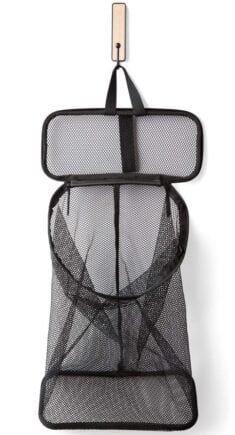
Hanging Laundry Bag
Trust us, this is an absolute game changer. Super compact, a hanging mesh laundry bag stops your dirty clothes from stinking, you don’t know how much you need one of these… so just get it, thank us later.
Okay, so you know that Honduras has its lion’s share of security and safety issues. So, is Honduras safe ? Remember – this ain’t Switzerland. The streets in Honduras are rough and the last thing you want to do is put yourself in a position where harm could come your way.
Again, Honduras is a safe place for backpackers to travel. The violence and murders running rampant throughout the country for decades are gang, drug, and power-related. This should not involve you in any way, shape, or form unless you get very unlucky or put yourself in a bad situation through a series of poor choices.
Always keep a close eye on your stuff. Never take your eyes off of your backpack or daypack. Try to limit the amount of cash you carry at any one time.
Never dress fancy or rock any expensive shit like fancy jewelry, high-end watches, earrings, etc. Basically, don’t draw unnecessary attention your way.
Being white or obviously looking foreign will automatically draw curious eyes your way. Curiosity is one thing. Curiosity is normal human behavior. People eyeing your $3000 Sony camera like a dog watching a cooking steak is another thing and should be cause for concern.
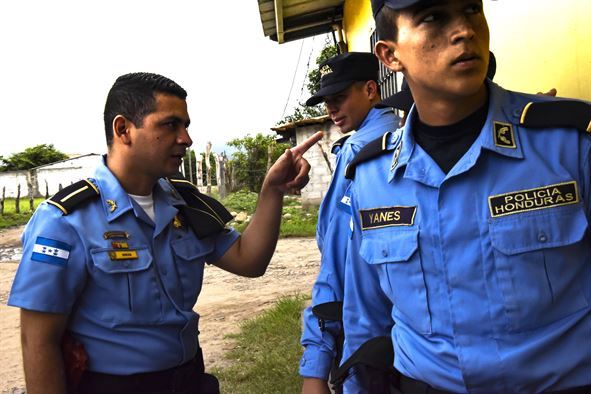
The point being, stash your valuables and watch your gear like a hawk watches its chicks, especially in the big cities.
Look like the dirty backpacker that you are. Look like you have nothing worth a damn to steal. Again, a vast majority of Honduran people are honest, hard-working, light-hearted human beings who will do you no harm whatsoever. You get what I am saying though.
I did not take any anti-malaria pills whilst backpacking Honduras, but that doesn’t mean you shouldn’t have them.
Check out our Backpacker Safety 101 for tips and tricks to stay safe wherever the heck you are in the world.
Sex, Drugs and Rock ‘n’ Roll in Honduras
Honduras is full of opportunities to get down. Utila is ground zero for all things party related. Booze, weed, ecstasy, cocaine are abundant. The cocaine is a little more under the radar (as it should be), though it’s around if you want it.
Anywhere other than the Bay Islands I would not try to buy drugs of any kind.
Keep in mind that the blow you are putting up your nose is the cause of much of the terror, murder, and general chaos carried out by rival drug gangs in Honduras.
Ethical cocaine simply does not exist. In short, Honduras is fucked up largely due to cocaine and other drug trafficking, which is directly linked to the foreign desire for the product. Something to ponder anyway.
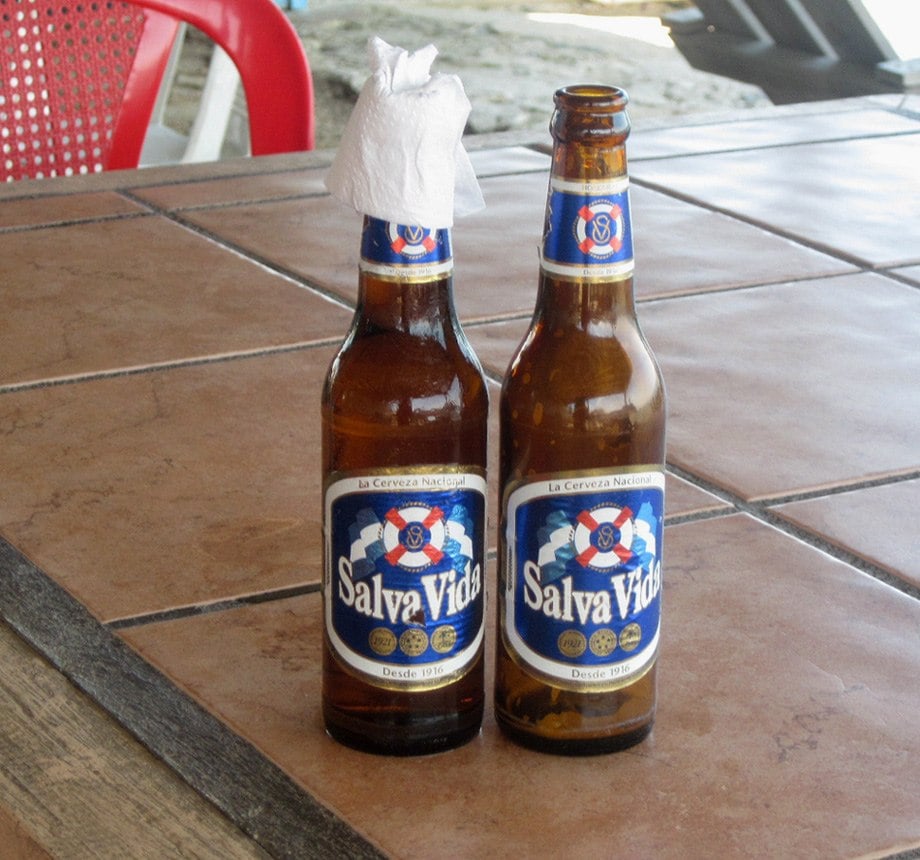
All over Honduras, you can find cheap beer. Sugar Cane liquor is also dirt cheap and probably strong enough to run a motorbike to Guatemala City and back.
Prostitution in Honduras is rampant. As I said before, I have met kids who were forced into the industry. Most of the people who are sex workers (I assume) in Honduras are only doing sex work for lack of anything else to do for work (or they simply don’t have a choice in the matter).
On top of all of that heaviness, AIDS and other STD’s are also an ever-present threat poised by hiring sex workers.
I would seriously think twice (maybe five times) before hiring a sex worker in Honduras. Both from a human/ethical point of view and a health/safety perspective; sex tourism in Honduras is not a positive thing no matter how you look at it.
Travel Insurance for Honduras
Traveling without insurance would be risky so do consider getting good backpacker insurance sorted before you head off on an adventure.
When looking for insurance, make sure the company you go with covers adventure sports like scuba diving and trekking.
ALWAYS sort out your backpacker insurance before your trip. There’s plenty to choose from in that department, but a good place to start is Safety Wing .
They offer month-to-month payments, no lock-in contracts, and require absolutely no itineraries: that’s the exact kind of insurance long-term travellers and digital nomads need.

SafetyWing is cheap, easy, and admin-free: just sign up lickety-split so you can get back to it!
Click the button below to learn more about SafetyWing’s setup or read our insider review for the full tasty scoop.
The two main international airports in Honduras are located in San Pedro Sula and Tegucigalpa. More travelers are now flying into San Pedro Sula as it provides a better jump off point to the coast as well as other major backpacker destinations within Honduras.
It is also possible to fly to La Ceiba and Roatan in the Bay Islands, but the flights are far from cheap.
It is possible to take an overland bus to a big city in Honduras from any of the surrounding countries capital cities, though these journeys are often arduous (I have done it twice).
Entry Requirements for Honduras
Citizens of the US, the UK, Western Europe, Australia, Canada, etc do NOT need to apply for visas in advance. Actually, Honduras has some of the least restrictive border policies I have ever heard of.
Whether traveling to Honduras by land or plane, you’ll get your stamp on arrival at customs. A tourist visa on arrival is valid for 90 days.
Note: The government of Honduras requires proof of yellow fever vaccination only if a traveler is arriving from a country with risk of yellow fever, which is important to know if you are coming from Colombia or Venezuela.

Get 15% OFF when you book through our link — and support the site you love so dearly 😉
Booking.com is quickly becoming our go-to for accommodation. From cheap hostels to stylish homestays and nice hotels, they’ve got it all!
Traveling By Bus and Private Car in Honduras
The cheapest way to travel in Honduras is by chicken bus. Chicken buses are not nearly as cheap as they should be! Skyrocketing fuel prices in Honduras have created a surge in transportation prices. Still, chicken buses are the cheapest option.
The more comfortable, faster, and much more expensive option is to book a shuttle or to hire a private driver. Shuttles only operate from big cities to popular tourist hotspots like Copan and La Ceiba (to get to the islands).
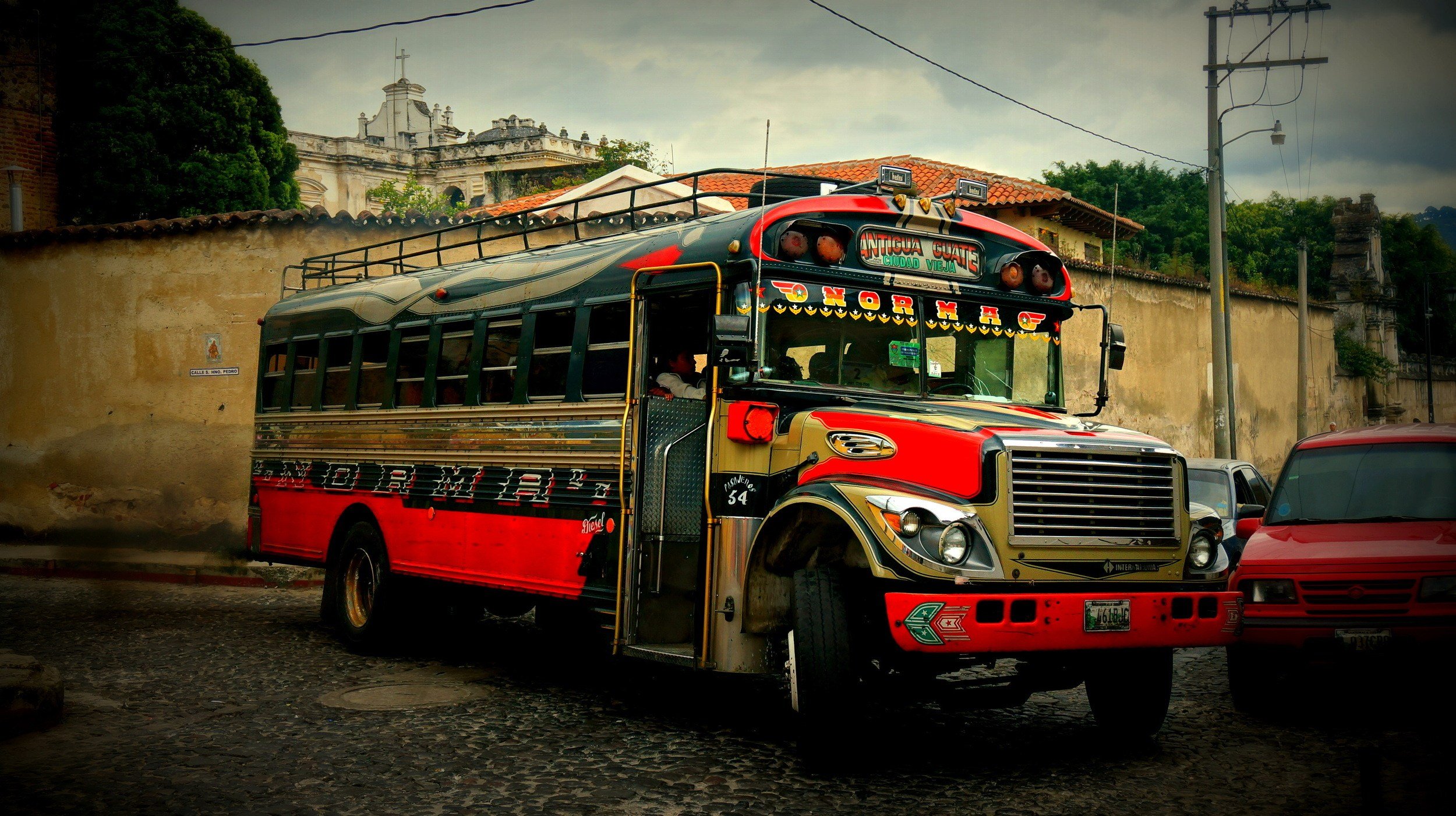
Honduras is still figuring out how the hell to get backpackers around the country.
If you are only planning to visit a handful of spots, shuttle travel may be the best way to go from a convience point of view.
Hitchhiking in Honduras
I did not hitchhike in Honduras, nor did I meet anyone who did. I’d say for very short distances out in the countryside or around some of the national parks, you shouldn’t have any trouble, but I admit I don’t know that for sure.
Use your instincts. If somebody or a place gives you bad vibes, stop hitching and take the bus.
Onward Travel from Honduras
Getting in and out of Honduras is relatively easy since there are many long-distance bus operators. What is easy may not always be fun though. The distances can be quite tedious as the long-distance buses never travel fast, stop often, and are prone to breaking down.
I took a 12-passenger shuttle bus from La Ceiba to Leon, Nicaragua. The journey took 16 hours non-stop and was one of the most uncomfortable rides of my life. Plus it was something like $80 USD!!
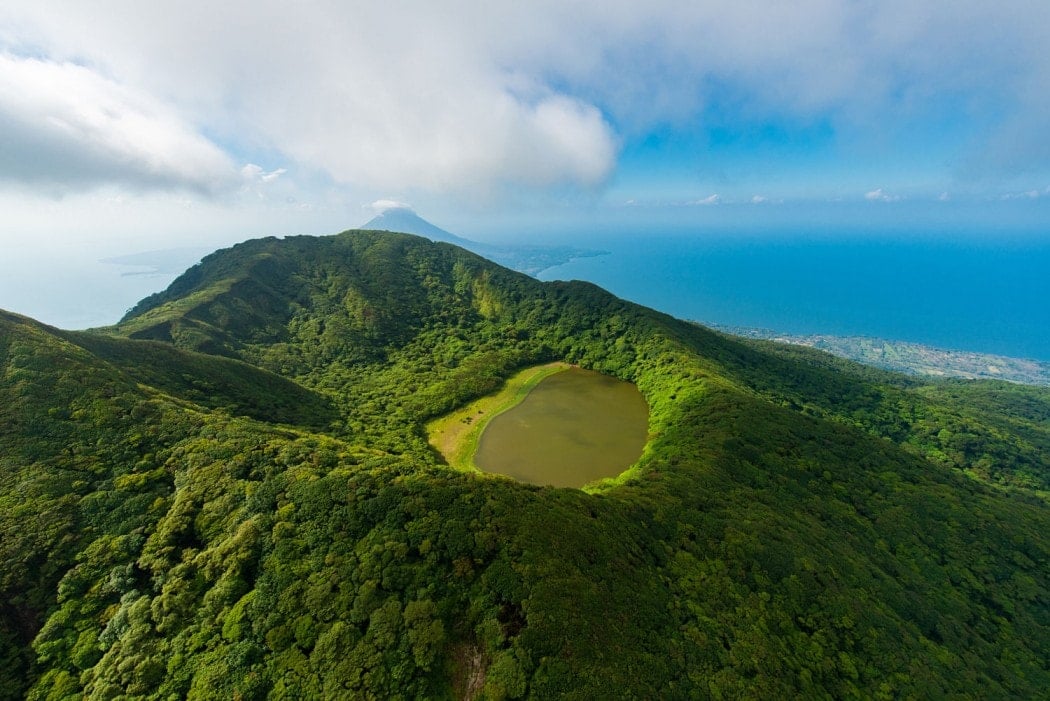
I thought my partner at the time was going to totally freak out; she couldn’t take it anymore. I also thought the driver was going to fall asleep at the wheel for sure, but at 2 am, we made it!
You can also cross overland to Guatemala or El Salvador! Check out our guide on Backpacking Central America if you are planning a long trip across multiple countries.
Flying is always the most comfortable option, though the prices are so high it can be hard to justify it. Do some flight research; you never know when you will find a good deal.
Picking up a little work in Honduras is a bit complicated. All of the young foreigners I met “living” in Honduras who were working in some capacity were doing so on a tourist visa (so in other words, illegally).
There are some opportunities to be had here though – pretty much exclusively on the Bay Islands. Some people come to Honduras to get their scuba certification, fall in love with scuba diving (or their instructor), and then end up staying to get their instructor certification – with the hopes of eventually finding a paid gig leading scuba dives for clients.
The Bay Islands are awash with foreign scuba instructors, but there is always a chance one of the operators will hire you after you do your full instructor course with them. The pay won’t be great, but you will probably make enough to cover some of your accommodation and food while living the scuba dream.
There are also work-exchange opportunities in some of the ex-pat bars on Utila as well.
Digital nomads will find the Bay Islands to be a great base for a little while (if you can find a good internet connection).

A new country, a new contract, a new piece of plastic – booooring. Instead, buy an eSIM!
An eSIM works just like an app: you buy it, you download it, and BOOM! You’re connected the minute you land. It’s that easy.
Is your phone eSIM ready? Read about how e-Sims work or click below to see one of the top eSIM providers on the market and ditch the plastic .
Internet in Honduras
Internet in Honduras is pretty hit or miss. I found the WiFi to be pretty slow on Utila and in other parts of the country, though I imagine going into 2021 the situation will be better than when I was there. If you have recent experience with the internet on Utila, let us know in the comments!
To be frank, I wasn’t using the internet much in Honduras. Since my phone was stolen in a knife-attack robbery in Guatemala, I did not have any device with me to regularly check-in online. It was fantastic.
In rural areas, don’t expect there to be much internet of any quality. You will find the best wifi in the whole country in the two big cities, San Pedro Sula and Tegucigalpa.
Teaching English in Honduras
Finding paid English teaching gigs in Honduras are not unheard of – but one needs to have realistic expectations. If you end up teaching in a school, the wages will be modest and you might not make enough to properly live on. This will need to be a passion project endeavor – though I imagine the experience would be truly special.
You will need some qualifications however.
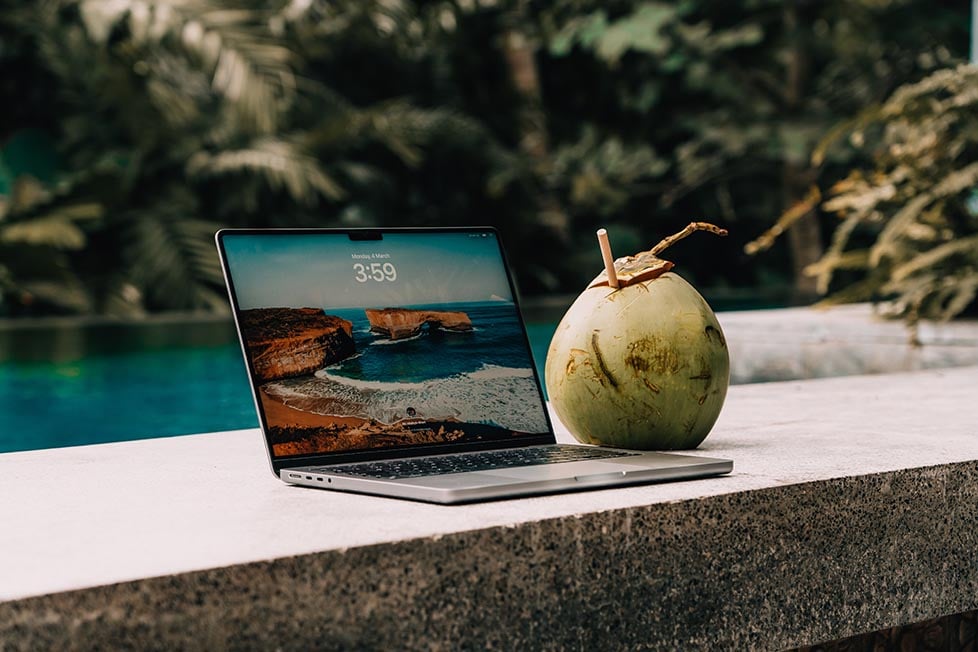
In addition to giving you the qualifications to teach English online, TEFL courses open up a huge range of opportunities and you can find teaching work all over the world. To find out more about TEFL courses and how you can teach English around the world, read my in-depth report on teaching English abroad .
Broke Backpacker readers get a 50% discount on TEFL courses with MyTEFL (simply enter the code PACK50), to find out more, please read my in-depth report on teaching English abroad.
Volunteer in Honduras
My first ever major international travel trip on my own was when I was 16 – and I went to Honduras. I ended up volunteering in an orphanage outside of San Pedro Sula for a few weeks. The experience was sobering to say the least – but I made some genuine connections with some of the boys living there and I felt like a made a difference with my work. Plus we played a TON of football every day.
Volunteering abroad is an amazing way to experience a culture whilst helping your host community. There are plenty of different volunteer projects in Honduras including teaching, construction, agriculture and pretty much anything.
Honduras is one of the least developed countries in Central America so there is a high demand for volunteers. English teaching and social work are areas where you can make a huge difference to local communities. Other opportunities include hospitality, conservation, and web development. You don’t need a visa to volunteer in Honduras for less than 90 days, but longer stays may have specific requirements depending on the work you’re doing.
If you want to find volunteering opportunities in Honduras, then we recommend that you Signup for Worldpackers – a volunteer platform that connects local hosts directly with traveling volunteers. As a Broke Backpacker reader, you’ll also get a special discount of $10 when you sign up. Just use the discount code BROKEBACKPACKER and your membership is discounted from $49 a year to only $39.
Volunteer programs run through reputable work exchange programs like Worldpackers are usually very well-managed and reputable. However, whenever you are volunteering, do stay vigilant especially when working with animals or children.

Worldpackers: connecting travellers with meaningful travel experiences.
Hondurans know how to make tasty food! Here are some of my favorite Honduran traditional foods to try:
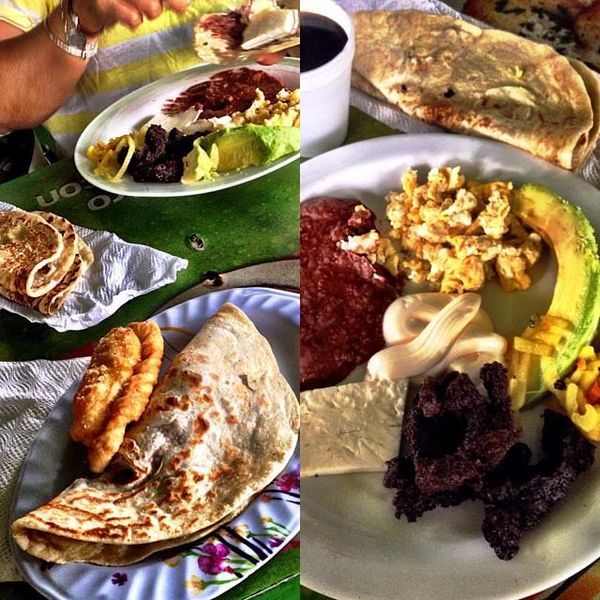
Baleadas : The perfect eat anytime snack or meal. Baleadas are fucking delicious creations that are basically large soft tacos filled with avocado, meat, egg, and cheese. You should probably eat at least one per day.
Pastelitos de Care : When I first try one of these savory meat pies, it reminded me of something I ate in Tunisia, of all places. It was the raisins! Pastelitos contain the perfect balance of meat, wine, raisins, onions and spices to keep your mouth watering for more.
Pupusas : Now people from El Salvador will argue that the Pupusa comes from their country, and Hondurans vice versa. I say who the hell cares? Let’s eat pupusas!
Tacos : Outside of Mexico, Honduran tacos are my favorite tacos in Central America.
Black Bean Soup : A traditional soup that tastes a bit like American Chili minus the cumin.
Fried or BBQ Fish : When you are on the coast or around Lake Yojoa, eating some variation of fried or BBQ fish is mandatory!
Horchata : A creamy, rice-based beverage spiced with cinnamon and loads of sugar. I love horchata so much that I make a huge batch a few times a year no matter where I am.
Johnny Cakes : When in Utila, Johnny Cakes are a staple in the diet of any dedicated scuba diver. They are basically just biscuits (American biscuits, not British cookies) topped with whatever is on hand. I am an egg-ham-and cheese man myself.
When the opportunity presents itself, I highly recommend you get to know some locals! You have to be able to speak some Spanish to connect with people as English is not commonly spoken in Honduras (outside of the Bay Islands). So study up, gringo (or non-Spanish speaking folks who don’t identify as gringos)!
A majority of the population of Honduras are of mixed Spanish and indigenous origin ( Mestizo ). The rest of the country’s demographic is made up of several main ethnic groups.
These prominent indigenous groups are:
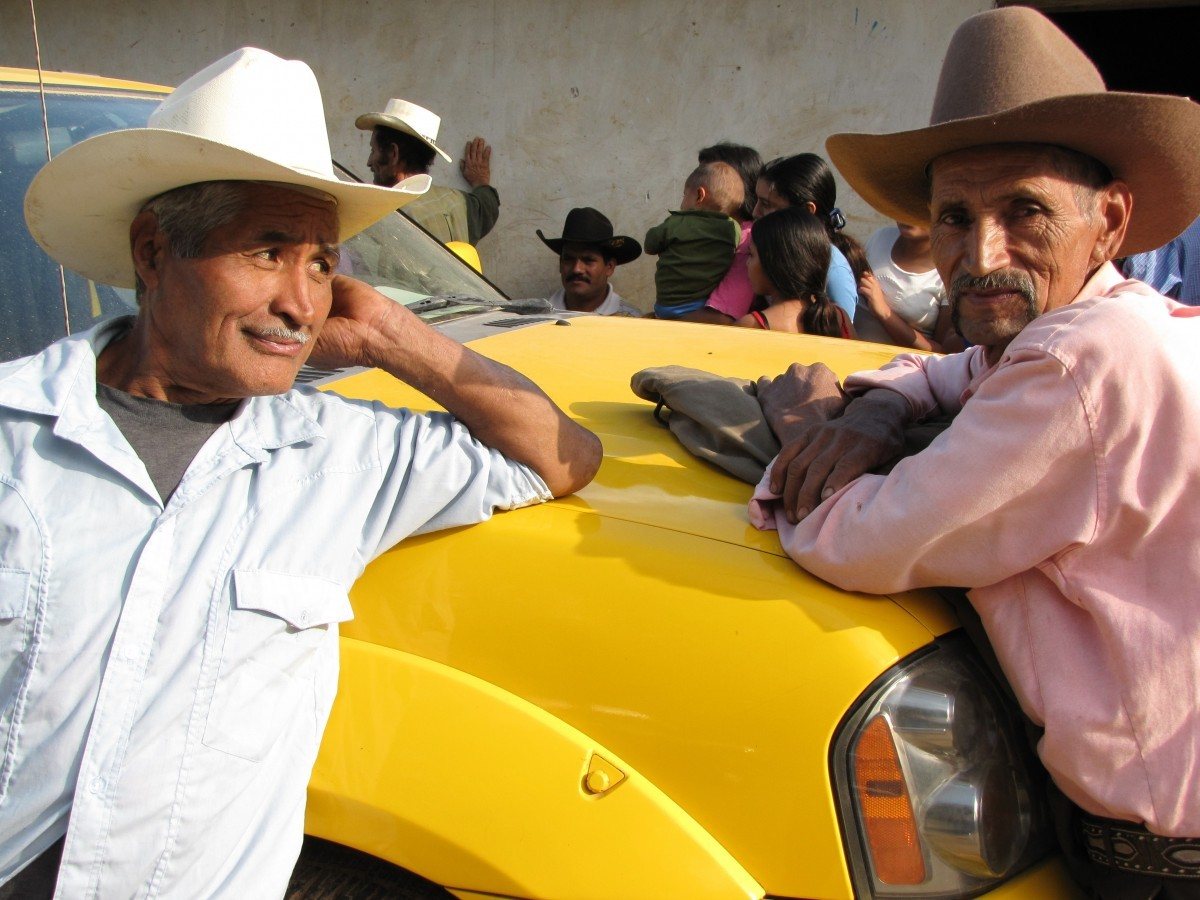
- Ch’orti’: A Mayan group living in the northwest on the border with Guatemala;
- Garifuna: A community originating from Africa and the West Indies speaking a Carib language.
- Pech or Paya Indians: From a small area in the Olancho department;
- Tolupan: Primarily living in the Department of Yoro and in the reserve of the Montaña de la Flor.
- Lenca Indians: A group from the western highlands of Intibuca, Lempira, La Paz, Valle and Choluteca departments.
- Miskito Indians: Northeast coast group in the Gracias A Dios department.
Useful Travel Phrases for Honduras
Learning a bit of Spanish is a great way to get the most out of your trip. When I became fluent in Spanish, it really changed the way I was able to travel around Central America and beyond. It is such a useful language to know! You can speak it in over 20 countries!
Below are some useful Spanish phrases for backpacking Honduras. While most people speak English in the Bay Islands – which was a British colony for a long time by the way – for everywhere else pretty much – knowing a little Spanish will carry you a long way!
Hola = Hello
¿Cómo está(s)? = How are you?
Mucho gusto = Nice to meet you
Estoy bien = I’m fine
Por favor = Please
Gracias = Thank you
De nada/Con gusto = You’re welcome
¿Cuánto? = How much?
Adiós = Goodbye
Sin bolsa de plastico = No plastic bag
No paja por favor = No straw please
No hay cubiertos de plástico por favor = No plastic cutlery please
Lo siento = I’m sorry
¿Dónde está el baño? = Where is the bathroom?
¿Qué es esto? = What’s this?
Quiero un taco/una cerveza . = I want a taco/a beer.
¡Salud! = Cheers!
Books to Read when Backpacking in Honduras
Here are some of my favorite books set in Honduras:
- Lost City of the Monkey God — In 2012, author Douglas Preston joined a team of explorers searching for Ciudad Blanca (“The White City”), a legendary ruin hidden in the dense jungle of eastern Honduras. This book reveals the socio-political consequences that such a discovery brought upon a country like Honduras.
- Enrique’s Journey — “An astonishing story that puts a human face on the ongoing debate about immigration reform in the United States.” Powerful and important to understanding the current situation in Honduras.
- Madness is Better Than Defeat — “Shot through with intrigue, ingenuity, and adventure, and showcasing Beauman’s riotous humor, spectacular imagination, and riveting prose, Madness Is Better Than Defeat is a novel without parallel: inventive, anarchic, and delightfully insane.”
- Reinterpreting the Banana Republic — A sobering new analysis of Honduran social and political development over the last century.
- Lonely Planet Honduras — For all of the stuff not covered by me here in this guide.
A Brief History of Honduras
From the great Mayan civilization to colonization, pirates, rum runners, slaves, and years of political unrest, Honduras’ past is as complicated as its present moment. Let’s take a look at some of the major events that shaped Honduras.
1502: Honduras was first “discovered” by Europeans when Christopher Columbus arrived at the Bay Islands on July 30th 1502 on his fourth voyage to this part of the world. On the 14 of August 1502, Columbus landed on the mainland near modern Trujillo.
Columbus named the country Honduras (meaning “depths”) for the deep waters off its coast.
1536: During the period leading up to the conquest of Honduras by Pedro de Alvarado, many indigenous people along the north coast of Honduras were captured and taken as slaves to work on Spain’s Caribbean plantations, mostly sugar cane fields. It wasn’t until Alvarado defeated the indigenous resistance headed by Çocamba near Ticamaya that the Spanish began to conquer the country in 1536.
Fast forward a few centuries.
1821: Honduras declared independence from Spain.
1920 -1923: Seventeen uprisings or attempted coups in Honduras contributed to the United States’ growing concern over political instability in Central America.
1932-49 – Honduras is now under right-wing National Party of Honduras (PNH) dictatorship led by General Tiburcio Carias Andino.
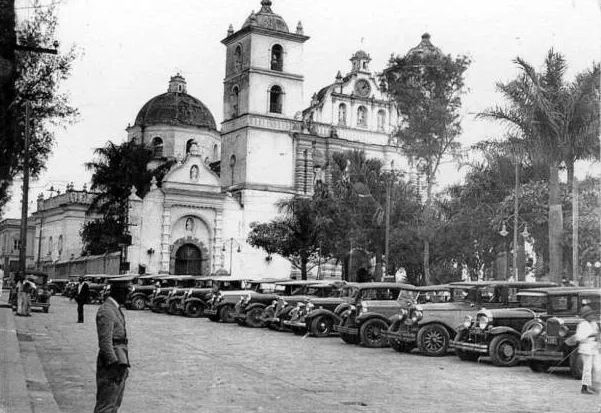
Late 20th Century Honduras
1969 – Brief but costly war with El Salvador over heavy immigration and disputed border.
1981 – Roberto Suazo Cordova of the centrist Liberal Party of Honduras (PLH) is elected president, leading the first civilian government in more than a century.
But armed forces chief General Gustavo Alvarez retains considerable power and Honduras becomes embroiled in various regional conflicts. US-run camps for training Salvadorans in counterinsurgency are set up on Honduran territory.
1982 – US-backed Nicaraguan counter-revolutionaries, or Contras, launch operations to bring down Nicaragua’s Sandinista government from Honduran territory.
1982-83 – General Alvarez responds to increasing political unrest by ordering the detention of trade union activists and left-wing sympathizers. Death squads are allegedly used to eliminate subversive elements.
2002 January – Honduras re-establishes diplomatic ties with Cuba which it severed in 1961 when Cuba was expelled from Organisation of American States.
2012 May – Thousands march to protest the wave of violence against journalists – more than 20 of whom have been killed in the past three years.
Backpacking Honduras is so special because it is an off the beaten path country in a complicated part of the world. Getting to know what makes Honduras tick is half the fun of backpacking here.
The people in Honduras have seen hard times in recent years, but there is a certain determination in their spirt and a deep desire to make their country drive once more.
Backpackers who get to know Honduras fall in love with the country’s food, people, islands, mountains, and jungles. In Honduras, the good times just keep rollin’.

Things go wrong on the road ALL THE TIME. Be prepared for what life throws at you.
Buy an AMK Travel Medical Kit before you head out on your next adventure – don’t be daft!
Trekking in Honduras
Trekking in Honduras has the potential to have a fully developed industry, but as of now, most backpackers are limited to day hikes rather than full-on multi-day trekking.
Depending on your motivation and keenness to get out and explore, there are plenty of hiking opportunities in Honduras if you know where to look. Let’s take a look at some of the best treks/hikes in Honduras…
Cusuco National Park: Located near the legendary Mayan city of Copan, Cusuco National Park is a great place to discover some of Honduras’ amazing wildlife. Waterfalls, impressive flora, and the Taulabe Caves all make Cusuco an accessible hiking destination in Honduras.
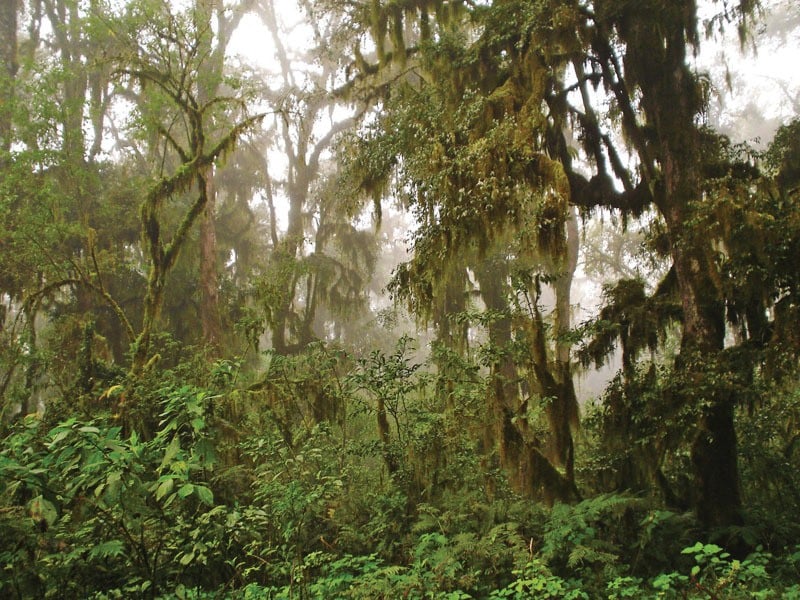
Montaña de Celaque National Park: Here you can tackle Honduras’ tallest mountain: Cerro Las Minas. Once you start to climb into the cloud forest’s altitude, the weather cools and you begin to feel a freshness that you haven’t felt since you entered Honduras. Camping within the park is possible and in fact, there are even campgrounds! Campamento Don Tomas, El Naranjo, and El Quetzal are the three main campsites found along the hike to/from Cerro Las Minas. Hiring a guide isn’t really necessary as the trail is well marked once you find it.
Pico La Picucha in Olancho: Another stunning area of the cloud forest variety. Be prepared for the weather though as it rains here more than it doesn’t. Also, you are almost guaranteed to not see any other hikers, so enjoy this slice of Honduran heaven.
Hikes around Las Marias/Rio Platano: There are a number of treks I have heard about in the Rio Platano Biosphere Reserve. I did not personally tackle these treks, but I hear good things. It is possible to arrange 2-4 day treks here—which I’m sure would be very impressive as the whole rest of the Rio Platano is bloody gorgeous.
Scuba Diving in Honduras
The Bay Islands are sitting on top of the 2nd largest great barrier reef in the world: The Great Mesoamerican Reef.
As you now know, I am a big fan of the scuba diving scene in Utila. In fact, I think if you asked backpackers why they chose to come to Honduras, most would tell you that diving is the main reason. Cheap beer, affordable diving, island living… what the hell is not to like?
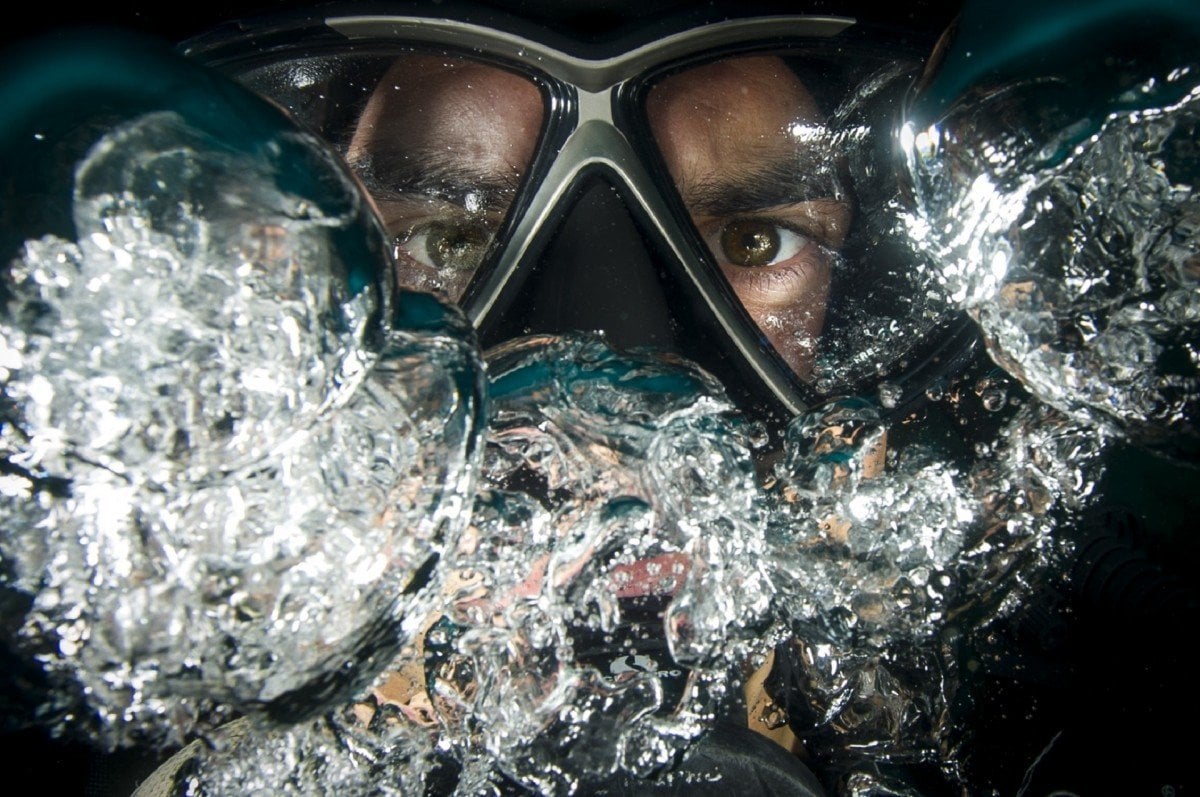
Whether you have five days or five months, the scuba diving in Honduras and the associated backpacker community that has swelled around the sport has certainly formed Honduras into a world-class diving destination… and a bit of scuba diving is not to be missed!
In Utila, the dive/backpacker scene is easily half the draw of the place, but for a more diving focused trip, there are essentially endless options to be found off the coast of all of the Bay Islands. That is if you have the money to hire a boat to take you out.
With boat transport, you can reach some truly untouched, spectacular dive sites in the more remote parts of the Bay Islands. Buena Suerte!
Surfing in Honduras
The Honduras coast and its geography do not make for good waves. There isn’t really any consistent quality surf breaks here. Head to Nicaragua or Costa Rica and you will find all the surf you need.
Stick to diving in Honduras!
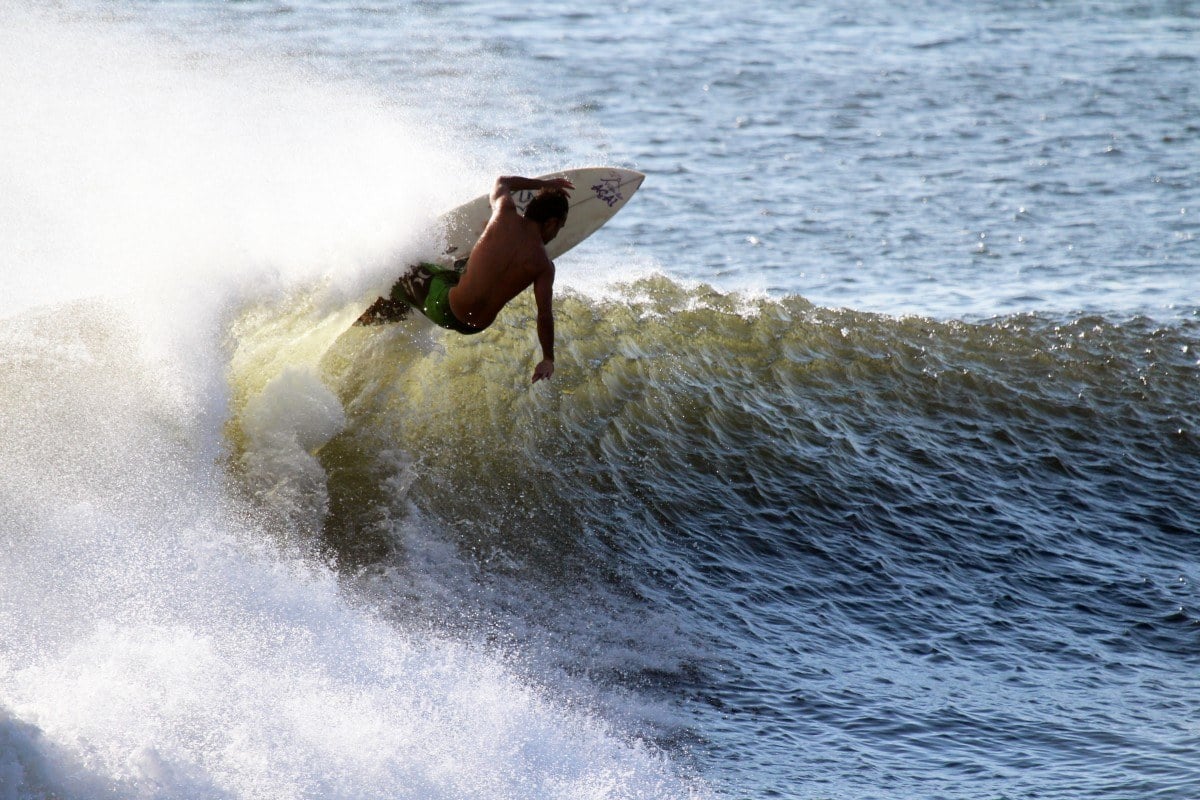
In Honduras and especially the Bay Islands, there is no shortage of occasions or opportunities in which to get down. I am all for people having a good time and letting loose. That said, don’t drink so much that you embarrass yourself, your country, and everyone within 100 feet of you.
I am far from innocent. There have been many times during my travels where I let myself and the situation get out of hand. It’s easy to do! With all the booze around in Honduras, it doesn’t take much before you do something that you will later regret. Ah, the hangovers while scuba diving.
Go to Honduras and have the time of your life, do the things you’ve dreamed of, but be respectful along the way. Traveling the world makes you an ambassador for your country, which is awesome.
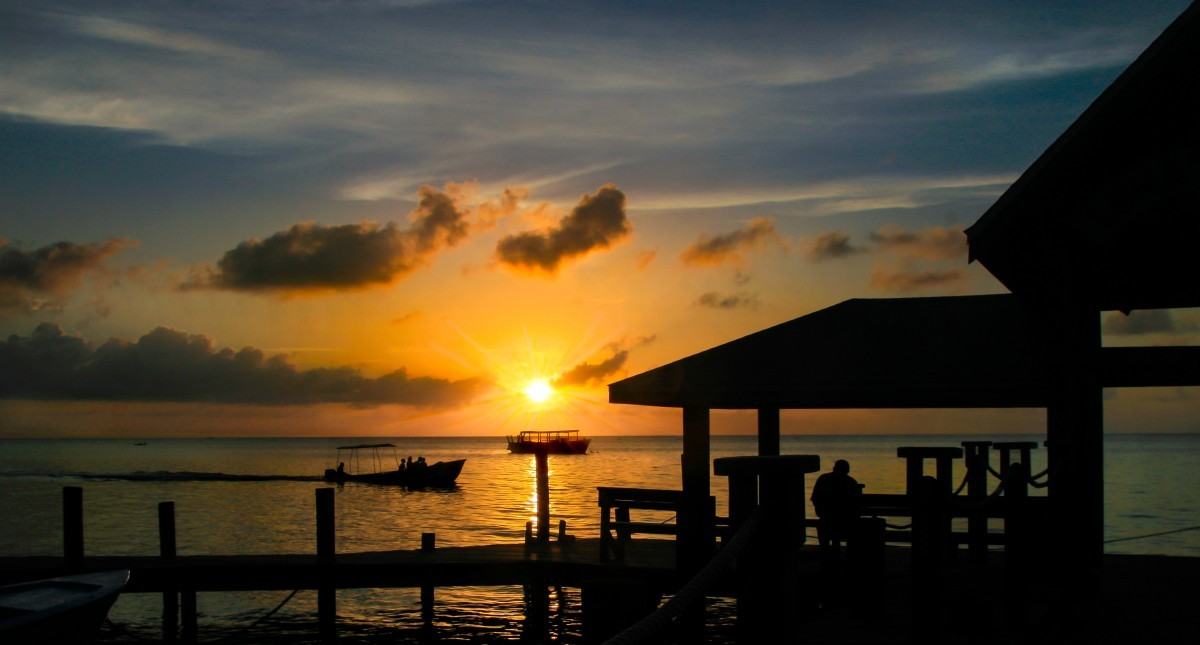
Try to limit or eliminate your consumption of plastic and single-use containers as much as possible. When I was traveling around Central America, I simply bought a cheap bowl, carried it with me, and would just have street vendors fill it.
We can have a positive impact on people when we travel and get rid of ugly stereotypes that may be associated with our countries… Climbing on ancient Mayan temple walls, monuments, or other historical artifacts should be avoided. Duh! Learn to appreciate the cultural treasures of Honduras and don’t be that asshole who adds to their demise.
Happy travels amigos…

Aiden Freeborn
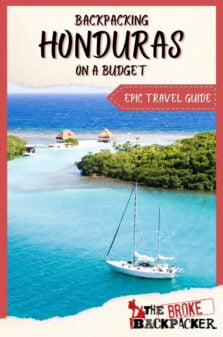
Share or save this post

Hola! Thank you for that impressive overview! Currently I’m in Antigua and want to visit Livingston and then travel directly from there with a boat (catameran) to Utila! Unfortunately I can’t find any further information on how to do that… Can you describe in a little more detail how you did that?
Many thanks in advance! Andreas
Hey…here to plan my trip to Honduras but I keep having a question … as im flying from Costa Rica and the plan is backpacking Honduras and keep going to Guate without any rush and no flight back …. would I have any problems with migration? is someone asking to prove somehow how and when ill be leaving the country???
thanks in advance!
This can certainly happen, make sure first and foremost you understand the entry requirements for the countries you plan to visit, some countries require you have a onward ticket before you arrive. You can be prevented from boarding by your airline at the point of departure in some cases, if you don’t have this. On the other hand you may not be asked at all, as sometimes it comes down to the individual officer you at immigration.
Very well done – I first came to Honduras [Utila] in 1994.
I am a Canadian doing volunteer work in Honduras with an NGO called CAMO in Santa Rosa de Copan.
I really need to know about this kind of backpacking. Thanks
Honduras is trending now as one of the bests countries in the world to travel. If you have the chance you shoudl check it out.
An outstanding presentation on your Site.
This is a considerable post – So clear and easy to follow on the subject of.. Great insights.
Leave a Reply Cancel reply
Your email address will not be published. Required fields are marked *
Save my name, email, and website in this browser for the next time I comment.
Notify me of followup comments via e-mail.
Security Alert May 17, 2024
Worldwide caution, update may 10, 2024, information for u.s. citizens in the middle east.
- Travel Advisories |
- Contact Us |
- MyTravelGov |
Find U.S. Embassies & Consulates
Travel.state.gov, congressional liaison, special issuance agency, u.s. passports, international travel, intercountry adoption, international parental child abduction, records and authentications, popular links, travel advisories, mytravelgov, stay connected, legal resources, legal information, info for u.s. law enforcement, replace or certify documents.
Share this page:
Honduras Travel Advisory
Travel advisory july 17, 2023, honduras - level 3: reconsider travel.
Reissued with obsolete COVID-19 page links removed.
Reconsider travel to Honduras due to crime and kidnapping . Some areas have increased risk. Read the entire Travel Advisory.
Do not travel to:
- Gracias a Dios Department due to crime .
Country Summary : Violent crime, such as homicide, armed robbery, and kidnapping, is common. Violent gang activity, such as extortion, violent street crime, rape, and narcotics and human trafficking, is widespread. Local police and emergency services lack sufficient resources to respond effectively to serious crime.
Read the country information page for additional information on travel to Honduras.
If you decide to travel to Honduras:
- Avoid demonstrations.
- Be aware of your surroundings.
- Avoid walking or driving at night.
- Do not physically resist any robbery attempt.
- Be extra vigilant when visiting banks or ATMs.
- Do not display signs of wealth, such as wearing expensive watches or jewelry.
- Exercise caution using cell phones in public, including inside of cars while stopped in traffic.
- Visit our website for Travel to High-Risk Areas .
- Enroll in the Smart Traveler Enrollment Program (STEP) to receive Alerts and make it easier to locate you in an emergency.
- Follow the Department of State on Facebook and Twitter .
- Review the Country Security Report for Honduras.
- Prepare a contingency plan for emergency situations. Review the Traveler’s Checklist .
- Visit the CDC page for the latest Travel Health Information related to your travel.
Gracias a Dios Department – Level 4: Do Not Travel
Gracias a Dios is an isolated area with high levels of criminal activity and drug trafficking. Infrastructure is weak, government services are limited, and police and military presence is scarce.
- The U.S. government has limited ability to provide emergency services to U.S. citizens in Gracias a Dios as U.S. government employees are restricted from traveling to the area.
Visit our website for Travel to High-Risk Areas
Travel Advisory Levels
Assistance for u.s. citizens, honduras map, search for travel advisories, external link.
You are about to leave travel.state.gov for an external website that is not maintained by the U.S. Department of State.
Links to external websites are provided as a convenience and should not be construed as an endorsement by the U.S. Department of State of the views or products contained therein. If you wish to remain on travel.state.gov, click the "cancel" message.
You are about to visit:
- Skip to main content
- Skip to "About this site"
Language selection
Search travel.gc.ca.
Help us to improve our website. Take our survey !
COVID-19: travel health notice for all travellers
Honduras travel advice
Latest updates: Editorial change
Last updated: June 4, 2024 08:03 ET
On this page
Safety and security, entry and exit requirements, laws and culture, natural disasters and climate, honduras - exercise a high degree of caution.
Exercise a high degree of caution in Honduras due to crime.
Regional advisory - Avoid non-essential travel
- within 20 km of the border with Guatemala, excluding:
- Copán Ruinas
- El Florido border crossing
- CA-11 Highway to El Florido border crossing
- within 20 km of the border with El Salvador, excluding :
- CA-1 Highway to the El Amatillo border crossing
- CA-4 Highway to the El Poy border crossing
- RN-112 Highway between Palmerola airport and the municipality of El Amatillo
- in the departments of:
- Choluteca: the city of Choluteca
- Colón, excluding the city of Trujillo
- Cortés:
- the eastern neighbourhoods of San Pedro Sula:
- Chamalecón
- Cofradía
- Rivera Hernandez
- the city of Choloma
- the neighbourhood of El Planeta in the city of La Lima
- Francisco Morazán: the city of Comayagüela, excluding the Toncontin airport and the major roads leading there
- Gracias a Dios
Back to top
Borders areas
Border areas often see higher criminal activity and violence.
If you’re travelling by land to neighbouring countries:
- use official border crossings only
- consider crossing borders in the morning as they sometimes close unexpectedly early
- avoid anyone suggesting that they can obtain your documents quicker or cheaper on your behalf
- keep the receipt of payment of the border fee until you leave the country
Criminal groups are especially active on the coast between the Guatemalan border and Puerto Cortés. Criminal activities include:
- drug trafficking
- human trafficking
There has also been an increased number of migrants leaving Honduras through Guatemala, particularly at the border crossing in Agua Caliente. This movement results in periodic closures.
The El Florido border crossing in the town of Copán is also closed daily from 9 pm to 6 am.
There has also been an increased number of migrants leaving Nicaragua through Honduras, particularly at the border crossings in Las Manos and Trojes.
Expect possible delays at borders.
Department of Cortés
Street gangs and criminal groups are very active in the Cortés municipalities of:
- San Pedro Sula
The number of murder and violent crime is higher in these areas.
Departments of Colón, Gracias a Dios, Olancho and Yoro
Drugs smuggling and violence pose security threats in the northern departments of:
- Colón
Roadblocks and violent incidents related to land disputes in Colón, mostly in the Aguán valley and in the north coast area near Trujillo, have occurred.
The department of Gracias a Dios is a remote area where law enforcement and access to government services are very limited. Levels of criminal activity are high.
Violent crime is high in the coastal city of La Ceiba. This includes murders and armed robberies.
Although tourists are not the primary target of criminals, you could be in the wrong place at the wrong time.
If you consider travelling to La Ceiba:
- use reputable tour operators only
- choose accommodation with good security measures
- avoid outings outside the resort
Bay Islands
The Bay Islands are generally safe. Violent crime is lower, but petty crime sometimes occurs.
Some foreigners have been assaulted on beaches, mainly at night. Home burglaries have also occurred, sometimes in rental accommodations.
While in the Bay Islands:
- avoid Coxen hole, Los Fuertes and Suampo neighbourhoods after dark
- avoid isolated beaches and areas
- stay in well-lit areas
- make sure you lock windows and doors at night and when you are away
If you’re docking in Roatán and getting off the cruise ship, you should consider booking a tour or a sightseeing trip through a reputable company to avoid becoming the victim of a scam.
Violent crime
Although the overall situation has slightly improved since 2022, violent crime remains a concern throughout Honduras. The country retains one of the highest homicide rates in the world.
Drug trafficking, transnational organized crime and street gang activity is prevalent in certain neighbourhoods. Violent incidents are frequent, including:
- armed robberies
- kidnappings
- home invasions
- sexual assaults
These crimes are carried out by criminals acting individually or as a group.
Many Hondurans are armed. Guns and other weapons, such as machetes and knives, are frequently used. Incidents of armed robbery occur mainly on urban streets during the day and on intercity buses at night.
The Government of Honduras lacks sufficient resources to properly respond to, investigate and prosecute cases. Infiltration within the security forces by local gangs weaken law enforcement even further. Criminals linked to organized crime often operate with a high degree of impunity throughout Honduras.
- Remain aware of your surroundings at all times
- Maintain your cellphone charged
- Avoid travelling after dark
- Avoid walking alone
- Keep a low profile
- Avoid carrying large amounts of cash
- don’t resist if you’re threatened, hand over your cash and valuables immediately
Petty crime
Petty crime, such as pickpocketing and bag snatching, occurs. Thefts commonly occur in:
- popular tourist areas
- bus terminals and airports
- shopping malls and hotel lobbies
- restaurants, including patios
To avoid becoming a victim:
- be suspicious of recent acquaintances or strangers approaching you
- avoid accepting rides or invitations from strangers
- avoid hitchhiking
- ensure that your belongings, including your passport and other travel documents, are secured at all times
- avoid carrying large amounts of cash
- avoid showing signs of affluence
State of emergency
Local authorities periodically declare a state of emergency in various municipalities to fight against gang-related crime and extortion.
While a state of emergency is in effect, security forces have increased rights to conduct searches, seizures and detain persons of interest.
If you are travelling in an area where a state of emergency is in effect:
- be aware that you may be subject to searches by security forces
- always cooperate with military and police officers
- carry valid ID at all times and be prepared for various checkpoints
- allow extra time to reach your destination
- follow the instructions of local authorities
- monitor local news to stay informed on the current situation
Express kidnappings
Express kidnappings can occur in urban areas.
These kidnappings are often committed by organised gangs or taxi drivers. The kidnappers usually take their victims to an ATM and force them to make a cash withdrawal.
- Avoid hailing taxis on the street
- If you’re threatened, don’t resist
Demonstrations and civil unrest
Demonstrations take place regularly. In Tegucigalpa, demonstrations may occur:
- at the National Congress and Central Park
- at the National Autonomous University of Honduras
- at the United States Embassy
- at the Centro Civico
- at the Presidential Palace
- at the Hospital Escuela
- on Suyapa and Centroamerica boulevards
- on La Paz and Los Próceres avenues
- along the Peripheral Ring Road
In San Pedro Sula, protesters usually gather at the Monumento a la Madre.
Even peaceful demonstrations can turn violent at any time. They can lead to disruptions to traffic and public transportation.
- Avoid areas where demonstrations and large gatherings are taking place
- Follow the instructions of local authorities
- Monitor local media for information on ongoing demonstrations
Honduran law prohibits political activities by foreigners. Participating in demonstrations or activities may result in you being detained or deported.
Mass gatherings (large-scale events)
Credit card and ATM fraud occurs.
Be cautious when using debit or credit cards:
- cover the keypad with one hand when entering your PIN
- pay careful attention when your cards are being handled by others
- avoid using card readers with an irregular or unusual feature
- use ATMs located in well-lit public areas or inside a bank or business
- check for any unauthorized transactions on your account statements
Overseas fraud
Spiked food and drinks
Snacks, beverages, gum and cigarettes may contain drugs that could put you at risk of sexual assault and robbery.
- Be wary of accepting these items from new acquaintances
- Never leave food or drinks unattended or in the care of strangers
Women’s safety
Women travelling alone may be subject to some forms of harassment and verbal abuse.
Advice for women travellers
Water activities
Coastal waters can be dangerous. Riptides are common.
Rescue services may not be consistent with international standards. Not all beaches have lifeguards or warning flags to warn of unsafe conditions.
- Only undertake scuba diving and other water activities with a well-established company
- Don’t swim alone alone or outside marked areas
- Consult residents and tour operators for information on possible hazards and safe swimming areas
- Monitor weather warnings
Water safety abroad
Adventure tourism
Outdoor activities, such as hiking, diving, mountain biking and other adventure activities can be dangerous if unprepared. Trails are not always marked, and weather conditions can change rapidly, even in during summer.
If you intend to practice adventure tourism:
- never do so alone, and do not part with your expedition companions
- obtain detailed information on your activity and on the environment in which you will be before setting out
- buy travel insurance that includes helicopter rescue and medical evacuation
- ensure that your physical condition is good enough to meet the challenges of your activity
- avoid venturing off marked trails
- ensure that you’re adequately equipped and bring sufficient water
- stay informed about weather and other conditions that may pose a hazard
- refrain from using facilities or equipment if you have doubts on their safety
- inform a family member or friend of your itinerary
Road travel
Road conditions and road safety are poor throughout the country. Accidents causing fatalities are common. The number of traffic accidents involving tourists has also increased.
Road conditions
Many roads are poorly delineated due to regular flooding. Driving can be dangerous due to:
- roaming livestock and wildlife
- poorly maintained roads and bridges
- unpaved roads
- inadequate lighting
- lack of signage
- lack of guardrails
- winding mountain roads
- overloaded or poorly maintained vehicles
- slow-moving or heavy traffic, especially in San Pedro Sula and Tegucigalpa
If you’re travelling by land, use caution between:
- El Progreso and La Ceiba
- Chamelecón and Copán via Cofradía
- Copán and Gracias Lempira
- Limones to La Unión
Between Tegucigalpa to Trujillo, you should use the RN39 and transit via Gualaco, San Esteban and Bonito Oriental rather than the RN41 via Salamá et Sabá.
Road safety
Drivers don’t respect traffic laws. They often drive at excessive speeds. They may be aggressive and reckless.
If you drive in Honduras:
- always drive defensively
- maintain a heightened awareness along all routes
- plan your trip ahead of time, especially if you plan to visit a rural area
- avoid road travel at night
- keep your car doors locked and the windows closed at all times
- avoid picking up hitchhikers
- carry a cell phone and a charger
- avoid renting cars and motorcycles from operators who don’t provide insurance
- ensure that helmets meet international safety standards
Police officer impersonation
Gang members and criminals sometimes disguise themselves as police officers. At legitimate police checkpoints, you should see:
- a police vehicle
- green cones
- at least five police officers
If you have any doubts, you may contact the Honduran Transit Authority by dialing 911 to confirm the location of the roadblocks and the identity of the individuals stopping you before rolling down your window or opening your door.
Sometimes, thieves also pose as victims of road accidents.
- Don’t stop to help a person at the side of the road
- Report any suspicious incidents at the next police checkpoint
Public transportation
Public transportation in Honduras is unsafe and unreliable.
Most urban public buses are poorly maintained. Drivers are reckless. Accidents are common.
Incidents of armed robbery are frequent on public buses. Incidents of arson have also occurred.
- Avoid intercity public transportation
- Use only companies that offer non-stop service from your place of departure to your destination
Some taxis are an acceptable option for transportation.
When travelling to the airport, you may pre-arrange your pickup with your hotel prior to your departure. Authorized airport taxis drivers wear easily identifiable ID badges.
- Use a reliable taxi company recommended by your hotel
- Don’t use white street taxis
- Never board taxis at taxi stands or flag taxis in the street
- Never use shared taxis
- Make sure the driver doesn’t pick up other passengers along the way to your destination
- Note driver’s name and plate number
- Negotiate the fare in advance
- Make sure you have small bills as taxi drivers often don’t make change
We do not make assessments on the compliance of foreign domestic airlines with international safety standards.
Information about foreign domestic airlines
Every country or territory decides who can enter or exit through its borders. The Government of Canada cannot intervene on your behalf if you do not meet your destination’s entry or exit requirements.
We have obtained the information on this page from the Honduran authorities. It can, however, change at any time.
Verify this information with the Foreign Representatives in Canada .
Entry requirements vary depending on the type of passport you use for travel.
Before you travel, check with your transportation company about passport requirements. Its rules on passport validity may be more stringent than the country’s entry rules.
Regular Canadian passport
Your passport must be valid at least 6 months from the date of entry.
Passport for official travel
Different entry rules may apply.
Official travel
Passport with “X” gender identifier
While the Government of Canada issues passports with an “X” gender identifier, it cannot guarantee your entry or transit through other countries. You might face entry restrictions in countries that do not recognize the “X” gender identifier. Before you leave, check with the closest foreign representative for your destination.
Other travel documents
Different entry rules may apply when travelling with a temporary passport or an emergency travel document. Before you leave, check with the closest foreign representative for your destination.
Useful links
- Foreign Representatives in Canada
- Canadian passports
Tourist visa: not required for stays up to 90 days Business visa: not required for stays up to 90 days Student permit: required
Student permit
If you intend to study in Honduras, you must obtain a student permit which can be obtained from the immigration authorities once you arrive in the country.
National Institute of Migration – Government of Honduras
Customs declaration form
You must complete the Government of Honduras' customs declaration form prior to entering or leaving the country.
After completing the online form, you must present the QR code to the customs authorities, either on paper or electronically.
Customs declaration form – Government of Honduras
Entry stamp
Immigration authorities will stamp your passport upon arrival and write down the number of days you are allowed in the country. The 90-day period is not guaranteed, and the decision is at their discretion.
You may face a fine and possible delays if you fail to present an entry-stamped passport when departing Honduras.
- Make sure your passport has been stamped upon arrival
- Take good note of the maximum length of your approved stay
Central America-4 Border Control Agreement
Under the terms of the Central America-4 Border Control Agreement (CA-4), Canadian tourists may travel freely within any of the following CA-4 countries:
- El Salvador
You can travel between these countries for up to 90 days without having to undergo entry and exit formalities at border immigration checkpoints.
You must still check in at immigration counters when you enter or exit these checkpoints.
The 90-day period begins at the first point of entry to any of the CA-4 countries. You will be fined if you exceed the 90-day limit.
Entering by land
If you plan to enter by land, you need to pay 3 USD or the equivalent in lempiras.
Stay extension
You can apply for extensions of up to 30 days at a time, at the discretion of the immigration authorities. You must request this extension and pay the required fee at the Honduran immigration office before your first 90-day limit expires.
Other entry requirements
Customs officials may ask you to show them:
- a return or onward ticket
- proof that you have sufficient funds for the duration of your stay
- Children and travel
The age of majority in Honduras is 21. The country has strict requirements for the entry and exit of minors.
A minor must show a written and notarized authorization to travel:
- signed by both parents if travelling alone
- signed by the non-travelling parent if travelling with one parent only
The written authorization must be in Spanish and authenticated by the Honduran authorities prior to arrival.
This is also enforced if the minor has a residential or citizenship tie to Honduras inherited from one of the parents, even if the tie has not been legally registered.
Travelling with children
Yellow fever
Learn about potential entry requirements related to yellow fever (vaccines section).
Relevant Travel Health Notices
- Global Measles Notice - 13 March, 2024
- Zika virus: Advice for travellers - 31 August, 2023
- COVID-19 and International Travel - 13 March, 2024
- Dengue: Advice for travellers - 6 May, 2024
This section contains information on possible health risks and restrictions regularly found or ongoing in the destination. Follow this advice to lower your risk of becoming ill while travelling. Not all risks are listed below.
Consult a health care professional or visit a travel health clinic preferably 6 weeks before you travel to get personalized health advice and recommendations.
Routine vaccines
Be sure that your routine vaccinations , as per your province or territory , are up-to-date before travelling, regardless of your destination.
Some of these vaccinations include measles-mumps-rubella (MMR), diphtheria, tetanus, pertussis, polio, varicella (chickenpox), influenza and others.
Pre-travel vaccines and medications
You may be at risk for preventable diseases while travelling in this destination. Talk to a travel health professional about which medications or vaccines may be right for you, based on your destination and itinerary.
There is a risk of hepatitis A in this destination. It is a disease of the liver. People can get hepatitis A if they ingest contaminated food or water, eat foods prepared by an infectious person, or if they have close physical contact (such as oral-anal sex) with an infectious person, although casual contact among people does not spread the virus.
Practise safe food and water precautions and wash your hands often. Vaccination is recommended for all travellers to areas where hepatitis A is present.
Malaria is a serious and sometimes fatal disease that is caused by parasites spread through the bites of mosquitoes. There is a risk of malaria in certain areas and/or during a certain time of year in this destination.
Antimalarial medication may be recommended depending on your itinerary and the time of year you are travelling. Consult a health care professional or visit a travel health clinic before travelling to discuss your options. It is recommended to do this 6 weeks before travel, however, it is still a good idea any time before leaving. Protect yourself from mosquito bites at all times: • Cover your skin and use an approved insect repellent on uncovered skin. • Exclude mosquitoes from your living area with screening and/or closed, well-sealed doors and windows. • Use insecticide-treated bed nets if mosquitoes cannot be excluded from your living area. • Wear permethrin-treated clothing. If you develop symptoms similar to malaria when you are travelling or up to a year after you return home, see a health care professional immediately. Tell them where you have been travelling or living.
Yellow fever is a disease caused by a flavivirus from the bite of an infected mosquito.
Travellers get vaccinated either because it is required to enter a country or because it is recommended for their protection.
- There is no risk of yellow fever in this country.
Country Entry Requirement*
- Proof of vaccination is required if you are coming from or have transited through an airport of a country where yellow fever occurs.
Recommendation
- Vaccination is not recommended.
- Discuss travel plans, activities, and destinations with a health care professional.
- Contact a designated Yellow Fever Vaccination Centre well in advance of your trip to arrange for vaccination.
About Yellow Fever
Yellow Fever Vaccination Centres in Canada * It is important to note that country entry requirements may not reflect your risk of yellow fever at your destination. It is recommended that you contact the nearest diplomatic or consular office of the destination(s) you will be visiting to verify any additional entry requirements.
In this destination, rabies is commonly carried by dogs and some wildlife, including bats. Rabies is a deadly disease that spreads to humans primarily through bites or scratches from an infected animal. While travelling, take precautions , including keeping your distance from animals (including free-roaming dogs), and closely supervising children.
If you are bitten or scratched by a dog or other animal while travelling, immediately wash the wound with soap and clean water and see a health care professional. In this destination, rabies treatment may be limited or may not be available, therefore you may need to return to Canada for treatment.
Before travel, discuss rabies vaccination with a health care professional. It may be recommended for travellers who are at high risk of exposure (e.g., occupational risk such as veterinarians and wildlife workers, children, adventure travellers and spelunkers, and others in close contact with animals).
Measles is a highly contagious viral disease. It can spread quickly from person to person by direct contact and through droplets in the air.
Anyone who is not protected against measles is at risk of being infected with it when travelling internationally.
Regardless of where you are going, talk to a health care professional before travelling to make sure you are fully protected against measles.
Hepatitis B is a risk in every destination. It is a viral liver disease that is easily transmitted from one person to another through exposure to blood and body fluids containing the hepatitis B virus. Travellers who may be exposed to blood or other bodily fluids (e.g., through sexual contact, medical treatment, sharing needles, tattooing, acupuncture or occupational exposure) are at higher risk of getting hepatitis B.
Hepatitis B vaccination is recommended for all travellers. Prevent hepatitis B infection by practicing safe sex, only using new and sterile drug equipment, and only getting tattoos and piercings in settings that follow public health regulations and standards.
The best way to protect yourself from seasonal influenza (flu) is to get vaccinated every year. Get the flu shot at least 2 weeks before travelling.
The flu occurs worldwide.
- In the Northern Hemisphere, the flu season usually runs from November to April.
- In the Southern Hemisphere, the flu season usually runs between April and October.
- In the tropics, there is flu activity year round.
The flu vaccine available in one hemisphere may only offer partial protection against the flu in the other hemisphere.
The flu virus spreads from person to person when they cough or sneeze or by touching objects and surfaces that have been contaminated with the virus. Clean your hands often and wear a mask if you have a fever or respiratory symptoms.
Coronavirus disease (COVID-19) is an infectious viral disease. It can spread from person to person by direct contact and through droplets in the air.
It is recommended that all eligible travellers complete a COVID-19 vaccine series along with any additional recommended doses in Canada before travelling. Evidence shows that vaccines are very effective at preventing severe illness, hospitalization and death from COVID-19. While vaccination provides better protection against serious illness, you may still be at risk of infection from the virus that causes COVID-19. Anyone who has not completed a vaccine series is at increased risk of being infected with the virus that causes COVID-19 and is at greater risk for severe disease when travelling internationally.
Before travelling, verify your destination’s COVID-19 vaccination entry/exit requirements. Regardless of where you are going, talk to a health care professional before travelling to make sure you are adequately protected against COVID-19.
Safe food and water precautions
Many illnesses can be caused by eating food or drinking beverages contaminated by bacteria, parasites, toxins, or viruses, or by swimming or bathing in contaminated water.
- Learn more about food and water precautions to take to avoid getting sick by visiting our eat and drink safely abroad page. Remember: Boil it, cook it, peel it, or leave it!
- Avoid getting water into your eyes, mouth or nose when swimming or participating in activities in freshwater (streams, canals, lakes), particularly after flooding or heavy rain. Water may look clean but could still be polluted or contaminated.
- Avoid inhaling or swallowing water while bathing, showering, or swimming in pools or hot tubs.
Travellers' diarrhea is the most common illness affecting travellers. It is spread from eating or drinking contaminated food or water.
Risk of developing travellers' diarrhea increases when travelling in regions with poor standards of hygiene and sanitation. Practise safe food and water precautions.
The most important treatment for travellers' diarrhea is rehydration (drinking lots of fluids). Carry oral rehydration salts when travelling.
Typhoid is a bacterial infection spread by contaminated food or water. Risk is higher among children, travellers going to rural areas, travellers visiting friends and relatives or those travelling for a long period of time.
Travellers visiting regions with a risk of typhoid, especially those exposed to places with poor sanitation, should speak to a health care professional about vaccination.
Insect bite prevention
Many diseases are spread by the bites of infected insects such as mosquitoes, ticks, fleas or flies. When travelling to areas where infected insects may be present:
- Use insect repellent (bug spray) on exposed skin
- Cover up with light-coloured, loose clothes made of tightly woven materials such as nylon or polyester
- Minimize exposure to insects
- Use mosquito netting when sleeping outdoors or in buildings that are not fully enclosed
To learn more about how you can reduce your risk of infection and disease caused by bites, both at home and abroad, visit our insect bite prevention page.
Find out what types of insects are present where you’re travelling, when they’re most active, and the symptoms of the diseases they spread.
There is a risk of chikungunya in this country. The risk may vary between regions of a country. Chikungunya is a virus spread through the bite of an infected mosquito. Chikungunya can cause a viral disease that typically causes fever and pain in the joints. In some cases, the joint pain can be severe and last for months or years.
Protect yourself from mosquito bites at all times. There is no vaccine available for chikungunya.
American trypanosomiasis (Chagas disease) is a risk in this country. It is caused by a parasite spread by infected triatomine bugs. The infection can be inactive for decades, but humans can eventually develop complications causing disability and even death.
Risk is generally low for most travellers. Protect yourself from triatomine bugs, which are active at night, by using mosquito nets if staying in poorly-constructed housing. There is no vaccine available for Chagas disease.
- In this country, dengue is a risk to travellers. It is a viral disease spread to humans by mosquito bites.
- Dengue can cause flu-like symptoms. In some cases, it can lead to severe dengue, which can be fatal.
- The level of risk of dengue changes seasonally, and varies from year to year. The level of risk also varies between regions in a country and can depend on the elevation in the region.
- Mosquitoes carrying dengue typically bite during the daytime, particularly around sunrise and sunset.
- Protect yourself from mosquito bites . There is no vaccine or medication that protects against dengue.
Zika virus is a risk in this country.
Zika virus is primarily spread through the bite of an infected mosquito. It can also be sexually transmitted. Zika virus can cause serious birth defects.
During your trip:
- Prevent mosquito bites at all times.
- Use condoms correctly or avoid sexual contact, particularly if you are pregnant.
If you are pregnant or planning a pregnancy, you should discuss the potential risks of travelling to this destination with your health care provider. You may choose to avoid or postpone travel.
For more information, see Zika virus: Pregnant or planning a pregnancy.
Animal precautions
Some infections, such as rabies and influenza, can be shared between humans and animals. Certain types of activities may increase your chance of contact with animals, such as travelling in rural or forested areas, camping, hiking, and visiting wet markets (places where live animals are slaughtered and sold) or caves.
Travellers are cautioned to avoid contact with animals, including dogs, livestock (pigs, cows), monkeys, snakes, rodents, birds, and bats, and to avoid eating undercooked wild game.
Closely supervise children, as they are more likely to come in contact with animals.
Person-to-person infections
Stay home if you’re sick and practise proper cough and sneeze etiquette , which includes coughing or sneezing into a tissue or the bend of your arm, not your hand. Reduce your risk of colds, the flu and other illnesses by:
- washing your hands often
- avoiding or limiting the amount of time spent in closed spaces, crowded places, or at large-scale events (concerts, sporting events, rallies)
- avoiding close physical contact with people who may be showing symptoms of illness
Sexually transmitted infections (STIs) , HIV , and mpox are spread through blood and bodily fluids; use condoms, practise safe sex, and limit your number of sexual partners. Check with your local public health authority pre-travel to determine your eligibility for mpox vaccine.
Tuberculosis is an infection caused by bacteria and usually affects the lungs.
For most travellers the risk of tuberculosis is low.
Travellers who may be at high risk while travelling in regions with risk of tuberculosis should discuss pre- and post-travel options with a health care professional.
High-risk travellers include those visiting or working in prisons, refugee camps, homeless shelters, or hospitals, or travellers visiting friends and relatives.
HIV (Human Immunodeficiency Virus) is a virus that attacks and impairs the immune system, resulting in a chronic, progressive illness known as AIDS (Acquired Immunodeficiency Syndrome).
High risk activities include anything which puts you in contact with blood or body fluids, such as unprotected sex and exposure to unsterilized needles for medications or other substances (for example, steroids and drugs), tattooing, body-piercing or acupuncture.
Medical services and facilities
Good health care is limited in availability. The quality of care varies greatly throughout the country.
Public medical services and facilities remain below Canadian standards. Medical facilities are understaffed and underfunded. They lack medical supplies and adequately trained professionals.
You should use private health care where possible. There are some private clinics and hospitals in San Pedro Sula and Tegucigalpa as well as in tourist areas such as the Bay Islands. However, they are often limited and services are expensive.
Doctors typically require upfront payment in cash. They may only speak Spanish.
Emergency services may not be able to access areas outside of major cities. Emergency medical facilities are also very limited on the Bay Islands. Major medical procedures and surgeries may require medical evacuation to a major centre.
Make sure you get travel insurance that includes coverage for medical evacuation and hospital stays.
Travel health and safety
Some prescription medication may not be available in Honduras.
If you take prescription medication, you’re responsible for determining their legality in the country.
- Bring sufficient quantities of your medication with you
- Always keep your medication in the original container
- Pack your medication in your carry-on luggage
- Carry a copy of your prescriptions
Air pollution
Air pollution can be severe in major cities, especially at its peak during the dry season between March and May. It may primarily affect the elderly, pregnant women and children, and people suffering from respiratory ailments.
During periods of high pollution:
- wear a mask and use air purifiers
- limit your activities outdoors
- monitor local media
Keep in Mind...
The decision to travel is the sole responsibility of the traveller. The traveller is also responsible for his or her own personal safety.
Be prepared. Do not expect medical services to be the same as in Canada. Pack a travel health kit , especially if you will be travelling away from major city centres.
You must abide by local laws.
Learn about what you should do and how we can help if you are arrested or detained abroad .
Transfer to a Canadian prison
Canada and Honduras are signatories to the Convention on the Transfer of Sentenced Persons. This enables a Canadian imprisoned in Honduras to request a transfer to a Canadian prison to complete a sentence. The transfer requires the agreement of both Canadian and Honduran authorities.
This process can take a long time, and there is no guarantee that the transfer will be approved by either or both sides.
Penalties for possession, use or trafficking of illegal drugs are severe. Convicted offenders can expect lengthy jail sentences or heavy fines.
Honduras is used as a drug trafficking hub between South and North America.
- Pack your own luggage and monitor it closely at all times
- Don’t transport other people’s packages, bags or suitcases
- Never exchange money for strangers, as this is a common request from money launderers
Drugs, alcohol and travel
Honduran law prohibits the export of:
- antiques and artifacts from pre-colonial civilizations
- some birds, feathers, flora and fauna
Investments
Disputes related to property acquisition or other investments are costly and take time to resolve.
Many tourists have reported complications during real estate transactions in Honduras.
If you plan on buying property, or making other investments in Honduras:
- seek legal advice in Canada and in Honduras before making commitments
- choose your own Honduran lawyer specializing in real estate
- avoid hiring a lawyer recommended by a seller
- visit the property in person before purchasing
- carefully review the sales contract as it may contain irregularities
- confirm the name of the last owner and verify that the property is free of any mortgage or taxes from the local property registry (Instituto de la propiedad)
- confirm that there are no heritage or land ownership disputes
Political activities
It’s illegal for foreigners to participate in local political activities, rallies or public demonstrations in Honduras.
Political involvement may result in your deportation or expulsion.
Dual citizenship
Dual citizenship is legally recognized in Honduras.
If you are a Canadian citizen, but also a citizen of Honduras, our ability to offer you consular services may be limited while you're there. You may also be subject to different entry/exit requirements .
Travellers with dual citizenship
2SLGBTQI+ travellers
Honduran law does not prohibit sexual acts between individuals of the same sex. However, same-sex couples are not legally recognized.
LGBTQ2 travellers could be discriminated against based on their sexual orientation, gender identity, gender expression, or sex characteristics.
Avoid public displays of affection.
Travel and your sexual orientation, gender identity, gender expression and sex characteristics
International Child Abduction
The Hague Convention on the Civil Aspects of International Child Abduction is an international treaty. It can help parents with the return of children who have been removed to or retained in certain countries in violation of custody rights. The convention applies between Canada and Honduras.
If your child was wrongfully taken to, or is being held in Honduras, and if the applicable conditions are met, you may apply for the return of your child to the Honduran court.
If you are in this situation:
- act as quickly as you can
- contact the Central Authority for your province or territory of residence for information on starting an application under The Hague Convention
- consult a lawyer in Canada and in Honduras to explore all the legal options for the return of your child
- report the situation to the nearest Canadian government office abroad or to the Vulnerable Children's Consular Unit at Global Affairs Canada by calling the Emergency Watch and Response Centre
If your child was removed from a country other than Canada, consult a lawyer to determine if The Hague Convention applies.
Be aware that Canadian consular officials cannot interfere in private legal matters or in another country's judicial affairs.
- List of Canadian Central Authorities for the Hague Convention
- International Child Abductions: A guide for affected parents
- The Hague Convention – Hague Conference on Private International Law
- Canadian embassies and consulates by destination
- Request emergency assistance
You may drive in Honduras with your valid Canadian driver license for up to 3 months.
At all times when driving, you must carry:
- your driver’s license
- your passport
- the vehicle’s registration
In the event of a car accident:
- remain at the scene
- don’t move your vehicle until the authorities arrive
- call 911 to report the accident and request Transit Police
Failure to remain at the site may be considered an admission of guilt under Honduran law. However, some accidents may attract a crowd that could turn hostile. If you feel unsafe:
- ensure your windows and doors are locked
- drive to the nearest police station or a secure location
- report the accident to the police and your insurance company as soon as possible
If you are involved in a road accident causing injuries, you may be temporarily detained, regardless of culpability.
International Driving Permit
The currency in Honduras is the lempira (HNL).
You cannot exchange Canadian dollars in Honduras. You can easily exchange U.S. dollars.
ATMs are available in urban areas but not all foreign cards work at all ATMs or points of service. They may be rare in rural areas.
A valid passport is required for all financial transactions.
Hurricane season
Hurricanes usually occur from mid-May to the end of November. During this period, even small tropical storms can quickly develop into major hurricanes.
These severe storms can put you at risk and hamper the provision of essential services.
If you decide to travel to a coastal area during the hurricane season:
- know that you expose yourself to serious safety risks
- be prepared to change your travel plans on short notice, including cutting short or cancelling your trip
- stay informed of the latest regional weather forecasts
- carry emergency contact information for your airline or tour operator
- follow the advice and instructions of local authorities
- Tornadoes, cyclones, hurricanes, typhoons and monsoons
- Large-scale emergencies abroad
- Active storm tracking and hurricane watches and warnings - United States’ National Hurricane Center
Rainy season
The rainy season extends from May to November. It can lead to severe flooding.
Seasonal flooding can hamper overland travel and reduce the provision of essential services. Roads may become impassable due to mudslides and landslides. Bridges, buildings, and infrastructure may be damaged.
- Monitor local media for the latest updates, including those on road conditions
- Stay away from flooded areas
- Monitor weather reports
- Follow the instructions of local authorities, including evacuation orders
Wildfires are common between December and April.
The air quality in areas near active fires may deteriorate due to heavy smoke.
In case of a major fire:
- stay away from the affected area, particularly if you suffer from respiratory ailments
- follow the instructions of local emergency services personnel
- monitor local media for up-to-date information on the situation
Earthquakes and tsunamis
Honduras is located in an active seismic zone. Earthquakes and tsunamis can occur.
Even minor earthquakes can cause significant damage.
Tsunami warnings may be issued after a strong earthquake. A tsunami can occur within minutes of a nearby earthquake. However, the risk of tsunami can remain for several hours following the first tremor. If you’re staying on the coast, familiarize yourself with the region’s evacuation plans in the event of a tsunami warning.
- COPECO - Honduran disaster relief agency (in Spanish)
- Earthquakes - What to Do?
- Latest earthquakes - U.S. Geological Survey
- Tsunami alerts - U.S. Tsunami Warning System
Local services
In case of emergency, dial 911.
There are tourist police forces in the following cities:
- Cantarranas
- San Lorenzo
- Santa Lucía
- Tegucigalpa
- Valle de Ángeles
Consular assistance
Costa Rica, Honduras, Nicaragua
For emergency consular assistance, call the office of the Embassy of Canada to Honduras, in Tegucigalpa, and follow the instructions. At any time, you may also contact the Emergency Watch and Response Centre in Ottawa.
The decision to travel is your choice and you are responsible for your personal safety abroad. We take the safety and security of Canadians abroad very seriously and provide credible and timely information in our Travel Advice to enable you to make well-informed decisions regarding your travel abroad.
The content on this page is provided for information only. While we make every effort to give you correct information, it is provided on an "as is" basis without warranty of any kind, expressed or implied. The Government of Canada does not assume responsibility and will not be liable for any damages in connection to the information provided.
If you need consular assistance while abroad, we will make every effort to help you. However, there may be constraints that will limit the ability of the Government of Canada to provide services.
Learn more about consular services .
Risk Levels
take normal security precautions.
Take similar precautions to those you would take in Canada.
Exercise a high degree of caution
There are certain safety and security concerns or the situation could change quickly. Be very cautious at all times, monitor local media and follow the instructions of local authorities.
IMPORTANT: The two levels below are official Government of Canada Travel Advisories and are issued when the safety and security of Canadians travelling or living in the country or region may be at risk.
Avoid non-essential travel
Your safety and security could be at risk. You should think about your need to travel to this country, territory or region based on family or business requirements, knowledge of or familiarity with the region, and other factors. If you are already there, think about whether you really need to be there. If you do not need to be there, you should think about leaving.
Avoid all travel
You should not travel to this country, territory or region. Your personal safety and security are at great risk. If you are already there, you should think about leaving if it is safe to do so.
When is the best time to visit Honduras?
Jan 8, 2024 • 5 min read
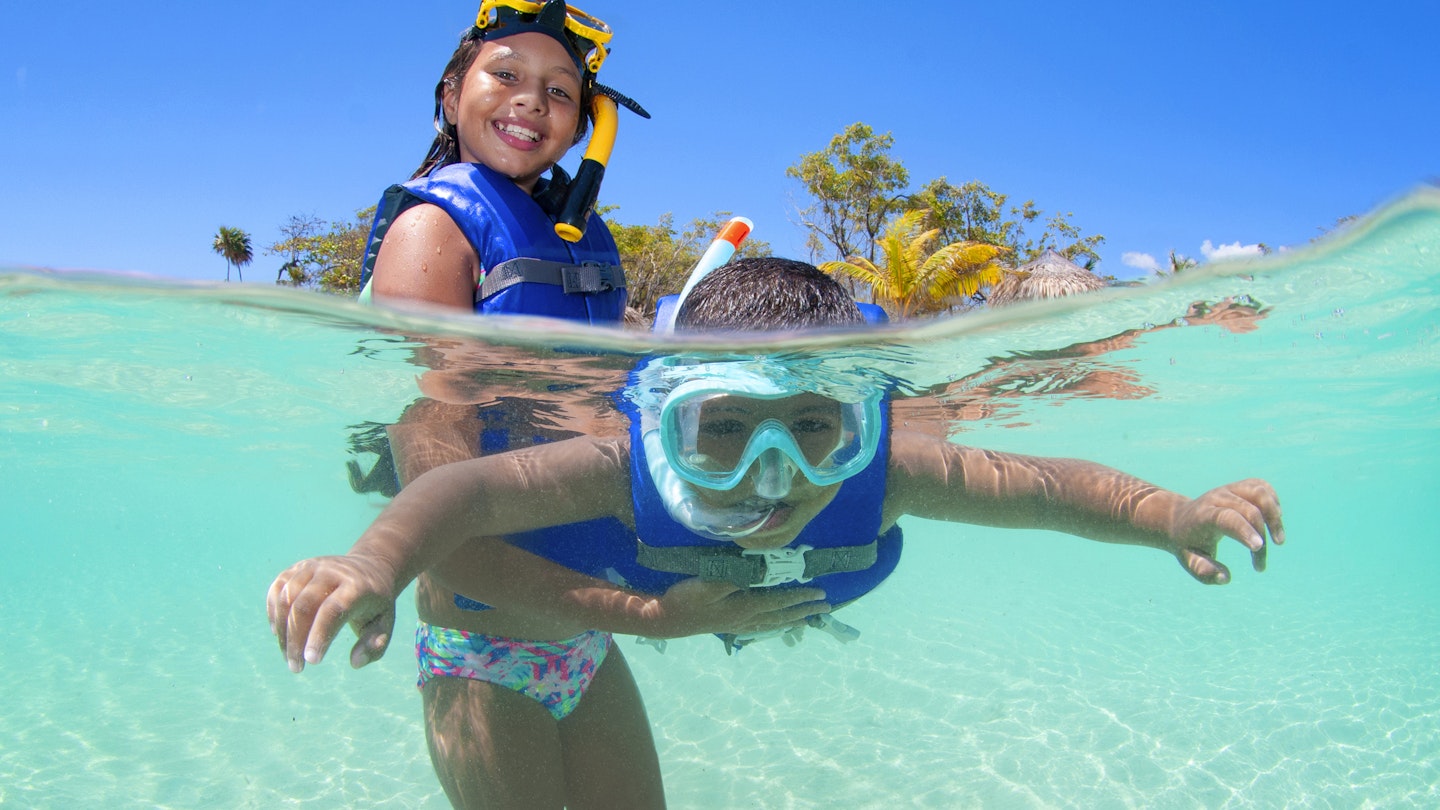
Young girl holding her brother in surface and helping him snorkelling.
A warm, subtropical climate makes Honduras an ideal year-round destination so the best time to visit depends on what you want to do when you arrive.
Many outdoor activities are weather-dependent and, just to add a little spice to your travel planning, some parts of Honduras remain dry while the rest of the country gets lashed by tropical deluges.
Whenever you visit, be prepared both for sun and rain and pack a sweater for the cooler highlands. Here’s our guide to the best time to visit Honduras.
January to June is the best time to visit for outdoor adventure
Sunny, warm days and brisk nights draw visitors to Honduras to explore the Maya ruins of Copán , hike in the mountains around Lago de Yojoa, and soak up the atmosphere in the quirky coastal town of Trujillo. This is Honduras’ busiest season and hotel prices spike around New Year and during Easter.
It’s also the driest time to hit the Bay Islands , where you can head beneath the waves to explore the world’s second-largest barrier reef – visibility is best between January and March.
January is a relatively quiet month, as everyone goes back to work after the Christmas celebrations and the Día de los Reyes Magos parades on January 6.
It’s cold at night in Santa Rosa de Copán, Tegucigalpa and other high-altitude destinations, but it’s a great time to head out to the Bay Islands where balmy temperatures and the last of the winter rains are a boon for beach bums and scuba divers alike.
February is the driest month of the year and that means terrific visibility for scuba divers visiting Roatán and Utila; if you’re lucky, you may spot the first solitary whale shark of the year.
It’s a wonderful time to explore the Maya ruins at Santa Rosa de Copán, but pack a sweater or two for the cold nights. Feria de la Virgen de Suyapa is celebrated across the country on February 3.
Easter is one of the biggest festivals in Honduras and highlights include solemn processions and carpets of flowers. While the highlands are beginning to see rain showers, they rarely last long, and warmer evenings bring an influx of visitors to Santa Rosa de Copán.
May brings the start of the rainy season in mainland Honduras; daytime temperatures remain hot and muggy. Coastal La Ceiba kicks off its two-week-long carnival – the biggest party in Central America, complete with costumed parades, exuberant dancing in the streets and live music.
It’s still relatively dry in the Bay Islands in June but it’s one of the hottest and rainiest months of the year in the rest of Honduras. In the forests, savannahs, and grasslands to the far east of the country, humidity is close to 100% and hurricanes begin to form in the Atlantic.
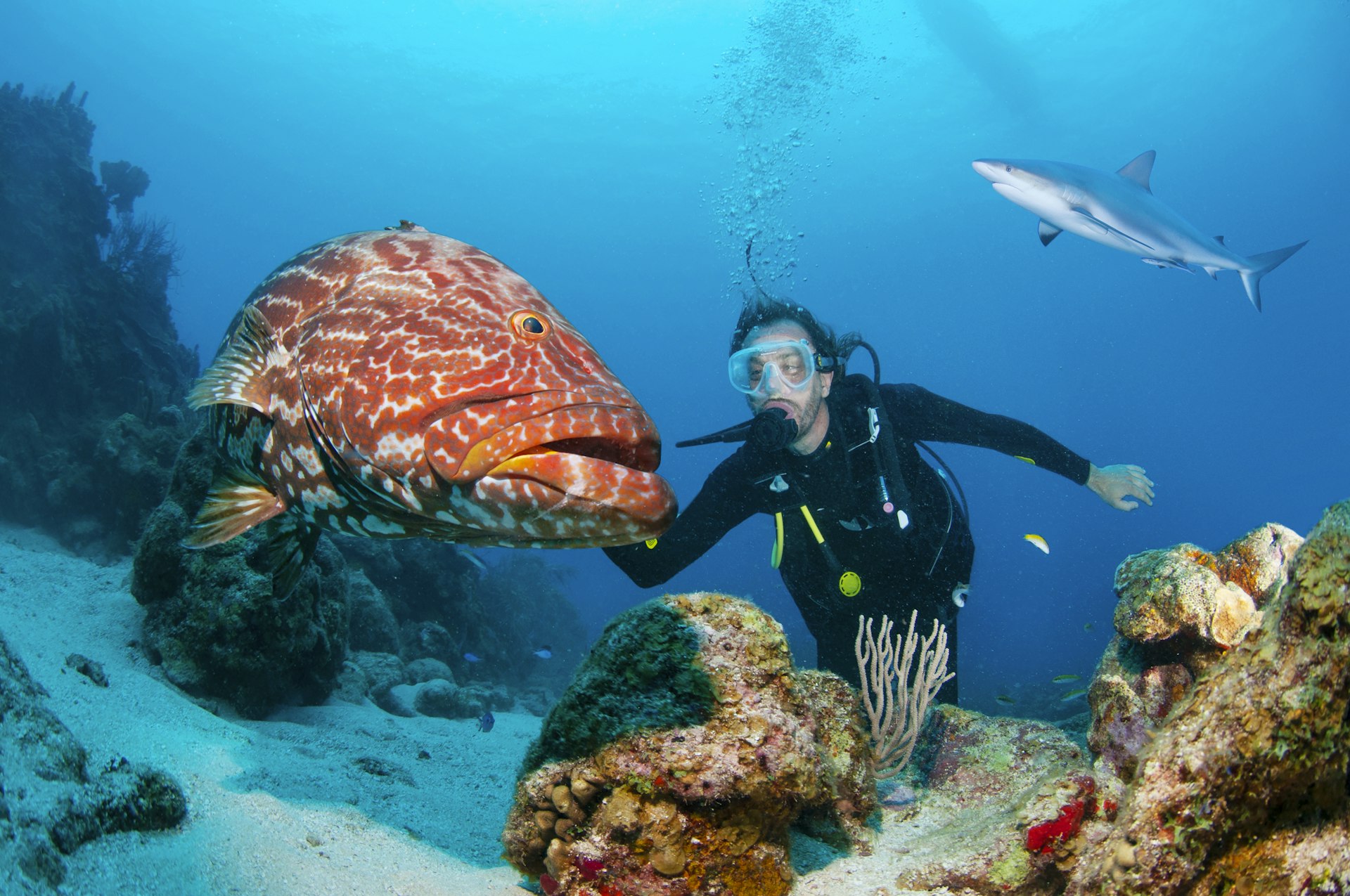
July to September is best for whale shark spotting
If you have your heart set on spotting whale sharks, July is the time to visit the Bay Islands. It's the peak of the annual whale shark migration, and you have a good chance of diving alongside a pod of these remarkable creatures.
Coastal Honduras is ruffled by occasional tropical storms in August and the rough seas can make traveling to the Bay Islands by boat a bit of a rollercoaster. Pods of whale sharks are still spotted in the depths around Utila , and it’s warm and pretty dry in the northern highlands – a pleasant time to be in Santa Rosa de Copán.
Many Hondurans go on vacation in August, so book your accommodations in advance. The Festival del Maiz is celebrated with parades and music across the country.
While the mainland is drenched by the heaviest rains of the year in September, there's a mini dry season in remote Moskitia in eastern Honduras.
It's the perfect time to head for the Río Plátano Biosphere Reserve and the small indigenous villages in the jungle, accessed only by riverboat. September 15 sees El Día de Independencia celebrations all over the country.
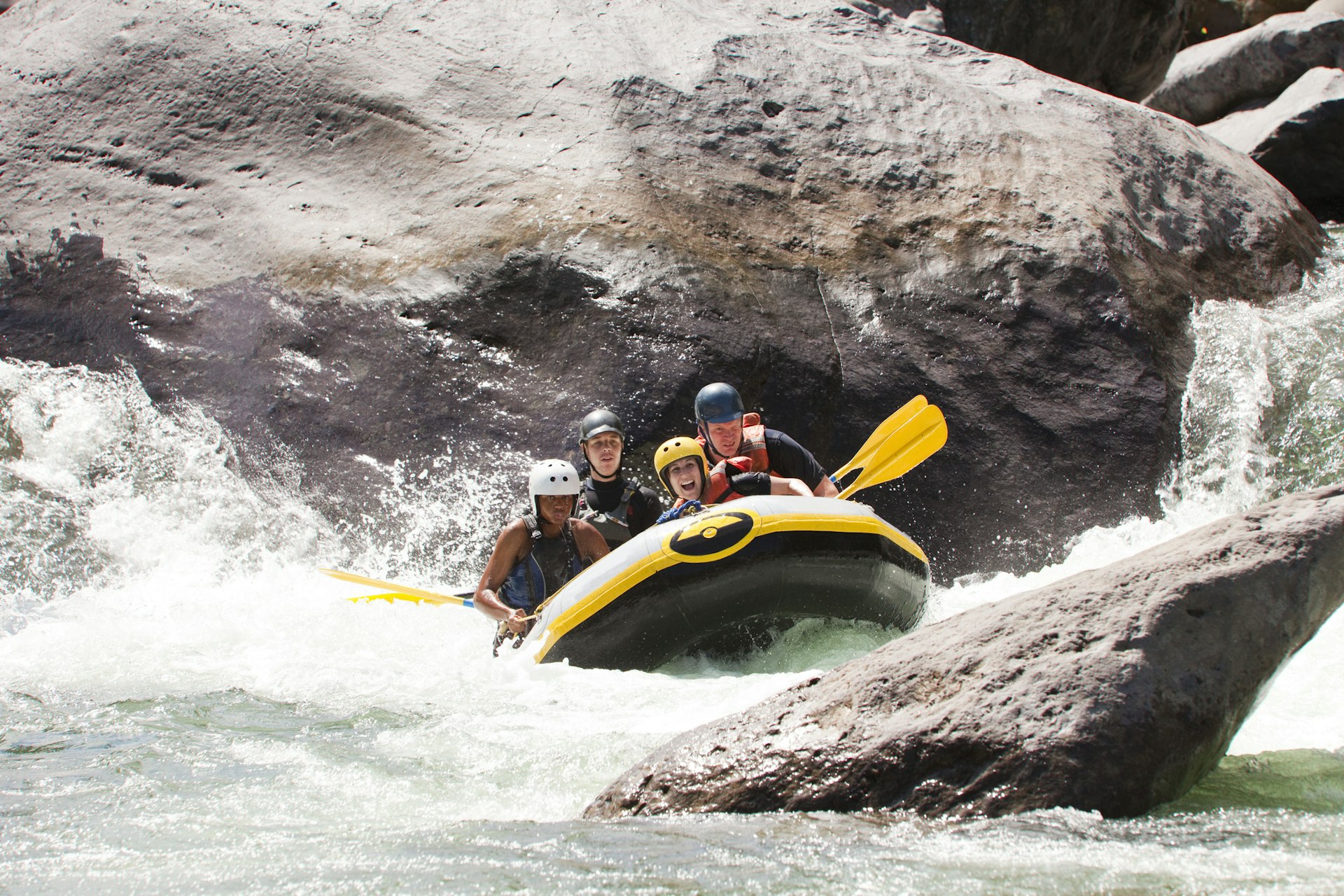
October to December is best for white-water sports and exploring Moskitia
While mainland Honduras is battered by torrential downpours during the rainy months, and overland travel is affected by occasional flooding and mudslides, conditions for white-water rafting and kayaking are particularly good after the rainiest months of September and October.
November sees the rivers swelled up by fall rains and adventurous travelers go white-water rafting on Río Cangrejal. The Chortí Indigenous people of the Santa Rosa de Copán area spend much of the month celebrating their biggest annual festival, Tzikin.
This is also an excellent time to jump aboard a riverboat and explore the remote La Moskitia region, which has its own mini dry season.
Scuba diving centers on Roatán and Utila stay open year-round, and while visibility isn’t as great as during the drier months, now is the time to get some real bargains on diving packages.
Festivities are in full swing during the weeks preceding Navidad (Christmas), so head for Santa Barbara to catch the celebration of El Paseo Real de las Chimeneas Gigantes, or to the north coast to witness Garifuna drumming and processions. It’s the start of the dry season, and accommodations get booked up ahead of the holidays.
Does Honduras have a hurricane season?
Honduras’ east coast and the Bay Islands are bathed by the Caribbean Sea, and the region is notoriously affected by the Atlantic hurricane season that typically lasts from June to late November.
However, the last time the Bay Islands were affected was in 1998 when Hurricane Mitch scored a direct hit. Odds are, you’ll only encounter a tropical storm or two in September or October. If you’d rather not risk it, opt to travel during the high season instead.
This article was first published Jul 8, 2022 and updated Jan 8, 2024.
Explore related stories

Destination Practicalities
Mar 2, 2024 • 7 min read
Honduras is a place of immense beauty and diversity, but traveling here does require some forethought and on-the-ground know-how.
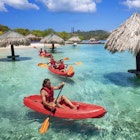
Jan 6, 2024 • 6 min read
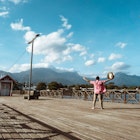
Dec 26, 2023 • 7 min read
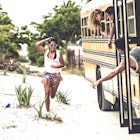
Nov 5, 2023 • 11 min read
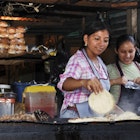
Jun 28, 2022 • 7 min read
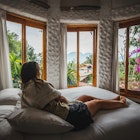
May 1, 2022 • 6 min read

Apr 5, 2022 • 7 min read

Mar 19, 2022 • 8 min read

Jan 7, 2024 • 3 min read

Dec 10, 2023 • 7 min read
Cookies on GOV.UK
We use some essential cookies to make this website work.
We’d like to set additional cookies to understand how you use GOV.UK, remember your settings and improve government services.
We also use cookies set by other sites to help us deliver content from their services.
You have accepted additional cookies. You can change your cookie settings at any time.
You have rejected additional cookies. You can change your cookie settings at any time.
Register to vote Register by 18 June to vote in the General Election on 4 July.
- Passports, travel and living abroad
- Travel abroad
- Foreign travel advice
Warnings and insurance
The Foreign, Commonwealth & Development Office ( FCDO ) provides advice about risks of travel to help British nationals make informed decisions. Find out more about FCDO travel advice .
Before you travel
No travel can be guaranteed safe. Read all the advice in this guide and see support for British nationals abroad for information about specific travel topics.
Follow and contact FCDO travel on Twitter , Facebook and Instagram . You can also sign up to get email notifications when this advice is updated.
Travel insurance
If you choose to travel, research your destinations and get appropriate travel insurance . Insurance should cover your itinerary, planned activities and expenses in an emergency.
Related content
Is this page useful.
- Yes this page is useful
- No this page is not useful
Help us improve GOV.UK
Don’t include personal or financial information like your National Insurance number or credit card details.
To help us improve GOV.UK, we’d like to know more about your visit today. Please fill in this survey (opens in a new tab) .
- Live & Upcoming Games
Quick Links

Customize ESPN
- ESPN Deportes
Follow ESPN FC

USWNT auditions are over; now Hayes must pick her Olympic squad
It's still early in Emma Hayes' tenure, but the USWNT coach already is facing some difficult decisions ahead of naming her 18-player Olympic squad.

Has Lily Yohannes given Emma Hayes a selection headache?
Top headlines.
- City Chairman 'frustrated' with finance references
- Yohannes, 16, scores minutes into USWNT debut
- Napoli hire Conte after disastrous title defence
- Source: Man City launch legal action against PL
- Mbappé: People at PSG made me 'unhappy'
- Barca chief: Xavi didn't believe in current squad
- Madrid legend Hierro joins Ronaldo at Al Nassr
- Ronaldo out as Fernandes lead Portugal to win
- Mbappé to Real Madrid -- what it means

CODY GAKPO EXCLUSIVE
Liverpool's cody gakpo takes his inspiration from god, salah and a wooden hippo.
Liverpool and Netherlands star Cody Gakpo speaks to ESPN about how his Anfield move happened, his inspirations and the upcoming European Championship.
CODY GAKPO SPEAKS TO ESPN
Cody gakpo targeting euro 2024 glory with the netherlands, how cody gakpo let god decide his psv exit.
GLOBAL SOCCER SCOREBOARD
Tuesday's matches, weighing in on the top 100 players, what would we fix about the fc 100, did messi or ronaldo have a better season, top 100 players in soccer, the fc 100 for 2024: mbappé, ronaldo among best men's soccer players.
With the 2023-24 European season closed after the Champions League final, we're back with our eighth annual rankings of the best men's players in world soccer.
From Ronaldo to Valverde, picking overrated and underrated players, plus snubs
Not everyone will agree with the final ranking of ESPN's FC 100 -- including the voters.

EXAMINING LIVERPOOL
What liverpool can expect from slot: attacking football, intensity and player development.
Arne Slot has worked hard and been patient in his ascent through the world of soccer management, but the former Feyenoord boss fits Liverpool nicely based on his style and methods.
Ranking all 39 Liverpool signings of the Jurgen Klopp era, from Ben Davies to Mo Salah
Let's evaluate every player Klopp promoted or signed during his nine-year tenure with Liverpool.
TOURNAMENT BEGINS JUNE 14
All the latest squad lists for the finals in germany.
Discover the latest squad news for the 24 countries at Euro 2024 in Germany, with the tournament running from June 14 to July 14.

SOCCER TRANSFERS
Live transfer talk: atlético eyeing man city's julián álvarez.
Julián Álvarez has been linked to a move away from Manchester City to Atlético Madrid. Transfer Talk is LIVE with the latest.
Top Headlines
Best of espn+, usmnt depth chart: top 15 players in each position, ranked.
Ahead of Copa America, we dig deep into the USMNT's depth chart. Let's rank the top 120 American players by position -- 15 players each!
Will Porto's unlikely Champions League win ever be repeated?
This week marks the 20th anniversary of Porto's surprise Champions League triumph, the last time a team outside Europe's top five leagues managed the feat.
Every Premier League VAR error: Winners and losers, referee stats
Which Premier League clubs got the worst of the VAR gaffes? Which actually benefited from mistakes? We've got all the answers with the official stats.
Trending Now
Breaking down messi's travel miles for inter miami and argentina.
Lionel Messi will have to endure an intense 2024 travel schedule for Inter Miami and Argentina, but just how much mileage does he have to rack up?
How will Emma Hayes navigate switch from club game to USWNT?
The USWNT's previous coach struggled to transition from the club game to the international level. Can Emma Hayes avoid the same fate with the Olympics in two months?
Messi tracker: Inter Miami games, goals, assists, more stats
Lionel Messi is in first full season with MLS side Inter Miami. Here's game-by-game analysis of how the World Cup winner is performing for his team.
Tables, fixtures and scores
League tables.
Updated tables from the Premier League, Champions League, LaLiga, English Football League and more.
Upcoming fixtures
Keep track of all the important upcoming fixtures for all the clubs and countries in world football here.
Latest scores
Results and scores from the Premier League, Champions League, LaLiga, English Football League and more.

COMMENTS
13. Bargain sparingly. Haggling isn't much of a sport in Honduras - prices tend to be fixed, even in markets and streetside stands. Some light bargaining is tolerated at family-run hotels and by small-town taxi drivers; keep in mind, though, that those extra lempiras likely mean a lot more to the vendors than to you.
4. The people are really friendly. Honduras has not the best reputation, but the locals are actually really kind and they all want to help you wherever you are. And they all say hi to you, even if you just pass by. 5. It's not very touristy at all. The country is not touristy at all and I really like that.
Call us in Washington, D.C. at 1-888-407-4747 (toll-free in the United States and Canada) or 1-202-501-4444 (from all other countries) from 8:00 a.m. to 8:00 p.m., Eastern Standard Time, Monday through Friday (except U.S. federal holidays). See the State Department's travel website for the Worldwide Caution and Travel Advisories.
Why go to Honduras? You must visit Honduras at least once in your lifetime because, despite its tiny size, Honduras has a wide range of cultures and landscapes. Honduras is gifted with some of Central America's most stunning natural scenery. A beautiful country that makes you think of jungles, waterfalls, beaches with palm trees, unique ...
Honduras. Central America. White beaches fringed by the world's second-largest barrier reef, jungle-covered mountains cut by raftable white-water rivers and home to an astounding number of bird species, exquisite Maya ruins, colonial, cobblestone villages, fresh seafood grilled on the beachâ ¦Yes, all this is found in Honduras, a country ...
Car rental - Driving in Honduras is not recommended as the roads aren't that safe (landslides, flooding), there's heavy traffic, and robberies are common. Avoid renting a car and stick to buses. Hitchhike - Hitchhiking is doable if you're an experienced traveler and aren't in a hurry.
When to visit Honduras. Honduras benefits from a stable tropical climate, with hot coasts and cooler highlands. Temperatures vary quite little throughout the year, hovering between 27 and 32°C. The more important thing is to avoid heavy downpours during the wet season. For the driest weather, you'll want to head to Honduras between December ...
10. Lake Yojoa region. Best place for bird-watching and hiking. Lago Yojoa, Honduras' largest lake, is another locals' getaway in the middle of the countryside, about four hours from Tegucigalpa. Lakeshore restaurants serve up fried fish with the typical sides of rice, beans, curtido and plantains.
Explore the local culture with the help of a Honduras tour guide! Roatan Shore Excursion: Monkeys, Sloths, and Snorkel Adventure. Roatan Ziplines Sloth Park and West Bay Beach Break. Roatan Barrier Reef Snorkel & Monkeys/Sloth Sanctuary from French Cay. Day Trip to La Tigra and El Picacho Park from Tegucigalpa.
Here are some ways to get around Honduras: Bus: The most common and economical way to travel around Honduras is by bus. There are both local and long-distance buses that run regularly between cities and towns. Taxis: Taxis are widely available in the major cities and towns. It's important to agree on a price before getting into a taxi and to ...
Here are ten reasons why you should visit Honduras. 1. Explore the Ancient Mayan Ruins. Honduras is home to some of the most impressive Mayan ruins in Central America. From the majestic Copan Ruins to the mysterious Ciudad Blanca, there's something for everyone. Explore the ruins and learn about the ancient Mayan civilization.
Most ATMs will give you money in 500 lempiras (roughly $20 USD). The unfortunate thing is that 500 lempira is a lot of money for most small purchases you make. Ideally, try and break the large bills in larger restaurants, hotels, and shops. Avoid using big bills (100 or 500 Lempiras) at small shops if you can.
Discover a world of wonder in this diverse country, with our list of the top attractions and places to visit in Honduras. On This Page: 1. Roatán, Bay Islands. 2. Copán Ruins Archeological Site. 3. Utila, Bay Islands. 4.
Don't toss things to people. That's usually reserved or dogs, so such a gesture could come off incorrectly. Don't use big bills (100 or 500 Lempiras) at small shops if you can avoid it. It's extremely rude since you might be asking the shop owner to have more than his daily/weekly income on hand to offer as change.
A top place to visit in Honduras is the Maya city of Copan, located in the town of Copan Ruinas near the border with Guatemala.. A UNESCO World Heritage Listed archaeological site, Copan rubs shoulders with the likes of Chichen Itza, Coba, Palenque (Mexico) and Tikal (Guatemala) as one of the great cities of the Maya world.. I first became captivated with Copán while reading the book ...
If your travel plans in Honduras include outdoor activities, take these steps to stay safe and healthy during your trip. Stay alert to changing weather conditions and adjust your plans if conditions become unsafe. Prepare for activities by wearing the right clothes and packing protective items, such as bug spray, sunscreen, and a basic first ...
There are many different reasons why you should visit Honduras. Here is a list of my top 10 reasons to visit Honduras. 1.-. Honduras has a warm, temperate climate; it always does…. You will never get snowed out or have subzero temperatures. As a matter of fact, it seldom gets below 60 degrees in all of the country! 2.-.
There's a lot to do in Roatan Honduras, and here is the best of it all. 1. Snorkeling and Diving. The snorkeling and diving opportunities are perhaps the main reason to visit Roatan. Being surrounded by the second largest barrier reef in the world means that underwater life is some of the most diverse in the world.
7 Days in Honduras: Copan and Pico Bonito National Park. With seven days in Honduras, you can see many of mainland Honduras' backpacker highlights. This itinerary assumes that you are traveling overland from Guatemala. Since public transportation travel can be slow, I recommend under planning your Honduras schedule.
Reconsider travel to Honduras due to crime and kidnapping. Some areas have increased risk. Read the entire Travel Advisory. Do not travel to: Gracias a Dios Department due to crime. Country Summary: Violent crime, such as homicide, armed robbery, and kidnapping, is common. Violent gang activity, such as extortion, violent street crime, rape ...
To avoid becoming a victim: be suspicious of recent acquaintances or strangers approaching you. avoid accepting rides or invitations from strangers. avoid hitchhiking. ensure that your belongings, including your passport and other travel documents, are secured at all times. avoid carrying large amounts of cash.
A warm, subtropical climate makes Honduras an ideal year-round destination so the best time to visit depends on what you want to do when you arrive.. Many outdoor activities are weather-dependent and, just to add a little spice to your travel planning, some parts of Honduras remain dry while the rest of the country gets lashed by tropical deluges.
Living in Honduras. Travelling to Honduras. FCDO travel advice for Honduras. Includes safety and security, insurance, entry requirements and legal differences.
Visit ESPN for soccer live scores, highlights and news from all major soccer leagues. Stream games on ESPN and play Fantasy Soccer.
Honduras has reported the second-most cases in the Central American Isthmus and Mexico Subregion this year, trailing only Mexico, which has counted more than 69,000.